Huawei MU736 HSPA M.2 Module AT Command Interface Specification (V100R002 02, English)
HUAWEI MU736 HSPA+ M.2 Module AT Command Interface Specification-(V100R002_02, English)
2013-12-25
User Manual: Huawei
Open the PDF directly: View PDF ![]() .
.
Page Count: 179 [warning: Documents this large are best viewed by clicking the View PDF Link!]
- Revision History
- 1 Introduction
- 1.1 Scope
- 1.2 Overview
- 1.3 Organization
- 1.4 Document Conventions
- 1.5 AT Command Syntax
- 1.6 Abort Attributes of AT Command
- 1.7 Rules for Running AT Command
- 1. Each interface should be functionally convergent.
- 2. Each command line contains only one AT command and ends with a carriage return character. For the URC instruction or response reported from MT to TE, only one AT command is allowed in a command line. In principle, users are not allowed to run S3/S4...
- 3. For an AT command that cannot be interrupted, after sending the AT command, the TE must wait until the MT responds to the AT command before sending the second AT command.
- 4. For the AT command to which the response is given only after a long time, in order to prevent interference on other events, it is recommended to report the final execution result asynchronously. If the ME responds to the TE only after a long time o...
- 5. A string refers to a byte stream (excluding the quotation marks or commas) that is placed inside double quotation marks. Special note should be specified if the byte stream need not be enclosed in double quotation marks.
- 6. The current version does not support escape character. The code value of a data format in the UCS2 coding is reported as characters. For example, if the UCS2 code of a Chinese character is 0x553a, the 553a is reported.
- 7. A possible response sent by the MT to the TE consists of Information text and Result code, in which Information text is optional and Result code is mandatory. The format of a possible response is controlled by the ATV command. For details, see the ...
- 2 General Commands
- 2.1 ATV–Set the Response Format
- 2.2 ATI–Request Identification
- 2.3 AT+CGMI/AT+GMI–Request Manufacturer Identification
- 2.4 AT+CGMM/AT+GMM–Request Model Identification
- 2.5 AT+CGMR/AT+GMR–Request Software Version
- 2.6 AT+CGSN/AT+GSN–Request Product IMEI
- 2.7 AT+CSCS–Set the TE Character Set
- 2.8 AT+CIMI–Request IMSI
- 3 Call Control Commands and Methods
- 4 Network Service Related Commands
- 5 Mobile Termination Control and Status Commands
- 6 Mobile Termination Errors
- 7 Commands for UMTS Packet Domain
- 8 PDU Mode Commands for SMS
- 8.1 AT+CSMS–Select Message Service
- 8.2 AT+CPMS–Select Message Storage
- 8.3 AT+CMGF–Set Message Format
- 8.4 AT+CSCA–Service Center Address
- 8.5 AT+CNMI–Indicate New Message to TE
- 8.6 AT+CMGD–Delete Message
- 8.7 AT+CMGL–List Messages
- 8.8 AT+CMGR–Read Message
- 8.9 AT+CMGS–Send Short Message
- 8.10 AT+CNMA–New Message Acknowledgement
- 8.11 +CMTI–Unsolicitedly Present of Message Arrival Indication
- 8.12 +CMT–Unsolicitedly Present of New Message Reported Directly
- 8.13 +CDSI–Unsolicitedly Present of Newly Received Message Status Report
- 8.14 +CDS–Unsolicitedly Present of New Message Status Report Reported Directly
- 8.15 +CBMI–Unsolicitedly Present of Newly Received Cell Broadcast Message
- 8.16 +CBM–Unsolicitedly Present of New Cell Broadcast Message Directly
- 9 Commands for Standard STK Interface
- 10 Huawei Proprietary Interface: Mobile Termination Control and Status Interface
- 10.1 AT^RFSWITCH–Set the Flight Mode
- 10.2 AT^CURC–Set Presentation of Unsolicited Results
- 10.2.1 Command Syntax
- 10.2.2 Interface Description
- 10.2.3 Parameter Description
- Table 10-1 List for the presentation of unsolicited results when CURU=0/1
- Table 10-2 The control mode when <mode>=2
- Table 10-3 Situation when MT does not support Wwan port
- Table 10-4 Situation when MT supports Wwan port
- Table 10-5 Definitions of Page 0 Bit [60~0] for the presentation of unsolicited results
- 10.2.4 Property Description
- 10.2.5 Example
- 10.3 AT^HGMR–Request Version Information
- 10.4 AT^HWCUST–Enable Custom Hardware Function
- 11 Huawei Proprietary Interface: Network Service Interfaces
- 12 Huawei Proprietary Interface: STK Interface
- 13 Huawei Proprietary Interface: M.2 Interface
- 13.1 AT+XTSM–Set Thermal Sensor with the Threshold
- 13.2 +XTS–Unsolicitedly Present of the Threshold Reached
- 13.3 AT+XTAMR–Query the Current Temperature of a Thermal Sensor
- 13.4 AT+XADPCLKFREQINFO–Query Adaptive Clock Frequency Info
- 13.5 +XADPCLKFREQINFO–Unsolicitedly Present of Adaptive Clock Frequency Info
- 14 Huawei Proprietary Interface: BodySAR Interface
- 15 Huawei Proprietary Interface: IPv6 Interface
- 16 Huawei Proprietary Interface: Tunable Antenna Interface
- 17 Huawei Proprietary Interface: Main And AUX Switch Interface
- 18 Huawei Proprietary Interface: GPS Service Interfaces
- 19 Appendix

HUAWEI MU736 HSPA+ M.2 Module
AT Command Interface Specification
Issue
02
Date
2013-12-24

Huawei Technologies Co., Ltd. provides customers with comprehensive technical support and service. For
any assistance, please contact our local office or company headquarters.
Huawei Technologies Co., Ltd.
Huawei Industrial Base, Bantian, Longgang, Shenzhen 518129, People’s Republic of China
Tel: +86-755-28780808 Global Hotline: +86-755-28560808 Website: www.huawei.com
E-mail: mobile@huawei.com
Please refer color and shape to product. Huawei reserves the right to make changes or improvements to any
of the products without prior notice.
Copyright © Huawei Technologies Co., Ltd. 2013. All rights reserved.
No part of this document may be reproduced or transmitted in any form or by any means without prior written
consent of Huawei Technologies Co., Ltd.
The product described in this manual may include copyrighted software of Huawei Technologies Co., Ltd. and
possible licensors. Customers shall not in any manner reproduce, distribute, modify, decompile, disassemble,
decrypt, extract, reverse engineer, lease, assign, or sublicense the said software, unless such restrictions are
prohibited by applicable laws or such actions are approved by respective copyright holders under licenses.
Trademarks and Permissions
, , and
are trademarks or registered trademarks of Huawei Technologies Co., Ltd.
Other trademarks, product, service and company names mentioned are the property of their respective
owners.
Notice
Some features of the product and its accessories described herein rely on the software installed, capacities
and settings of local network, and may not be activated or may be limited by local network operators or
network service providers, thus the descriptions herein may not exactly match the product or its accessories
you purchase.
Huawei Technologies Co., Ltd. reserves the right to change or modify any information or specifications
contained in this manual without prior notice or obligation.
NO WARRANTY
THE CONTENTS OF THIS MANUAL ARE PROVIDED “AS IS”. EXCEPT AS REQUIRED BY APPLICABLE
LAWS, NO WARRANTIES OF ANY KIND, EITHER EXPRESS OR IMPLIED, INCLUDING BUT NOT
LIMITED TO, THE IMPLIED WARRANTIES OF MERCHANTABILITY AND FITNESS FOR A PARTICULAR
PURPOSE, ARE MADE IN RELATION TO THE ACCURACY, RELIABILITY OR CONTENTS OF THIS
MANUAL.
TO THE MAXIMUM EXTENT PERMITTED BY APPLICABLE LAW, IN NO CASE SHALL HUAWEI
TECHNOLOGIES CO., LTD. BE LIABLE FOR ANY SPECIAL, INCIDENTAL, INDIRECT, OR
CONSEQUENTIAL DAMAGES, OR LOST PROFITS, BUSINESS, REVENUE, DATA, GOODWILL OR
ANTICIPATED SAVINGS.
Import and Export Regulations
Customers shall comply with all applicable export or import laws and regulations and will obtain all necessary
governmental permits and licenses in order to export, re-export or import the product mentioned in this
manual including the software and technical data therein.

HUAWEI MU736 HSPA+ M.2 Module
AT Command Interface Specification
About This Document
Issue 02 (2013-12-24)
HUAWEI Proprietary and Confidential
Copyright © HUAWEI Technologies Co., Ltd.
3
About This Document
Revision History
Document
Version
Date
Chapter
Descriptions
01
2013-11-18
Creation
02
2013-12-24
1
Updated the description of Introduction
2.8
Added the command of
AT+CIMI–Request IMSI
7.1.3
Updated the supported values of
<PDP_type> of AT+CGDCONT
10.4
Added the command of
AT^HWCUST–Enable Custom Hardware
Function
11.5
Added the command of ^SRVST–Service
State Change Indication
11.6
Added the command of ^SIMST–SIM
Card State Change Indication
15
Added the chapter of Huawei Proprietary
Interface: IPv6 Interface
15.1
Added the command of
AT^IPV6CAP–Query IPv6 Capability
16
Added the chapter of Huawei Proprietary
Interface: Tunable Antenna Interface
16.1
Added the command of
AT^ANTENCFG–Set Tunable Antenna
17
Added the chapter of Huawei Proprietary
Interface: Main And AUX Switch Interface
17.1
Added the command of
AT^ANTMODE–Set Operation Mode of
Main and AUX Antennas

HUAWEI MU736 HSPA+ M.2 Module
AT Command Interface Specification
About This Document
Issue 02 (2013-12-24)
HUAWEI Proprietary and Confidential
Copyright © HUAWEI Technologies Co., Ltd.
4
Document
Version
Date
Chapter
Descriptions
18
Added the chapter of Huawei Proprietary
Interface: GPS Service Interfaces
18.1
Added the command of AT^WPDOM–Set
Operation Mode
18.2
Added the command of AT^WPDST–Set
Session Type
18.3
Added the command of AT^WPDFR–Set
Positioning Frequency
18.4
Added the command of AT^WPURL–Set
AGPS Server Address and Port
18.5
Added the command of
AT^WPDIM–Delete Auxiliary Data
18.6
Added the command of
AT^WPDGP–Start Positioning Session
18.7
Added the command of
AT^WPEND–Terminate Positioning
Process
19
Updated the description of Appendix

HUAWEI MU736 HSPA+ M.2 Module
AT Command Interface Specification
Contents
Issue 02 (2013-12-24)
HUAWEI Proprietary and Confidential
Copyright © HUAWEI Technologies Co., Ltd.
5
Contents
1 Introduction.................................................................................................................................. 18
1.1 Scope ............................................................................................................................................. 18
1.2 Overview ........................................................................................................................................ 18
1.3 Organization ................................................................................................................................... 19
1.4 Document Conventions .................................................................................................................. 19
1.5 AT Command Syntax ...................................................................................................................... 19
1.5.1 AT Command Types .............................................................................................................. 19
1.5.2 AT Command Parameter ....................................................................................................... 20
1.5.3 AT Command Description ...................................................................................................... 21
1.6 Abort Attributes of AT Command .................................................................................................... 22
1.7 Rules for Running AT Command .................................................................................................... 23
2 General Commands .................................................................................................................... 24
2.1 ATV–Set the Response Format ...................................................................................................... 24
2.1.1 Command Syntax .................................................................................................................. 24
2.1.2 Interface Description .............................................................................................................. 24
2.1.3 Parameter Description ........................................................................................................... 24
2.1.4 Property Description .............................................................................................................. 25
2.1.5 Example ................................................................................................................................. 25
2.2 ATI–Request Identification ............................................................................................................. 25
2.2.1 Command Syntax .................................................................................................................. 25
2.2.2 Interface Description .............................................................................................................. 25
2.2.3 Parameter Description ........................................................................................................... 25
2.2.4 Property Description .............................................................................................................. 26
2.2.5 Example ................................................................................................................................. 26
2.3 AT+CGMI/AT+GMI–Request Manufacturer Identification .............................................................. 26
2.3.1 Command Syntax .................................................................................................................. 26
2.3.2 Interface Description .............................................................................................................. 26
2.3.3 Parameter Description ........................................................................................................... 26
2.3.4 Property Description .............................................................................................................. 27
2.3.5 Example ................................................................................................................................. 27
2.4 AT+CGMM/AT+GMM–Request Model Identification ...................................................................... 27
2.4.1 Command Syntax .................................................................................................................. 27

HUAWEI MU736 HSPA+ M.2 Module
AT Command Interface Specification
Contents
Issue 02 (2013-12-24)
HUAWEI Proprietary and Confidential
Copyright © HUAWEI Technologies Co., Ltd.
6
2.4.2 Interface Description .............................................................................................................. 27
2.4.3 Parameter Description ........................................................................................................... 28
2.4.4 Property Description .............................................................................................................. 28
2.4.5 Example ................................................................................................................................. 28
2.5 AT+CGMR/AT+GMR–Request Software Version .......................................................................... 28
2.5.1 Command Syntax .................................................................................................................. 28
2.5.2 Interface Description .............................................................................................................. 28
2.5.3 Parameter Description ........................................................................................................... 28
2.5.4 Property Description .............................................................................................................. 29
2.5.5 Example ................................................................................................................................. 29
2.6 AT+CGSN/AT+GSN–Request Product IMEI .................................................................................. 29
2.6.1 Command Syntax .................................................................................................................. 29
2.6.2 Interface Description .............................................................................................................. 29
2.6.3 Parameter Description ........................................................................................................... 29
2.6.4 Property Description .............................................................................................................. 30
2.6.5 Example ................................................................................................................................. 30
2.7 AT+CSCS–Set the TE Character Set ............................................................................................. 30
2.7.1 Command Syntax .................................................................................................................. 30
2.7.2 Interface Description .............................................................................................................. 31
2.7.3 Parameter Description ........................................................................................................... 31
2.7.4 Property Description .............................................................................................................. 31
2.7.5 Example ................................................................................................................................. 31
2.8 AT+CIMI–Request IMSI .................................................................................................................. 32
2.8.1 Command Syntax .................................................................................................................. 32
2.8.2 Interface Description .............................................................................................................. 32
2.8.3 Parameter Description ........................................................................................................... 32
2.8.4 Property Description .............................................................................................................. 33
2.8.5 Example ................................................................................................................................. 33
3 Call Control Commands and Methods ................................................................................... 34
3.1 ATD–Originate a Data Service Call ................................................................................................ 34
3.1.1 Command Syntax .................................................................................................................. 34
3.1.2 Interface Description .............................................................................................................. 34
3.1.3 Parameter Description ........................................................................................................... 34
3.1.4 Property Description .............................................................................................................. 34
3.1.5 Example ................................................................................................................................. 34
4 Network Service Related Commands ..................................................................................... 35
4.1 AT+COPS–Select Operator ............................................................................................................ 35
4.1.1 Command Syntax .................................................................................................................. 35
4.1.2 Interface Description .............................................................................................................. 35
4.1.3 Parameter Description ........................................................................................................... 36
4.1.4 Property Description .............................................................................................................. 37

HUAWEI MU736 HSPA+ M.2 Module
AT Command Interface Specification
Contents
Issue 02 (2013-12-24)
HUAWEI Proprietary and Confidential
Copyright © HUAWEI Technologies Co., Ltd.
7
4.1.5 Example ................................................................................................................................. 37
4.2 AT+CREG–Register Network ......................................................................................................... 38
4.2.1 Command Syntax .................................................................................................................. 38
4.2.2 Interface Description .............................................................................................................. 38
4.2.3 Parameter Description ........................................................................................................... 38
4.2.4 Property Description .............................................................................................................. 39
4.2.5 Example ................................................................................................................................. 40
4.3 AT+CLCK–Lock Facility .................................................................................................................. 40
4.3.1 Command Syntax .................................................................................................................. 40
4.3.2 Interface Description .............................................................................................................. 40
4.3.3 Parameter Description ........................................................................................................... 41
4.3.4 Property Description .............................................................................................................. 42
4.3.5 Example ................................................................................................................................. 42
4.4 AT+CPWD–Change Password ....................................................................................................... 42
4.4.1 Command Syntax .................................................................................................................. 42
4.4.2 Interface Description .............................................................................................................. 43
4.4.3 Parameter Description ........................................................................................................... 43
4.4.4 Property Description .............................................................................................................. 43
4.4.5 Example ................................................................................................................................. 43
4.5 AT+CUSD–USSD Command ......................................................................................................... 44
4.5.1 Command Syntax .................................................................................................................. 44
4.5.2 Interface Description .............................................................................................................. 44
4.5.3 Parameter Description ........................................................................................................... 44
4.5.4 Property Description .............................................................................................................. 45
4.5.5 Example ................................................................................................................................. 45
4.6 +CUSD–Unsolicitedly Present USSD of Network .......................................................................... 46
4.6.1 Command Syntax .................................................................................................................. 46
4.6.2 Interface Description .............................................................................................................. 46
4.6.3 Parameter Description ........................................................................................................... 46
4.6.4 Property Description .............................................................................................................. 46
4.6.5 Example ................................................................................................................................. 46
5 Mobile Termination Control and Status Commands .......................................................... 47
5.1 AT+CFUN–Set Operation Mode ..................................................................................................... 47
5.1.1 Command Syntax .................................................................................................................. 47
5.1.2 Interface Description .............................................................................................................. 47
5.1.3 Parameter Description ........................................................................................................... 48
5.1.4 Property Description .............................................................................................................. 48
5.1.5 Example ................................................................................................................................. 48
5.2 AT+CPIN–Enter PIN ....................................................................................................................... 48
5.2.1 Command Syntax .................................................................................................................. 48
5.2.2 Interface Description .............................................................................................................. 49

HUAWEI MU736 HSPA+ M.2 Module
AT Command Interface Specification
Contents
Issue 02 (2013-12-24)
HUAWEI Proprietary and Confidential
Copyright © HUAWEI Technologies Co., Ltd.
8
5.2.3 Parameter Description ........................................................................................................... 49
5.2.4 Property Description .............................................................................................................. 50
5.2.5 Example ................................................................................................................................. 50
5.3 AT+CPBS–Select Phonebook Memory Storage ............................................................................ 50
5.3.1 Command Syntax .................................................................................................................. 50
5.3.2 Interface Description .............................................................................................................. 51
5.3.3 Parameter Description ........................................................................................................... 51
5.3.4 Property Description .............................................................................................................. 52
5.3.5 Example ................................................................................................................................. 52
5.4 AT+CPBR–Read Phonebook Entries ............................................................................................. 52
5.4.1 Command Syntax .................................................................................................................. 52
5.4.2 Interface Description .............................................................................................................. 53
5.4.3 Parameter Description ........................................................................................................... 53
5.4.4 Property Description .............................................................................................................. 54
5.4.5 Example ................................................................................................................................. 54
5.5 AT+CPBW–Write Phonebook Entry ............................................................................................... 54
5.5.1 Command Syntax .................................................................................................................. 54
5.5.2 Interface Description .............................................................................................................. 54
5.5.3 Parameter Description ........................................................................................................... 55
5.5.4 Property Description .............................................................................................................. 56
5.5.5 Example ................................................................................................................................. 56
5.6 AT+CRSM–Restrict SIM Access .................................................................................................... 56
5.6.1 Command Syntax .................................................................................................................. 56
5.6.2 Interface Description .............................................................................................................. 57
5.6.3 Parameter Description ........................................................................................................... 57
5.6.4 Property Description .............................................................................................................. 57
5.6.5 Example ................................................................................................................................. 57
5.7 AT+CSQ–Query the Signal Quality ................................................................................................ 58
5.7.1 Command Syntax .................................................................................................................. 58
5.7.2 Interface Description .............................................................................................................. 58
5.7.3 Parameter Description ........................................................................................................... 58
5.7.4 Property Description .............................................................................................................. 59
5.7.5 Example ................................................................................................................................. 59
6 Mobile Termination Errors ....................................................................................................... 60
6.1 AT+CMEE–Report Mobile Termination Error ................................................................................. 60
6.1.1 Command Syntax .................................................................................................................. 60
6.1.2 Interface Description .............................................................................................................. 60
6.1.3 Parameter Description ........................................................................................................... 61
6.1.4 Property Description .............................................................................................................. 61
6.1.5 Example ................................................................................................................................. 61
7 Commands for UMTS Packet Domain ................................................................................... 62

HUAWEI MU736 HSPA+ M.2 Module
AT Command Interface Specification
Contents
Issue 02 (2013-12-24)
HUAWEI Proprietary and Confidential
Copyright © HUAWEI Technologies Co., Ltd.
9
7.1 AT+CGDCONT–Define PDP Context ............................................................................................. 62
7.1.1 Command Syntax .................................................................................................................. 62
7.1.2 Interface Description .............................................................................................................. 63
7.1.3 Parameter Description ........................................................................................................... 63
7.1.4 Property Description .............................................................................................................. 64
7.1.5 Example ................................................................................................................................. 64
7.2 AT+CGACT–Activate or Deactivate PDP Context ......................................................................... 65
7.2.1 Command Syntax .................................................................................................................. 65
7.2.2 Interface Description .............................................................................................................. 66
7.2.3 Parameter Description ........................................................................................................... 66
7.2.4 Property Description .............................................................................................................. 66
7.2.5 Example ................................................................................................................................. 66
7.3 AT+CGATT–Attach or Detach PS Domain ..................................................................................... 67
7.3.1 Command Syntax .................................................................................................................. 67
7.3.2 Interface Description .............................................................................................................. 67
7.3.3 Parameter Description ........................................................................................................... 67
7.3.4 Property Description .............................................................................................................. 68
7.3.5 Example ................................................................................................................................. 68
7.4 AT+CGREG–PS Domain Registration Status ................................................................................ 68
7.4.1 Command Syntax .................................................................................................................. 68
7.4.2 Interface Description .............................................................................................................. 68
7.4.3 Parameter Description ........................................................................................................... 69
7.4.4 Property Description .............................................................................................................. 70
7.4.5 Example ................................................................................................................................. 70
7.5 AT+CGSMS–SMS Bearer Domain ................................................................................................. 70
7.5.1 Command Syntax .................................................................................................................. 70
7.5.2 Interface Description .............................................................................................................. 71
7.5.3 Parameter Description ........................................................................................................... 71
7.5.4 Property Description .............................................................................................................. 71
7.5.5 Example ................................................................................................................................. 71
8 PDU Mode Commands for SMS .............................................................................................. 73
8.1 AT+CSMS–Select Message Service .............................................................................................. 73
8.1.1 Command Syntax .................................................................................................................. 73
8.1.2 Interface Description .............................................................................................................. 73
8.1.3 Parameter Description ........................................................................................................... 73
8.1.4 Property Description .............................................................................................................. 74
8.1.5 Example ................................................................................................................................. 74
8.2 AT+CPMS–Select Message Storage ............................................................................................. 75
8.2.1 Command Syntax .................................................................................................................. 75
8.2.2 Interface Description .............................................................................................................. 75
8.2.3 Parameter Description ........................................................................................................... 75

HUAWEI MU736 HSPA+ M.2 Module
AT Command Interface Specification
Contents
Issue 02 (2013-12-24)
HUAWEI Proprietary and Confidential
Copyright © HUAWEI Technologies Co., Ltd.
10
8.2.4 Property Description .............................................................................................................. 76
8.2.5 Example ................................................................................................................................. 76
8.3 AT+CMGF–Set Message Format ................................................................................................... 77
8.3.1 Command Syntax .................................................................................................................. 77
8.3.2 Interface Description .............................................................................................................. 77
8.3.3 Parameter Description ........................................................................................................... 77
8.3.4 Property Description .............................................................................................................. 77
8.3.5 Example ................................................................................................................................. 77
8.4 AT+CSCA–Service Center Address ............................................................................................... 78
8.4.1 Command Syntax .................................................................................................................. 78
8.4.2 Interface Description .............................................................................................................. 78
8.4.3 Parameter Description ........................................................................................................... 78
8.4.4 Property Description .............................................................................................................. 79
8.4.5 Example ................................................................................................................................. 79
8.5 AT+CNMI–Indicate New Message to TE ........................................................................................ 79
8.5.1 Command Syntax .................................................................................................................. 79
8.5.2 Interface Description .............................................................................................................. 80
8.5.3 Parameter Description ........................................................................................................... 80
8.5.4 Property Description .............................................................................................................. 83
8.5.5 Example ................................................................................................................................. 83
8.6 AT+CMGD–Delete Message .......................................................................................................... 84
8.6.1 Command Syntax .................................................................................................................. 84
8.6.2 Interface Description .............................................................................................................. 84
8.6.3 Parameter Description ........................................................................................................... 84
8.6.4 Property Description .............................................................................................................. 85
8.6.5 Example ................................................................................................................................. 85
8.7 AT+CMGL–List Messages .............................................................................................................. 85
8.7.1 Command Syntax .................................................................................................................. 85
8.7.2 Interface Description .............................................................................................................. 86
8.7.3 Parameter Description ........................................................................................................... 86
8.7.4 Property Description .............................................................................................................. 87
8.7.5 Example ................................................................................................................................. 88
8.8 AT+CMGR–Read Message ............................................................................................................ 88
8.8.1 Command Syntax .................................................................................................................. 88
8.8.2 Interface Description .............................................................................................................. 89
8.8.3 Parameter Description ........................................................................................................... 89
8.8.4 Property Description .............................................................................................................. 89
8.8.5 Example ................................................................................................................................. 89
8.9 AT+CMGS–Send Short Message................................................................................................... 90
8.9.1 Command Syntax .................................................................................................................. 90
8.9.2 Interface Description .............................................................................................................. 90
8.9.3 Parameter Description ........................................................................................................... 90

HUAWEI MU736 HSPA+ M.2 Module
AT Command Interface Specification
Contents
Issue 02 (2013-12-24)
HUAWEI Proprietary and Confidential
Copyright © HUAWEI Technologies Co., Ltd.
11
8.9.4 Property Description .............................................................................................................. 96
8.9.5 Example ................................................................................................................................. 97
8.10 AT+CNMA–New Message Acknowledgement ............................................................................. 97
8.10.1 Command Syntax ................................................................................................................ 97
8.10.2 Interface Description ............................................................................................................ 97
8.10.3 Parameter Description ......................................................................................................... 98
8.10.4 Property Description .......................................................................................................... 102
8.10.5 Example ............................................................................................................................. 102
8.11 +CMTI–Unsolicitedly Present of Message Arrival Indication ...................................................... 103
8.11.1 Command Syntax .............................................................................................................. 103
8.11.2 Interface Description .......................................................................................................... 103
8.11.3 Parameter Description ....................................................................................................... 103
8.11.4 Property Description .......................................................................................................... 104
8.11.5 Example ............................................................................................................................. 104
8.12 +CMT–Unsolicitedly Present of New Message Reported Directly ............................................. 104
8.12.1 Command Syntax .............................................................................................................. 104
8.12.2 Interface Description .......................................................................................................... 104
8.12.3 Parameter Description ....................................................................................................... 104
8.12.4 Property Description .......................................................................................................... 104
8.12.5 Example ............................................................................................................................. 105
8.13 +CDSI–Unsolicitedly Present of Newly Received Message Status Report ............................... 105
8.13.1 Command Syntax .............................................................................................................. 105
8.13.2 Interface Description .......................................................................................................... 105
8.13.3 Parameter Description ....................................................................................................... 105
8.13.4 Property Description .......................................................................................................... 105
8.13.5 Example ............................................................................................................................. 105
8.14 +CDS–Unsolicitedly Present of New Message Status Report Reported Directly ...................... 106
8.14.1 Command Syntax .............................................................................................................. 106
8.14.2 Interface Description .......................................................................................................... 106
8.14.3 Parameter Description ....................................................................................................... 106
8.14.4 Property Description .......................................................................................................... 106
8.14.5 Example ............................................................................................................................. 106
8.15 +CBMI–Unsolicitedly Present of Newly Received Cell Broadcast Message ............................. 106
8.15.1 Command Syntax .............................................................................................................. 106
8.15.2 Interface Description .......................................................................................................... 107
8.15.3 Parameter Description ....................................................................................................... 107
8.15.4 Property Description .......................................................................................................... 107
8.15.5 Example ............................................................................................................................. 107
8.16 +CBM–Unsolicitedly Present of New Cell Broadcast Message Directly .................................... 107
8.16.1 Command Syntax .............................................................................................................. 107
8.16.2 Interface Description .......................................................................................................... 107
8.16.3 Parameter Description ....................................................................................................... 107

HUAWEI MU736 HSPA+ M.2 Module
AT Command Interface Specification
Contents
Issue 02 (2013-12-24)
HUAWEI Proprietary and Confidential
Copyright © HUAWEI Technologies Co., Ltd.
12
8.16.4 Property Description .......................................................................................................... 108
8.16.5 Example ............................................................................................................................. 108
9 Commands for Standard STK Interface ............................................................................... 109
9.1 +CUSATP–Unsolicitedly Present of a UICC Proactive Command .............................................. 109
9.1.1 Command Syntax ................................................................................................................ 109
9.1.2 Interface Description ............................................................................................................ 109
9.1.3 Parameter Description ......................................................................................................... 109
9.1.4 Property Description ............................................................................................................ 109
9.1.5 Example ............................................................................................................................... 109
9.2 AT+CUSATE–Send USAT Envelope ............................................................................................. 110
9.2.1 Command Syntax ................................................................................................................. 110
9.2.2 Interface Description ............................................................................................................. 110
9.2.3 Parameter Description .......................................................................................................... 110
9.2.4 Property Description ............................................................................................................. 110
9.2.5 Example ................................................................................................................................ 111
9.3 AT+CUSATT–Send USAT Terminal Response ............................................................................. 111
9.3.1 Command Syntax ................................................................................................................. 111
9.3.2 Interface Description ............................................................................................................. 111
9.3.3 Parameter Description .......................................................................................................... 111
9.3.4 Property Description ............................................................................................................. 111
9.3.5 Example ................................................................................................................................ 112
9.4 +CUSATEND–Unsolicitedly Present of Terminating a UICC Proactive Command Session ......... 112
9.4.1 Command Syntax ................................................................................................................. 112
9.4.2 Interface Description ............................................................................................................. 112
9.4.3 Parameter Description .......................................................................................................... 112
9.4.4 Property Description ............................................................................................................. 112
9.4.5 Example ................................................................................................................................ 112
10 Huawei Proprietary Interface: Mobile Termination Control and Status Interface .... 114
10.1 AT^RFSWITCH–Set the Flight Mode .......................................................................................... 114
10.1.1 Command Syntax ............................................................................................................... 114
10.1.2 Interface Description ........................................................................................................... 114
10.1.3 Parameter Description ........................................................................................................ 115
10.1.4 Property Description ........................................................................................................... 115
10.1.5 Example .............................................................................................................................. 115
10.2 AT^CURC–Set Presentation of Unsolicited Results .................................................................... 115
10.2.1 Command Syntax ............................................................................................................... 115
10.2.2 Interface Description ........................................................................................................... 116
10.2.3 Parameter Description ........................................................................................................ 116
10.2.4 Property Description .......................................................................................................... 120
10.2.5 Example ............................................................................................................................. 120
10.3 AT^HGMR–Request Version Information ................................................................................... 121

HUAWEI MU736 HSPA+ M.2 Module
AT Command Interface Specification
Contents
Issue 02 (2013-12-24)
HUAWEI Proprietary and Confidential
Copyright © HUAWEI Technologies Co., Ltd.
13
10.3.1 Command Syntax .............................................................................................................. 121
10.3.2 Interface Description .......................................................................................................... 121
10.3.3 Parameter Description ....................................................................................................... 121
10.3.4 Property Description .......................................................................................................... 122
10.3.5 Example ............................................................................................................................. 122
10.4 AT^HWCUST–Enable Custom Hardware Function ................................................................... 122
10.4.1 Command Syntax .............................................................................................................. 122
10.4.2 Interface Description .......................................................................................................... 123
10.4.3 Parameter Description ....................................................................................................... 123
10.4.4 Property Description .......................................................................................................... 123
10.4.5 Example ............................................................................................................................. 123
11 Huawei Proprietary Interface: Network Service Interfaces ............................................ 125
11.1 AT^SYSINFO–Query System Information .................................................................................. 125
11.1.1 Command Syntax .............................................................................................................. 125
11.1.2 Interface Description .......................................................................................................... 125
11.1.3 Parameter Description ....................................................................................................... 125
11.1.4 Property Description .......................................................................................................... 127
11.1.5 Example ............................................................................................................................. 127
11.2 AT^SYSCFG–Configure System ................................................................................................ 127
11.2.1 Command Syntax .............................................................................................................. 127
11.2.2 Interface Description .......................................................................................................... 128
11.2.3 Parameter Description ....................................................................................................... 128
11.2.4 Property Description .......................................................................................................... 129
11.2.5 Example ............................................................................................................................. 129
11.3 AT^CSNR–Query RSCP and ECIO ............................................................................................ 130
11.3.1 Command Syntax .............................................................................................................. 130
11.3.2 Interface Description .......................................................................................................... 130
11.3.3 Parameter Description ....................................................................................................... 130
11.3.4 Property Description .......................................................................................................... 131
11.3.5 Example ............................................................................................................................. 131
11.4 AT^USSDMODE–Set USSD Mode ............................................................................................ 131
11.4.1 Command Syntax .............................................................................................................. 131
11.4.2 Interface Description .......................................................................................................... 131
11.4.3 Parameter Description ....................................................................................................... 132
11.4.4 Property Description .......................................................................................................... 132
11.4.5 Example ............................................................................................................................. 132
11.5 ^SRVST–Service State Change Indication................................................................................. 132
11.5.1 Command Syntax .............................................................................................................. 132
11.5.2 Interface Description .......................................................................................................... 132
11.5.3 Parameter Description ....................................................................................................... 133
11.5.4 Property Description .......................................................................................................... 133

HUAWEI MU736 HSPA+ M.2 Module
AT Command Interface Specification
Contents
Issue 02 (2013-12-24)
HUAWEI Proprietary and Confidential
Copyright © HUAWEI Technologies Co., Ltd.
14
11.5.5 Example ............................................................................................................................. 133
11.6 ^SIMST–SIM Card State Change Indication .............................................................................. 133
11.6.1 Command Syntax .............................................................................................................. 133
11.6.2 Interface Description .......................................................................................................... 134
11.6.3 Parameter Description ....................................................................................................... 134
11.6.4 Property Description .......................................................................................................... 134
11.6.5 Example ............................................................................................................................. 134
12 Huawei Proprietary Interface: STK Interface .................................................................... 135
12.1 AT^CUSATM–Query the Main Menu .......................................................................................... 135
12.1.1 Command Syntax .............................................................................................................. 135
12.1.2 Interface Description .......................................................................................................... 135
12.1.3 Parameter Description ....................................................................................................... 135
12.1.4 Property Description .......................................................................................................... 135
12.1.5 Example ............................................................................................................................. 136
13 Huawei Proprietary Interface: M.2 Interface ..................................................................... 137
13.1 AT+XTSM–Set Thermal Sensor with the Threshold .................................................................. 137
13.1.1 Command Syntax .............................................................................................................. 137
13.1.2 Interface Description .......................................................................................................... 137
13.1.3 Parameter Description ....................................................................................................... 137
13.1.4 Property Description .......................................................................................................... 138
13.1.5 Example ............................................................................................................................. 138
13.2 +XTS–Unsolicitedly Present of the Threshold Reached ............................................................ 139
13.2.1 Command Syntax .............................................................................................................. 139
13.2.2 Interface Description .......................................................................................................... 139
13.2.3 Parameter Description ....................................................................................................... 139
13.2.4 Property Description .......................................................................................................... 139
13.2.5 Example ............................................................................................................................. 140
13.3 AT+XTAMR–Query the Current Temperature of a Thermal Sensor ........................................... 140
13.3.1 Command Syntax .............................................................................................................. 140
13.3.2 Interface Description .......................................................................................................... 140
13.3.3 Parameter Description ....................................................................................................... 140
13.3.4 Property Description .......................................................................................................... 141
13.3.5 Example ............................................................................................................................. 141
13.4 AT+XADPCLKFREQINFO–Query Adaptive Clock Frequency Info ............................................ 141
13.4.1 Command Syntax .............................................................................................................. 141
13.4.2 Interface Description .......................................................................................................... 142
13.4.3 Parameter Description ....................................................................................................... 142
13.4.4 Property Description .......................................................................................................... 142
13.4.5 Example ............................................................................................................................. 142
13.5 +XADPCLKFREQINFO–Unsolicitedly Present of Adaptive Clock Frequency Info .................... 143
13.5.1 Command Syntax .............................................................................................................. 143

HUAWEI MU736 HSPA+ M.2 Module
AT Command Interface Specification
Contents
Issue 02 (2013-12-24)
HUAWEI Proprietary and Confidential
Copyright © HUAWEI Technologies Co., Ltd.
15
13.5.2 Interface Description .......................................................................................................... 143
13.5.3 Parameter Description ....................................................................................................... 143
13.5.4 Property Description .......................................................................................................... 143
13.5.5 Example ............................................................................................................................. 144
14 Huawei Proprietary Interface: BodySAR Interface .......................................................... 145
14.1 AT^BODYSARON–Disable or Enable BodySAR ....................................................................... 145
14.1.1 Command Syntax .............................................................................................................. 145
14.1.2 Interface Description .......................................................................................................... 145
14.1.3 Parameter Description ....................................................................................................... 146
14.1.4 Property Description .......................................................................................................... 146
14.1.5 Example ............................................................................................................................. 146
14.2 AT^BODYSARWCDMA–Set the Max Tx Power Limit of WCDMA............................................. 146
14.2.1 Command Syntax .............................................................................................................. 146
14.2.2 Interface Description .......................................................................................................... 147
14.2.3 Parameter Description ....................................................................................................... 147
14.2.4 Property Description .......................................................................................................... 148
14.2.5 Example ............................................................................................................................. 148
14.3 AT^BODYSARGSM–Set the Maximum Tx Power Limit of GSM ............................................... 148
14.3.1 Command Syntax .............................................................................................................. 148
14.3.2 Interface Description .......................................................................................................... 149
14.3.3 Parameter Description ....................................................................................................... 150
14.3.4 Property Description .......................................................................................................... 150
14.3.5 Example ............................................................................................................................. 150
15 Huawei Proprietary Interface: IPv6 Interface .................................................................... 152
15.1 AT^IPV6CAP–Query IPv6 Capability ......................................................................................... 152
15.1.1 Command Syntax .............................................................................................................. 152
15.1.2 Interface Description .......................................................................................................... 152
15.1.3 Parameter Description ....................................................................................................... 152
15.1.4 Property Description .......................................................................................................... 153
15.1.5 Example ............................................................................................................................. 153
16 Huawei Proprietary Interface: Tunable Antenna Interface ............................................ 154
16.1 AT^ANTENCFG–Set Tunable Antenna ...................................................................................... 154
16.1.1 Command Syntax .............................................................................................................. 154
16.1.2 Interface Description .......................................................................................................... 154
16.1.3 Parameter Description ....................................................................................................... 155
16.1.4 Property Description .......................................................................................................... 156
16.1.5 Example ............................................................................................................................. 156
17 Huawei Proprietary Interface: Main And AUX Switch Interface .................................. 158
17.1 AT^ANTMODE–Set Operation Mode of Main and AUX Antennas ............................................. 158
17.1.1 Command Syntax .............................................................................................................. 158

HUAWEI MU736 HSPA+ M.2 Module
AT Command Interface Specification
Contents
Issue 02 (2013-12-24)
HUAWEI Proprietary and Confidential
Copyright © HUAWEI Technologies Co., Ltd.
16
17.1.2 Interface Description .......................................................................................................... 159
17.1.3 Parameter Description ....................................................................................................... 159
17.1.4 Property Description .......................................................................................................... 159
17.1.5 Example ............................................................................................................................. 159
18 Huawei Proprietary Interface: GPS Service Interfaces .................................................... 161
18.1 AT^WPDOM–Set Operation Mode ............................................................................................. 161
18.1.1 Command Syntax .............................................................................................................. 161
18.1.2 Interface Description .......................................................................................................... 161
18.1.3 Parameter Description ....................................................................................................... 162
18.1.4 Property Description .......................................................................................................... 162
18.1.5 Example ............................................................................................................................. 163
18.2 AT^WPDST–Set Session Type .................................................................................................. 163
18.2.1 Command Syntax .............................................................................................................. 163
18.2.2 Interface Description .......................................................................................................... 163
18.2.3 Parameter Description ....................................................................................................... 164
18.2.4 Property Description .......................................................................................................... 164
18.2.5 Example ............................................................................................................................. 164
18.3 AT^WPDFR–Set Positioning Frequency .................................................................................... 165
18.3.1 Command Syntax .............................................................................................................. 165
18.3.2 Interface Description .......................................................................................................... 165
18.3.3 Parameter Description ....................................................................................................... 165
18.3.4 Property Description .......................................................................................................... 166
18.3.5 Example ............................................................................................................................. 166
18.4 AT^WPURL–Set AGPS Server Address and Port ...................................................................... 166
18.4.1 Command Syntax .............................................................................................................. 166
18.4.2 Interface Description .......................................................................................................... 167
18.4.3 Parameter Description ....................................................................................................... 167
18.4.4 Property Description .......................................................................................................... 167
18.4.5 Example ............................................................................................................................. 167
18.5 AT^WPDIM–Delete Auxiliary Data .............................................................................................. 167
18.5.1 Command Syntax .............................................................................................................. 167
18.5.2 Interface Description .......................................................................................................... 168
18.5.3 Parameter Description ....................................................................................................... 168
18.5.4 Property Description .......................................................................................................... 168
18.5.5 Example ............................................................................................................................. 168
18.6 AT^WPDGP–Start Positioning Session ...................................................................................... 168
18.6.1 Command Syntax .............................................................................................................. 168
18.6.2 Interface Description .......................................................................................................... 169
18.6.3 Parameter Description ....................................................................................................... 169
18.6.4 Property Description .......................................................................................................... 169
18.6.5 Example ............................................................................................................................. 169

HUAWEI MU736 HSPA+ M.2 Module
AT Command Interface Specification
Contents
Issue 02 (2013-12-24)
HUAWEI Proprietary and Confidential
Copyright © HUAWEI Technologies Co., Ltd.
17
18.7 AT^WPEND–Terminate Positioning Process ............................................................................. 169
18.7.1 Command Syntax .............................................................................................................. 169
18.7.2 Interface Description .......................................................................................................... 170
18.7.3 Parameter Description ....................................................................................................... 170
18.7.4 Property Description .......................................................................................................... 170
18.7.5 Example ............................................................................................................................. 170
19 Appendix .................................................................................................................................. 171
19.1 List of URC Commands ............................................................................................................. 171
19.2 General CME Error List .............................................................................................................. 171
19.3 CMS Error List ............................................................................................................................ 175
19.4 Final Result Code ....................................................................................................................... 176
19.5 References ................................................................................................................................. 176
19.6 Acronyms and Abbreviations ...................................................................................................... 177

HUAWEI MU736 HSPA+ M.2 Module
AT Command Interface Specification
Introduction
Issue 02 (2013-12-24)
HUAWEI Proprietary and Confidential
Copyright © HUAWEI Technologies Co., Ltd.
18
1 Introduction
1.1 Scope
This document describes AT command interface specifications that is supported by
Huawei terminal product MU736 module.
Please read the release notes released with the firmware before using MU736 module
and this document.
1.2 Overview
This document describes certain AT commands (implemented by terminal devices) of
international standards, according to the requirements of terminal devices. In addition,
this document describes the proprietary AT command interfaces that are implemented
by terminal devices. These proprietary AT command interfaces help implement a
certain function.
This document does not describe the interfaces that have been defined by standards
or implemented by the mobile terminal (MT) but are not required by the Huawei
terminal product. The description of AT command interfaces covers only the data
packets of interfaces, the methods and processes for the Terminal Equipment (TE)
and the MT to use interfaces, excluding the contents that are not directly related to
interfaces. In addition, this document describes only the AT command interfaces
falling within the range of Rm interfaces between the TE and MT, excluding the AT
command interfaces falling within the range of Um interfaces between the MT and
IWF.
AT commands are communication command protocols between TEs and MTs. If a
new MT is to interconnect with an existing TE implemented based on this AT
specification, the MT must comply with the specification. For example, to interconnect
with the unified background of an existing personal computer (PC), a new module
must comply with this specification. A PC application or tool must comply with this
specification to interconnect with existing terminal devices. If a TE or MT does not
communicate by using AT commands, this specification does not apply.

HUAWEI MU736 HSPA+ M.2 Module
AT Command Interface Specification
Introduction
Issue 02 (2013-12-24)
HUAWEI Proprietary and Confidential
Copyright © HUAWEI Technologies Co., Ltd.
19
1.3 Organization
Chapter 2 "General Commands" to chapter 9 "Commands for Standard STK Interface"
describe AT interfaces defined in international standards such as 3GPP and ITU-T.
Chapter 10 "Huawei Proprietary Interface: Mobile Termination Control and Status
Interface" to chapter 18 "Huawei Proprietary Interface: GPS Service Interfaces"
describe Huawei proprietary interfaces.
1.4 Document Conventions
Throughout the document, the module are referred to as ME (Mobile Equipment), MS
(Mobile Station), TA (Terminal Adapter) or DCE (Data Circuit - terminating Equipment).
To control your module you can simply send AT Commands via its serial interface.
The controlling device at the other end of the serial line is referred to as TE (Terminal
Equipment), DTE (Data Terminal Equipment) or plainly 'the application' (probably
running on an embedded system).
Section "Property Description" of each command marks the property of each AT
command. Where, N means No, Y means Yes and NA means Not Applicable.
For example:
Saving upon Power-off
PIN
N
Y
The settings are described as follows:
- Parameter settings in the command are not saved after the MT is powered off.
- This command is controlled by personal identity numbers (PINs).
1.5 AT Command Syntax
1.5.1 AT Command Types
Table 1-1 Types of AT commands
AT command
type
Sub-type
Syntax
Function
General
command
Set command
- Contains one parameter:
AT<name>[=<value>]
- Contains multiple parameters:
AT<name>=[<compound_value>]
A set command is executed
to set parameters.

HUAWEI MU736 HSPA+ M.2 Module
AT Command Interface Specification
Introduction
Issue 02 (2013-12-24)
HUAWEI Proprietary and Confidential
Copyright © HUAWEI Technologies Co., Ltd.
20
AT command
type
Sub-type
Syntax
Function
Execution
command
- Contains no parameter: AT<name>
- Contains one parameter:
AT<name>[=<value>]
- Contains multiple parameters:
AT<name>[=<compound_value>]
An execution command
performs a specific action in
addition to interacting with
the local parameters of the
MS.
Read
command
AT<name>?
A read command is
executed to read the
current value of a
parameter.
Test
command
AT<name>=?
A test command is
executed to return the
available value range of
each parameter supported
by the command.
Basic
command
Basic
command
AT<command>[<number>]
In the command format,
<command> indicates a
single letter (A–Z) or the &
symbol plus a single letter.
In the command format,
<number> indicates a
decimal number with one
digit or multiple digits. The
digit 0 at the start of
<number> can be ignored.
S register
command
Read
command
ATS<parameter number>?
Returns the ASCII code of
characters currently saved
in the S register. The ASCII
code is expressed by a
3-digit decimal number.
The digit 0 is added in the
front of the number in case
of insufficient digits.
Set command
ATS<parameter
number>=<value>
Replaces the characters
saved in the S register with
the characters related to
the value of <value>.
1.5.2 AT Command Parameter
You are not advised to use various parameter values that are not described in this
document or not supported currently as described in this document.
The AT command parameters described in the following chapters are in two formats:
<> and [], which are described as follows:

HUAWEI MU736 HSPA+ M.2 Module
AT Command Interface Specification
Introduction
Issue 02 (2013-12-24)
HUAWEI Proprietary and Confidential
Copyright © HUAWEI Technologies Co., Ltd.
21
<...>:
The parameter inside these angle brackets is mandatory. The <> does
not exist in a command.
[...]:
The parameter inside these square brackets is optional. The [] does not
exist in a command or a response.
<CR>:
Carriage return character, which value is specified with command S3.
<LF>:
Line feed character, which value is specified with command S4.
According to the AT command specifications for GSM and WCDMA in 3GPP TS
27.007, there is a component named TA between TE and MT. Physically, TA can be
integrated with either TE or MT. In this document, TA is integrated with MT. In TIA/EIA
IS 707-A, TA is not specified. To simplify the description in this document, TA is
ignored. The client on a computer is treated as TE, and MT is treated as TA+MT.
Note:
If all parameters are not specified, "=" is not required.
1.5.3 AT Command Description
An AT command controls the rules for interaction between the TE such as PC and MT
such as MS. Figure 1-1 shows the interaction between the TE and MT.
Figure 1-1 Interaction between the TE and MT
TE MT
USER &APPLICATIONS NETWORK
AT cmds
Result codes
Information text
Network messages
Figure 1-2 shows the basic organization format of the AT command line.

HUAWEI MU736 HSPA+ M.2 Module
AT Command Interface Specification
Introduction
Issue 02 (2013-12-24)
HUAWEI Proprietary and Confidential
Copyright © HUAWEI Technologies Co., Ltd.
22
Figure 1-2 Basic organization format of the AT command line
ATCMD1 CMD2=12; +CMD1; +CMD2=,,15; +CMD2?; +CMD2=?<CR>
command line prefix
basic command
(no + prefix)
subparameter
extended command
(prefixed with +)
extended commands are
delimited with semicolon
subparameters
may be omitted
command line
termination character
read command for checking
current subparameter values
test command for checking
possible subparameter values
The returned value of the AT command consists of two parts: response message and
result codes. Figure 1-3 shows an example of returned value of the AT command.
Figure 1-3 An example of returned value of the AT command
<CR><LF>+CMD2: 3,0,15,"GSM"<CR><LF>
<CR><LF>+CMD2: (0-3),(0,1),(0-12,15),("GSM","IRA")<CR><LF>
<CR><LF>OK<CR><LF>
information response to +CMD2?
information response to +CMD2=?
final result code
also string type subparameters possible
shows acceptable ranges of each subparameter
1.6 Abort Attributes of AT Command
Some action commands that require time to execute may be aborted while in progress.
Aborting of commands is accomplished by the transmission from the DTE to the DCE
of any character. A single character shall be sufficient to abort the command in
progress; however, characters transmitted during the first 125 milliseconds after
transmission of the termination character shall be ignored (to allow for the DTE to
append additional control characters such as line feed after the command line
termination character). To insure that the aborting character is recognized by the DCE,
it should be sent at the same rate as the preceding command line; the DCE may
ignore characters sent at other rates. When such an aborting event is recognized by

HUAWEI MU736 HSPA+ M.2 Module
AT Command Interface Specification
Introduction
Issue 02 (2013-12-24)
HUAWEI Proprietary and Confidential
Copyright © HUAWEI Technologies Co., Ltd.
23
the DCE, it shall terminate the command in progress and return an appropriate result
code to the DTE, as specified for the particular command.
The following commands can be aborted.
ATD
Can be aborted
AT+CLCK
Can be aborted
AT+COPS
Can be aborted except "AT+COPS=?"
1.7 Rules for Running AT Command
1. Each interface should be functionally convergent.
2. Each command line contains only one AT command and ends with a carriage
return character. For the URC instruction or response reported from MT to TE,
only one AT command is allowed in a command line. In principle, users are not
allowed to run S3/S4 format modification commands. This rule is applicable to the
communication between the MT and TE programs.
3. For an AT command that cannot be interrupted, after sending the AT command,
the TE must wait until the MT responds to the AT command before sending the
second AT command.
4. For the AT command to which the response is given only after a long time, in
order to prevent interference on other events, it is recommended to report the
final execution result asynchronously. If the ME responds to the TE only after a
long time of waiting, the response of command may be interrupted by URC.
There are two kinds of interruption:
− Case 1: A URC is presented when the TE is waiting for response after sending
a command. This command will be kept in waiting state until the TE finishes
receiving the URC, and then the response to this command is presented.
− Case 2: A URC is presented when the TE is waiting for response after sending
a command. The command continues to be executed. Therefore, response to
the command may be mixed with the URC.
5. A string refers to a byte stream (excluding the quotation marks or commas) that is
placed inside double quotation marks. Special note should be specified if the byte
stream need not be enclosed in double quotation marks.
6. The current version does not support escape character. The code value of a data
format in the UCS2 coding is reported as characters. For example, if the UCS2
code of a Chinese character is 0x553a, the 553a is reported.
7. A possible response sent by the MT to the TE consists of Information text and
Result code, in which Information text is optional and Result code is mandatory.
The format of a possible response is controlled by the ATV command. For details,
see the description of the ATV Command. In this document, all possible
responses listed in tables follow the ATV1 format.

HUAWEI MU736 HSPA+ M.2 Module
AT Command Interface Specification
General Commands
Issue 02 (2013-12-24)
HUAWEI Proprietary and Confidential
Copyright © HUAWEI Technologies Co., Ltd.
24
2 General Commands
2.1 ATV–Set the Response Format
2.1.1 Command Syntax
ATV[<value>]
Possible Response(s)
<CR><LF>OK<CR><LF>
2.1.2 Interface Description
This command sets the format of the result code and information field in response to
an AT command, including the composition of the header and the tail and the form of
the returned result code content. The returned result code content has two formats,
namely, digit, and detailed string.
The following table describes the impact of the format setting on the format of the
result code and the response information field. <CR> indicates the S3 character and
<LF> indicates the S4 character.
Command
V0
V1
Information responses
<text><CR><LF>
<CR><LF><text><CR><LF>
Result codes
<numeric code><CR>
<CR><LF><verbose
code><CR><LF>
2.1.3 Parameter Description
<value>:
0
The MT sends an abbreviated header and tail and adopts the result
code in the digit format.

HUAWEI MU736 HSPA+ M.2 Module
AT Command Interface Specification
General Commands
Issue 02 (2013-12-24)
HUAWEI Proprietary and Confidential
Copyright © HUAWEI Technologies Co., Ltd.
25
1
The MT sends a complete header and tail and adopts the result code in
the detailed string format. (default value)
If <value> is not specified, it is equivalent to set <value> to 0.
2.1.4 Property Description
Saving upon Power-off
PIN
N
N
2.1.5 Example
Run:
ATV1
Response:
OK
2.2 ATI–Request Identification
2.2.1 Command Syntax
ATI[<value>]
Possible Response(s)
<CR><LF><list of MS ID info><CR><LF><CR><LF>OK<CR><LF>
2.2.2 Interface Description
The ATI command queries the ID information about the MS, including:
Manufacturer (AT+GMI)
Product model (AT+GMM)
Software version (AT+GMR)
ESN/IMEI (AT+GSN)
Capability list (AT+GCAP)
2.2.3 Parameter Description
<value>: an integer type value and the valid value set is 0–1.
0
Query the previously described MS ID information.
If <value> is not specified, it is equivalent to <value>=0.

HUAWEI MU736 HSPA+ M.2 Module
AT Command Interface Specification
General Commands
Issue 02 (2013-12-24)
HUAWEI Proprietary and Confidential
Copyright © HUAWEI Technologies Co., Ltd.
26
2.2.4 Property Description
Saving upon Power-off
PIN
NA
N
2.2.5 Example
Run:
ATI
Response:
Manufacturer: Huawei Technologies Co., Ltd.
Model: MU736
Revision: 12.103.12.00.00
IMEI: 492100022000114
+GCAP: +CGSM
OK
2.3 AT+CGMI/AT+GMI–Request Manufacturer
Identification
2.3.1 Command Syntax
AT+CGMI
Possible Response(s)
<CR><LF><manufacturer><CR><LF><CR><LF>OK<CR><LF>
AT+CGMI=?
Possible Response(s)
<CR><LF>OK<CR><LF>
2.3.2 Interface Description
The execution command queries the MT's manufacturer information. AT+GMI and
AT+CGMI have the same function and syntax.
The test command returns "OK".
2.3.3 Parameter Description
<manufacturer>: a string indicating the manufacturer information.

HUAWEI MU736 HSPA+ M.2 Module
AT Command Interface Specification
General Commands
Issue 02 (2013-12-24)
HUAWEI Proprietary and Confidential
Copyright © HUAWEI Technologies Co., Ltd.
27
Unless otherwise specified, "Huawei Technologies Co., Ltd." is returned.
2.3.4 Property Description
Saving upon Power-off
PIN
NA
N
2.3.5 Example
Run:
AT+CGMI
Response:
Huawei Technologies Co., Ltd.
OK
2.4 AT+CGMM/AT+GMM–Request Model Identification
2.4.1 Command Syntax
AT+CGMM
Possible Response(s)
<CR><LF><production_name><CR><LF><CR><LF>OK<CR><LF>
In case of an MT-related error:
<CR><LF>+CME ERROR: <err><CR><LF>
AT+CGMM=?
Possible Response(s)
<CR><LF>OK<CR><LF>
2.4.2 Interface Description
The execution command queries the MT's model identification. Both AT+CGMM and
AT+GMM query the MT's model ID. The model ID's value can be one or more lines of
text, determined by the MT's manufacturer. The model ID is used to identify the
product model and can contain the product name and information that the
manufacturer wants to provide. The number of characters, including line terminators,
in the response to this command cannot exceed 2048. The sequence 0<CR> or
OK<CR> is not allowed in the response.
The test command returns "OK".

HUAWEI MU736 HSPA+ M.2 Module
AT Command Interface Specification
General Commands
Issue 02 (2013-12-24)
HUAWEI Proprietary and Confidential
Copyright © HUAWEI Technologies Co., Ltd.
28
2.4.3 Parameter Description
<production_name>: product name.
2.4.4 Property Description
Saving upon Power-off
PIN
NA
N
2.4.5 Example
Product name: MU736
Run:
AT+CGMM
Response:
MU736
OK
2.5 AT+CGMR/AT+GMR–Request Software Version
2.5.1 Command Syntax
AT+CGMR
Possible Response(s)
<CR><LF><softversion><CR><LF><CR><LF>OK<CR><LF>
AT+CGMR=?
Possible Response(s)
<CR><LF>OK<CR><LF>
2.5.2 Interface Description
The execution command causes the ME to return its software version. AT+GMR and
AT+CGMR have the same function and syntax.
The test command returns "OK".
2.5.3 Parameter Description
<softversion>: software version, a string with up to 31 characters. The sequence
0<CR> or OK<CR> is not allowed in the response.

HUAWEI MU736 HSPA+ M.2 Module
AT Command Interface Specification
General Commands
Issue 02 (2013-12-24)
HUAWEI Proprietary and Confidential
Copyright © HUAWEI Technologies Co., Ltd.
29
2.5.4 Property Description
Saving upon Power-off
PIN
NA
N
2.5.5 Example
Run:
AT+CGMR
Response:
12.103.13.00.00
OK
2.6 AT+CGSN/AT+GSN–Request Product IMEI
2.6.1 Command Syntax
AT+CGSN
Possible Response(s)
<CR><LF><IMEI><CR><LF><CR><LF>OK<CR><LF>
In case of an MT-related error:
<CR><LF>+CME ERROR: <err><CR><LF>
AT+CGSN=?
Possible Response(s)
<CR><LF>OK<CR><LF>
2.6.2 Interface Description
The execution command requests the MT's IMEI. AT+GSN and AT+CGSN have the
same function and syntax.
The test command returns "OK".
2.6.3 Parameter Description
<IMEI>: the MT's IMEI. The returned IMEI is a string consisting of 15 digits described
in the following table.

HUAWEI MU736 HSPA+ M.2 Module
AT Command Interface Specification
General Commands
Issue 02 (2013-12-24)
HUAWEI Proprietary and Confidential
Copyright © HUAWEI Technologies Co., Ltd.
30
8 char
6 char
1 char
TAC
SNR
Spare
TAC : the type approval code assigned to the MT.
SNR : the MT's serial number.
Spare: spare digit.
2.6.4 Property Description
Saving upon Power-off
PIN
NA
N
2.6.5 Example
If the TAC is "35154800", the SNR is "022544", and the spare digit is 4, then
Run:
AT+CGSN
Response:
351548000225444
OK
2.7 AT+CSCS–Set the TE Character Set
2.7.1 Command Syntax
AT+CSCS=<chset>
Possible Response(s)
<CR><LF>OK<CR><LF>
In case of an MT-related error:
<CR><LF>+CME ERROR: <err><CR><LF>
AT+CSCS?
Possible Response(s)
<CR><LF>+CSCS: <chset><CR><LF><CR><LF>OK<CR><LF>
AT+CSCS=?
Possible Response(s)

HUAWEI MU736 HSPA+ M.2 Module
AT Command Interface Specification
General Commands
Issue 02 (2013-12-24)
HUAWEI Proprietary and Confidential
Copyright © HUAWEI Technologies Co., Ltd.
31
<CR><LF>+CSCS: (list of supported
<chset>s)<CR><LF><CR><LF>OK<CR><LF>
2.7.2 Interface Description
The set command notifies TA of the TE's current character set so that TA can correctly
convert TE's and MT's character sets. If TA and TE use an 8-bit interface but TE uses
a 7-bit character set, the most significant bit of a character sent by the TE is set to 0.
The read command queries the current TE character set.
The test command queries the character set supported by the TE.
2.7.3 Parameter Description
<chset>: at present, the default character set used by MS is "IRA". Other character
sets are listed below (only the "IRA", "GSM" and "UCS2" character sets are supported
currently).
"GSM"
GSM 7 bit default alphabet (3GPP TS 23.038); this setting causes
easily software flow control (XON/XOFF) problems.
"IRA"
International reference alphabet (ITU–T T.50) (default value)
"UCS2"
16-bit universal multiple-octet coded character set (ISO/IEC10646);
UCS2 character strings are converted to hexadecimal numbers from
0000 to FFFF; for example, "004100620063" equals three 16-bit
characters with decimal values 65, 98 and 99.
Note:
If MT is using GSM 7 bit default alphabet, its characters shall be padded with 8th bit (zero)
before converting them to hexadecimal numbers (i.e. no SMS-style packing of 7-bit alphabet).
2.7.4 Property Description
Saving upon Power-off
PIN
N
N
2.7.5 Example
Run:
AT+CSCS=?
Response:
+CSCS: ("UCS2","IRA","GSM")
OK

HUAWEI MU736 HSPA+ M.2 Module
AT Command Interface Specification
General Commands
Issue 02 (2013-12-24)
HUAWEI Proprietary and Confidential
Copyright © HUAWEI Technologies Co., Ltd.
32
Run:
AT+CSCS?
Response:
+CSCS: "IRA"
OK
Run:
AT+CSCS="GSM"
Response:
OK
2.8 AT+CIMI–Request IMSI
2.8.1 Command Syntax
AT+CIMI
Possible Response(s)
<CR><LF><IMSI><CR><LF><CR><LF>OK<CR><LF>
In case of an MT-related error:
<CR><LF>+CME ERROR: <err><CR><LF>
AT+CIMI=?
Possible Response(s)
<CR><LF>OK<CR><LF>
2.8.2 Interface Description
The execution command requests the USIM or SIM card's IMSI.
2.8.3 Parameter Description
<IMSI>: the IMSI stored on the USIM or SIM card. It is a string consisting of decimal
digits, as described in the following table.
Up to 15 Digits
3 Digits
2 or 3 Digits
MCC
MNC
MSIN
MCC: mobile country code
MNC: mobile network code
MSIN: mobile subscriber identification number

HUAWEI MU736 HSPA+ M.2 Module
AT Command Interface Specification
General Commands
Issue 02 (2013-12-24)
HUAWEI Proprietary and Confidential
Copyright © HUAWEI Technologies Co., Ltd.
33
2.8.4 Property Description
Saving upon Power-off
PIN
NA
Y
2.8.5 Example
If the MCC is 460, the MNC is 09, and the MSIN is 7552011825, then
Run:
AT+CIMI
Response:
460097552011825
OK

HUAWEI MU736 HSPA+ M.2 Module
AT Command Interface Specification
Call Control Commands and Methods
Issue 02 (2013-12-24)
HUAWEI Proprietary and Confidential
Copyright © HUAWEI Technologies Co., Ltd.
34
3 Call Control Commands and Methods
3.1 ATD–Originate a Data Service Call
3.1.1 Command Syntax
ATD[<digits>]
Possible Response(s)
<CR><LF>OK<CR><LF>
3.1.2 Interface Description
This command initiates a data service call.
3.1.3 Parameter Description
<digits>: the called phone number, ASCII characters. Valid characters are '0'–'9', '*',
'#', and '+'. '+' is only allowed before a phone number. The maximum length of a phone
number is 24 characters (excluding '+'). <digits> should be specified.
3.1.4 Property Description
Saving upon Power-off
PIN
NA
Y
3.1.5 Example
Run:
ATD*99#
Response:
CONNECT 21600000

HUAWEI MU736 HSPA+ M.2 Module
AT Command Interface Specification
Network Service Related Commands
Issue 02 (2013-12-24)
HUAWEI Proprietary and Confidential
Copyright © HUAWEI Technologies Co., Ltd.
35
4 Network Service Related Commands
4.1 AT+COPS–Select Operator
4.1.1 Command Syntax
AT+COPS=<mode>[,<format>[,<oper>[,<Act>]]]
Possible Response(s)
<CR><LF>OK<CR><LF>
In case of an MT-related error:
<CR><LF>+CME ERROR: <err><CR><LF>
AT+COPS?
Possible Response(s)
<CR><LF>+COPS:
<mode>[,<format>,<oper>[,<Act>]]<CR><LF><CR><LF>OK<CR><LF>
In case of an MT-related error:
<CR><LF>+CME ERROR: <err><CR><LF>
AT+COPS=?
Possible Response(s)
<CR><LF>+COPS: [list of supported (<stat>,long alphanumeric <oper>,short
alphanumeric <oper>,numeric <oper>[,<Act>])s][,,(list of supported
<mode>s),(list of supported <format>s)]<CR><LF><CR><LF>OK<CR><LF>
In case of an MT-related error:
<CR><LF>+CME ERROR: <err><CR><LF>
4.1.2 Interface Description
The set command automatically or manually selects a GSM or UMTS network. When
<Act> is not specified in the command, the <Act> setting on the MT is not changed.

HUAWEI MU736 HSPA+ M.2 Module
AT Command Interface Specification
Network Service Related Commands
Issue 02 (2013-12-24)
HUAWEI Proprietary and Confidential
Copyright © HUAWEI Technologies Co., Ltd.
36
The read command returns the current network selection mode. If the registration is
successful, the current operator information will be returned.
The test command returns the list of (up to 20) operators existent in the current
network.
Note:
When <mode>=1, the command is aborted, and it will return OK for aborting.
4.1.3 Parameter Description
<mode>: network selection mode, saved upon Power-off.
0
Automatic selection. When <mode> is set to 0, do not specify the
parameters following <mode>.
1
Manual selection
2
Network deregistration
3
Set only <format> (for the format of the response to the read
command AT+COPS?)
4
Manual/automatic selection; if manual selection fails, automatic mode
(<mode>=0) is used.
<format>: format of the operator information <oper>.
0
Long format alphanumeric <oper> (default value)
1
Short format alphanumeric <oper>
2
Numeric <oper>
<oper>: operator information.
<stat>: network state.
0
Unknown
1
Available
2
Current
3
Forbidden
<Act>: access technology selected.
0
GSM
1
GSM Compact (not supported currently)
2
UTRAN

HUAWEI MU736 HSPA+ M.2 Module
AT Command Interface Specification
Network Service Related Commands
Issue 02 (2013-12-24)
HUAWEI Proprietary and Confidential
Copyright © HUAWEI Technologies Co., Ltd.
37
4.1.4 Property Description
Saving upon Power-off
PIN
NA
Y
4.1.5 Example
1. Obtaining available operator list
Run:
AT+COPS=?
Obtain
available
operator list
Response:
+COPS: (2,"","","46007",2),
(3,"CHN-UNICOM","UNICOM","46001",0),
(3,"CHINA
MOBILE","CMCC","46000",0),,(0,1,2,3,
4),(0,1,2)
OK
2. Automatic selection
Run:
AT+COPS=0
Response:
OK
Note:
In automatic selection mode, only <mode> is valid. Do not specify other parameters in the
command.
3. Manual selection
Run:
AT+COPS=1,2,"46000"
Response:
OK
Notes:
- CME ERROR will be returned when logging in to a nonexistent network or a network that
cannot be logged in to (unless in the situation that services are restricted or services are
restricted for the current zone).
- The current network state can be queried using the AT+CREG? or AT+CGREG? command.
4. Requesting network state

HUAWEI MU736 HSPA+ M.2 Module
AT Command Interface Specification
Network Service Related Commands
Issue 02 (2013-12-24)
HUAWEI Proprietary and Confidential
Copyright © HUAWEI Technologies Co., Ltd.
38
Run:
AT+COPS?
Return the current network
selection mode, information
about the operator with which
the MT registers, and the
wireless access technology
Response:
+COPS: 1,0,"CHINA MOBILE"
OK
4.2 AT+CREG–Register Network
4.2.1 Command Syntax
AT+CREG=[<n>]
Possible Response(s)
<CR><LF>OK<CR><LF>
In case of an MT-related error:
<CR><LF>+CME ERROR: <err><CR><LF>
AT+CREG?
Possible Response(s)
<CR><LF>+CREG:
<n>,<stat>[,<lac>,<ci>[,<AcT>]]<CR><LF><CR><LF>OK<CR><LF>
AT+CREG=?
Possible Response(s)
<CR><LF>+CREG: (list of supported <n>s)<CR><LF><CR><LF>OK<CR><LF>
4.2.2 Interface Description
The set command controls the presentation of an unsolicited result code +CREG.
The read command returns the current registration status <stat>. Location
information elements <lac>, <ci> and <AcT> are returned only when <n>=2.
The test command returns the supported values of <n>.
4.2.3 Parameter Description
<n>:
0
Disable network registration unsolicited result code +CREG.
1
Enable network registration unsolicited result code +CREG: <stat>.

HUAWEI MU736 HSPA+ M.2 Module
AT Command Interface Specification
Network Service Related Commands
Issue 02 (2013-12-24)
HUAWEI Proprietary and Confidential
Copyright © HUAWEI Technologies Co., Ltd.
39
2
Enable network registration and location information unsolicited result
code +CREG: <stat>[,<lac>,<ci>[,<AcT>]]. (default value)
<stat>:
0
Not registered, MS is not currently searching for a new operator to
register with.
1
Registered, home network
2
Not registered, but MS is currently searching for a new operator to
register with.
3
Registration denied
4
Unknown
5
Registered, roaming
<lac>: string type; two byte location area code or tracking area code in hexadecimal
format (e.g. "00C3" equals 195 in decimal, and means two bytes of "0x00" and
"0xC3").
<ci>: string type; four byte GERAN/UTRAN/E-UTRAN cell ID in hexadecimal format.
<AcT>: access technology of the registered network.
0
GSM
1
GSM Compact (not supported currently)
2
UTRAN
3
GSM w/EGPRS (see Note 1)
4
UTRAN w/HSDPA (see Note 2)
5
UTRAN w/HSUPA (see Note 2)
6
UTRAN w/HSDPA and HSUPA (see Note 2)
7
E-UTRAN (not supported currently)
Notes:
1. 3GPP TS 44.060 specifies the system information messages which give the information
about whether the serving cell supports EGPRS.
2. 3GPP TS 25.331 specifies the system information blocks which give the information about
whether the serving cell supports HSDPA or HSUPA.
4.2.4 Property Description
Saving upon Power-off
PIN
N
Y

HUAWEI MU736 HSPA+ M.2 Module
AT Command Interface Specification
Network Service Related Commands
Issue 02 (2013-12-24)
HUAWEI Proprietary and Confidential
Copyright © HUAWEI Technologies Co., Ltd.
40
4.2.5 Example
Run:
AT+CREG?
Response:
+CREG: 2,1,"2513","000E01F4",6
OK
Run:
AT+CREG=1
Response:
OK
Run:
AT+CREG=?
Response:
+CREG: (0-2)
OK
4.3 AT+CLCK–Lock Facility
4.3.1 Command Syntax
AT+CLCK=<fac>,<mode>[,<passwd>[,<class>]]
Possible Response(s)
When <mode>=2 and the command is executed successfully:
<CR><LF>+CLCK: <status><CR><LF><CR><LF>OK<CR><LF>
When <mode>≠2 and the command is executed successfully:
<CR><LF>OK<CR><LF>
In case of an MT-related error:
<CR><LF>+CME ERROR: <err><CR><LF>
AT+CLCK=?
Possible Response(s)
<CR><LF>+CLCK: (list of supported
<fac>s)<CR><LF><CR><LF>OK<CR><LF>
4.3.2 Interface Description
The set command locks, unlocks or interrogates an MT or a network facility <fac>.
The test command returns the supported facilities.

HUAWEI MU736 HSPA+ M.2 Module
AT Command Interface Specification
Network Service Related Commands
Issue 02 (2013-12-24)
HUAWEI Proprietary and Confidential
Copyright © HUAWEI Technologies Co., Ltd.
41
4.3.3 Parameter Description
<fac>: specifies the target of this command.
"SC"
SIM card (if this parameter is set, MT will request the password during
startup.)
"AB"
All barring services (applicable only for <mode>=0)
"AC"
All incoming barring services
"AG"
All outGoing barring services
"AI"
Bar all incoming calls
"AO"
Bar all outgoing calls
"OI"
Bar outgoing international calls
"OX"
Bar outgoing international calls except to home country
"PN"
Network Personalization
"IR"
BIC-Roam (Bar incoming calls when roaming outside the home
country) (refer to GSM 02.88 clause 2)
"FD"
SIM fixed dialing memory feature (if PIN2 authentication has not been
done during the current session, PIN2 is required as <passwd>.)
Note:
The passwords for "SC" and "FD" are stored on the SIM card; other passwords are set on the
network side.
<mode>: integer type; operating mode.
0
Unlock
1
Lock
2
Query status
<status>: integer type; current status.
0
Not active
1
Active
<passwd>: string type; shall be enclosed in quotation marks when specified in the
command and be the same as the password specified using the AT+CPWD command.
When <mode>=0 or 1, <passwd> is mandatory. When <mode>=2, <passwd> is not
required. The characters in <passwd> must range from '0' to '9'.
<class>: not supported currently.
1
Voice (telephony)

HUAWEI MU736 HSPA+ M.2 Module
AT Command Interface Specification
Network Service Related Commands
Issue 02 (2013-12-24)
HUAWEI Proprietary and Confidential
Copyright © HUAWEI Technologies Co., Ltd.
42
2
Data
4
Fax
8
Short message service
4.3.4 Property Description
Saving upon Power-off
PIN
Y
Y
4.3.5 Example
Run:
AT+CLCK=?
Response:
+CLCK: ("AO","OI","AI","IR","OX","AB","AG","AC",
"PS","PN","PU","PP","PC","SC","FD")
OK
Run:
AT+CLCK="SC",2
Response:
+CLCK: 0
OK
Run:
AT+CLCK="SC",1,"1234"
Response:
OK
4.4 AT+CPWD–Change Password
4.4.1 Command Syntax
AT+CPWD=<fac>,<oldpwd>,<newpwd>
Possible Response(s)
<CR><LF>OK<CR><LF>
In case of an MT-related error:
<CR><LF>+CME ERROR: <err><CR><LF>
AT+CPWD=?
Possible Response(s)
<CR><LF>+CPWD: list of supported
(<fac>,<pwdlength>)s<CR><LF><CR><LF>OK<CR><LF>

HUAWEI MU736 HSPA+ M.2 Module
AT Command Interface Specification
Network Service Related Commands
Issue 02 (2013-12-24)
HUAWEI Proprietary and Confidential
Copyright © HUAWEI Technologies Co., Ltd.
43
In case of an MT-related error:
<CR><LF>+CME ERROR: <err><CR><LF>
4.4.2 Interface Description
The set command sets a new password for the facility lock function.
The test command returns a list of pairs which present the available facilities and the
maximum length of their password.
4.4.3 Parameter Description
<fac>: specifies the target of this command. For details about the parameter values,
refer to the AT+CLCK command.
"P2"
SIM PIN2
<oldpwd>, <newpwd>: string type; old password and new password whose
maximum lengths are specified by <pwdlength>. The characters allowed in
<oldpwd> and <newpwd> must range from '0' to '9'.
<pwdlength>: integer type maximum length of the password for the facility.
4.4.4 Property Description
Saving upon Power-off
PIN
NA
Y
4.4.5 Example
Run:
AT+CPWD=?
Response:
+CPWD: ("SC",8),("P2",8),("AO",4),("OI",4),("OX",
4),("AI",4),("IR",4),("AB",4),("AG",4),("AC",4)
OK
Run:
AT+CPWD="SC","1234","1111"
Response:
OK

HUAWEI MU736 HSPA+ M.2 Module
AT Command Interface Specification
Network Service Related Commands
Issue 02 (2013-12-24)
HUAWEI Proprietary and Confidential
Copyright © HUAWEI Technologies Co., Ltd.
44
4.5 AT+CUSD–USSD Command
4.5.1 Command Syntax
AT+CUSD=[<n>[,<str>[,<dcs>]]]
Possible Response(s)
<CR><LF>OK<CR><LF>
In case of an MT-related error:
<CR><LF>+CME ERROR: <err><CR><LF>
AT+CUSD?
Possible Response(s)
<CR><LF>+CUSD: <n><CR><LF><CR><LF>OK<CR><LF>
AT+CUSD=?
Possible Response(s)
<CR><LF>+CUSD: (list of supported <n>s)<CR><LF><CR><LF>OK<CR><LF>
4.5.2 Interface Description
The set command sends the USSD (Unstructured Supplementary Service Data)
message to the network.
The read command queries the USSD mode.
The test command returns the supported values of <n>.
4.5.3 Parameter Description
<n>: integer type (sets/shows the result code presentation status to the TE).
0
Disable the result code presentation to the TE.
1
Enable the result code presentation to the TE.
2
Cancel session (not applicable to the read command response)
<str>: string type USSD-string (when <str> parameter is not given, network is not
interrogated):
- If <dcs> indicates that 3GPP TS 23.038 7 bit default alphabet is used.
− If TE character set other than "HEX" (refer section 2.7 AT+CSCS–Set the TE
Character Set): MT/TA converts GSM alphabet into current TE character set
according to rules of 3GPP TS 27.005.
− If TE character set is "HEX": MT/TA converts each 7-bit character of GSM
alphabet into two IRA character long hexadecimal number (e.g. character
(GSM 23) is presented as 17 (IRA 49 and 55)).

HUAWEI MU736 HSPA+ M.2 Module
AT Command Interface Specification
Network Service Related Commands
Issue 02 (2013-12-24)
HUAWEI Proprietary and Confidential
Copyright © HUAWEI Technologies Co., Ltd.
45
- If <dcs> indicates that 8-bit data coding scheme is used: MT/TA converts each
8-bit octet into two IRA character long hexadecimal number (e.g. octet with
integer value 42 is presented to TE as two characters 2A (IRA 50 and 65)).
- If <dcs> indicates that 16-bit data coding scheme (UCS2) is used: MT/TA splits
the 16 bits into two 8-bit octets. Each of those octets are converted as per the
8-bit data coding scheme, with the most significant octet first (e.g. decimal value
4906 is presented to TE as four characters 132A (IRA 49, 51, 50 and 65)).
- If <str> is null, then the module will treat the command as AT+CUSD=<n>.
<dcs>: integer type (shows Cell Broadcast Data Coding Scheme, see 3GPP TS
23.038).
When the AT command AT^USSDMODE=0, the UE only can support the GSM 7bit and
8bit data coding scheme, not support the UCS2 data coding scheme.
<m>: integer type (shows the USSD response from the network or the network
initiated operation).
0
No further user action required (network initiated USSD–Notify, or no
further information needed after mobile initiated operation)
1
Further user action required (network initiated USSD–Request, or
further information needed after mobile initiated operation)
2
USSD terminated by network
3
Other local client has responded
4
Operation not supported
5
Network time out
4.5.4 Property Description
Saving upon Power-off
PIN
NA
Y
4.5.5 Example
Run:
AT+CUSD=1,"AAD808",15
Response:
OK

HUAWEI MU736 HSPA+ M.2 Module
AT Command Interface Specification
Network Service Related Commands
Issue 02 (2013-12-24)
HUAWEI Proprietary and Confidential
Copyright © HUAWEI Technologies Co., Ltd.
46
4.6 +CUSD–Unsolicitedly Present USSD of Network
4.6.1 Command Syntax
URC
<CR><LF>+CUSD: [<m>[,<str>[,<dcs>]]]<CR><LF>
4.6.2 Interface Description
When the network responses to USSD originated by MT, or it requests USSD, MT will
unsolicitedly report "+CUSD: [<m>[,<str>[,<dcs>]]]" to TE.
4.6.3 Parameter Description
The definition of its parameters and the use of this command see section 4.5
AT+CUSD–USSD Command.
4.6.4 Property Description
Saving upon Power-off
PIN
NA
Y
4.6.5 Example
Response:
+CUSD: 0,"CD69724A74EA1A385B6C9683CD6E30182C5703"
,15
+CUSD: 2

HUAWEI MU736 HSPA+ M.2 Module
AT Command Interface Specification
Mobile Termination Control and Status
Commands
Issue 02 (2013-12-24)
HUAWEI Proprietary and Confidential
Copyright © HUAWEI Technologies Co., Ltd.
47
5 Mobile Termination Control and
Status Commands
5.1 AT+CFUN–Set Operation Mode
5.1.1 Command Syntax
AT+CFUN[=<fun>[,<rst>]]
Possible Response(s)
<CR><LF>OK<CR><LF>
In case of an MT-related error:
<CR><LF>+CME ERROR:<err><CR><LF>
AT+CFUN?
Possible Response(s)
<CR><LF>+CFUN: <fun><CR><LF><CR><LF>OK<CR><LF>
In case of an MT-related error:
<CR><LF>+CME ERROR:<err><CR><LF>
AT+CFUN=?
Possible Response(s)
<CR><LF>+CFUN: (list of supported <fun>s),(list of supported
<rst>s)<CR><LF><CR><LF>OK<CR><LF>
In case of an MT-related error:
<CR><LF>+CME ERROR:<err><CR><LF>
5.1.2 Interface Description
The set command sets the MT mode or restarts the MT.

HUAWEI MU736 HSPA+ M.2 Module
AT Command Interface Specification
Mobile Termination Control and Status
Commands
Issue 02 (2013-12-24)
HUAWEI Proprietary and Confidential
Copyright © HUAWEI Technologies Co., Ltd.
48
The read command returns the current mode.
The test command returns the supported parameter values.
5.1.3 Parameter Description
<fun>:
0
Set as LPM (low power consumption) mode.
1
Set as online mode. (default value)
4
Mode to disable phone both transmit and receive RF circuits. Airplane
mode
16
Mode to simulate reset (this will reset MS including SIM)
<rst>: whether to restart MS before setting.
0
Do not restart MT before setting (<fun> is set to 1, 4).
1
Restart the MT before setting (<fun> is set to 1, 4).
5.1.4 Property Description
Saving upon Power-off
PIN
NA
N
5.1.5 Example
Run:
AT+CFUN?
Response:
+CFUN: 0
OK
Run:
AT+CFUN=1
Response:
OK
5.2 AT+CPIN–Enter PIN
5.2.1 Command Syntax
AT+CPIN=<pin>[,<newpin>]
Possible Response(s)
<CR><LF>OK<CR><LF>

HUAWEI MU736 HSPA+ M.2 Module
AT Command Interface Specification
Mobile Termination Control and Status
Commands
Issue 02 (2013-12-24)
HUAWEI Proprietary and Confidential
Copyright © HUAWEI Technologies Co., Ltd.
49
In case of an MT-related error:
<CR><LF>+CME ERROR: <err><CR><LF>
AT+CPIN?
Possible Response(s)
<CR><LF>+CPIN: <code><CR><LF><CR><LF>OK<CR><LF>
In case of an MT-related error:
<CR><LF>+CME ERROR: <err><CR><LF>
AT+CPIN=?
Possible Response(s)
<CR><LF>OK<CR><LF>
5.2.2 Interface Description
The set command verifies and unblocks PIN.
If the current password required is PIN, run AT+CPIN=<pin> to verify PIN.
If the current password required is PUK, run AT+CPIN=<pin>,<newpin> to unblock
the PIN. In "AT+CPIN=<pin>[,<newpin>]", <pin> is the SIM PUK, and <newpin>
is the new PIN.
If set command is executed when PIN is not requested, +CME ERROR: <err> is
returned.
The read command returns a string indicating whether a password is required or not.
The test command returns "OK".
Note:
Verifying PIN or PUK while a call or other services are ongoing may cause the call or services to
be terminated.
5.2.3 Parameter Description
<pin>, <newpin>: string type values; must be enclosed in quotation marks. The
character allowed in <pin> and <newpin> must range from '0' to '9'.
<code>: string type, without quotation marks.
READY
MT is not pending for any password.
SIM PIN
MT is waiting for UICC/SIM PIN to be given.
SIM PUK
MT is waiting for UICC/SIM PUK to be given to unblock the blocked
SIM PIN.

HUAWEI MU736 HSPA+ M.2 Module
AT Command Interface Specification
Mobile Termination Control and Status
Commands
Issue 02 (2013-12-24)
HUAWEI Proprietary and Confidential
Copyright © HUAWEI Technologies Co., Ltd.
50
SIM PIN2
MT is waiting for SIM PIN2 to be given.
SIM PUK2
MT is waiting for UICC/SIM PUK2 to be given to unblock the blocked
SIM PIN2. (not supported currently)
PH-NET PIN
MT is waiting for network personalization password to be given.
(AT&T customization)
PH-NET
PUK
MT is not allowed network personalization password verification.
(AT&T customization)
5.2.4 Property Description
Saving upon Power-off
PIN
N
N
5.2.5 Example
Run:
AT+CPIN?
Response:
+CPIN: SIM PIN
OK
Run:
AT+CPIN="1234"
Response:
OK
5.3 AT+CPBS–Select Phonebook Memory Storage
5.3.1 Command Syntax
AT+CPBS=<storage>[,<reserved>]
Possible Response(s)
<CR><LF>OK<CR><LF>
In case of an MT-related error:
<CR><LF>+CME ERROR: <err><CR><LF>
AT+CPBS?
Possible Response(s)
<CR><LF>+CPBS:
<storage>[,<used>,<total>]<CR><LF><CR><LF>OK<CR><LF>

HUAWEI MU736 HSPA+ M.2 Module
AT Command Interface Specification
Mobile Termination Control and Status
Commands
Issue 02 (2013-12-24)
HUAWEI Proprietary and Confidential
Copyright © HUAWEI Technologies Co., Ltd.
51
In case of an MT-related error:
<CR><LF>+CME ERROR: <err><CR><LF>
AT+CPBS=?
Possible Response(s)
<CR><LF>+CPBS: (list of supported
<storage>s)<CR><LF><CR><LF>OK<CR><LF>
5.3.2 Interface Description
The set command selects phonebook memory storage <storage>, which is used by
other phonebook commands. After the MT is restarted, the value of <storage> is
restored to its default value "SM".
The read command returns currently selected memory and, optionally, the number of
used locations and total number of locations in the memory.
The test command returns supported phonebook storages.
5.3.3 Parameter Description
<storage>: phonebook storage type (currently support "SM" and "ON").
"FD"
SIM/USIM fixdialing-phonebook
"LD"
SIM/UICC last-dialing phonebook (LD phonebook can't be deleted.)
"ON"
SIM (or MT) own numbers (MSISDNs) list (reading of this storage may
be available through +CNUM also.)
"SM"
SIM/UICC phonebook (default value)
"BL"
Blacklist phonebook (delete only)
"EC"
SIM emergency-call-codes phonebook (read only)
"AP"
Selected application phonebook
"BN"
SIM barred-dialing-number phonebook (only valid with PIN2)
"SN"
SIM service-dialing-number phonebook
<reserved>: reserved.
<used>: an integer type value indicating the number of used locations in selected
memory.
<total>: an integer type value indicating the total number of locations in selected
memory.

HUAWEI MU736 HSPA+ M.2 Module
AT Command Interface Specification
Mobile Termination Control and Status
Commands
Issue 02 (2013-12-24)
HUAWEI Proprietary and Confidential
Copyright © HUAWEI Technologies Co., Ltd.
52
5.3.4 Property Description
Saving upon Power-off
PIN
N
Y
5.3.5 Example
Run:
AT+CPBS?
Response:
+CPBS: "SM",250,250
OK
Run:
AT+CPBS="ON"
Response:
OK
Run:
AT+CPBS=?
Response:
+CPBS: ("SM","ON")
OK
5.4 AT+CPBR–Read Phonebook Entries
5.4.1 Command Syntax
AT+CPBR=<index1>[,<index2>]
Possible Response(s)
<CR><LF>[+CPBR:
<index1>,<number>,<type>,<text>[,<hidden>][[...]<CR><LF>+CPBR:
<index2>,<number>,<type>,<text>[,<hidden>]]]<CR><LF><CR><LF>OK
<CR><LF>
In case of an MT-related error:
<CR><LF>+CME ERROR: <err><CR><LF>
AT+CPBR=?
Possible Response(s)
<CR><LF>+CPBR: (list of supported
<index>s),[<nlength>],[<tlength>]<CR><LF><CR><LF>OK<CR><LF>
In case of an MT-related error:
<CR><LF>+CME ERROR: <err><CR><LF>

HUAWEI MU736 HSPA+ M.2 Module
AT Command Interface Specification
Mobile Termination Control and Status
Commands
Issue 02 (2013-12-24)
HUAWEI Proprietary and Confidential
Copyright © HUAWEI Technologies Co., Ltd.
53
5.4.2 Interface Description
The set command returns phonebook entries in location number range <index1>,
<index2> from the currently selected phonebook memory storage. The values of
<index2> must be greater than the value of <index1>.
If <index2> is left out, only the phonebook entry at location <index1> is returned.
The test command returns the location range supported by the current storage and
the maximum lengths of the <number> and <text> fields.
5.4.3 Parameter Description
<index1>, <index2>, <index>: integer type values that indicate the locations in
the phonebook memory. The values of <index1> and <index2> must be smaller
than or equal to the value of <total> returned in the response to the AT+CPBS?
command; and the values of <index2> must be greater than the value of <index1>.
<number>: string type phone number of format <type>.(allowed characters are
'0'–'9', '#', '*', '+', '(', ')', and '-'.) '(', ')', and '-' in a phone number will be ignored. '+' is
only allowed in the beginning of a phone number.
<type>: type of address octet in integer format (refer GSM 04.08 subclause
10.5.4.7) ; default value is 145 when dialing string includes international access code
character '+', otherwise 129.
Notes:
- Set command
If <number> starts with the plus sign (+), the value of <type> is 145. If <number> does not
start with the plus sign (+), the value of <type> is specified by the set command.
If <number> does not start with the plus sign (+) and <type> is not specified in the set
command, the value of <type> is 129.
- Test command
If the value of <type> is 145, the plus sign (+) is added before <number>. If the value of
<type> is not 145, the plus sign (+) is not added before <number>.
<text>: string type field of maximum length <tlength>; character set as specified
in section 2.7 AT+CSCS–Set the TE Character Set.
<tlength>: an integer type value indicating the maximum length of field <text>.
<nlength>: an integer type value indicating the maximum length of field <number>.
<hidden>: indicates whether the entry is hidden or not.
0
Phonebook entry not hidden
1
Phonebook entry hidden

HUAWEI MU736 HSPA+ M.2 Module
AT Command Interface Specification
Mobile Termination Control and Status
Commands
Issue 02 (2013-12-24)
HUAWEI Proprietary and Confidential
Copyright © HUAWEI Technologies Co., Ltd.
54
5.4.4 Property Description
Saving upon Power-off
PIN
NA
Y
5.4.5 Example
Run:
AT+CPBR=?
Response:
+CPBR: (1-2),80,14
OK
Run:
AT+CPBR=1
Response:
+CPBR: 1,"12513648410061025586",129,"BGTPGWDPPTNJY
X",0
OK
5.5 AT+CPBW–Write Phonebook Entry
5.5.1 Command Syntax
AT+CPBW=[<index>][,<number>[,<type>[,<text>[,<hidden>]]]]
Possible Response(s)
<CR><LF>OK<CR><LF>
In case of an MT-related error:
<CR><LF>+CME ERROR: <err><CR><LF>
AT+CPBW=?
Possible Response(s)
<CR><LF>+CPBW: (list of supported <index>s),[<nlength>],(list of supported
<type>s),[<tlength>]<CR><LF><CR><LF>OK<CR><LF>
5.5.2 Interface Description
The set command writes a phonebook in location number <index> in the currently
selected phonebook memory storage.

HUAWEI MU736 HSPA+ M.2 Module
AT Command Interface Specification
Mobile Termination Control and Status
Commands
Issue 02 (2013-12-24)
HUAWEI Proprietary and Confidential
Copyright © HUAWEI Technologies Co., Ltd.
55
- If the command contains only the <index> parameter, the phonebook at the
location specified by <index> will be deleted. If <index> is left out, but
<number> is given, the entry is written to the first free location in the phonebook.
- If the phonebook supports hidden entries, <hidden> shall be specified in the
command. If no location is free, +CME ERROR: memory full is returned.
Phonebook entries can be written only when the phonebook storage type <storage>
of the selected phonebook memory storage is "SM", "FD", "LD", "ON", or "BL".
- If the phonebook storage is of any other type, an error message will be returned,
indicating that the write operation is not allowed. (At present, Huawei's terminals
support only "SM" and "ON" storage types.)
- If phonebook memory storage is "ON", the <hidden> parameter is not
supported.
The test command returns the location range supported by the current storage and
the maximum lengths of the <number> and <text> fields. When writing a
phonebook entry, ensure that the lengths of all fields do not exceed their maximum
lengths.
5.5.3 Parameter Description
<index>: an integer type value that indicates the locations in the phonebook memory.
The values of <index> must be smaller than or equal to the value of <total>
returned in the response to the AT+CPBS? command.
<number>: string type phone number of format <type>. (allowed characters are
'0'–'9', '#', '*', '+', '(', ')', and '-'.) '(', ')', and '-' in a phone number will be ignored. '+' is
only allowed in the beginning of a phone number.
<type>: type of address octet in integer format (refer GSM 04.08 subclause
10.5.4.7) ; default value is 145 when dialing string includes international access code
character '+', otherwise 129.
Notes:
- Set command
If <number> starts with the plus sign (+), the value of <type> is 145. If <number> does not
start with the plus sign (+), the value of <type> is specified by the Set command.
If <number> does not start with the plus sign (+) and <type> is not specified in the Set
command, the value of <type> is 129.
- Test command
If the value of <type> is 145, the plus sign (+) is added before <number>. If the value of
<type> is not 145, the plus sign (+) is not added before <number>.
<text>: string type field of maximum length <tlength>; character set as specified
in section 2.7 AT+CSCS–Set the TE Character Set.
<tlength>: an integer type value indicating the maximum length of field <text>.
<glength>: an integer type value indicating the maximum length of field <group>.
<hidden>: indicates if the entry is hidden or not.

HUAWEI MU736 HSPA+ M.2 Module
AT Command Interface Specification
Mobile Termination Control and Status
Commands
Issue 02 (2013-12-24)
HUAWEI Proprietary and Confidential
Copyright © HUAWEI Technologies Co., Ltd.
56
0
Phonebook entry not hidden
1
Phonebook entry hidden
5.5.4 Property Description
Saving upon Power-off
PIN
NA
Y
5.5.5 Example
Run:
AT+CPBW=?
Response:
+CPBW: (1-250),80,(128-255),14
OK
Run:
AT+CPBW=1,"13903711757",129,"MyNumber"
Response:
OK
Run:
AT+CPBR=1
Response:
+CPBR: 1,"13903711757",129,"MyNumber",0
OK
5.6 AT+CRSM–Restrict SIM Access
5.6.1 Command Syntax
AT+CRSM=<command>[,<fileid>[,<P1>,<P2>,<P3>[,<data>]]]
Possible Response(s)
<CR><LF>+CRSM:
<sw1>,<sw2>[,<response>]<CR><LF><CR><LF>OK<CR><LF>
In case of an MT-related error:
<CR><LF>+CME ERROR: <err><CR><LF>
AT+CRSM=?
Possible Response(s)
<CR><LF>OK<CR><LF>

HUAWEI MU736 HSPA+ M.2 Module
AT Command Interface Specification
Mobile Termination Control and Status
Commands
Issue 02 (2013-12-24)
HUAWEI Proprietary and Confidential
Copyright © HUAWEI Technologies Co., Ltd.
57
5.6.2 Interface Description
Using this command, TE applications have limited access to the SIM card.
The set command accesses the SIM card through restricted permissions.
The test command returns "OK".
5.6.3 Parameter Description
<command>: command passed on by the MT to the SIM.
176
READ BINARY
178
READ RECORD
192
GET RESPONSE
214
UPDATE BINARY
220
UPDATE RECORD
242
STATUS
<fileid>: integer type; identifier of an EF file on SIM; mandatory for every command
except STATUS.
<P1>, <P2>, <P3>: these parameters are mandatory for every command, except GET
RESPONSE and STATUS. The values are described in GSM 51.011.
<data>: information in hexadecimal format.
<sw1>, <sw2>: information from the SIM about the execution of the actual command.
<response>: response of a successful completion of the command previously issued.
For UPDATE BINARY and UPDATE RECORD, no response is returned.
5.6.4 Property Description
Saving upon Power-off
PIN
NA
Y
5.6.5 Example
Run:
AT+CRSM=192,28483
Response:
+CRSM: 144,0,000000026F43040011F05501020000
OK
Run:
AT+CRSM=176,12258,0,0,10

HUAWEI MU736 HSPA+ M.2 Module
AT Command Interface Specification
Mobile Termination Control and Status
Commands
Issue 02 (2013-12-24)
HUAWEI Proprietary and Confidential
Copyright © HUAWEI Technologies Co., Ltd.
58
Response:
+CRSM: 144,0,980000000000000000F3
OK
5.7 AT+CSQ–Query the Signal Quality
5.7.1 Command Syntax
AT+CSQ
Possible Response(s)
<CR><LF>+CSQ: <rssi>,<ber><CR><LF><CR><LF>OK<CR><LF>
AT+CSQ=?
Possible Response(s)
<CR><LF>+CSQ: (list of supported <rssi>s),(list of supported
<ber>s)<CR><LF><CR><LF>OK<CR><LF>
5.7.2 Interface Description
The execution command returns received signal strength indication <rssi> and
channel bit error rate <ber> from the MS.
The test command returns supported RSSI and BER values.
5.7.3 Parameter Description
<rssi>: received signal strength indication.
Network
<rssi>
GSM or UTRAN Cell Signal
Strength
GSM & WCDMA
0
≤ –113 dBm
1
–111 dBm
2–30
–109 dBm to –53 dBm
31
≥ –51 dBm
99
Unknown or undetectable
TD-SCDMA
100
≤ –116 dBm
101
–115 dBm
102–191
–114 dBm to –26 dBm
191
≥ –25 dBm

HUAWEI MU736 HSPA+ M.2 Module
AT Command Interface Specification
Mobile Termination Control and Status
Commands
Issue 02 (2013-12-24)
HUAWEI Proprietary and Confidential
Copyright © HUAWEI Technologies Co., Ltd.
59
Network
<rssi>
GSM or UTRAN Cell Signal
Strength
199
Unknown or undetectable
<ber>: bit error rate.
0–7
As RXQUAL values in the table in 3GPP TS 45.008 subclause 8.2.4.
(AT&T customization)
99
Not known or not detectable
5.7.4 Property Description
Saving upon Power-off
PIN
NA
Y
5.7.5 Example
Run:
AT+CSQ
Response:
+CSQ: 19,1
OK
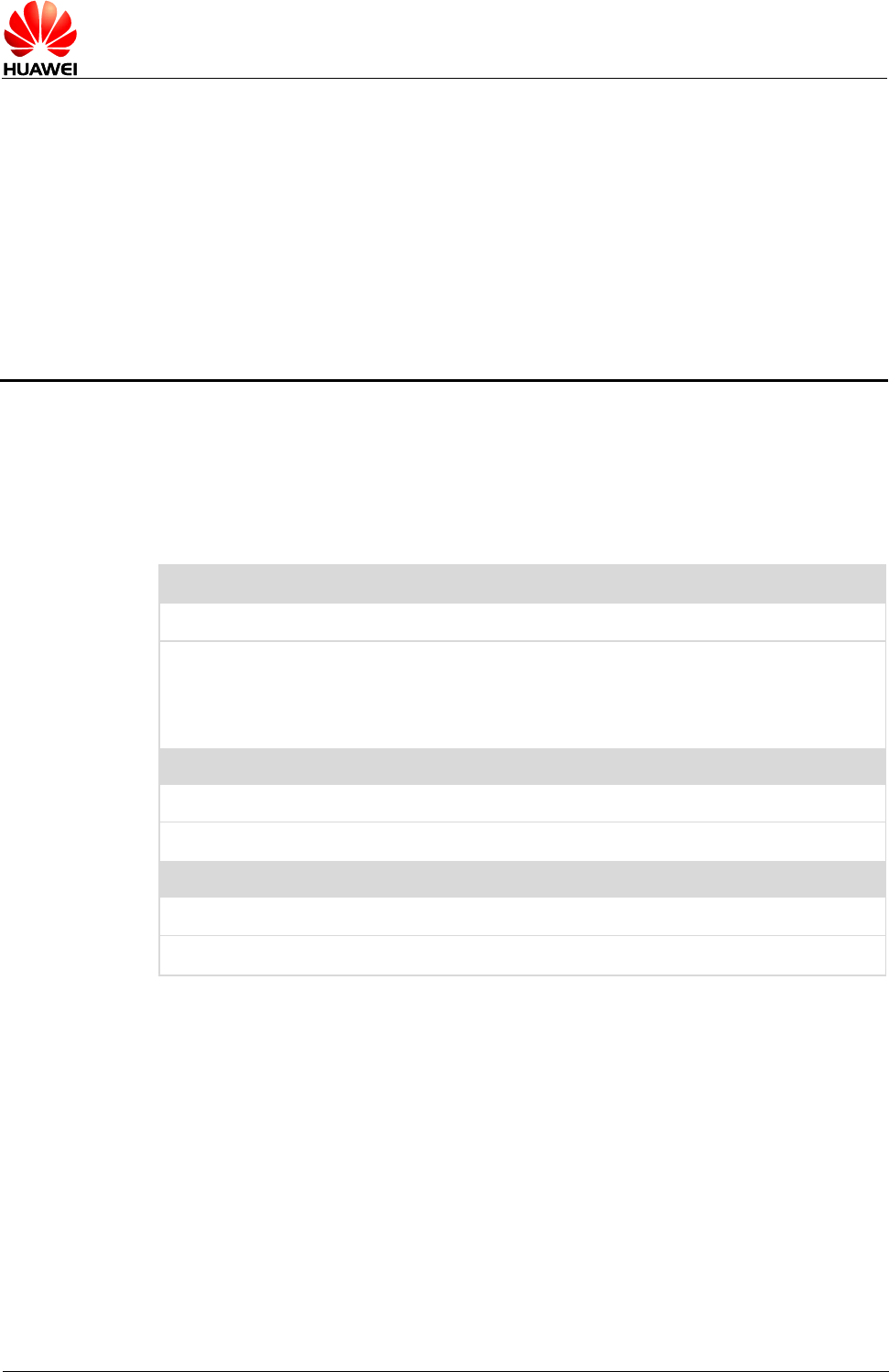
HUAWEI MU736 HSPA+ M.2 Module
AT Command Interface Specification
Mobile Termination Errors
Issue 02 (2013-12-24)
HUAWEI Proprietary and Confidential
Copyright © HUAWEI Technologies Co., Ltd.
60
6 Mobile Termination Errors
6.1 AT+CMEE–Report Mobile Termination Error
6.1.1 Command Syntax
AT+CMEE=<n>
Possible Response(s)
<CR><LF>OK<CR><LF>
In case of an MT-related error:
<CR><LF>ERROR<CR><LF>
AT+CMEE?
Possible Response(s)
<CR><LF>+CMEE: <n><CR><LF><CR><LF>OK<CR><LF>
AT+CMEE=?
Possible Response(s)
<CR><LF>+CMEE: (list of supported <n>s)<CR><LF><CR><LF>OK<CR><LF>
6.1.2 Interface Description
The set command disables or enables the use of result code +CME ERROR: <err> as
an indication of an error relating to the functionality of the MT. When enabled, MT
related errors cause the +CME ERROR: <err> final result code instead of the regular
ERROR final result code. Regular ERROR is returned when the error is not MT-related.
The read command queries the current format of the error result code.
The test command returns supported values of <n>.

HUAWEI MU736 HSPA+ M.2 Module
AT Command Interface Specification
Mobile Termination Errors
Issue 02 (2013-12-24)
HUAWEI Proprietary and Confidential
Copyright © HUAWEI Technologies Co., Ltd.
61
6.1.3 Parameter Description
<n>: an integer type value indicating the format of the error result code. If <n> is not
specified, it is equivalent to set <n> to 0.
0
Disable the +CME ERROR: <err> result code and use ERROR instead.
(default value)
1
Enable the +CME ERROR: <err> result code and use numeric <err> values.
2
Enable the +CME ERROR: <err> result code and use verbose <err> values.
<err>: see section 19.2 General CME Error List.
6.1.4 Property Description
Saving upon Power-off
PIN
N
N
6.1.5 Example
- Example 1:
Run:
AT+CMEE?
Response:
+CMEE: 2
OK
- Example 2:
Run:
AT+CMEE=1
Response:
OK
- Example 3:
Run:
AT+CMEE=?
Response:
+CMEE: (0,1,2)
OK

HUAWEI MU736 HSPA+ M.2 Module
AT Command Interface Specification
Commands for UMTS Packet Domain
Issue 02 (2013-12-24)
HUAWEI Proprietary and Confidential
Copyright © HUAWEI Technologies Co., Ltd.
62
7 Commands for UMTS Packet Domain
7.1 AT+CGDCONT–Define PDP Context
See the AT+CGDCONT command described in 3GPP TS 27.007. The following
description is for reference only. Observe the 3GPP specifications if the following
description conflicts with the 3GPP specifications.
7.1.1 Command Syntax
AT+CGDCONT=<cid>[,<PDP_type>[,<APN>[,<PDP_addr>[,<d_comp>[,<h_c
omp>]]]]]
Possible Response(s)
<CR><LF>OK<CR><LF>
In case of an MT-related error:
<CR><LF>+CME ERROR: <err><CR><LF>
AT+CGDCONT?
Possible Response(s)
<CR><LF>+CGDCONT: <cid>,<PDP_type>,<APN>,<PDP_addr>,<d_comp>,
<h_comp>[<CR><LF>+CGDCONT: <cid>,<PDP_type>,<APN>,<PDP_addr>,
<d_comp>,<h_comp><CR><LF>[...]]<CR><LF>OK<CR><LF>
AT+CGDCONT=?
Possible Response(s)
<CR><LF>+CGDCONT: (list of supported <cid>s),<PDP_type>,,,(list of
supported <d_comp>s),(list of supported
<h_comp>s)<CR><LF>[<CR><LF>+CGDCONT: (list of supported
<cid>s),<PDP_type>,,,(list of supported <d_comp>s),(list of supported
<h_comp>s)<CR><LF>[...]]<CR><LF>OK<CR><LF>

HUAWEI MU736 HSPA+ M.2 Module
AT Command Interface Specification
Commands for UMTS Packet Domain
Issue 02 (2013-12-24)
HUAWEI Proprietary and Confidential
Copyright © HUAWEI Technologies Co., Ltd.
63
7.1.2 Interface Description
The MT locally saves a group of PDP contexts with <cid> as the index. Each record
of the saved setting environment contains a group of PDP-related parameters.
The set command saves the group of PDP-related parameters in the PDP contexts
that use <cid> as the index. Each PDP context is initially undefined. After the
command saves a group of parameters in a PDP context, the PDP context is defined.
The number of defined PDP contexts that can be saved at the same time is
determined by the value range of <cid>.
A special form of the set command, AT+CGDCONT=<cid> causes the values for
context number <cid> to become undefined.
The read command returns the current settings for each defined context displayed in
a separate line.
Note:
If all PDP contexts are undefined, the default parameters of PDP context are returned. In which,
the default value of <cid> is 1, and it will be saved when MT is powered off.
The test command returns all the values supported for each context. In the response,
the <PDP_type> value supported by the MT is taken as the index and displayed in a
separate line. Each context has a confirmed <PDP_type> value and includes the
supported value ranges of other parameters with the specified <PDP_type> value.
Each context is displayed in a separate line.
7.1.3 Parameter Description
<cid>:
1–11
Index of a PDP context. Other PDP-related commands can use this
index to use the defined PDP context.
<PDP_type>: a string parameter that specifies the type of packet data protocol.
IP
Internet Protocol
IPV6
Internet Protocol, version 6
IPV4V6
Dual stacks of Internet Protocol, version 4 and Internet Protocol,
version 6
<APN>: a string parameter that specifies the access point for accessing the GGSN or
the external packet data network. The maximum length of <APN> is 100 characters. If
the value is null or omitted, the subscription value will be requested.
<PDP_addr>: a string parameter that identifies the MT in the IPv4 address space
applicable to the PDP.
<d_comp>: a numeric parameter that controls PDP data compression.
0
Off

HUAWEI MU736 HSPA+ M.2 Module
AT Command Interface Specification
Commands for UMTS Packet Domain
Issue 02 (2013-12-24)
HUAWEI Proprietary and Confidential
Copyright © HUAWEI Technologies Co., Ltd.
64
If <d_comp> is not specified in the command, it is equivalent to <d_comp>=0.
Note:
It is not supported to set <d_comp> on.
<h_comp>: a numeric parameter that controls PDP header compression.
0
Off
1
On
2
RFC1144 (applicable for SNDCP only)
3
RFC2507
4
RFC3095 (applicable for PDCP only)
If <h_comp> is not specified in the command, it is equivalent to <h_comp>=0.
7.1.4 Property Description
Saving upon Power-off
PIN
Y
Y
7.1.5 Example
Run:
AT+CGDCONT=?
Query the supported
values of the
parameters
Response:
+CGDCONT: (1-11),"IP",,,(0),(0,
1,2,3,4)
+CGDCONT: (1-11),"IPV6",,,(0),(
0,1,2,3,4)
+CGDCONT: (1-11),"IPV4V6",,,(0)
,(0,1,2,3,4)
OK
Run:
AT+CGDCONT?

HUAWEI MU736 HSPA+ M.2 Module
AT Command Interface Specification
Commands for UMTS Packet Domain
Issue 02 (2013-12-24)
HUAWEI Proprietary and Confidential
Copyright © HUAWEI Technologies Co., Ltd.
65
Response:
+CGDCONT: 1,"IP","vcol.com","0.
0.0.0",0,0
OK
The MT saves one
PDP context, and the
<cid> value of this
context is 1.
Run:
AT+CGDCONT=3,"IP","abc.com","1
0.111.145.233",0,1
Save one PDP context
to the MT and set
<cid>=3
Response:
OK
Run:
AT+CGDCONT?
Response:
+CGDCONT: 1,"IP","vcol.com","0.
0.0.0",0,0
+CGDCONT: 3,"IP","abc.com","10.
111.145.233",0,1
OK
The PDP context has
been successfully
saved to the MT at the
previous step.
Run:
AT+CGDCONT=3
Remove the PDP
context with <cid>=3
Response:
OK
Run:
AT+CGDCONT?
Response:
+CGDCONT: 1,"IP","vcol.com","0.
0.0.0",0,0
OK
The PDP context with
<cid>=3 has been
removed.
7.2 AT+CGACT–Activate or Deactivate PDP Context
7.2.1 Command Syntax
AT+CGACT=[<state>[,<cid>[,<cid>[…]]]]
Possible Response(s)
<CR><LF>OK<CR><LF>
In case of an MT-related error:
<CR><LF>+CME ERROR: <err><CR><LF>
AT+CGACT?
Possible Response(s)
<CR><LF>+CGACT: <cid>,<state><CR><LF>[<CR><LF>+CGACT:
<cid>,<state><CR><LF>[...]]<CR><LF>OK<CR><LF>

HUAWEI MU736 HSPA+ M.2 Module
AT Command Interface Specification
Commands for UMTS Packet Domain
Issue 02 (2013-12-24)
HUAWEI Proprietary and Confidential
Copyright © HUAWEI Technologies Co., Ltd.
66
AT+CGACT=?
Possible Response(s)
<CR><LF>+CGACT: (list of supported
<state>s)<CR><LF><CR><LF>OK<CR><LF>
7.2.2 Interface Description
The set command activates or deactivates the specified PDP context(s). If <cid> is
not specified, all PDP contexts are activated or deactivated.
The read command returns the defined PDP Activation state.
The test command returns the supported values of <state>.
7.2.3 Parameter Description
<state>: indicates the state of PDP context activation.
0
Deactivated
1
Activated
<cid>: the index of a PDP context; specifies a particular PDP context definition.
7.2.4 Property Description
Saving upon Power-off
PIN
NA
Y
7.2.5 Example
Run:
AT+CGACT=1,1
Activate PDP contexts
Response:
OK
Run:
AT+CGACT=0,1
Deactivate PDP contexts
Response:
OK
Response:
AT+CGACT?
Response:
+CGACT: 1,0
OK
Query the state of PDP context
activation

HUAWEI MU736 HSPA+ M.2 Module
AT Command Interface Specification
Commands for UMTS Packet Domain
Issue 02 (2013-12-24)
HUAWEI Proprietary and Confidential
Copyright © HUAWEI Technologies Co., Ltd.
67
7.3 AT+CGATT–Attach or Detach PS Domain
7.3.1 Command Syntax
AT+CGATT=[<state>]
Possible Response(s)
<CR><LF>OK<CR><LF>
In case of an MT-related error:
<CR><LF>ERROR<CR><LF> or
<CR><LF>+CME ERROR: <err><CR><LF>
AT+CGATT?
Possible Response(s)
<CR><LF>+CGATT: <state><CR><LF><CR><LF>OK<CR><LF>
AT+CGATT=?
Possible Response(s)
<CR><LF>+CGATT: (list of supported
<state>s)<CR><LF><CR><LF>OK<CR><LF>
7.3.2 Interface Description
The set command attaches the MT to, or detaches the MT from, the packet-switched
(PS) domain service. After the command has been completed, the MT remains in
V.25ter command state. If the MT is already in the requested state, the command is
ignored and OK is returned. If the requested state cannot be achieved, an ERROR or
+CME ERROR response is returned. Extended error responses are enabled by the
AT+CMEE command.
Any active PDP contexts will be automatically deactivated when the attachment state
changes to detached.
The read command returns the current GPRS service state.
The test command requests information about the supported PS domain service
states.
7.3.3 Parameter Description
<state>: indicates the state of PS domain service.
0
Detached
1
Attached
Other values are reserved and will result in an ERROR response to the set command.

HUAWEI MU736 HSPA+ M.2 Module
AT Command Interface Specification
Commands for UMTS Packet Domain
Issue 02 (2013-12-24)
HUAWEI Proprietary and Confidential
Copyright © HUAWEI Technologies Co., Ltd.
68
7.3.4 Property Description
Saving upon Power-off
PIN
NA
Y
7.3.5 Example
Run:
AT+CGATT?
Response:
+CGATT: 1
OK
Run:
AT+CGATT=0
Response:
OK
7.4 AT+CGREG–PS Domain Registration Status
7.4.1 Command Syntax
AT+CGREG=[<n>]
Possible Response(s)
<CR><LF>OK<CR><LF>
In case of an MT-related error:
<CR><LF>+CME ERROR: <err><CR><LF>
AT+CGREG?
Possible Response(s)
<CR><LF>+CGREG:
<n>,<stat>[,<lac>,<ci>[,<AcT>,<rac>]]<CR><LF><CR><LF>OK<CR><LF
>
AT+CGREG=?
Possible Response(s)
<CR><LF>+CGREG: (list of supported <n>s)<CR><LF><CR><LF>OK<CR><LF>
7.4.2 Interface Description
The set command controls the presentation of an unsolicited result code +CGREG.

HUAWEI MU736 HSPA+ M.2 Module
AT Command Interface Specification
Commands for UMTS Packet Domain
Issue 02 (2013-12-24)
HUAWEI Proprietary and Confidential
Copyright © HUAWEI Technologies Co., Ltd.
69
when <n>=1 and there is a change in the MT's network registration status, +CGREG:
<stat> is presented.
When <n>=2 and there is a change in the network cell, +CGREG:
<stat>[,<lac>,<ci>[,<AcT>,<rac>]] is presented. In this case <AcT>, <lac>,
<rac> and <ci> are sent only if available.
The read command returns the current registration state <stat>. Location
information elements <lac> and <ci> are returned only when <n>=2.
The test command returns the <n> values supported by the UE.
7.4.3 Parameter Description
<n>:
0
Disable unsolicited result code +CGREG. (default value)
1
Enable unsolicited result code +CGREG: <stat>.
2
Enable network registration and location information unsolicited result
code +CGREG: <stat>[,<lac>,<ci>[,<AcT>,<rac>]].
<stat>:
0
Not registered, MT is not currently searching for a new operator to
register with.
1
Registered, home network
2
Not registered, but MT is currently searching a new operator to register
with.
3
Registration denied
4
Unknown
5
Registered, roaming
<lac>: string type; two byte location area code or tracking area code in hexadecimal
format (e.g. "00C3" equals 195 in decimal, and means two bytes of "0x00" and
"0xC3").
<ci>: string type; four byte GERAN/UTRAN/E-UTRAN cell ID in hexadecimal format.
<AcT>: access to technology.
0
GSM
1
GSM Compact (not supported currently)
2
UTRAN
3
GSM w/EGPRS (see Note 1)
4
UTRAN w/HSDPA (see Note 2)
5
UTRAN w/HSUPA (see Note 2)
6
UTRAN w/HSDPA and HSUPA (see Note 2)
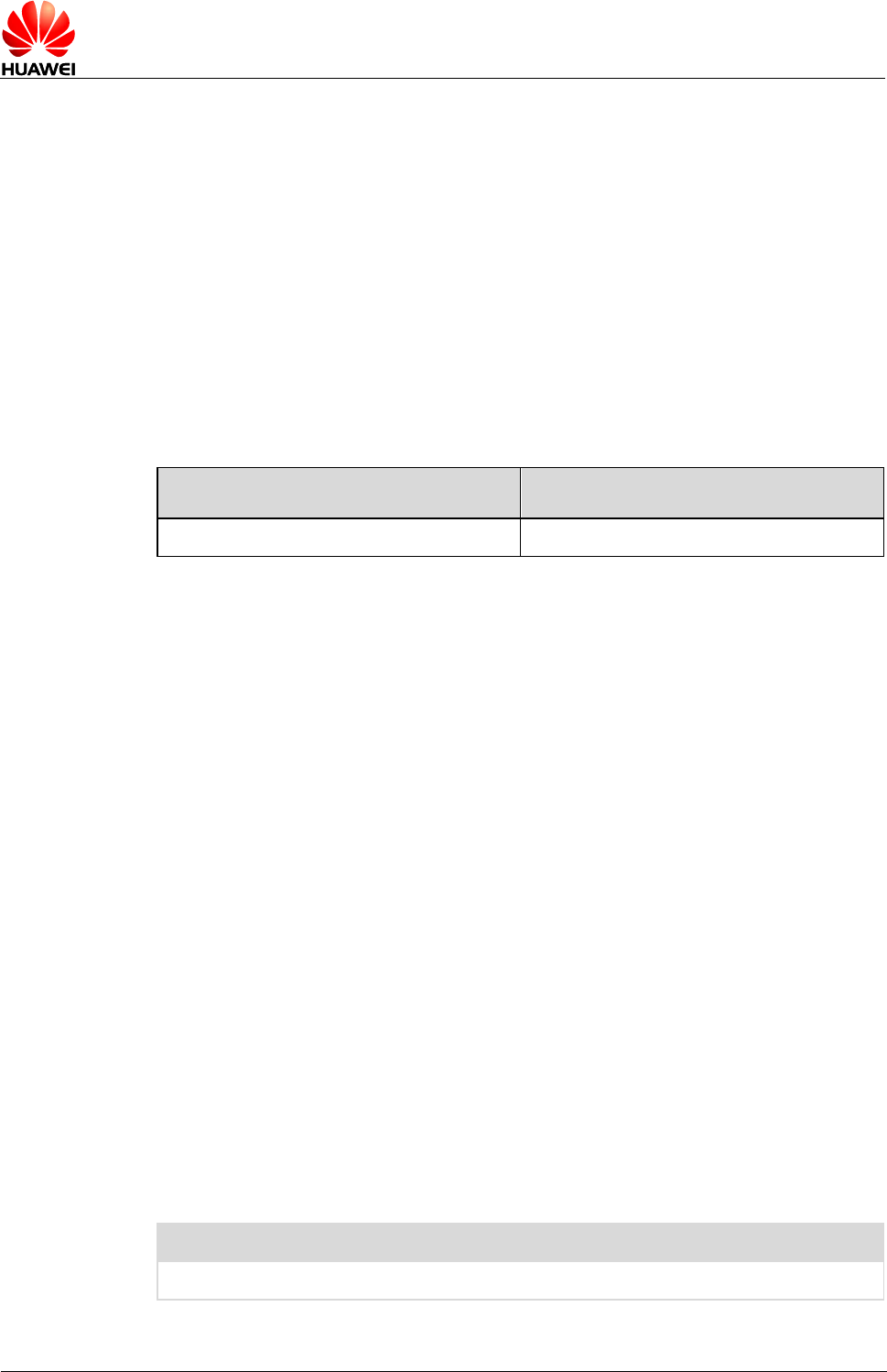
HUAWEI MU736 HSPA+ M.2 Module
AT Command Interface Specification
Commands for UMTS Packet Domain
Issue 02 (2013-12-24)
HUAWEI Proprietary and Confidential
Copyright © HUAWEI Technologies Co., Ltd.
70
7
E-UTRAN (not supported currently)
Notes:
1. 3GPP TS 44.060 specifies the system information messages which give the information
about whether the serving cell supports EGPRS.
2. 3GPP TS 25.331 specifies the system information blocks which give the information about
whether the serving cell supports HSDPA or HSUPA.
<rac>: routing area code; two hexadecimal characters. (not supported currently,
always returns "00").
7.4.4 Property Description
Saving upon Power-off
PIN
N
Y
7.4.5 Example
Run:
AT+CGREG?
Response:
+CGREG: 0,1
OK
Run:
AT+CGREG=?
Response:
+CGREG: (0-2)
OK
Run:
AT+CGREG?
Response:
+CGREG: 2,1,"2513","000E01F4",6,"00"
OK
7.5 AT+CGSMS–SMS Bearer Domain
7.5.1 Command Syntax
AT+CGSMS=<service>
Possible Response(s)

HUAWEI MU736 HSPA+ M.2 Module
AT Command Interface Specification
Commands for UMTS Packet Domain
Issue 02 (2013-12-24)
HUAWEI Proprietary and Confidential
Copyright © HUAWEI Technologies Co., Ltd.
71
<CR><LF>OK<CR><LF>
In case of an MT-related error:
<CR><LF>+CME ERROR: <err><CR><LF>
AT+CGSMS?
Possible Response(s)
<CR><LF>+CGSMS: <service><CR><LF><CR><LF>OK<CR><LF>
AT+CGSMS=?
Possible Response(s)
<CR><LF>+CGSMS: (list of supported
<service>s)<CR><LF><CR><LF>OK<CR><LF>
7.5.2 Interface Description
The set command sets the SMS bear domain, that is, the selection of the CS/PS
domain.
The read command returns the current SMS bearer domain.
The test command returns the supported parameter values.
7.5.3 Parameter Description
<service>:
0
PS domain
1
CS domain (default value)
2
PS domain preferred
3
CS domain preferred
7.5.4 Property Description
Saving upon Power-off
PIN
N
N
7.5.5 Example
Run:
AT+CGSMS?
Response:
+CGSMS: 1
OK

HUAWEI MU736 HSPA+ M.2 Module
AT Command Interface Specification
Commands for UMTS Packet Domain
Issue 02 (2013-12-24)
HUAWEI Proprietary and Confidential
Copyright © HUAWEI Technologies Co., Ltd.
72
Run:
AT+CGSMS=?
Response:
+CGSMS: (0-3)
OK
Run:
AT+CGSMS=2
Response:
OK
Run:
AT+CGSMS?
Response:
+CGSMS: 2
OK

HUAWEI MU736 HSPA+ M.2 Module
AT Command Interface Specification
PDU Mode Commands for SMS
Issue 02 (2013-12-24)
HUAWEI Proprietary and Confidential
Copyright © HUAWEI Technologies Co., Ltd.
73
8 PDU Mode Commands for SMS
8.1 AT+CSMS–Select Message Service
8.1.1 Command Syntax
AT+CSMS=<service>
Possible Response(s)
<CR><LF>+CSMS: <mt>,<mo>,<bm><CR><LF><CR><LF>OK<CR><LF>
AT+CSMS?
Possible Response(s)
<CR><LF>+CSMS:
<service>,<mt>,<mo>,<bm><CR><LF><CR><LF>OK<CR><LF>
AT+CSMS=?
Possible Response(s)
<CR><LF>+CSMS: (list of supported
<service>s)<CR><LF><CR><LF>OK<CR><LF>
8.1.2 Interface Description
The set command selects messaging service <service>. It returns the types of
messages supported by the ME: <mt> for mobile terminated messages, <mo> for
mobile originated messages and <bm> for broadcast type messages.
The read command returns supported message types along the current service
setting.
The test command returns a list of all services supported by the ME.
8.1.3 Parameter Description
<service>: messaging service type.

HUAWEI MU736 HSPA+ M.2 Module
AT Command Interface Specification
PDU Mode Commands for SMS
Issue 02 (2013-12-24)
HUAWEI Proprietary and Confidential
Copyright © HUAWEI Technologies Co., Ltd.
74
0
3GPP TS 23.040, 3GPP TS 23.041 (Messaging AT command syntax is
compatible with GSM 07.05 Phase 2.) (default value)
1
3GPP TS 23.040, 3GPP TS 23.041 (Messaging AT command syntax is
compatible with GSM 07.05 Phase 2+. Note that <service>=1 is
required for +CNMA.)
<mt>, <mo>, <bm>: integer type values, which respectively indicate whether the MT
supports mobile terminated messages, mobile originated messages and broadcast
type messages.
0
Type not supported
1
Type supported
8.1.4 Property Description
Saving upon Power-off
PIN
N
N
8.1.5 Example
Run:
AT+CSMS=?
Response:
+CSMS: (0-1)
OK
Run:
AT+CSMS?
Response:
+CSMS: 0,1,1,1
OK
Run:
AT+CSMS=1
Response:
+CSMS: 1,1,1
OK
Run:
AT+CSMS?
Response:
+CSMS: 1,1,1,1
OK

HUAWEI MU736 HSPA+ M.2 Module
AT Command Interface Specification
PDU Mode Commands for SMS
Issue 02 (2013-12-24)
HUAWEI Proprietary and Confidential
Copyright © HUAWEI Technologies Co., Ltd.
75
8.2 AT+CPMS–Select Message Storage
8.2.1 Command Syntax
AT+CPMS=<mem1>[,<mem2>[,<mem3>]]
Possible Response(s)
<CR><LF>+CPMS:
<used1>,<total1>,<used2>,<total2>,<used3>,<total3><CR><LF><C
R><LF>OK<CR><LF>
In case of an MS-related error:
<CR><LF>+CMS ERROR: <err><CR><LF>
AT+CPMS?
Possible Response(s)
<CR><LF>+CPMS:
<mem1>,<used1>,<total1>,<mem2>,<used2>,<total2>,<mem3>,<used3
>,<total3><CR><LF><CR><LF>OK<CR><LF>
In case of an MS-related error:
<CR><LF>+CMS ERROR: <err><CR><LF>
AT+CPMS=?
Possible Response(s)
<CR><LF>+CPMS: (list of supported <mem1>s),(list of supported
<mem2>s),(list of supported <mem3>s)<CR><LF><CR><LF>OK<CR><LF>
8.2.2 Interface Description
The set command selects memory storages <mem1>, <mem2> and <mem3> to be
used for reading, writing, etc. The set command also returns the usage of the
currently selected memory storages.
The read command returns the names and the usage of the selected memory
storages.
The test command returns lists of memory storages supported by the MT.
8.2.3 Parameter Description
<mem1>: a string type value that specifies the memory storage used for reading and
deleting messages. Available values are:
"SM"
(U)SIM card (default value)
"BM"
Broadcast message storage

HUAWEI MU736 HSPA+ M.2 Module
AT Command Interface Specification
PDU Mode Commands for SMS
Issue 02 (2013-12-24)
HUAWEI Proprietary and Confidential
Copyright © HUAWEI Technologies Co., Ltd.
76
<mem2>: a string type value that specifies the memory storage used for writing and
sending messages. Available value is:
"SM"
(U)SIM card
<mem3>: a string type value that specifies the memory storage used for receiving
messages. Available values of this field are the same as those of the <mem1> field.
The default value is the same with <mem1>.
<total1>: an integer type value that indicates the capacity of <mem1> for storing
messages.
<total2>: an integer type value that indicates the capacity of <mem2> for storing
messages.
<total3>: an integer type value that indicates the capacity of <mem3> for storing
messages.
<used1>: an integer type value that indicates the number of messages currently
saved in the memory storage specified by <mem1>.
<used2>: an integer type value that indicates the number of messages currently
saved in the memory storage specified by <mem2>.
<used3>: an integer type value that indicates the number of messages currently
saved in the memory storage specified by <mem3>.
8.2.4 Property Description
Saving upon Power-off
PIN
N
Y
8.2.5 Example
Run:
AT+CPMS=?
Response:
+CPMS: ("SM","BM"),("SM"),("SM","BM")
OK
Run:
AT+CPMS="SM"
Response:
+CPMS: 6,50,6,50,6,50
OK
Run:
AT+CPMS?
Response:
+CPMS: "SM",6,50,"SM",6,50,"SM",6,50
OK
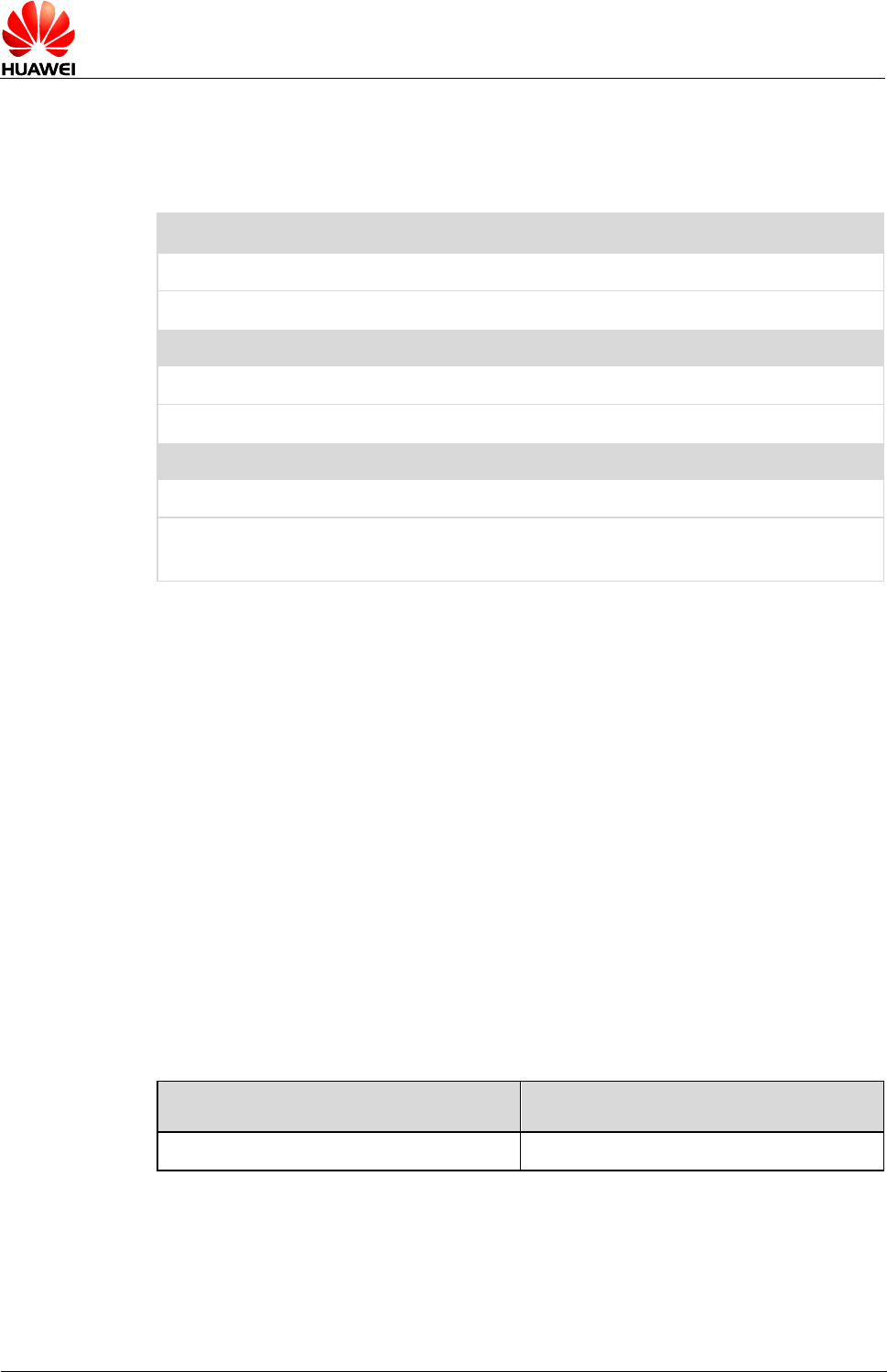
HUAWEI MU736 HSPA+ M.2 Module
AT Command Interface Specification
PDU Mode Commands for SMS
Issue 02 (2013-12-24)
HUAWEI Proprietary and Confidential
Copyright © HUAWEI Technologies Co., Ltd.
77
8.3 AT+CMGF–Set Message Format
8.3.1 Command Syntax
AT+CMGF=[<mode>]
Possible Response(s)
<CR><LF>OK<CR><LF>
AT+CMGF?
Possible Response(s)
<CR><LF>+CMGF: <mode><CR><LF><CR><LF>OK<CR><LF>
AT+CMGF=?
Possible Response(s)
<CR><LF>+CMGF: (list of supported
<mode>s)<CR><LF><CR><LF>OK<CR><LF>
8.3.2 Interface Description
The set command sets the message format. The format is specified by <mode>, which
can be either PDU mode or TEXT mode. For details about the message format in
PDU mode, see section 8.9 AT+CMGS–Send Short Message.
The read command returns the currently selected mode.
The test command returns supported values of <mode>.
8.3.3 Parameter Description
<mode>:
0
PDU mode (default value)
1
TEXT mode (the MU736 module only supports PDU mode)
8.3.4 Property Description
Saving upon Power-off
PIN
N
N
8.3.5 Example
Run:
AT+CMGF=0

HUAWEI MU736 HSPA+ M.2 Module
AT Command Interface Specification
PDU Mode Commands for SMS
Issue 02 (2013-12-24)
HUAWEI Proprietary and Confidential
Copyright © HUAWEI Technologies Co., Ltd.
78
Response:
OK
Run:
AT+CMGF?
Response:
+CMGF: 0
OK
8.4 AT+CSCA–Service Center Address
8.4.1 Command Syntax
AT+CSCA=<sca>[,<tosca>]
Possible Response(s)
<CR><LF>OK<CR><LF>
In case of an MS-related error:
<CR><LF>+CMS ERROR: <err><CR><LF>
AT+CSCA?
Possible Response(s)
<CR><LF>+CSCA: <sca>,<tosca><CR><LF><CR><LF>OK<CR><LF>
In case of an MS-related error:
<CR><LF>+CMS ERROR: <err><CR><LF>
AT+CSCA=?
Possible Response(s)
<CR><LF>OK<CR><LF>
8.4.2 Interface Description
The set command sets the SMSC address. For SMS messages in PDU mode, this
command can be used only when the <sc_len> parameter in the PDU is set to 0 (for
details about the PDU format, see section 8.9 AT+CMGS–Send Short Message.
The read command queries the current values of the SMSC address.
The test command returns "OK".
8.4.3 Parameter Description
<sca>: a string type value that specifies the SMSC address. '*', '#', '+' and '0'–'9' are
allowed in the SMSC address. The maximum length of the SMSC address is 20
characters (excluding '+').
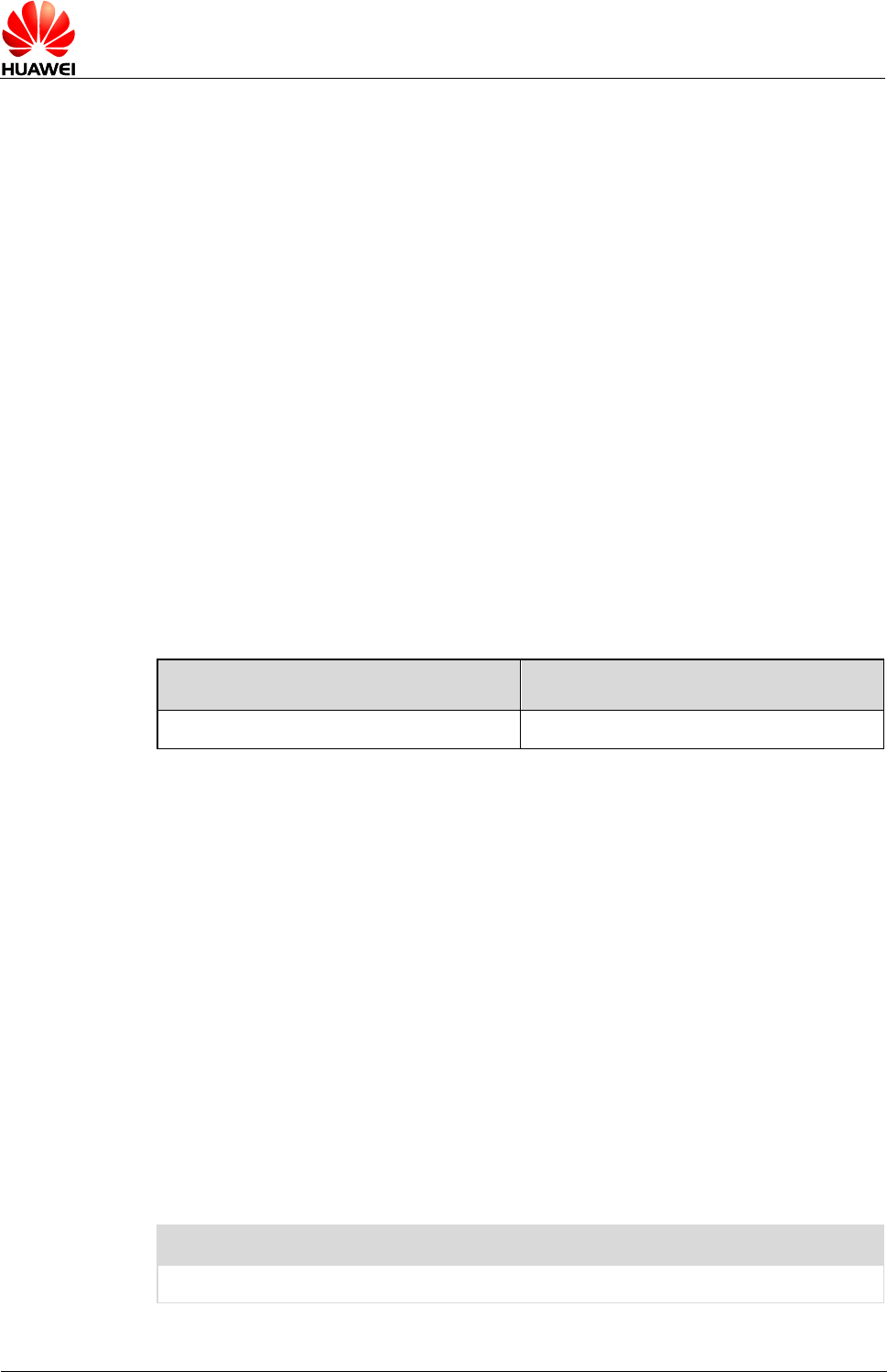
HUAWEI MU736 HSPA+ M.2 Module
AT Command Interface Specification
PDU Mode Commands for SMS
Issue 02 (2013-12-24)
HUAWEI Proprietary and Confidential
Copyright © HUAWEI Technologies Co., Ltd.
79
<tosca>: an integer type value that specifies the address type. If the value of
<tosca> is 145, the address is an international phone number. For details about the
values of <tosca>, see the value definitions of <type_addr> in 8.9
AT+CMGS–Send Short Message.
Notes:
- Set command
If <sca> starts with the plus sign (+), the value of <tosca> is 145. If <sca> does not start with
the plus sign (+), the value of <tosca> is specified by the Set command.
If <sca> does not start with the plus sign (+) and <tosca> is not specified in the Set command,
the value of <tosca> is 129.
- Read command
If the value of <tosca> is 145, the plus sign (+) is added before <sca>. If the value of
<tosca> is not 145, the plus sign (+) is not added before <sca>.
<sca> is stored in the EFsmsp file on the SIM card, so no default value is defined for
<sca>. The value of <sca> contained in the response to the AT+CSCA? command is
the value stored on the SIM card.
8.4.4 Property Description
Saving upon Power-off
PIN
Y
Y
8.4.5 Example
Run:
AT+CSCA="+8613800688509",145
Response:
OK
Run:
AT+CSCA?
Response:
+CSCA: "+8613800688509",145
OK
8.5 AT+CNMI–Indicate New Message to TE
8.5.1 Command Syntax
AT+CNMI=[<mode>[,<mt>[,<bm>[,<ds>[,<bfr>]]]]]
Possible Response(s)

HUAWEI MU736 HSPA+ M.2 Module
AT Command Interface Specification
PDU Mode Commands for SMS
Issue 02 (2013-12-24)
HUAWEI Proprietary and Confidential
Copyright © HUAWEI Technologies Co., Ltd.
80
<CR><LF>OK<CR><LF>
In case of an MS-related error:
<CR><LF>+CMS ERROR: <err><CR><LF>
AT+CNMI?
Possible Response(s)
<CR><LF>+CNMI:
<mode>,<mt>,<bm>,<ds>,<bfr><CR><LF><CR><LF>OK<CR><LF>
AT+CNMI=?
Possible Response(s)
<CR><LF>+CNMI: (list of supported <mode>s),(list of supported <mt>s),(list
of supported <bm>s),(list of supported <ds>s),(list of supported
<bfr>s)<CR><LF><CR><LF>OK<CR><LF>
8.5.2 Interface Description
The set command selects the procedure of receiving new messages from the
network.
The read command queries the current parameter values.
The test command returns the supported parameter values.
Notes:
- The values set in this command are reset to 0 after the MT is restarted. In this case, no
messages are sent to the TE. AT+CNMI=0,0,0,0,0 is not recommended.
- AT+CNMI is equivalent to AT+CNMI=0,0,0,0,0.
8.5.3 Parameter Description
<mode>: controls how new message indications are sent.
0
Buffer SMS-DELIVER indications in the ME. If the ME buffer is full, then
the oldest indication is overwritten by the latest indication. (default
value)
1
Directly send SMS-DELIVER indications to the TE. When a
SMS-DELIVER indication cannot be sent (for example, when in online
data mode), it will be discarded.
2
Directly send SMS-DELIVER indications and message status reports to
the TE. When a SMS-DELIVER indication and message status report
cannot be sent (for example, when in online data mode), they are
buffered in the ME and sent to the TE when they can be sent.
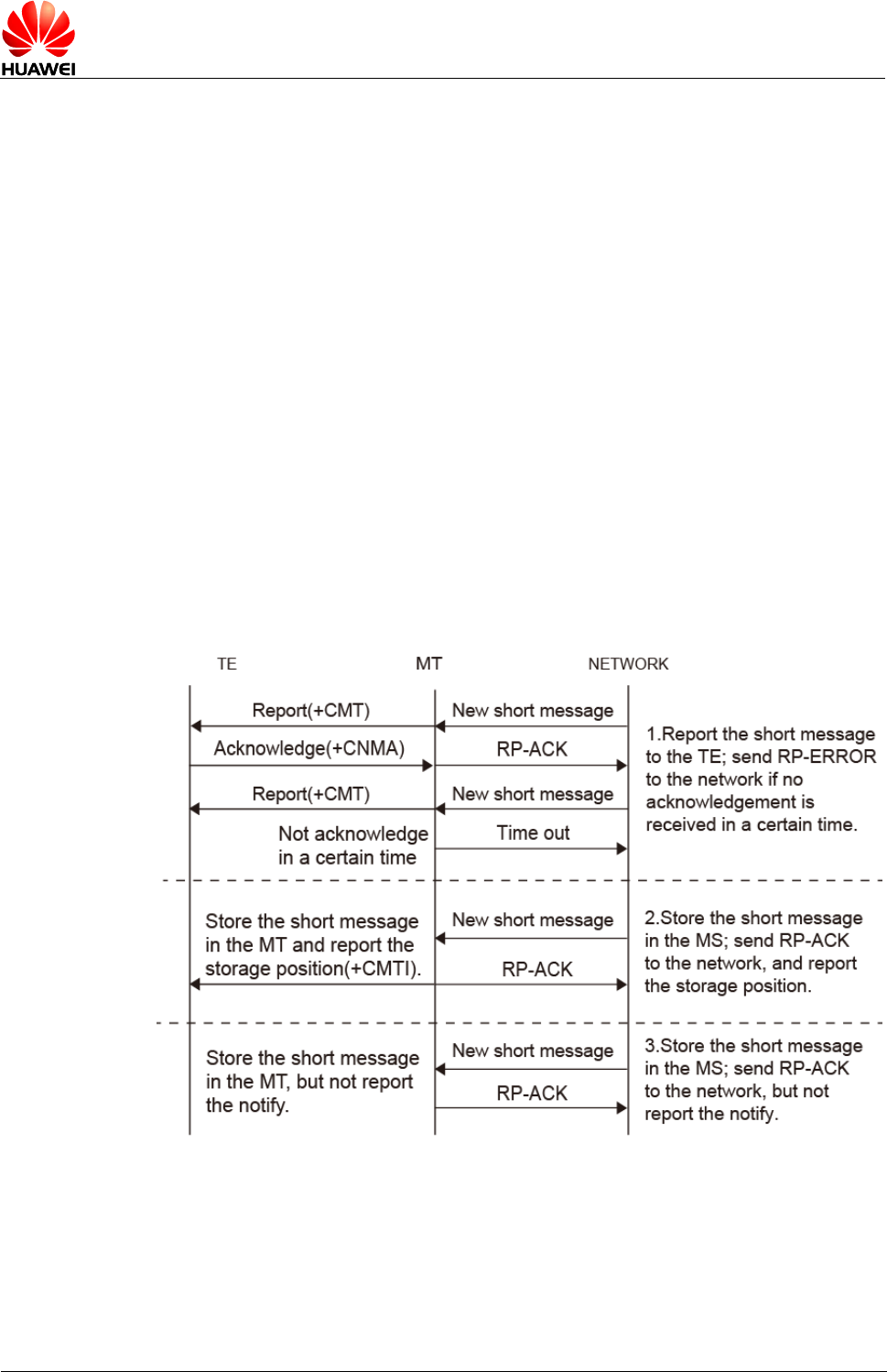
HUAWEI MU736 HSPA+ M.2 Module
AT Command Interface Specification
PDU Mode Commands for SMS
Issue 02 (2013-12-24)
HUAWEI Proprietary and Confidential
Copyright © HUAWEI Technologies Co., Ltd.
81
Note:
SMS-DELIVER indications are buffered in the MT's volatile memory. If the MT is powered off
before the indications are sent, messages may be lost. Therefore, when <mode> is set to 0 or 2,
messages cannot be set to be directly sent to the TE (that is, <mt> cannot be set to 2 or 3).
<mt>: set the rules for saving messages and sending SMS-DELIVER indications.
0
No SMS-DELIVER indications are routed to the TE. (default value)
1
Store SMS-DELIVER indications on the MT and sends storage location
indication to the TE.
+CMTI: <mem>,<index>
2
Do not store SMS-DELIVER indications on the MT but directly sends
them to the TE.
If PDU mode enabled:
+CMT: [<reserved>],<length><CR><LF><pdu>
3
Store SMS-DELIVER indications on the MT, but does not send
SMS-DELIVER indications to the TE.
The following figure illustrates the interaction between the TE and the MT for the
previous three modes.
The following table describes the <mt> values and the corresponding indications.

HUAWEI MU736 HSPA+ M.2 Module
AT Command Interface Specification
PDU Mode Commands for SMS
Issue 02 (2013-12-24)
HUAWEI Proprietary and Confidential
Copyright © HUAWEI Technologies Co., Ltd.
82
<mt>
no class or
class 1
class 0 or message
waiting indication
group (discard)
class 2 or message
waiting indication
group (store)
class 3
0
1
+CMTI
[+CMTI]
+CMTI
+CMTI
2
+CMT &
+CNMA
+CMT [& +CNMA]
+CMTI
+CMT & +CNMA
3
+CMTI
[+CMTI]
+CMTI
+CMT & +CNMA
Notes:
- The SMS class is defined by the TP-DCS domain of the SMS. For details, see the
description of <DCS> in 8.9 AT+CMGS–Send Short Message.
- "+CMT & +CNMA" indicates that the TE is required to send the confirmation (+CNMA).
<bm>: set the rules for saving CBMs and sending CBM indications.
0
No CBM indications are routed to the TE. (default value)
1
If CBM is stored into ME/TA, indication of the memory location is routed
to the TE using unsolicited result code:
+CBMI: <mem>,<index>
2
New CBMs are routed directly to the TE using unsolicited result code:
If PDU mode enabled:
+CBM: <length><CR><LF><pdu>
3
Class 3 CBMs are routed directly to TE using unsolicited result codes
defined in <bm>=2. If CBM storage is supported, messages of other
classes result in indication as defined in <bm>=1.
If ME supports data coding groups which define special routing also for messages
other than class 3 (for example, (U)SIM specific messages), ME may choose not to
route messages of such data coding schemes into TE (indication of a stored CBM
may be given as defined in <bm>=1).
Table 8-1 Parameters of <bm>
<bm>
Receiving procedure for different message data coding schemes (refer
3GPP TS 23.038)
0
All schemes: as in 3GPP TS 23.038; if CBM storage is supported, store
message to "BM" (or some manufacturer or data coding scheme specific
memory).
1
All schemes: as <bm>=0 but send indication if message stored
successfully.
2
All schemes: route message to TE unless ME has detected a special
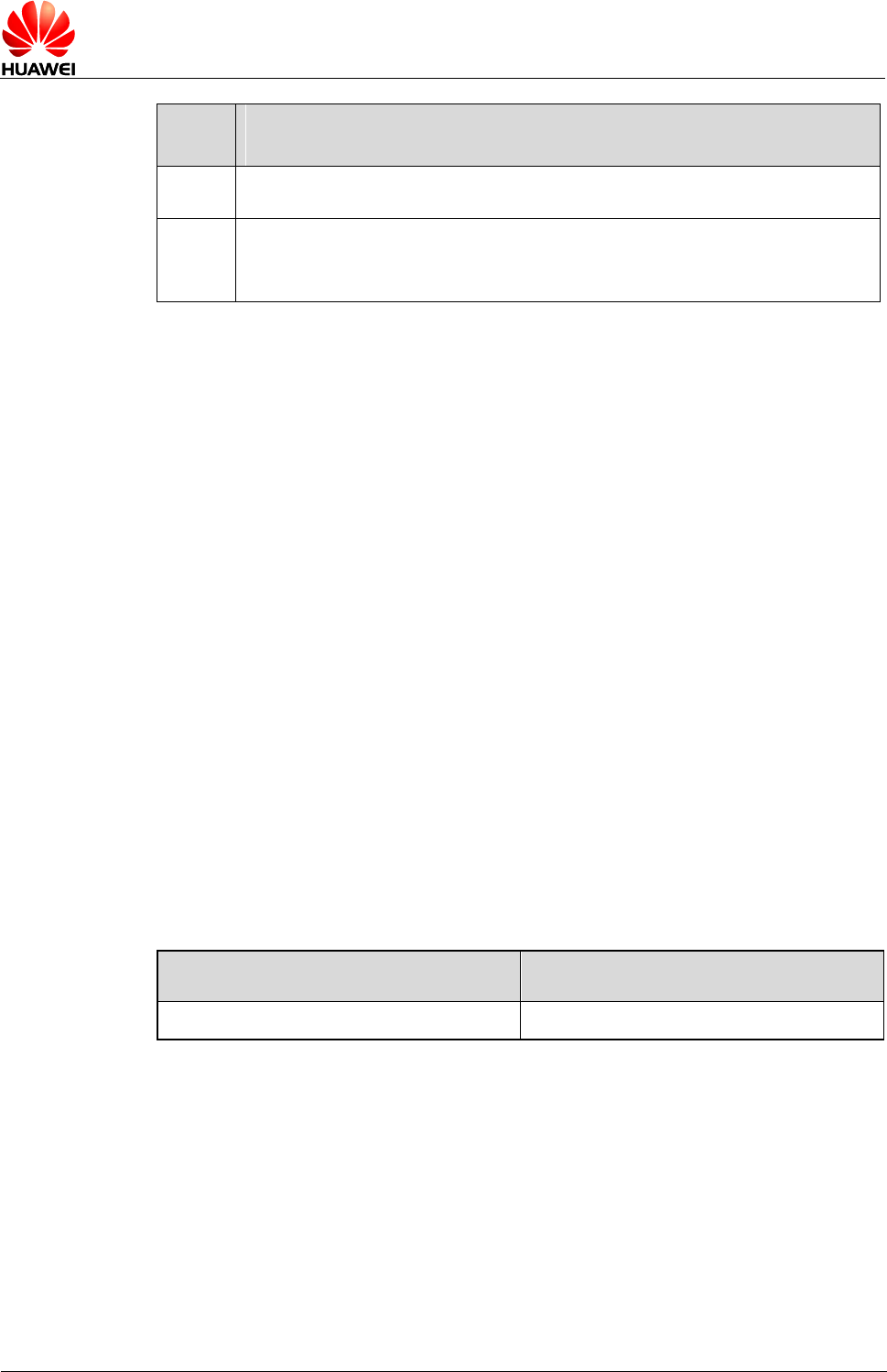
HUAWEI MU736 HSPA+ M.2 Module
AT Command Interface Specification
PDU Mode Commands for SMS
Issue 02 (2013-12-24)
HUAWEI Proprietary and Confidential
Copyright © HUAWEI Technologies Co., Ltd.
83
<bm>
Receiving procedure for different message data coding schemes (refer
3GPP TS 23.038)
routing to somewhere else (for example, to (U)SIM; an indication may be
sent if message stored successfully).
3
All schemes: as in 3GPP TS 23.038; if CBM storage is supported, store
message to "BM" (or some manufacturer or data coding scheme specific
memory).
<ds>: set whether to send message status reports.
0
Do not send message status reports. (default value)
1
Do not store message status reports to the MT and directly send the
reports to the TE.
If PDU mode enabled:
+CDS: <length><CR><LF><pdu>
2
Store message status reports to the MT and send the storage location
to the TE using +CDSI.
+CDSI: <mem>,<index>
<bfr>: specifies how the buffer is handled after the MT switches from <mode>=0 to
<mode>=1 or <mode>=2.
0
After switching from <mode>=0 to <mode>=1 or <mode>=2, the MT
sends all the unsolicited result code in its buffer to the TE. (default
value)
1
After switching from <mode>=0 to <mode>=1 or <mode>=2, the MT
clears the buffer and all unsolicited result codes in the buffer are
discarded.
8.5.4 Property Description
Saving upon Power-off
PIN
N
N
8.5.5 Example
1. AT+CNMI=1,1,0,1,0
Class 1 messages are stored to the MT, and then storage locations are reported
(+CMTI: "ME",1). Message status reports are directly sent (+CDS:).
If SMS-DELIVER indications cannot be sent (for example, when in online data
state), they will be discarded.
2. AT+CNMI=1,1,0,2,0

HUAWEI MU736 HSPA+ M.2 Module
AT Command Interface Specification
PDU Mode Commands for SMS
Issue 02 (2013-12-24)
HUAWEI Proprietary and Confidential
Copyright © HUAWEI Technologies Co., Ltd.
84
Class 1 messages are stored to the MS, and then storage locations are reported
(+CMTI: "ME",1). Message status reports are stored to the MS, and then
storage locations are reported (+CDSI: "ME",2).
If SMS-DELIVER indications cannot be sent (for example, when in online data
state), they will be discarded.(The SMS messages and SMS-DELIVER
indications are stored in the MS and can be read using the AT+CMGL command;
however, the TE cannot receive the indications.)
3. Other commonly-used settings include:
AT+CNMI=1,1,0,0,0: store the messages, and then send the storage locations
to the TE; do not send the message status reports.
AT+CNMI=1,2,0,0,0: do not store the messages but directly send them to the
TE; do not send the message status reports.
8.6 AT+CMGD–Delete Message
8.6.1 Command Syntax
AT+CMGD=<index>[,<delflag>]
Possible Response(s)
<CR><LF>OK<CR><LF>
In case of an MS-related error:
<CR><LF>+CMS ERROR: <err><CR><LF>
AT+CMGD=?
Possible Response(s)
<CR><LF>+CMGD: (list of supported <index>s)[,(list of supported
<delflag>s)]<CR><LF><CR><LF>OK<CR><LF>
8.6.2 Interface Description
The set command deletes the message at location <index> in the storage <mem1>. If
the deletion fails, +CMS ERROR: <err> is returned.
For details about <mem1>, see section 8.2 AT+CPMS–Select Message Storage. If
<delflag> is set to a value other than 0, the MT ignores <index> and executes the
command as specified by <delflag>.
The test command returns storage locations that have messages and supported
<deflag> values.
8.6.3 Parameter Description
<index>: the storage location where the message is stored.
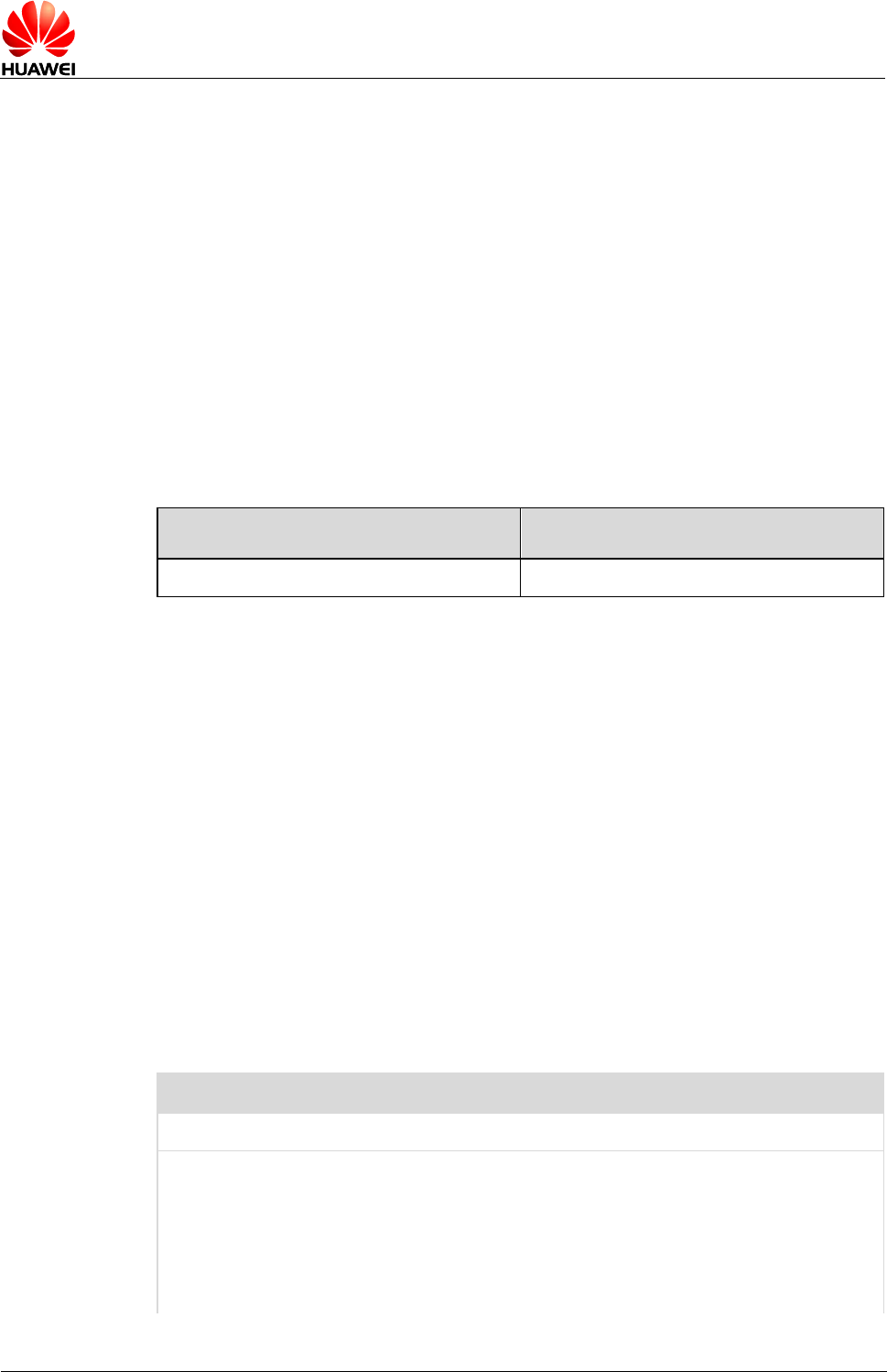
HUAWEI MU736 HSPA+ M.2 Module
AT Command Interface Specification
PDU Mode Commands for SMS
Issue 02 (2013-12-24)
HUAWEI Proprietary and Confidential
Copyright © HUAWEI Technologies Co., Ltd.
85
<delflag>:
0
Delete the message stored at the location specified by <index>.
(default value)
1
Delete all the read messages saved in the preferred storage, and keep
the unread, sent, and unsent ones.
2
Delete all the read and sent messages saved in the preferred storage,
and keep the unread and unsent ones.
3
Delete all the read, sent, and unsent messages saved in the preferred
storage, and keep the unread ones.
4
Delete all messages saved in the preferred storage, including the
unread ones.
8.6.4 Property Description
Saving upon Power-off
PIN
NA
Y
8.6.5 Example
Run:
AT+CMGD=?
Response:
+CMGD: (1,2,3,4,5,6),(0,1,2,3,4)
OK
Run:
AT+CMGD=4
Response:
OK
8.7 AT+CMGL–List Messages
8.7.1 Command Syntax
AT+CMGL[=<stat>]
Possible Response(s)
If in PDU mode and the command is executed successfully:
[<CR><LF>+CMGL:
<index>,<stat>,[<reserved>],<length><CR><LF><pdu>[<CR><LF>+CMG
L:
<index>,<stat>,[<reserved>],<length><CR><LF><pdu>[...]]<CR><LF>]<
CR><LF>OK<CR><LF>
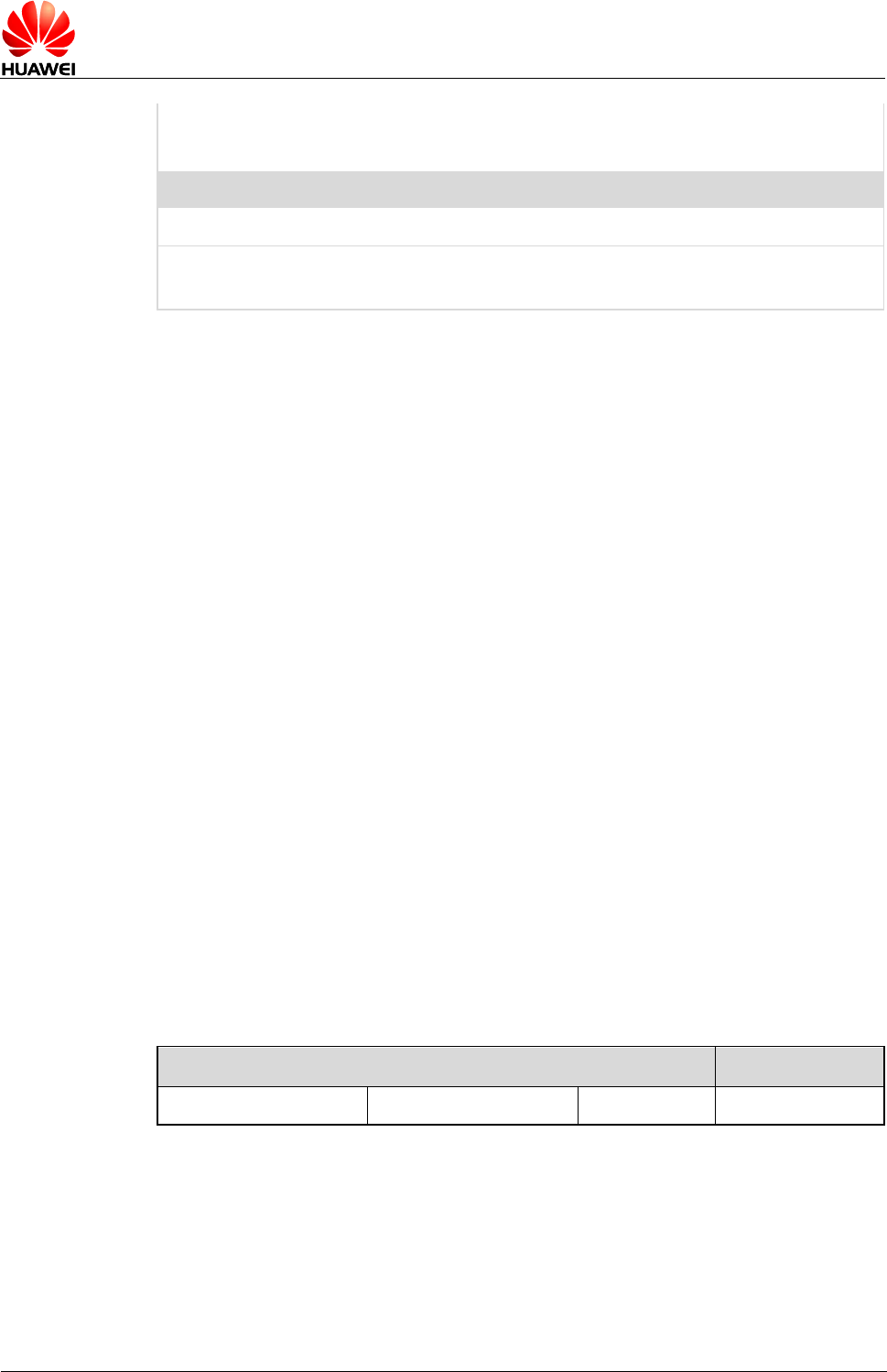
HUAWEI MU736 HSPA+ M.2 Module
AT Command Interface Specification
PDU Mode Commands for SMS
Issue 02 (2013-12-24)
HUAWEI Proprietary and Confidential
Copyright © HUAWEI Technologies Co., Ltd.
86
In case of an MS-related error:
<CR><LF>+CMS ERROR: <err><CR><LF>
AT+CMGL=?
Possible Response(s)
<CR><LF>+CMGL: (list of supported
<stat>s)<CR><LF><CR><LF>OK<CR><LF>
8.7.2 Interface Description
The set command returns messages with status value <stat> from message storage
<mem1> to the TE. If the status of the message is "received unread", status in the
storage changes to 'received read' after the set command is executed successfully.
When <stat> is not specified, the set command is equivalent to command
AT+CMGL=0.
The test command returns a list of supported <stat> values.
8.7.3 Parameter Description
<stat>: message status; default value is 0.
0
Received unread messages
1
Received read messages
2
Stored unsent messages
3
Stored sent messages
4
All messages
<index>: an integer type value that indicates the storage location of the message.
<reserved>: reserved.
<length>: an integer type value that indicates the number of bytes of TPDU data.
<pdu>: protocol data unit in the following format.
[<SCA>]
<sc_len>
<type_addr>
<numbers>
TPDU
For the definitions of <SCA>, <sc_len>, <type_addr>, <number> in the previous
table, see section 8.9 AT+CMGS–Send Short Message.
For the TPDU format of messages to be sent, see section 8.9 AT+CMGS–Send Short
Message. The TPDU format for received messages is described in the following table.

HUAWEI MU736 HSPA+ M.2 Module
AT Command Interface Specification
PDU Mode Commands for SMS
Issue 02 (2013-12-24)
HUAWEI Proprietary and Confidential
Copyright © HUAWEI Technologies Co., Ltd.
87
1 Oct
2
Oct~1
2 Oct
1
Oct
1 Oct
7 Oct
1Oct
1 Oct
TP-MTI
MMS
0
0
SRI
UDHI
RP
OA
PID
DCS
SCTS
UDL
UD
OA
Bit0
Bit1
Bit2
Bit3
Bit4
Bit5
Bit6
<MTI>: see the definition in section 8.9 AT+CMGS–Send Short Message.
<MMS>: indicates whether there are still other messages to be sent.
0
No
1
Yes
<SRI>: indicates whether the short message entity (SME) has requested a status
report.
0
No
1
Yes
<UDHI>: see the definition in section 8.9 AT+CMGS–Send Short Message.
<RP>: see the definition in section 8.9 AT+CMGS–Send Short Message.
<OA>: originating address. Its definition is the same as <sca>. There are a total of
2–12 octets. Therefore, the longest address in the <oa> field contains 20 digits.
<PID>: protocol identifier. See the definition in section 8.9 AT+CMGS–Send Short
Message.
<DCS>: use data coding scheme. See the definition in section 8.9 AT+CMGS–Send
Short Message.
<SCTS>: time stamp of the SMSC, consisting of year, month, date, hour, minute,
second and time difference. Time difference is the difference between the local time
and the Greenwich standard time.
<UDL>: user data length. See the definition in section 8.9 AT+CMGS–Send Short
Message.
<UD>: user data whose length is determined by <UDL>.
8.7.4 Property Description
Saving upon Power-off
PIN
NA
Y

HUAWEI MU736 HSPA+ M.2 Module
AT Command Interface Specification
PDU Mode Commands for SMS
Issue 02 (2013-12-24)
HUAWEI Proprietary and Confidential
Copyright © HUAWEI Technologies Co., Ltd.
88
8.7.5 Example
Run:
AT+CMGL=?
Response:
+CMGL: (0-4)
OK
Run:
AT+CMGL=4
Response:
+CMGL: 1,1,,24
0891683108608805F9040D91683109731147F4000031100151
64020004E139D90C
+CMGL: 2,1,,40
0891683108608805F9040E9168310973901274000031105111
5211001661FA6ADC3ECF7BA2D82C079BDD62B15BED266A00
+CMGL: 3,1,,26
0891683108608805F9040D91683109731157F7000031105111
72550006F770D97C2F03
+CMGL: 4,1,,20
0891683108608805F9040D91683109731157F7000031105111
82250000
+CMGL: 5,1,,28
0891683108608805F9040D91683109731157F7000031105111
0393000931D92C26A3C56434
+CMGL: 6,1,,30
0891683108608805F9040D91683109731157F7000031105111
3373000B31D92C26A3C564B3980C
OK
8.8 AT+CMGR–Read Message
8.8.1 Command Syntax
AT+CMGR=<index>
Possible Response(s)
If in PDU mode and the command is executed successfully:
<CR><LF>+CMGR:
<stat>,[<reserved>],<length><CR><LF><pdu><CR><LF><CR><LF>OK<C
R><LF>
In case of an MS-related error:
<CR><LF>+CMS ERROR: <err><CR><LF>

HUAWEI MU736 HSPA+ M.2 Module
AT Command Interface Specification
PDU Mode Commands for SMS
Issue 02 (2013-12-24)
HUAWEI Proprietary and Confidential
Copyright © HUAWEI Technologies Co., Ltd.
89
AT+CMGR=?
Possible Response(s)
<CR><LF>OK<CR><LF>
8.8.2 Interface Description
The set command returns the message with location value <index> from message
storage <mem1>. If the status of the message is "received unread", status in the
storage changes to "received read" after the set command is executed successfully.
The test command returns "OK".
8.8.3 Parameter Description
<index>: an integer type value that indicates the location in the storage.
<stat>: message status.
0
Received unread messages
1
Received read messages
2
Stored unsent messages
3
Stored sent messages
<reserved>: reserved.
<length>: an integer type value that indicates the number of bytes of PDU data.
<pdu>: protocol data unit. For details about the PDU format, see section 8.7.3 .
8.8.4 Property Description
Saving upon Power-off
PIN
NA
Y
8.8.5 Example
Run:
AT+CMGR=1
Response:
+CMGR: 1,,24
0891683108608805F9040D91683109731147F4000031100151
64020004E139D90C
OK
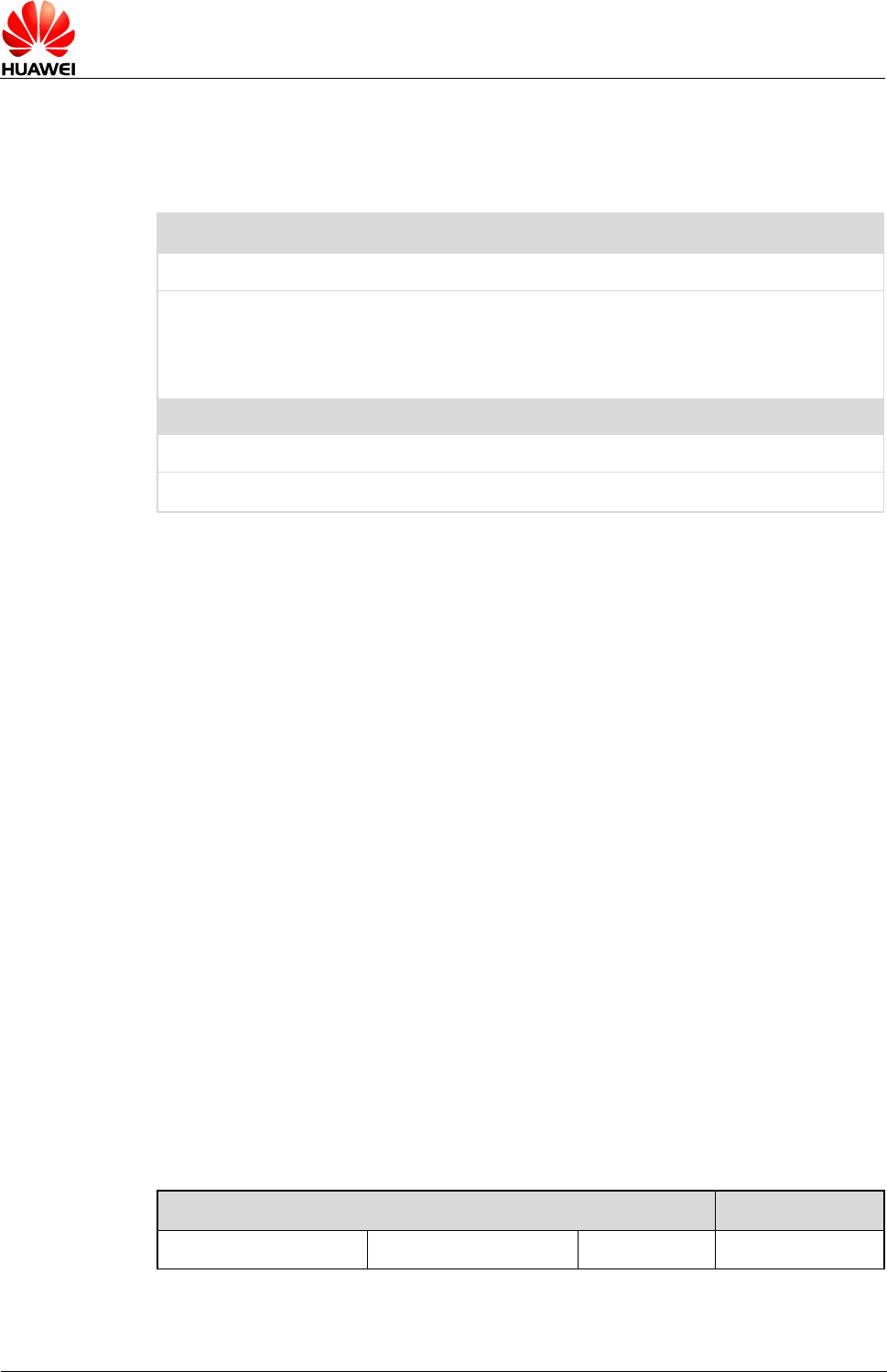
HUAWEI MU736 HSPA+ M.2 Module
AT Command Interface Specification
PDU Mode Commands for SMS
Issue 02 (2013-12-24)
HUAWEI Proprietary and Confidential
Copyright © HUAWEI Technologies Co., Ltd.
90
8.9 AT+CMGS–Send Short Message
8.9.1 Command Syntax
AT+CMGS=<length><CR>PDU is given<ctrl-Z/ESC>
Possible Response(s)
<CR><LF>+CMGS: <mr>[,<ackpdu>]<CR><LF><CR><LF>OK<CR><LF>
In case of an MS-related error:
<CR><LF>+CMS ERROR: <err><CR><LF>
AT+CMGS=?
Possible Response(s)
<CR><LF>OK<CR><LF>
8.9.2 Interface Description
The set command sends a message to the network in the following procedure:
First, the TE sends +CMGS=<length><CR> to the MT.
After the MT responds to the TE with <CR><LF><greater_than><space>(IRA 13,
10, 62, 32), the TE sends the PDU packets ending with <ctrl-Z>(IRA26).
The test command returns "OK".
8.9.3 Parameter Description
<length>: the number of actually sent TPDU characters/2. It is a decimal value not
greater than 178.
<mr>: message ID; a decimal number ranging from 0 to 255.
<ackpdu>: when <value> of +CSMS is 1 and supported by the network, this field will
be returned. Except that there is no <SCA>, the format of <ackpdu> is the same as
that of the PDU. This field is not supported currently.
<ctrl-Z>: indicates the end of a PDU. The characters are "0x1A".
<ESC>: cancels the sending of the message. The characters are "0x1B".
The format of a PDU is as follows: (The characters allowed in a PDU are 0–9, A–F,
and a–f. Two characters forms one octet. For example, '23'=0x23, '2a'=0x2a, all are
hexadecimal.)
[<SCA>]
<sc_len>
<type_addr>
<numbers>
TPDU
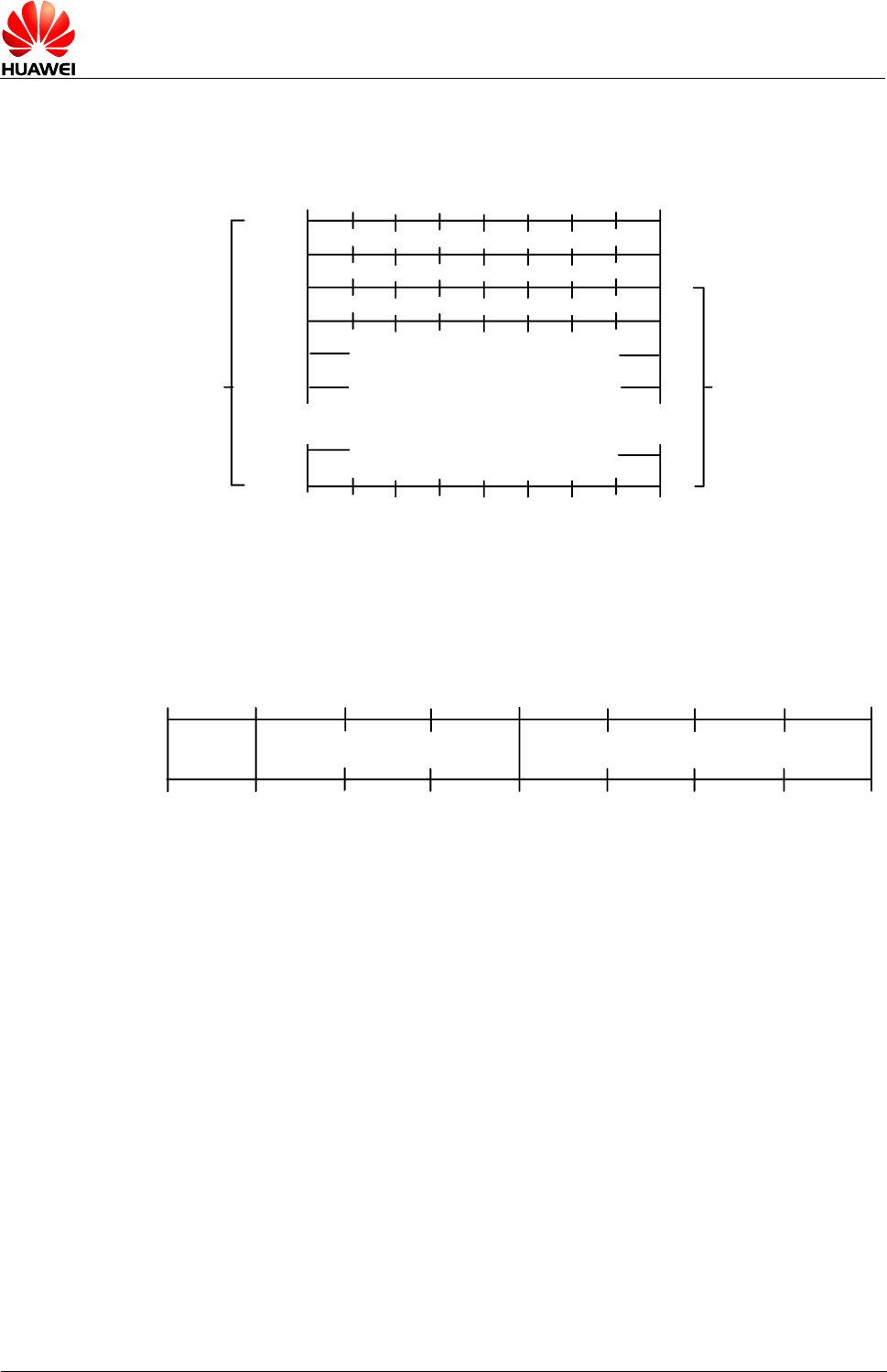
HUAWEI MU736 HSPA+ M.2 Module
AT Command Interface Specification
PDU Mode Commands for SMS
Issue 02 (2013-12-24)
HUAWEI Proprietary and Confidential
Copyright © HUAWEI Technologies Co., Ltd.
91
<SCA>: service center address (SCA). Its structure is illustrated in the following figure.
Address-Length
Type-of-Address
Address-Value
Addr.
.
.
................................
1
2
3
4
5
µ
.
.
<sc_len>: length of <SCA>. It is composed of two characters. It indicates the number
of characters occupied by <type_addr> and (<numbers>/2).
<type_addr>: number address type; consisting of two characters in the following
format:
Type-of-number Numbering-plan-identification
1
Values of Type-of-Number (bit 6–4) are defined as follows:
0 0 0
This value is written when the user does not know the destination
address type. In this case, the address type is determined by the
network.
0 0 1
This value is selected if the user knows that it is an international
number, or the user believes that it falls in the national range.
0 1 0
National number. No prefix or suffix is added. This value is selected
when the user sends a message to a national number.
0 1 1
A special number in this network. It is used for management or service.
The user cannot select this value.
1 0 1
GSM number using the default 7-bit encoding scheme.
1 1 0
Short number. It is not in use currently.
1 1 1
Reserved. It is not in use currently.
Values of Numbering–plan–identification (bits 3–0) are defined as follows:

HUAWEI MU736 HSPA+ M.2 Module
AT Command Interface Specification
PDU Mode Commands for SMS
Issue 02 (2013-12-24)
HUAWEI Proprietary and Confidential
Copyright © HUAWEI Technologies Co., Ltd.
92
0 0 0 0
The number is determined by the numbering plan at the network.
0 0 0 1
ISDN/telephone numbering plan.
0 0 1 1
Data numbering plan. It is not in use currently.
0 1 0 0
Telex numbering plan. It is not in use currently.
1 0 0 0
National numbering plan. It is not in use currently.
1 0 0 1
Private numbering plan. It is not in use currently.
1 0 1 0
ERMES numbering plan. It is not in use currently.
Note:
bits 3–0 are valid only when bits 6–4 are 000, 001, or 010.
<numbers>: address number. One byte stores two digits. Bits 3–0 store the first digit,
and bits 7–4 store the second digit. As an example, the following figure illustrates the
encoding sequence of half bytes.
Digit 2
Digit 1
Digit 4 Digit 3
Digit 5
n+1
n+2
n+3 1
1
1
1
Note:
If the number's length is an odd value, the four high-order bits of this octet is filled with 1111.
'*'
1010
'#'
1011
'a'
1100
'b'
1101
'c'
1110
For example:
- If <SCA> is 13902900, then <number> is 31099200.
- If the length of <SCA> is an odd value, for example, 139029001, then
<numbers> is 31099200F1.
- If the number type is 'A1', then <SCA> is 05a131099200.
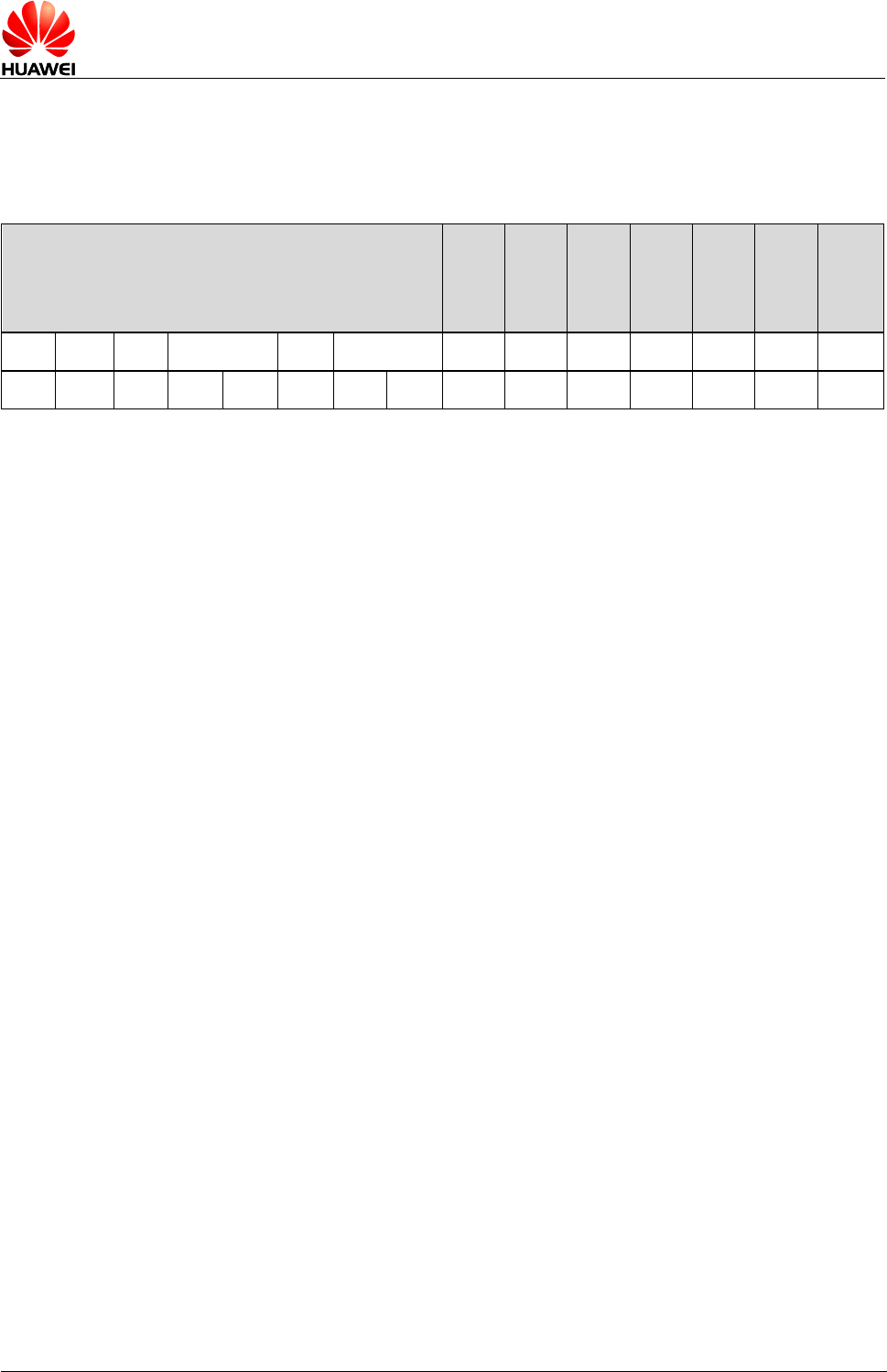
HUAWEI MU736 HSPA+ M.2 Module
AT Command Interface Specification
PDU Mode Commands for SMS
Issue 02 (2013-12-24)
HUAWEI Proprietary and Confidential
Copyright © HUAWEI Technologies Co., Ltd.
93
- If the number type indicates that it is an international number 'A1', but the number
13902900 is a national number in China, it is necessary to add 86 before the
number. In this case, <SCA> is 06a16831099200.
The TPDU format is described in the following table.
1 Octet
2
Oct~
12
Oct
1
Oct
1
Oct
1
Oct
1
Oct
2
Oct~
12
Oct
RP
DA
PID
DCS
VP
UDL
DA
PID
DCS
VP
UDL
UD
DA
Bit7
Bit6
Bit5
Bit4
Bit3
Bit2
Bit1
Bit0
<MTI>: message type. Its values(Bit 1-0) are defined as follows:
0 0
SMS-DELIVER (in the direction SC to MT)
0 0
SMS-DELIVER REPORT (in the direction MT to SC)
1 0
SMS-STATUS-REPORT (in the direction SC to MT)
1 0
SMS-COMMAND (in the direction MT to SC)
0 1
SMS-SUBMIT (in the direction MT to SC)
0 1
SMS-SUBMIT-REPORT (in the direction SC to MT)
1 1
Reserved
<RD>: indicates whether the SC needs to receive a message that is still stored in the
SC and has the MR and DA identical with those of the messages sent previously from
the same OA. Its values are defined as follows:
0
Yes
1
No
<VPF>: indicates the validity and format of the VP field. Its values(Bit 4-3) are defined
as follows:
0 0
The VP field is invalid.
1 0
The VP field is valid, and the format is "relative".
0 1
The VP field is valid, and the format is "enhanced".
1 1
The VP field is valid, and the format is "absolute".
<RP>: indicates whether the reply to a message uses the same settings as those for
the sent message. Its values are defined as follows:
0
No
1
Yes. The message reply uses the same SC number and path for
sending the message.

HUAWEI MU736 HSPA+ M.2 Module
AT Command Interface Specification
PDU Mode Commands for SMS
Issue 02 (2013-12-24)
HUAWEI Proprietary and Confidential
Copyright © HUAWEI Technologies Co., Ltd.
94
<UDHI>: user data header indication. Its values are defined as follows:
0
The user data segment contains message content only.
1
The user data segment contains message content and a data header.
<SRR>: status report request indication.
0
No status report is required when a message is sent successfully.
1
A status report is required when a message is sent successfully.
<MR>: message ID ranging from 0 to 255.
<DA>: destination address. Its definition is the same as <SCA>. There are a total of
2–12 octets. Therefore, the longest address in the <DA> field contains 20 digits.
<PID>: protocol identifier. Its values are defined as follows:
PID
Bit7
Bit6
Bit5
Bit4
Bit3
Bit2
Bit1
Bit0
The values of bit 7-6 are defined as follows:
0 0
Allocate bits 0–5 (at present, bit 7=0 and bit 6=0).
1 0
Allocate bits 0 –5.
0 1
Reserved
1 1
Allocate bits 0–5 for special purpose of the SC.
The values of bit 5 are defined as follows:
0
No interworking, but SME-to-SME protocol
1
Telematic interworking (in this case, the values of bit 4–0 are valid)
bit 4…bit 0: telematic devices type indication.
If bit4…bit 0 are 10010, it indicates Email. Other values are not supported currently.
<DCS>: user data coding scheme. Its values are defined as follows:
Bits 7…4
Bits 3…0
00xx
Bit 5
0: Message is not
compressed.
Bit 1 Bit 0: message type indication.
0 0 Class 0, displayed on the user interface but not stored.
A response is sent to the SC to acknowledge the
reception of the message.
0 1 Class 1, stored to NV (or SIM card if the NV is full)
1 0 Class 2. Messages are stored to the SIM card only.
After a class 2 message is stored, the storage state will
1: Message is
compressed. This is
not supported
currently.

HUAWEI MU736 HSPA+ M.2 Module
AT Command Interface Specification
PDU Mode Commands for SMS
Issue 02 (2013-12-24)
HUAWEI Proprietary and Confidential
Copyright © HUAWEI Technologies Co., Ltd.
95
Bits 7…4
Bits 3…0
Bit 4
0: Indicates that bit 1
and bit 0 are
reserved.
be sent to the SC. If the SIM card is full, a response is
sent to the SC to notify it of the occurrence and cause
of message storage failure.
1 1 Class3, stored to the TE. When the MT receives the
message, it sends a response to the SC before routing
the message to the TE.
Bit 3 Bit 2: message type indication.
0 0 GSM 7-bit encoding scheme (default value)
0 1 8-bit encoding scheme
1 0 UCS2 encoding scheme. TE uses this value when the
user inputs Chinese characters.
1 1 Reserved
1: Indicates that bit 1
and bit 0 serve as
the message type
indication.
0100
…
1011
Reserved
1100
The message content is
discarded. The message
waiting indication is
presented, and the user data
is encoded using the GSM
7-bit encoding scheme.
The settings of bits 3…0 are the same as those when bits
7…4=1101.
1101
The message is stored. The
message waiting indication is
presented, and the user data
is encoded using the GSM
7-bit encoding scheme.
Bit 3: enables or disables message waiting indication.
0 Disables message waiting indication
1 Enables message waiting indication
Bit 2: reserved, the value is 0.
Bit 1 Bit 0: message type indication.
0 0 Voice message waiting
0 1 Fax message waiting
1 0 Email message waiting
1 1 Message of unknown type waiting
1110
The message is stored. The
message waiting indication
appears, and the user data is
encoded using uncompressed
UCS2 encoding scheme.
The settings of bits 3…0 are the same as those when bits
7…4=1101.
1111
Data coding/message class
Bit 3: reserved, the value is 0.
Bit 2: message encoding scheme. Its values are defined as
follows:
0 GSM 7-bit encoding scheme (default value)
1 8-bit encoding scheme
Bit 1 Bit 0: message type indication.
0 0 Class 0, displayed on the user interface but not stored.
A response is sent to the SC to acknowledge the

HUAWEI MU736 HSPA+ M.2 Module
AT Command Interface Specification
PDU Mode Commands for SMS
Issue 02 (2013-12-24)
HUAWEI Proprietary and Confidential
Copyright © HUAWEI Technologies Co., Ltd.
96
Bits 7…4
Bits 3…0
reception of the message.
0 1 Class 1, stored to NV (or SIM card if the NV is full)
1 0 Class 2. Messages are stored to the SIM card only.
After a class 2 message is stored, the storage state will
be sent to the SC. If the SIM card is full, a response is
sent to the SC to notify it of the occurrence and cause
of message storage failure.
1 1 Class3, stored to the TE. When the MT receives the
message, it sends a response to the SC before routing
the message to the TE.
<VP>: indicates the validity period, which starts from the time when the message is
received by the SC. If <VPF>=00, this field is omitted. The following table lists the
validity periods.
VP Value
Validity Period
0 to 143
(VP + 1) x 5 minutes
144 to 167
12 hours + ((VP – 143) x 30 minutes)
168 to 196
(VP – 166) x 1 day
197 to 255
(VP – 192) x 1 week
<UDL>: user data length, depending on the specific encoding scheme.
Default 7-bit encoding scheme
<UDL> indicates the total number of septets.
8-bit encoding scheme
<UDL> indicates the total number of octets.
UCS2 encoding scheme
<UDL> indicates the total number of octets.
Compressed 7-bit, 8-bit or
UCS2 encoding scheme
<UDL> indicates the total number of octets after
compression.
For messages encoded using a compressed encoding scheme, the length of <UD>
should not be greater than 160 septets. For messages encoded using an
uncompressed encoding scheme, the length of <UD> should not be greater than 140
octets.
<UD>: user data. Its data validity depends on <UDL>.
8.9.4 Property Description
Saving upon Power-off
PIN
NA
Y

HUAWEI MU736 HSPA+ M.2 Module
AT Command Interface Specification
PDU Mode Commands for SMS
Issue 02 (2013-12-24)
HUAWEI Proprietary and Confidential
Copyright © HUAWEI Technologies Co., Ltd.
97
8.9.5 Example
Run:
AT+CMGS=18
Response:
>
Run:
0891683108608805F931000B813109731147F40000FF04F4F2
9C0E
Response:
+CMGS: 135
OK
8.10 AT+CNMA–New Message Acknowledgement
8.10.1 Command Syntax
AT+CNMA[=<n>[,<length>[<CR>PDU is given<ctrl-Z/ESC>]]]
Possible Response(s)
<CR><LF>OK<CR><LF>
In case of an MS-related error:
<CR><LF>+CMS ERROR: <err><CR><LF>
AT+CNMA=?
Possible Response(s)
<CR><LF>+CNMA: (list of supported <n>s)<CR><LF><CR><LF>OK<CR><LF>
8.10.2 Interface Description
The set command acknowledges the reception of a new message that is routed
directly to the TE. This acknowledgement command shall be used when +CSMS
parameter <service> equals 1. For the use of this command, see section 8.5
AT+CNMI–Indicate New Message to TE.
Note:
Set AT+CSMS=1 before AT+CNMI settings.
In PDU mode, either positive (RP-ACK) or negative (RP-ERROR) acknowledgement
can be sent to the network. The parameter <n> defines which acknowledgement to be
send.
Optionally an acknowledgement TPDU (SMS-DELIVER-REPORT for RP-ACK or
RP-ERROR) may be sent to the network. The entering of PDU is done similarly as
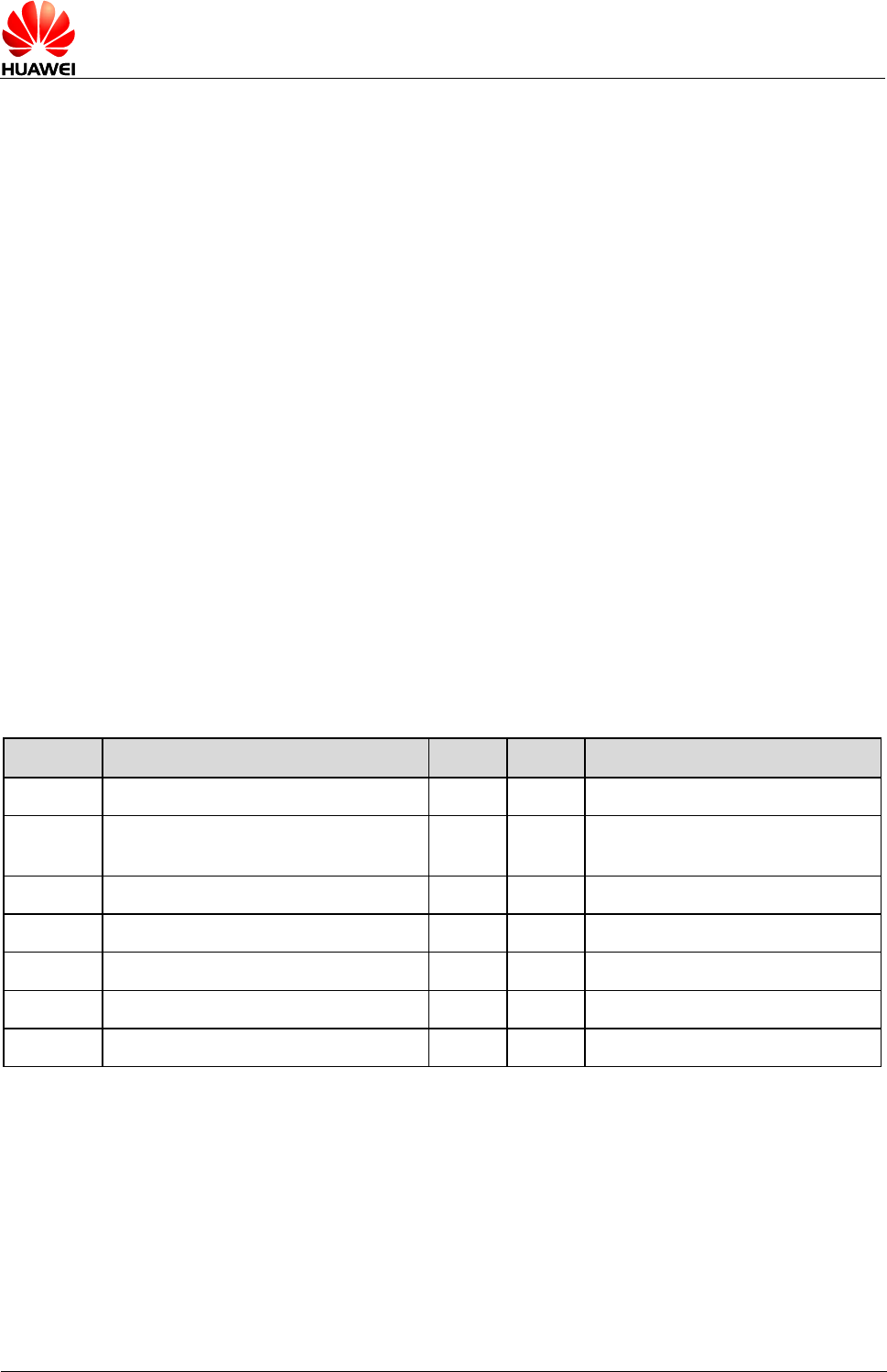
HUAWEI MU736 HSPA+ M.2 Module
AT Command Interface Specification
PDU Mode Commands for SMS
Issue 02 (2013-12-24)
HUAWEI Proprietary and Confidential
Copyright © HUAWEI Technologies Co., Ltd.
98
specified in command Send Message +CMGS, except that the format of <ackpdu> is
used instead of <pdu>. PDU shall not be bounded by double quotation marks.
Before the previous message is acknowledged, the MT will not send another +CMT or
+CDS result code to the TE.
If the MT does not receive acknowledgement within required time (network timeout),
the MT will send RP-ERROR to the network and automatically set both <mt> and
<ds> values of +CNMI to zero to prevent SMS-DELIVER indications and message
status reports from being sent to the TE. To enable the MT to send SMS-DELIVER
indications and message status reports to the TE, <mt> and <ds> must be reset.
If the command is executed when no acknowledgement is expected, +CMS ERROR:
<err> is returned.
The test command returns a list of supported <n> values. If the value supported is 0
only, sending of TPDU is not supported.
8.10.3 Parameter Description
<n>:
0
Command operates similarly as defined for the text mode.
1
Send RP-ACK (or buffered result code received correctly).
2
Send RP-ERROR.
<ackpdu>: basic elements
Abbr
Reference
P1)
P2)
Description
TP-MTI
TP-Message Type Indicator
M
2b
TP-message type
TP-UDHI
TP-User-Data-Header-Indication
O
b
Indicates that the TP-UD has one
header.
TP-PI
TP-Parameter-Indicator
M
o
Indicates the optional parameters.
TP-PID
TP-Protocol-Identifier
O
o
Protocol ID
TP-DCS
TP-Data-Coding-Scheme
O
o
Data coding scheme
TP-UDL
TP-User-Data-Length
O
o
User data length
TP-UD
TP-User-Data
O
3)
User data
Notes:
- Mandatory (M) or Optional (O).
- Integer (I), Bit (b), 2 bits (2b), octet (o).
- Depending on TP-DCS.
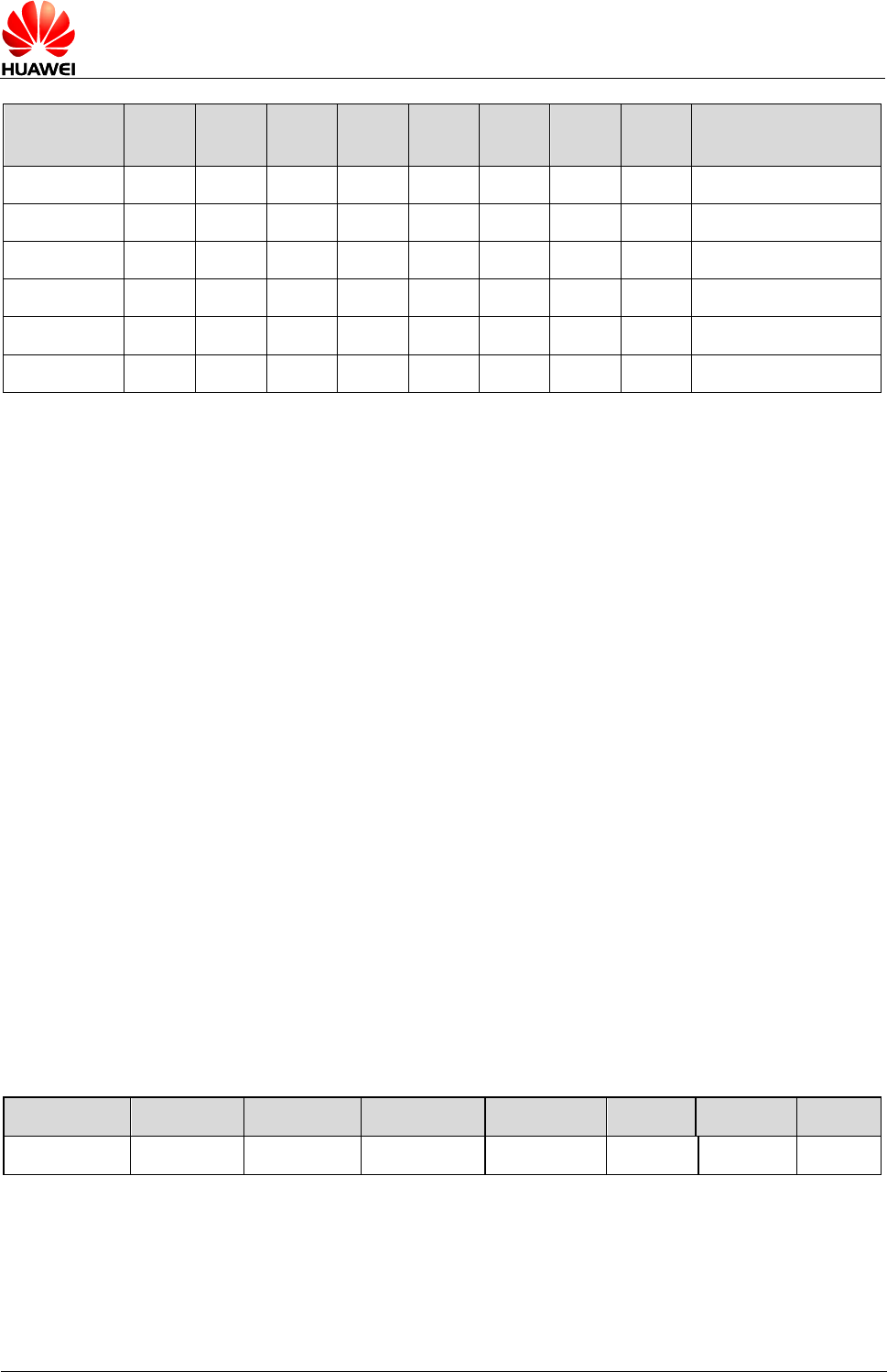
HUAWEI MU736 HSPA+ M.2 Module
AT Command Interface Specification
PDU Mode Commands for SMS
Issue 02 (2013-12-24)
HUAWEI Proprietary and Confidential
Copyright © HUAWEI Technologies Co., Ltd.
99
Number of
Octets
7
6
5
4
3
2
1
0
1
TP-MTI, TP-UDHI
1
TP-PI
0, 1
TP-PID
0, 1
TP-DCS
0, 1
TP-UDL
0 to 159
TP-UD
Bits 7 and 2–5 of the first byte are not used in SMS-DELIVER-REPORT. The sender
should set them to zero. If any of those bits is not zero, it will be omitted by the
recipient.
Description of the basic elements:
<TP-MTI>: TP-Message type; bit 0 and bit 1 of the first byte.
bit1 bit0
Message type
0 0
SMS-DELIVER (in the direction SC to MT)
0 0
SMS-DELIVER-REPORT (in the direction MT to SC)
1 0
SMS-STATUS-REPORT (in the direction SC to MT)
1 0
SMS-COMMAND (in the direction MT to SC)
0 1
SMS-SUBMIT (in the direction MT to SC)
0 1
SMS-SUBMIT-REPORT (in the direction SC to MT)
1 1
Reserved
<TP-UDHI>: indicates that the TP-UD has one header; bit 6 of the first byte.
0
The TP-UD field contains SMS message only.
1
There is a header at the beginning of the TP-UD field.
<TP–PI>: indicates the optional parameters. Setting the bit to 1 indicates that the
corresponding parameter exits.
bit 7
bit 6
bit 5
bit 4
bit 3
bit 2
bit 1
bit 0
Extension bit
Reserved
Reserved
Reserved
Reserved
TP-UDL
TP-DCS
TP-PID
<TP-PID>: protocol ID. When sending a message, the TE sets <TP-PID> to the
default value 00000000. When sending an email, the TE sets <TP-PID> to
00110010=0x32.

HUAWEI MU736 HSPA+ M.2 Module
AT Command Interface Specification
PDU Mode Commands for SMS
Issue 02 (2013-12-24)
HUAWEI Proprietary and Confidential
Copyright © HUAWEI Technologies Co., Ltd.
100
<TP-DCS>: the TE adopts the TP-DSC mode to send a message.
Bit 7–bit
6 (TE
uses
this
TP-DC
S
mode)
00: used by TE
when sending a
message.
Bit 5
0
TE sets bit 5 to zero, indicating the message is not
compressed.
1
If bit 5 is set to 1, the message is compressed. TE
does not use this value.
Bit 4
0
When TE sets bit 4 to 0, bit 1 and bit 0 are reserved
and set to 00.
1
When bit 4 is set to 1, bit 1 and bit 0 indicate the
message type.
A message's type is dependent on user settings. If the
user specifies a message type (for example, class 1 or
class 2), TE sets bit 4 to 1.
Bit 3–2:
message
encoding
scheme
00
GSM 7-bit encoding scheme; default value.
01
8-bit encoding scheme
10
UCS2 encoding scheme. TE uses this value when the
user inputs Chinese characters.
Bit 1–0:
message
type; set
by TE
according
to users'
selection
00
Class 0. Messages are displayed on the user interface
but not stored. A response is sent to the SC to
acknowledge the reception of the message.
01
Class 1. Messages are stored to the MT, or to the SIM
card when the message storage on the MT is used up.
10
Class 2. Messages are stored to the SIM card only.
After a class 2 message is stored, the storage state
will be sent to the SC. If the SIM card is full, a
response is sent to the SC to notify it of the
occurrence and cause of message storage failure.
11
Class 3. Messages are stored to the TE. When the MT
receives the message, it sends a response to the SC
before routing the message to the TE.
Bit 7–bit
4 (TE
does
not use
this
TP-DC
S
mode)
1100 and 1101:
GSM 7 bit
encoding
1110:
uncompressed
UCS-2
encoding
scheme)
Bit 3
0
Disable the message waiting indication feature.
At present, the message waiting indication feature is
not supported for enhanced messages, email
messages and voicemail messages.
1
Enable the message waiting indication feature.
Bit 2
0
Reserved
Bit 1–0:
message
waiting
type
00
Voice message waiting
01
Fax message waiting
10
Email message waiting
11
Message of unknown type waiting
1111: not used
Bit 3
0
Reserved
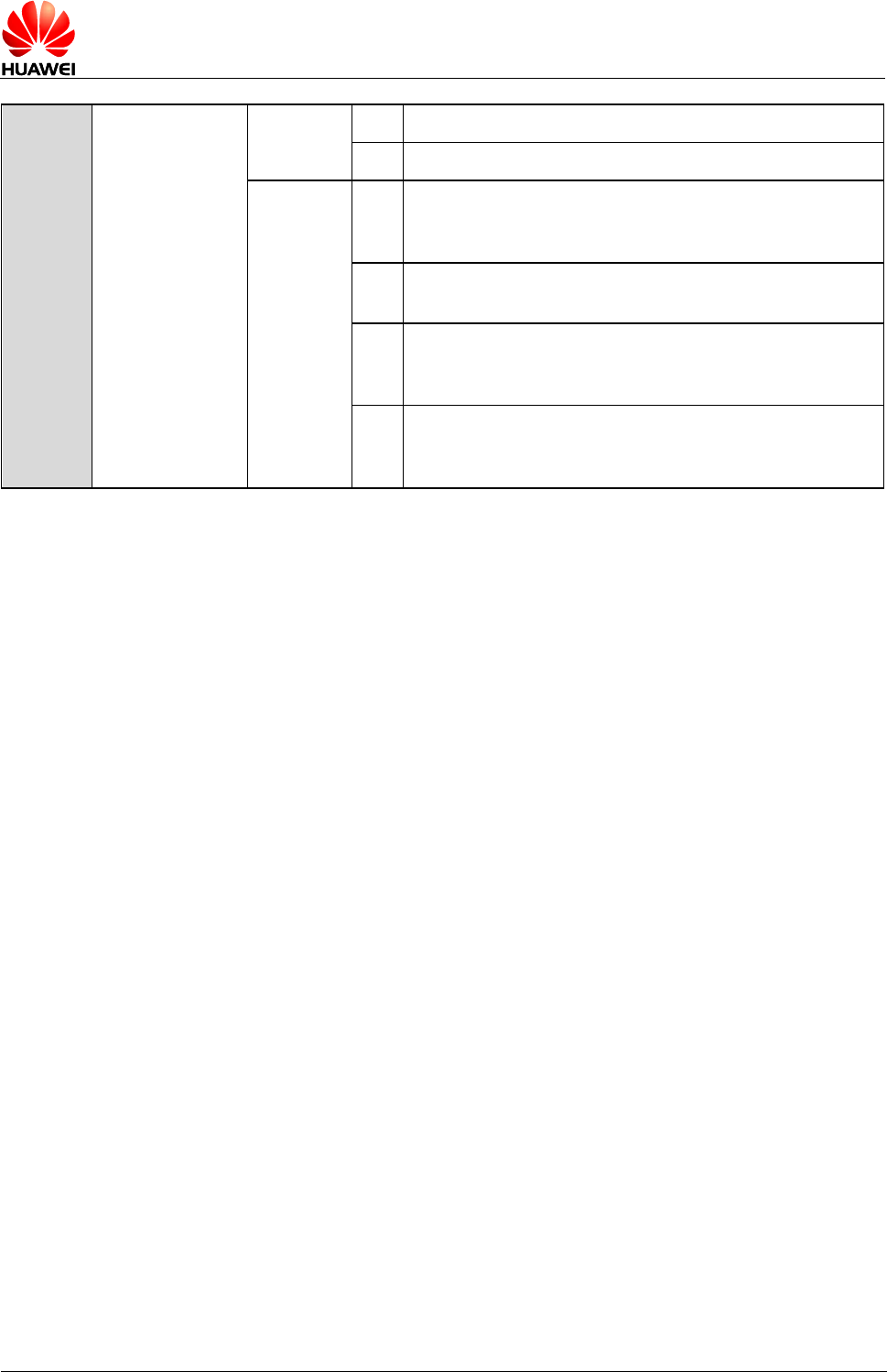
HUAWEI MU736 HSPA+ M.2 Module
AT Command Interface Specification
PDU Mode Commands for SMS
Issue 02 (2013-12-24)
HUAWEI Proprietary and Confidential
Copyright © HUAWEI Technologies Co., Ltd.
101
by TE
Bit 2
0
7-bit encoding
1
8-bit encoding scheme
Bit 1–0
00
Class 0. Messages are displayed on the user interface
but not stored. A response is sent to the SC to
acknowledge the reception of the message.
01
Class 1. Messages are stored to the MT (NV memory)
or the SIM card.
10
Class 2. Messages are stored to the SIM card only.
After a class 2 message is stored, the storage state
will be sent to the SC.
11
Class 3. Messages are stored to the TE. When the MT
receives the message, it sends a response to the SC
before routing the message to the TE.
<TP-UDL>: the number of bytes that the user data field occupies. If <TP-UDL> is 0,
the user data field does not exist.
<TP-UD>: the user data field may contain a user data header. If the header is
contained (that is, the value of bit 6 in byte 0 is 1), the value of TP-UDL equals to the
length of the User-Data-Header plus the length of the User-Data. The value of
<TP-UDL> depends on the encoding scheme:
- If the default encoding scheme (7-bit encoding) is used, <TP-UDL> indicates the
number of septets contained in the user data.
- If the 8-bit encoding scheme is used, <TP-UDL> indicates the number of octets
contained in the user data.
- If the UCS2 encoding scheme is used, <TP-UDL> also indicates the number of
octets contained in the user data.
- If 7-bit, 8-bit or UCS2 compression encoding is used, <TP-UDL> indicates the
number of octets contained in the compressed user data.
Figure 8-1 and Figure 8-2 illustrate the formats of the user data encoded using
different schemes.
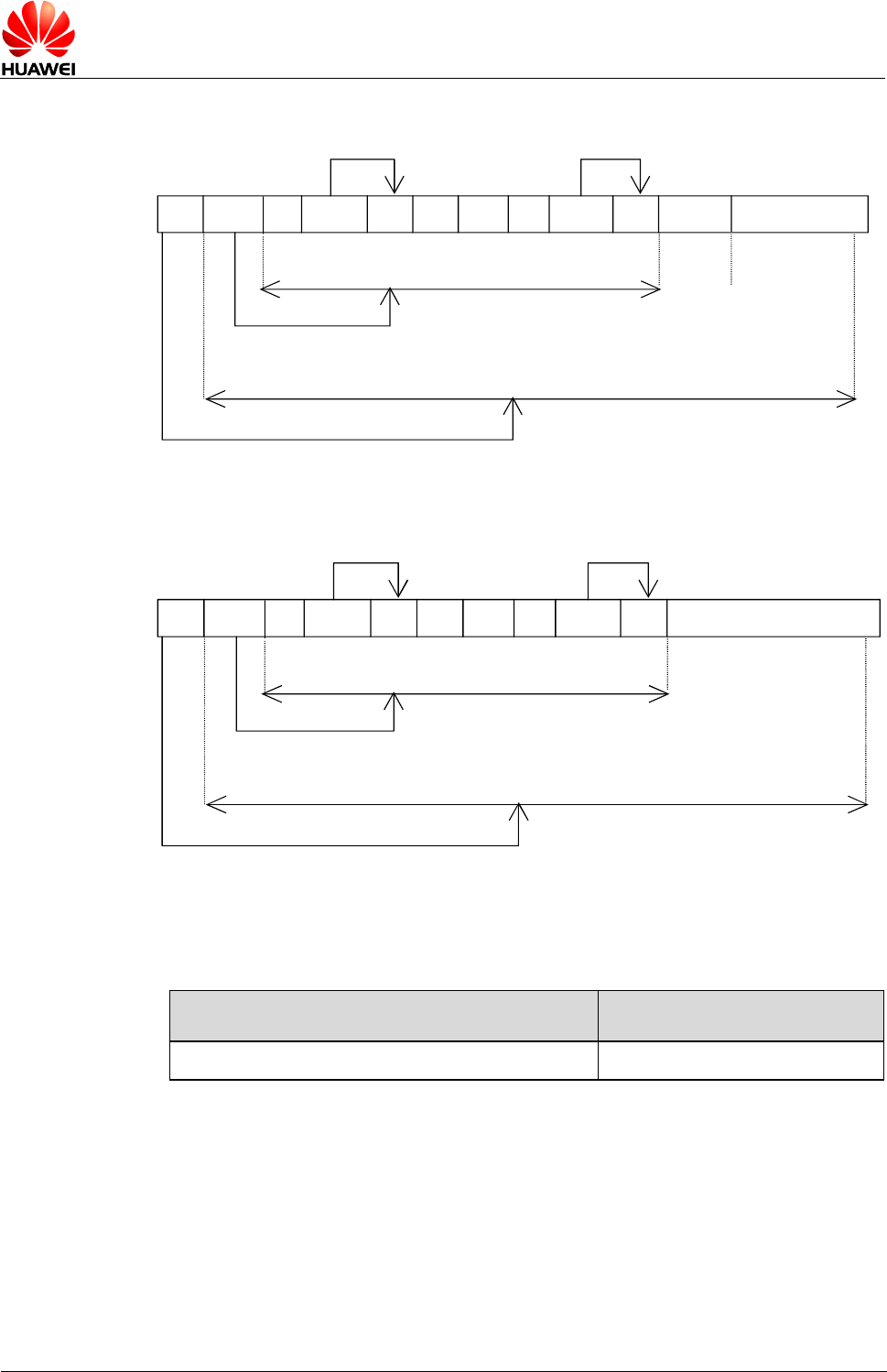
HUAWEI MU736 HSPA+ M.2 Module
AT Command Interface Specification
PDU Mode Commands for SMS
Issue 02 (2013-12-24)
HUAWEI Proprietary and Confidential
Copyright © HUAWEI Technologies Co., Ltd.
102
Figure 8-1 User data encoded using the default 7-bit encoding scheme
UDL UDHL IEIa IEDa IEIb ......... IEIn IEDLn IEDn Fill bits SM (7bit data)
Septet Boundary
Total number of Octets
Length Indicator
Total number of Septets
Length Indicator
Octets
Octets
IEIDLa
Figure 8-2 User data encoded using the 8-bit or UCS2 encoding scheme
UDL UDHL IEIa IEDa IEIb ......... IEIn IEDLn IEDn
Octet Boundary
Total number of Octets
Length Indicator
Total number of Octets
Length Indicator
Octets
Octets
IEIDLa SM (8 bit data
or UCS-2 data)
In Figure 8-1 and Figure 8-2 , IEI is short for Information Element Identifier.
8.10.4 Property Description
Saving upon Power-off
PIN
NA
N
8.10.5 Example
- Step 1
Run:
AT+CSMS=1

HUAWEI MU736 HSPA+ M.2 Module
AT Command Interface Specification
PDU Mode Commands for SMS
Issue 02 (2013-12-24)
HUAWEI Proprietary and Confidential
Copyright © HUAWEI Technologies Co., Ltd.
103
Response:
+CSMS: 1,1,1
OK
- Step 2
Run:
AT+CNMI=2,2,0,1
Response:
OK
- Step 3
Run:
AT+CMGS=18
Response:
>
Run:
0891683108608805F931000B813109731147F40000FF04F4F2
9C0E
Response:
+CMGS: 135
OK
- Step 4
Response:
+CMT: ,24
0891683108608805F9240D91683109731147F4000031305012
43600004F4F29C0E
Run:
AT+CNMA
Response:
OK
8.11 +CMTI–Unsolicitedly Present of Message Arrival
Indication
8.11.1 Command Syntax
URC
<CR><LF>+CMTI: <mem>,<index><CR><LF>
8.11.2 Interface Description
This command allows indications that a new message is received.
8.11.3 Parameter Description
<mem>:
"SM"
(U)SIM message storage

HUAWEI MU736 HSPA+ M.2 Module
AT Command Interface Specification
PDU Mode Commands for SMS
Issue 02 (2013-12-24)
HUAWEI Proprietary and Confidential
Copyright © HUAWEI Technologies Co., Ltd.
104
<index>: integer type value indicating the memory location.
8.11.4 Property Description
Saving upon Power-off
PIN
NA
NA
8.11.5 Example
Response:
+CMTI: "SM",1
8.12 +CMT–Unsolicitedly Present of New Message
Reported Directly
8.12.1 Command Syntax
URC
<CR><LF>+CMT: [<reserved>],<length><CR><LF><pdu><CR><LF>
8.12.2 Interface Description
This command allows the indication of new messages to the TE without storing them.
8.12.3 Parameter Description
<reserved>: reserved.
<length>: integer type value indicating the number of bytes of PDU data.
<pdu>: protocol data unit, whose format is the same as that defined in section 8.7
AT+CMGL–List Messages.
8.12.4 Property Description
Saving upon Power-off
PIN
NA
NA
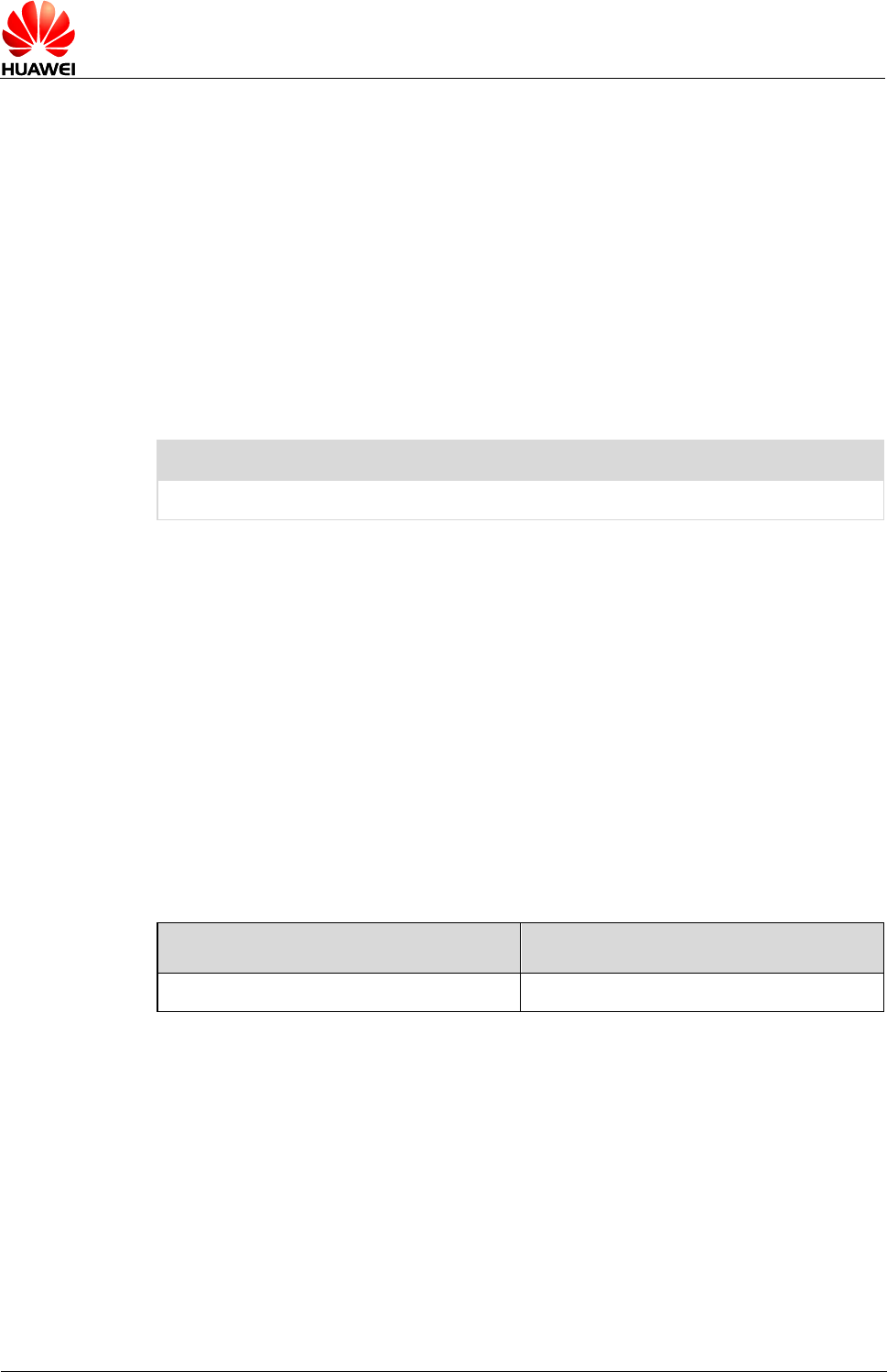
HUAWEI MU736 HSPA+ M.2 Module
AT Command Interface Specification
PDU Mode Commands for SMS
Issue 02 (2013-12-24)
HUAWEI Proprietary and Confidential
Copyright © HUAWEI Technologies Co., Ltd.
105
8.12.5 Example
Response:
+CMT: ,24
0891683108608805F9240D91683109731147F4000031305051
52430004F4F29C0E
8.13 +CDSI–Unsolicitedly Present of Newly Received
Message Status Report
8.13.1 Command Syntax
URC
<CR><LF>+CDSI: <mem>,<index><CR><LF>
8.13.2 Interface Description
This command allows indication that a new message status report is received and
reservation of the memory location.
8.13.3 Parameter Description
<mem>:
"SM"
(U)SIM message storage
<index>: integer type value indicating the memory location.
8.13.4 Property Description
Saving upon Power-off
PIN
NA
NA
8.13.5 Example
Response:
+CDSI: "SM",48

HUAWEI MU736 HSPA+ M.2 Module
AT Command Interface Specification
PDU Mode Commands for SMS
Issue 02 (2013-12-24)
HUAWEI Proprietary and Confidential
Copyright © HUAWEI Technologies Co., Ltd.
106
8.14 +CDS–Unsolicitedly Present of New Message Status
Report Reported Directly
8.14.1 Command Syntax
URC
<CR><LF>+CDS: <length><CR><LF><pdu><CR><LF>
8.14.2 Interface Description
This command allows the direct indication of new messages received to the TE
without storing the new message status report.
8.14.3 Parameter Description
<length>: integer type value indicating the number of bytes of PDU data.
<pdu>: protocol data unit.
8.14.4 Property Description
Saving upon Power-off
PIN
NA
NA
8.14.5 Example
Response:
+CDS: 26
0891683108608805F906750D91683109731147F43130509134
92003130509134430000
8.15 +CBMI–Unsolicitedly Present of Newly Received Cell
Broadcast Message
8.15.1 Command Syntax
URC
<CR><LF>+CBMI: <mem>,<index><CR><LF>

HUAWEI MU736 HSPA+ M.2 Module
AT Command Interface Specification
PDU Mode Commands for SMS
Issue 02 (2013-12-24)
HUAWEI Proprietary and Confidential
Copyright © HUAWEI Technologies Co., Ltd.
107
8.15.2 Interface Description
This command allows indication that a new cell broadcast message is received and
reservation of the memory location.
8.15.3 Parameter Description
<mem>:
"BM"
Broadcast message storage
<index>: integer type value indicating the memory location.
8.15.4 Property Description
Saving upon Power-off
PIN
NA
NA
8.15.5 Example
Response:
+CBMI: "BM",1
8.16 +CBM–Unsolicitedly Present of New Cell Broadcast
Message Directly
8.16.1 Command Syntax
URC
<CR><LF>+CBM: <length><CR><LF><pdu><CR><LF>
8.16.2 Interface Description
This command presents cell messages to the TE upon reception without saving.
8.16.3 Parameter Description
<length>: integer type; length of PDU data.
<pdu>: protocol data unit of format specified in 3GPP TS 23.041.

HUAWEI MU736 HSPA+ M.2 Module
AT Command Interface Specification
PDU Mode Commands for SMS
Issue 02 (2013-12-24)
HUAWEI Proprietary and Confidential
Copyright © HUAWEI Technologies Co., Ltd.
108
8.16.4 Property Description
Saving upon Power-off
PIN
NA
NA
8.16.5 Example
Response:
+CBM: 88
0000003201116432B9D168341A8D46A3D168341A8D46A3D168
341A8D46A3D168341A8D46A3D168341A8D46A3D168341A8D46
A3D168341A8D46A3D168341A8D46A3D168341A8D46A3D16834
1A8D46A3D168341A8D46A3D100
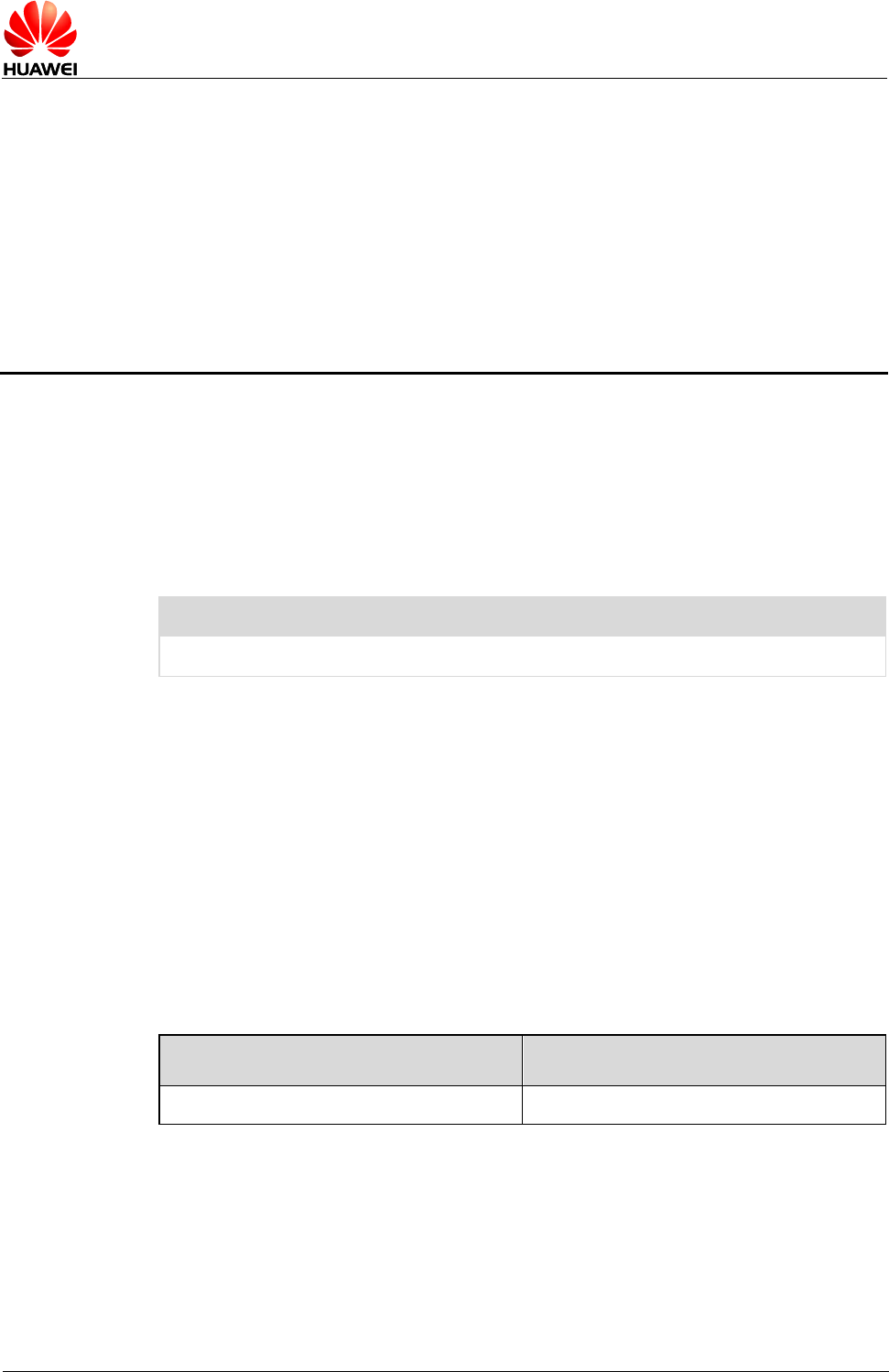
HUAWEI MU736 HSPA+ M.2 Module
AT Command Interface Specification
Commands for Standard STK Interface
Issue 02 (2013-12-24)
HUAWEI Proprietary and Confidential
Copyright © HUAWEI Technologies Co., Ltd.
109
9 Commands for Standard STK Interface
9.1 +CUSATP–Unsolicitedly Present of a UICC Proactive
Command
9.1.1 Command Syntax
URC
<CR><LF>+CUSATP: <proactive_command><CR><LF>
9.1.2 Interface Description
The MT uses the unsolicited result code +CUSATP: <proactive_command> to
notify TE that SIM card presents a proactive command.
9.1.3 Parameter Description
<proactive_command>: UICC proactive command, string type in hexadecimal
character format, consisting of the full BER-TLV data object as defined in 3GPP TS
31.111, ETSI TS 102.221 and ETSI TS 102.223 protocols.
9.1.4 Property Description
Saving upon Power-off
PIN
NA
NA
9.1.5 Example
Response:
+CUSATP: "D01A81030123008202818
28D0B043C54494D452D4F55543E91020
00A"
Unsolicitedly report a
proactive command
"GET INPUT".

HUAWEI MU736 HSPA+ M.2 Module
AT Command Interface Specification
Commands for Standard STK Interface
Issue 02 (2013-12-24)
HUAWEI Proprietary and Confidential
Copyright © HUAWEI Technologies Co., Ltd.
110
9.2 AT+CUSATE–Send USAT Envelope
9.2.1 Command Syntax
AT+CUSATE=<envelope_command>
Possible Response(s)
<CR><LF>+CUSATE:
<envelope_response>[,<busy>]<CR><LF><CR><LF>OK<CR><LF>
In case of an MT-related error:
<CR><LF>+CME ERROR: <err><CR><LF>
AT+CUSATE=?
Possible Response(s)
<CR><LF>OK<CR><LF>
9.2.2 Interface Description
The set command sends a USAT envelope command to UICC.
The test command returns "OK".
9.2.3 Parameter Description
<envelope_command>: an envelope command, string type in hexadecimal
character format, consisting of the full BER-TLV data object as defined in 3GPP TS
31.111, ETSI TS 102.221 and ETSI TS 102.223 protocols.
<envelope_response>: the response to an envelope command, string type in
hexadecimal character format, consisting of the full BER-TLV data object as defined in
3GPP TS 31.111, ETSI TS 102.221 and ETSI TS 102.223 protocols. Empty if the
UICC does not provide response data.
<busy>: integer type.
0
Indicate normal ending of the envelope command.
1
UICC responded with USAT is busy, retry to send the envelope
command by the MT.
2
UICC responded with USAT is busy even after one or more retries by the
MT.
9.2.4 Property Description
Saving upon Power-off
PIN
NA
Y
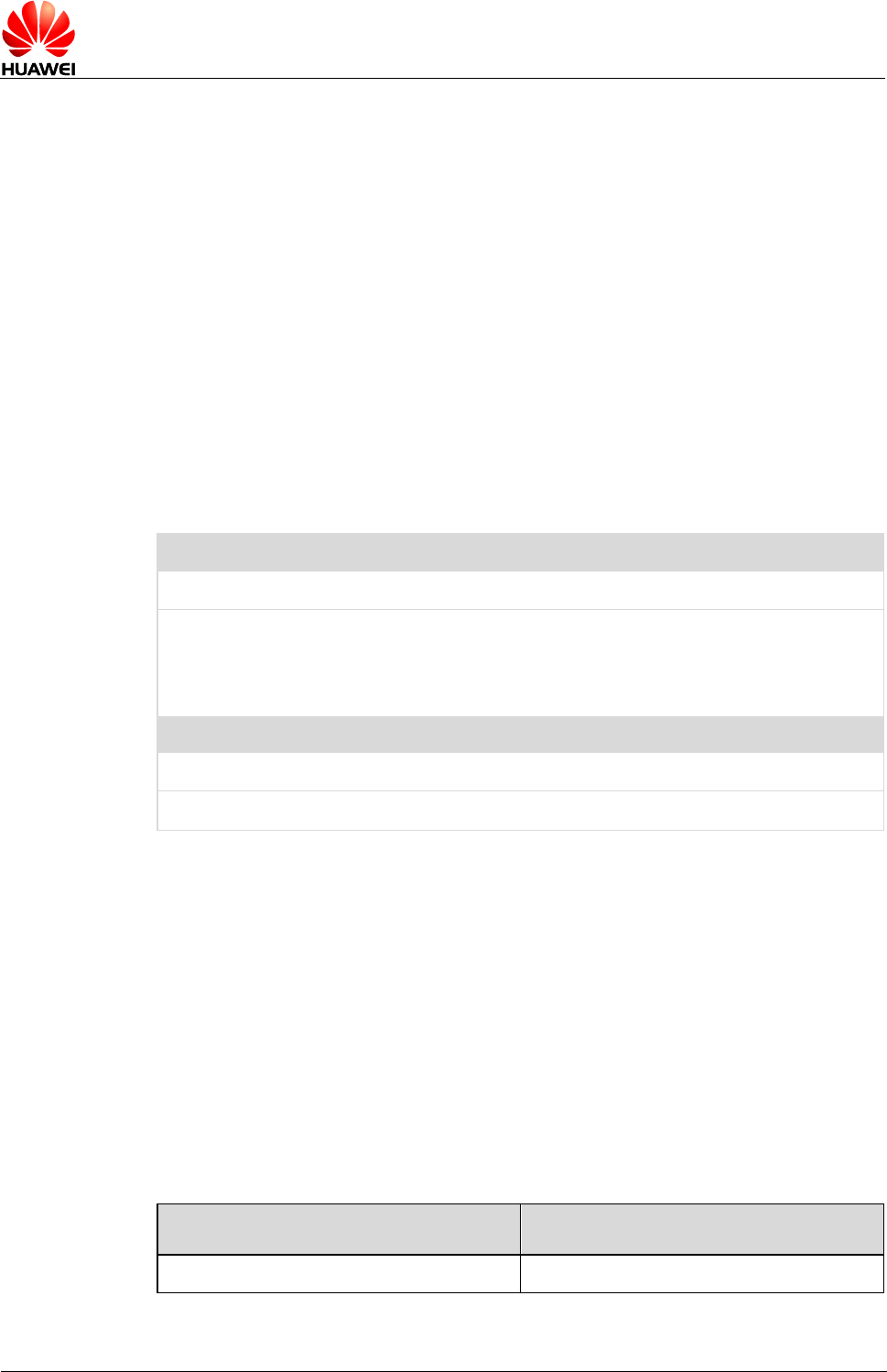
HUAWEI MU736 HSPA+ M.2 Module
AT Command Interface Specification
Commands for Standard STK Interface
Issue 02 (2013-12-24)
HUAWEI Proprietary and Confidential
Copyright © HUAWEI Technologies Co., Ltd.
111
9.2.5 Example
Sent envelope command "MENU SELECTION" (MENU has been got by running the
proactive command "SET UP MENU"); <busy> indicated '0' and envelope command
perform successfully.
Run:
AT+CUSATE="D30782020181900102"
Response:
+CUSATE: "",0
OK
9.3 AT+CUSATT–Send USAT Terminal Response
9.3.1 Command Syntax
AT+CUSATT=<terminal_response>
Possible Response(s)
<CR><LF>OK<CR><LF>
In case of an MT-related error:
<CR><LF>+CME ERROR: <err><CR><LF>
AT+CUSATT=?
Possible Response(s)
<CR><LF>OK<CR><LF>
9.3.2 Interface Description
The set command sends a USAT terminal response to UICC.
The test command returns "OK".
9.3.3 Parameter Description
<terminal_response>: terminal response to a proactive command, string type in
hexadecimal character format, consisting of the full BER-TLV data object as defined in
3GPP TS 31.111, ETSI TS 102.221 and ETSI TS 102.223 protocols.
9.3.4 Property Description
Saving upon Power-off
PIN
NA
Y
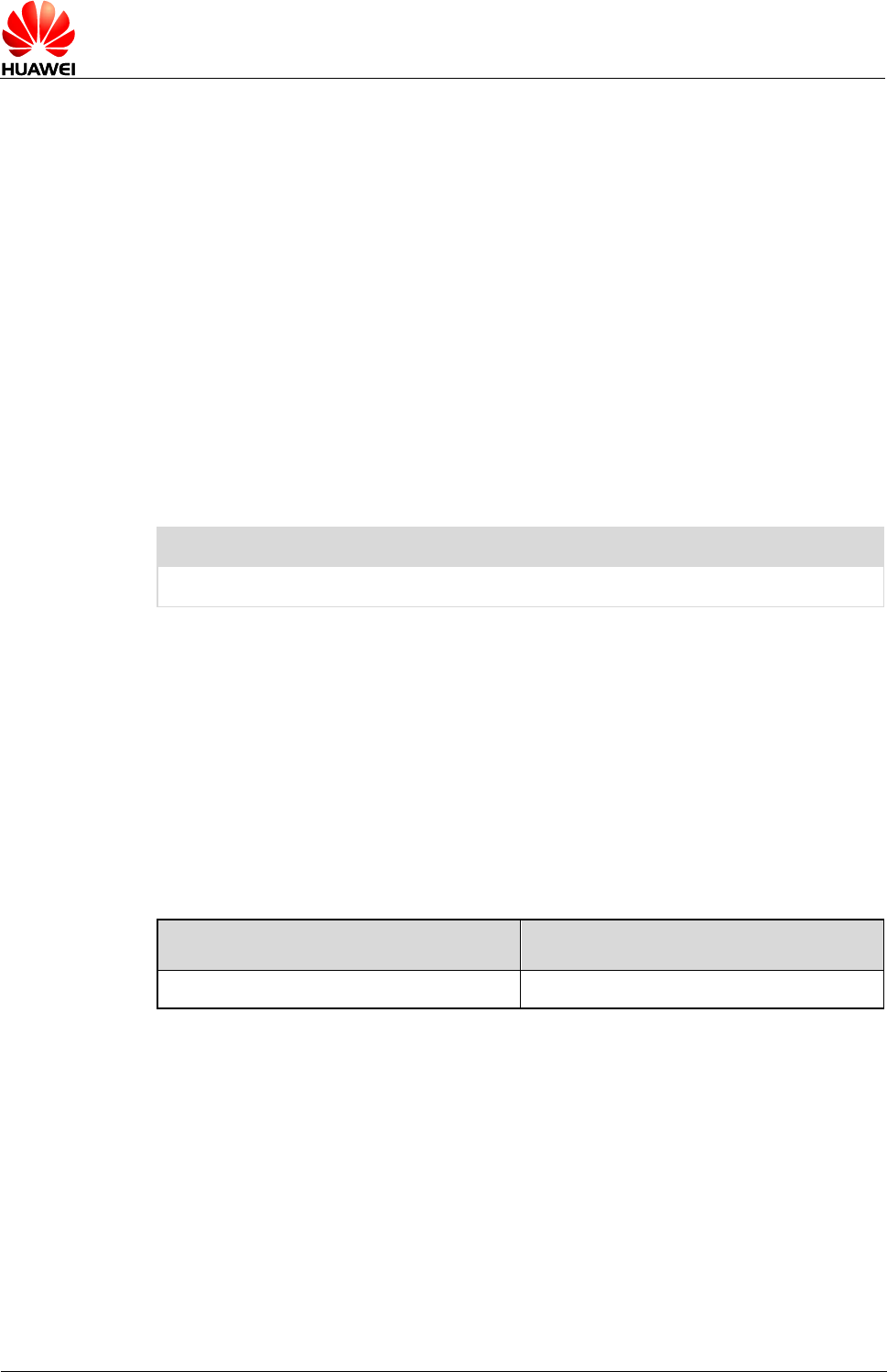
HUAWEI MU736 HSPA+ M.2 Module
AT Command Interface Specification
Commands for Standard STK Interface
Issue 02 (2013-12-24)
HUAWEI Proprietary and Confidential
Copyright © HUAWEI Technologies Co., Ltd.
112
9.3.5 Example
Sent the UICC proactive command "DISPLAY TEXT", and terminal response
"Command Perform Successfully" is responded.
Response:
+CUSATP: "D0158103012100820281028D0404434154"
Run:
AT+CUSATT="810301218082028281830100"
Response:
OK
9.4 +CUSATEND–Unsolicitedly Present of Terminating a
UICC Proactive Command Session
9.4.1 Command Syntax
URC
<CR><LF>+CUSATEND<CR><LF>
9.4.2 Interface Description
The MT uses the unsolicited result code +CUSATEND to notify TE that the proactive
command session is terminated.
9.4.3 Parameter Description
None
9.4.4 Property Description
Saving upon Power-off
PIN
NA
NA
9.4.5 Example
Response:
+CUSATP: "D04B810301250082028182050D53494D2053657
27669636573FF8F0D8750686F6E65206E756D6265728F0B85
53656C662053657276658F10805370656369616C204E756D6
26572731803212421"
Run:
AT+CUSATT="810301258082028281830100"

HUAWEI MU736 HSPA+ M.2 Module
AT Command Interface Specification
Commands for Standard STK Interface
Issue 02 (2013-12-24)
HUAWEI Proprietary and Confidential
Copyright © HUAWEI Technologies Co., Ltd.
113
Response:
OK
+CUSATEND

HUAWEI MU736 HSPA+ M.2 Module
AT Command Interface Specification
Huawei Proprietary Interface: Mobile
Termination Control and Status Interface
Issue 02 (2013-12-24)
HUAWEI Proprietary and Confidential
Copyright © HUAWEI Technologies Co., Ltd.
114
10 Huawei Proprietary Interface: Mobile
Termination Control and Status Interface
10.1 AT^RFSWITCH–Set the Flight Mode
10.1.1 Command Syntax
AT^RFSWITCH=<SW state>
Possible Response(s)
<CR><LF>OK<CR><LF>
In case of an MT-related error:
<CR><LF>+CME ERROR: <err><CR><LF>
AT^RFSWITCH?
Possible Response(s)
<CR><LF>^RFSWITCH: <SW state>,<HW
state><CR><LF><CR><LF>OK<CR><LF>
In case of an MT-related error:
<CR><LF>+CME ERROR: <err><CR><LF>
AT^RFSWITCH=?
Possible Response(s)
<CR><LF>^RFSWITCH: (0-1),(0-1)<CR><LF><CR><LF>OK<CR><LF>
10.1.2 Interface Description
The set command sets the Flight Mode.
The read command queries the current status of flight mode.
The test command checks the parameter range supported by this command.
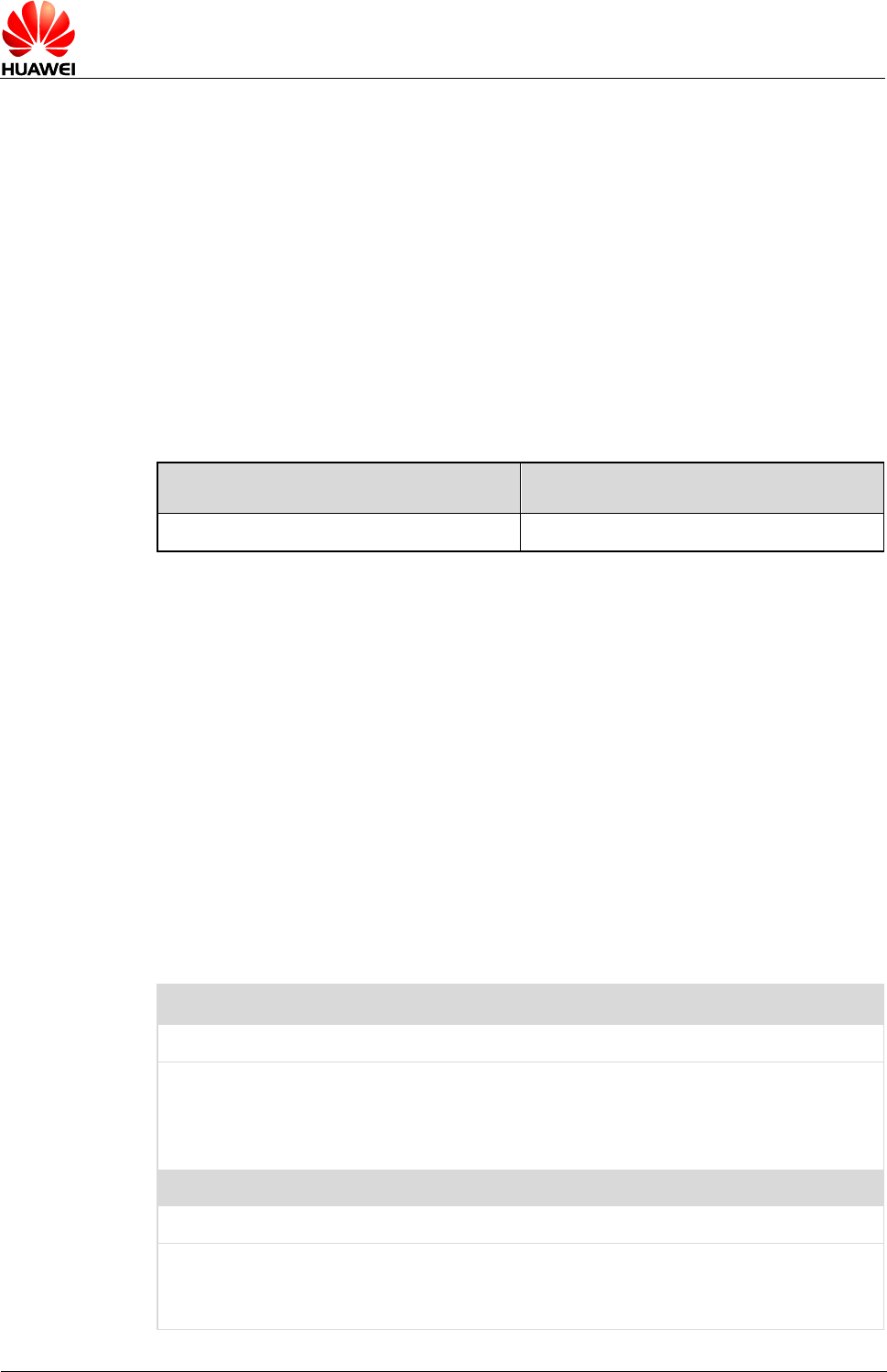
HUAWEI MU736 HSPA+ M.2 Module
AT Command Interface Specification
Huawei Proprietary Interface: Mobile
Termination Control and Status Interface
Issue 02 (2013-12-24)
HUAWEI Proprietary and Confidential
Copyright © HUAWEI Technologies Co., Ltd.
115
10.1.3 Parameter Description
<SW state>: state of RF software switch.
0
The state of RF software switch is set to off.
1
The state of RF software switch is set to on. (default value)
<HW state>: state of RF hardware switch.
0
The state of RF hardware switch is set to off.
1
The state of RF hardware switch is set to on. (default value)
10.1.4 Property Description
Saving upon Power-off
PIN
Y
N
10.1.5 Example
Run:
AT^RFSWITCH?
Query the current state of RF
switch
Response:
^RFSWITCH: 0,1
OK
Return information for the
current state of the hardware
switch is open, the software
switch is off
10.2 AT^CURC–Set Presentation of Unsolicited Results
10.2.1 Command Syntax
AT^CURC=<mode>[,<Sleep_UR_mask>,<working_UR_mask>]
Possible Response(s)
<CR><LF>OK<CR><LF>
In case of an MT-related error:
<CR><LF>+CME ERROR: <err><CR><LF>
AT^CURC?
Possible Response(s)
<CR><LF>^CURC:
<mode>[,<Sleep_UR_mask>,<working_UR_mask>]<CR><LF><CR><LF>OK<
CR><LF>
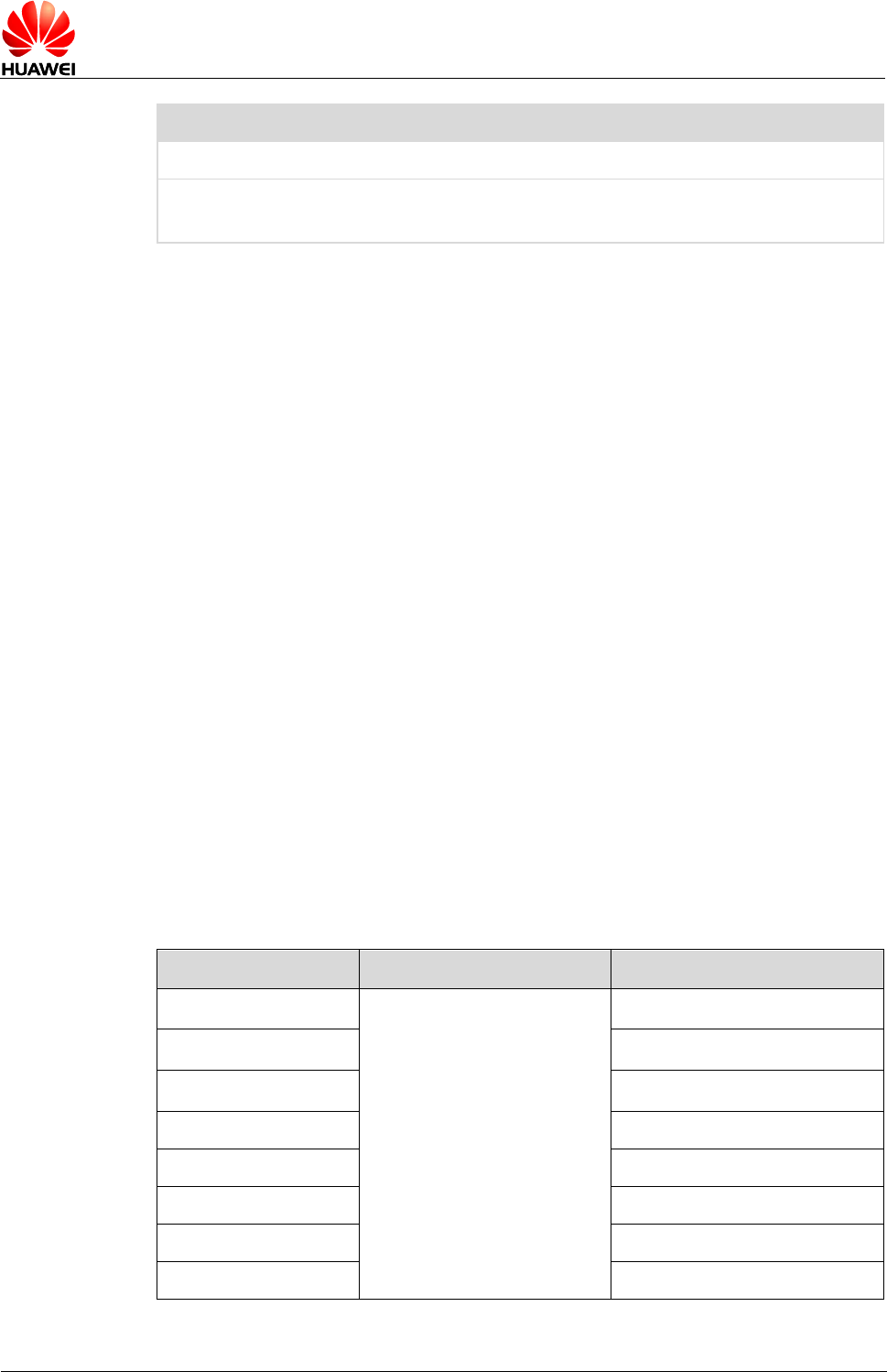
HUAWEI MU736 HSPA+ M.2 Module
AT Command Interface Specification
Huawei Proprietary Interface: Mobile
Termination Control and Status Interface
Issue 02 (2013-12-24)
HUAWEI Proprietary and Confidential
Copyright © HUAWEI Technologies Co., Ltd.
116
AT^CURC=?
Possible Response(s)
<CR><LF>^CURC: (list of supported
<mode>s)<CR><LF><CR><LF>OK<CR><LF>
10.2.2 Interface Description
The set command selects the control mode for the presentation of unsolicited results.
When <mode>=2, the specific types of unsolicited results can be specified.
The read command queries the current control mode for the presentation of
unsolicited results. When <mode>=2, the specific types of unsolicited results can be
queried.
The test command lists the supported control mode for the presentation of unsolicited
results.
10.2.3 Parameter Description
<mode>: control mode for the presentation of unsolicited results.
0
The presentation of unsolicited indications added by Huawei in Table
10-1 is disabled.
1
Enables the presentation of unsolicited indications added by Huawei in
Table 10-1 when not in sleep mode. (default value)
2
According to <Sleeping_UR_cfg> and <working_UR_cfg>,
customer can configure control the parameter mode for the
presentation of unsolicited results and decide whether report for all UR
in Table 10-2 . When MT supports Wwan port, <mode>=2 is not
supported.
Table 10-1 List for the presentation of unsolicited results when CURU=0/1
Command
REGISTER/DEREGISTER
Comment
^MODE
AT+CURC=0 or 1
-
^RSSI
-
^CSNR
-
^DSFLOWRPT
(not supported currently)
^EARST
(not supported currently)
^ACTIVEBAND
(not supported currently)
^RSSILVL
(not supported currently)
^HRSSILVL
(not supported currently)

HUAWEI MU736 HSPA+ M.2 Module
AT Command Interface Specification
Huawei Proprietary Interface: Mobile
Termination Control and Status Interface
Issue 02 (2013-12-24)
HUAWEI Proprietary and Confidential
Copyright © HUAWEI Technologies Co., Ltd.
117
Command
REGISTER/DEREGISTER
Comment
^HDRRSSI
(not supported currently)
^CRSSI
(not supported currently)
^ANLEVEL
(not supported currently)
^BOOT
(not supported currently)
Table 10-2 The control mode when <mode>=2
Parameters
in sleeping
mode
Parameters in
operating
mode
Suspend status
Normal status
1
1
Directly report
Directly report
1
0
Directly report
Discard
0
1
Cache
Directly report
0
0
Discard
Discard
When <mode> is 0 or 1, the unsolicited AT is controlled in Table 10-3 and Table 10-4 .
Table 10-3 Situation when MT does not support Wwan port
Mode
Status
Suspend
Normal
0
Discard
Discard
1
Cache (report after module is waken-up)
Directly report
Table 10-4 Situation when MT supports Wwan port
Mode
Status
Suspend
Normal
0
Cache (just report to wwan port after
module is waken-up)
Directly report(just report
to wwan port)
1
Cache (report after module is waken-up)
Directly report
<Sleeping_UR_cfg>: specifies the types of unsolicited results to be presented
when in sleep mode. The length is 64-bits and the value must be entered in
hexadecimal format.
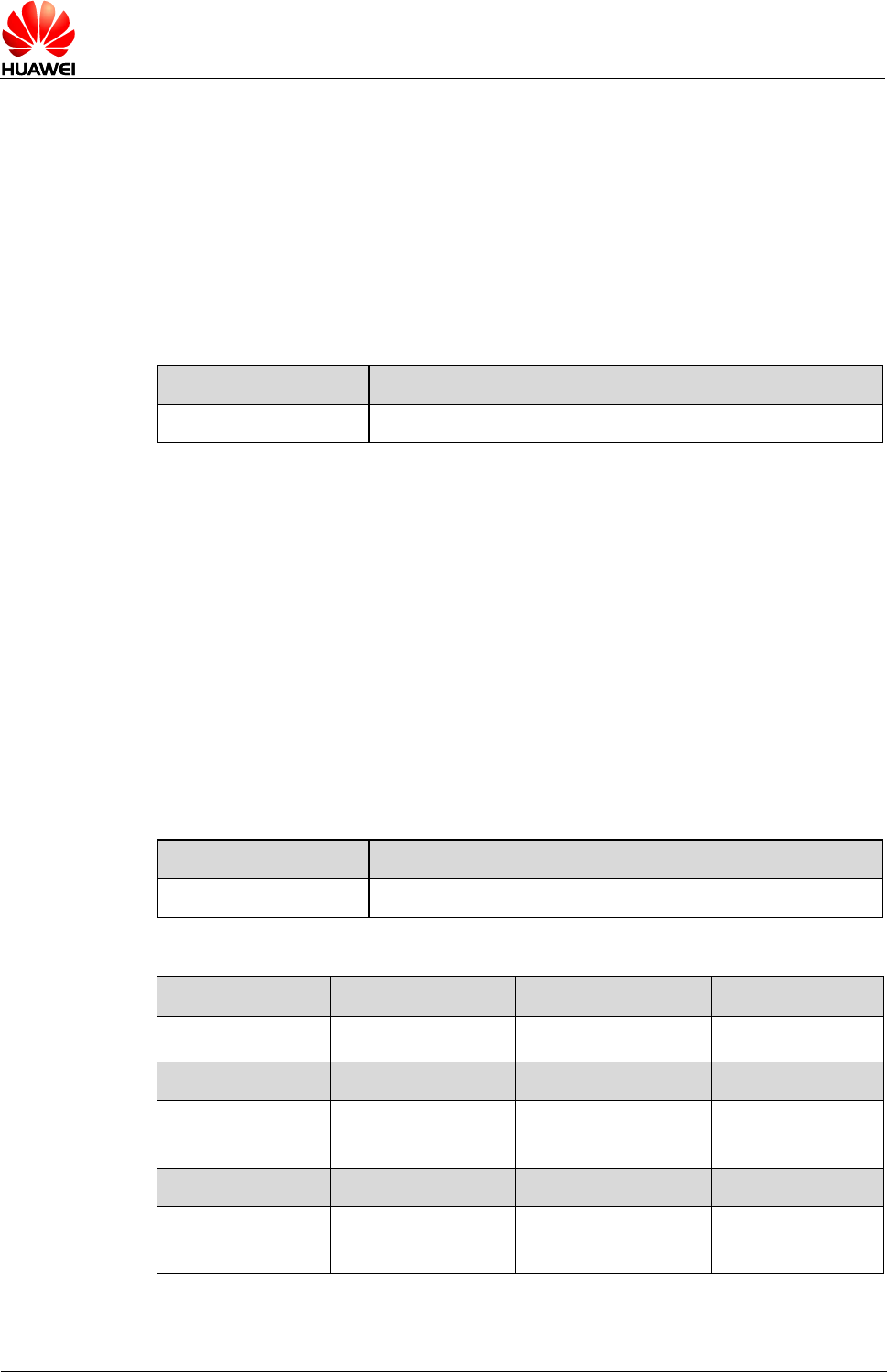
HUAWEI MU736 HSPA+ M.2 Module
AT Command Interface Specification
Huawei Proprietary Interface: Mobile
Termination Control and Status Interface
Issue 02 (2013-12-24)
HUAWEI Proprietary and Confidential
Copyright © HUAWEI Technologies Co., Ltd.
118
- Bit [63-61] is reserved for page, it defines the page number of unsolicited results
to be presented (which is used to expansion for the presentation of unsolicited
results); Up to eight pages can be specified.
- Bit [60-0] is <Sleep_UR_mask> that defines the types of unsolicited results to be
presented; each bit specifies whether the presentation of the corresponding type
of unsolicited results is enabled or disabled. If the value of a bit is 1, the
presentation is enabled. If the value of a bit is 1, the presentation is disabled. The
detail information for each bit can be seen in Table 10-5 .
The following table describes the definitions of bit [63-61] and bit [60-0] for
<Sleeping_UR_cfg>.
Bit[63-61]
Bit[60-0]
Page
Sleep_ur_mask
<working_UR_cfg>: specifies the types of unsolicited results to be presented when
in operating mode. The length is 64-bits and the value must be entered in
hexadecimal format.
- Bit [63-61] is reserved for page, it defines the page types of unsolicited results to
be presented (which is used to expansion for the presentation of unsolicited
results); Up to eight pages can be specified.
- Bit [60-0] is <work_UR_mask> that defines the types of unsolicited results to be
presented; each bit specifies whether the presentation of the corresponding type
of unsolicited results is enabled or disabled. If the value of a bit is 1, the
presentation is enabled. If the value of a bit is 1, the presentation is disabled. The
detail information for each bit can be seen in Table 10-5 .
The following table describes the definitions of bit [63-61] and bit [60-0] for
<work_UR_cfg>.
Bit[63-61]
Bit[60-0]
Page
work_ur_mask
Table 10-5 Definitions of Page 0 Bit [60~0] for the presentation of unsolicited results
Bit 0
Bit 1
Bit 2
Bit 3
^MODE
^RSSI
^CSNR
^SRVST
Bit 4
Bit 5
Bit 6
Bit 7
+CREG/+CGREG
^SIMST
^NWTIME
(not supported)
^ACTIVEBAND
(not supported)
Bit 8
Bit 9
Bit 10
Bit 11
^ANLEVEL
(not supported)
^LOCCHD
(not supported)
^SIMFILEREFRESH
(not supported)
^SMMEMFULL

HUAWEI MU736 HSPA+ M.2 Module
AT Command Interface Specification
Huawei Proprietary Interface: Mobile
Termination Control and Status Interface
Issue 02 (2013-12-24)
HUAWEI Proprietary and Confidential
Copyright © HUAWEI Technologies Co., Ltd.
119
Bit 12
Bit 13
Bit 14
Bit 15
^POSITION
(not supported)
^TIMESETRULT
/^DATASETRULT
/^DATAVALIDITY
(not supported)
^WNINV
(not supported)
^POSEND
(not supported)
Bit 16
Bit 17
Bit 18
Bit 19
^WPDCP
(not supported)
^WPDDL
(not supported)
^WPDOP
(not supported)
+CTZV
(not supported)
Bit 20
Bit 21
Bit 22
Bit 23
^NDISEND
(not supported)
^BOOT
(not supported)
^DSFLOWRPT
(not supported)
^EARST
(not supported)
Bit 24
Bit 25
Bit 26
Bit 27
^ORIG
(not supported)
^CONF
(not supported)
^CONN
(not supported)
^CEND
(not supported)
Bit 28
Bit 29
Bit 30
Bit 31
^RFSWITCH
^STIN
(not supported)
+CUSD
+CMTI
Bit 32
Bit 33
Bit 34
Bit 35
^RSSILVL
(not supported)
^HRSSILVL
(not supported)
^HDRRSSI
(not supported)
^CRSSI
(not supported)
Bit 36
Bit 37
Bit 38
Bit 39
^OTACMSG
(not supported)
^DSDORMANT
(not supported)
^IPDATA
(not supported)
^THERM
Bit 40
Bit 41
Bit 42
Bit 43
^XDSTATUS
(not supported)
+CLIP
(not supported)
+CCWA
(not supported)
+CSSI
(not supported)
Bit 44
Bit 45
Bit 46
Bit 47
+CSSU
(not supported)
^IPSTATE
(not supported)
+CUSATP
(not supported)
+CUSATEND
(not supported)
Bit 48
Bit 49
Bit 50
Bit 51
^NDISSTAT
Reserved
Reserved
Reserved
Bit 52
Bit 53
Bit 54
Bit 55
Reserved
Reserved
Reserved
Reserved
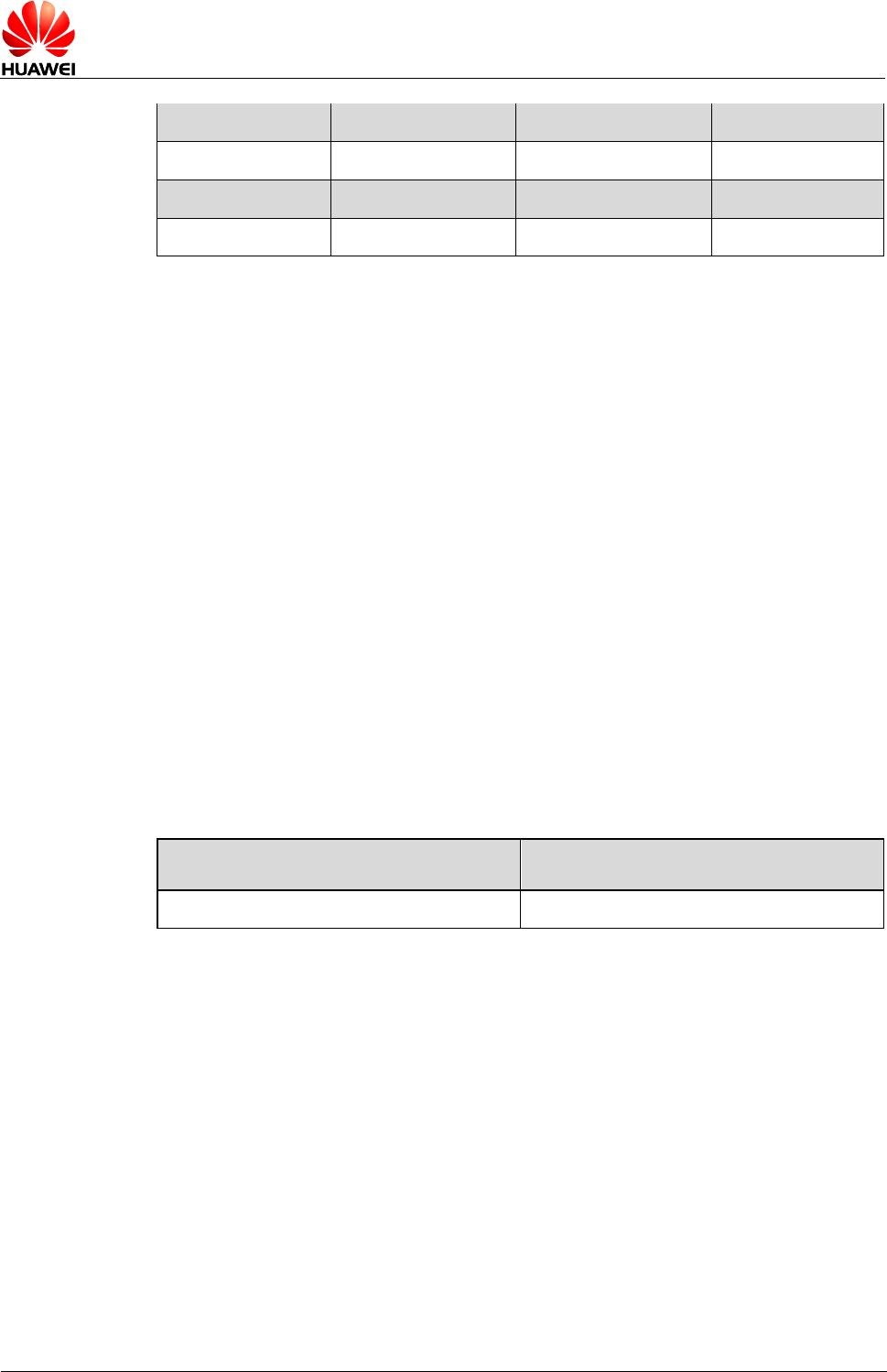
HUAWEI MU736 HSPA+ M.2 Module
AT Command Interface Specification
Huawei Proprietary Interface: Mobile
Termination Control and Status Interface
Issue 02 (2013-12-24)
HUAWEI Proprietary and Confidential
Copyright © HUAWEI Technologies Co., Ltd.
120
Bit 56
Bit 57
Bit 58
Bit 59
Reserved
Reserved
Reserved
Reserved
Bit 60
Reserved
-
-
-
Notes:
- When <mode>=0 or 1, <Sleeping_UR_cfg> and <working_UR_cfg> must not
be contained in the command. When <mode>=2, <Sleeping_UR_cfg> and
<working_UR_cfg> must be contained in the command, or ERROE will be returned.
The <Sleeping_UR_cfg> and <working_UR_cfg> configured when <mode>=2
are not saved when the product is powered off.
- Up to 8*61=488 of the presentation of unsolicited results supported (including ones added
by huawei and standard) can be configured by customer. The strong related presentation of
unsolicited results are controlled by the same bit, such as ^TIMESETRULT and
^DATASETRULT. For the presentation of unsolicited results added later, you must add the
illustration for the bit.
- Undefined bits and currently-not-supported unsolicited results cannot be configured by
using the AT^CURC command.
- The AT commands of each unsolicited results may vary with the specific products.
- The unsolicited AT will be store when the host is in sleep status. And the unsolicited AT
result will be reported to the host when the host exit sleep status to reduce the wakeup
times.
- When connect to Windows 8 host, <mode>=0 or 1 is not supported and the Bit [0,3,
30,31,48] cannot be configured to 0.
10.2.4 Property Description
Saving upon Power-off
PIN
N
N
10.2.5 Example
Run:
AT^CURC=0
Set <mode> to 0
Response:
OK
Run:
AT^CURC=1
Set <mode> to 1
Response:
OK
Run:
AT^CURC=2,FF,F
Set <mode> to 2
Response:
OK
Run:
AT^CURC?
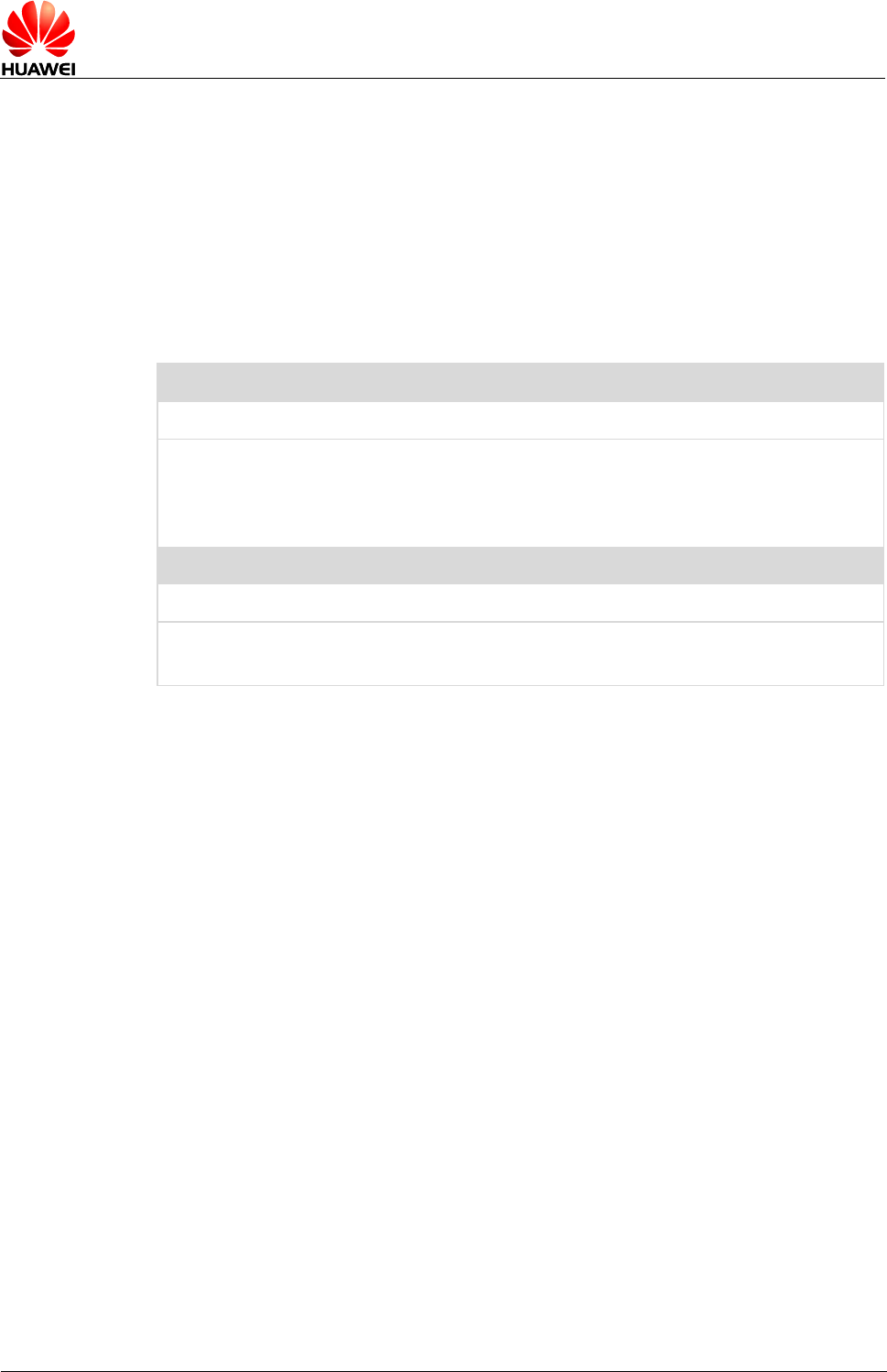
HUAWEI MU736 HSPA+ M.2 Module
AT Command Interface Specification
Huawei Proprietary Interface: Mobile
Termination Control and Status Interface
Issue 02 (2013-12-24)
HUAWEI Proprietary and Confidential
Copyright © HUAWEI Technologies Co., Ltd.
121
Response:
^CURC: 2,0xff,0xf
OK
10.3 AT^HGMR–Request Version Information
10.3.1 Command Syntax
AT^HGMR=<type>
Possible Response(s)
<CR><LF>^HGMR: <version><CR><LF><CR><LF>OK<CR><LF>
In case of an MT-related error:
<CR><LF>+CME ERROR: <err><CR><LF>
AT^HGMR=?
Possible Response(s)
<CR><LF>^HGMR: (list of supported
<type>s)<CR><LF><CR><LF>OK<CR><LF>
10.3.2 Interface Description
This command queries the version information, including the baseline software
version released by platform suppliers, the platform software version which the
product bases on, the product software version and the software version of PC
Vendor.
10.3.3 Parameter Description
<type>: integer type, indicating the query type.
1
Query the baseline software version. (not supported currently)
2
Query the platform software version .(not supported currently)
3
Query the product software version.
4
Query the software version of PC Vendor.
<version>: string type, indicating the specified software version information.
Note:
A blank character "" will be returned when a query type is not supported or does not exsit.

HUAWEI MU736 HSPA+ M.2 Module
AT Command Interface Specification
Huawei Proprietary Interface: Mobile
Termination Control and Status Interface
Issue 02 (2013-12-24)
HUAWEI Proprietary and Confidential
Copyright © HUAWEI Technologies Co., Ltd.
122
10.3.4 Property Description
Saving upon Power-off
PIN
NA
N
10.3.5 Example
Run:
AT^HGMR=1
Response:
^HGMR: ""
OK
Run:
AT^HGMR=4
Response:
^HGMR: "MU736CUST_B001SP01_OEM"
OK
Run:
AT^HGMR=?
Response:
^HGMR: (1-4)
OK
10.4 AT^HWCUST–Enable Custom Hardware Function
10.4.1 Command Syntax
AT^HWCUST=<func>,<action>
Possible Response(s)
<CR><LF>OK<CR><LF>
In case of an MT-related error:
<CR><LF>ERROR<CR><LF>
AT^HWCUST?
Possible Response(s)
<CR><LF>^HWCUST: list of
(<func>,<action>)s<CR><LF><CR><LF>OK<CR><LF>
AT^HWCUST=?
Possible Response(s)
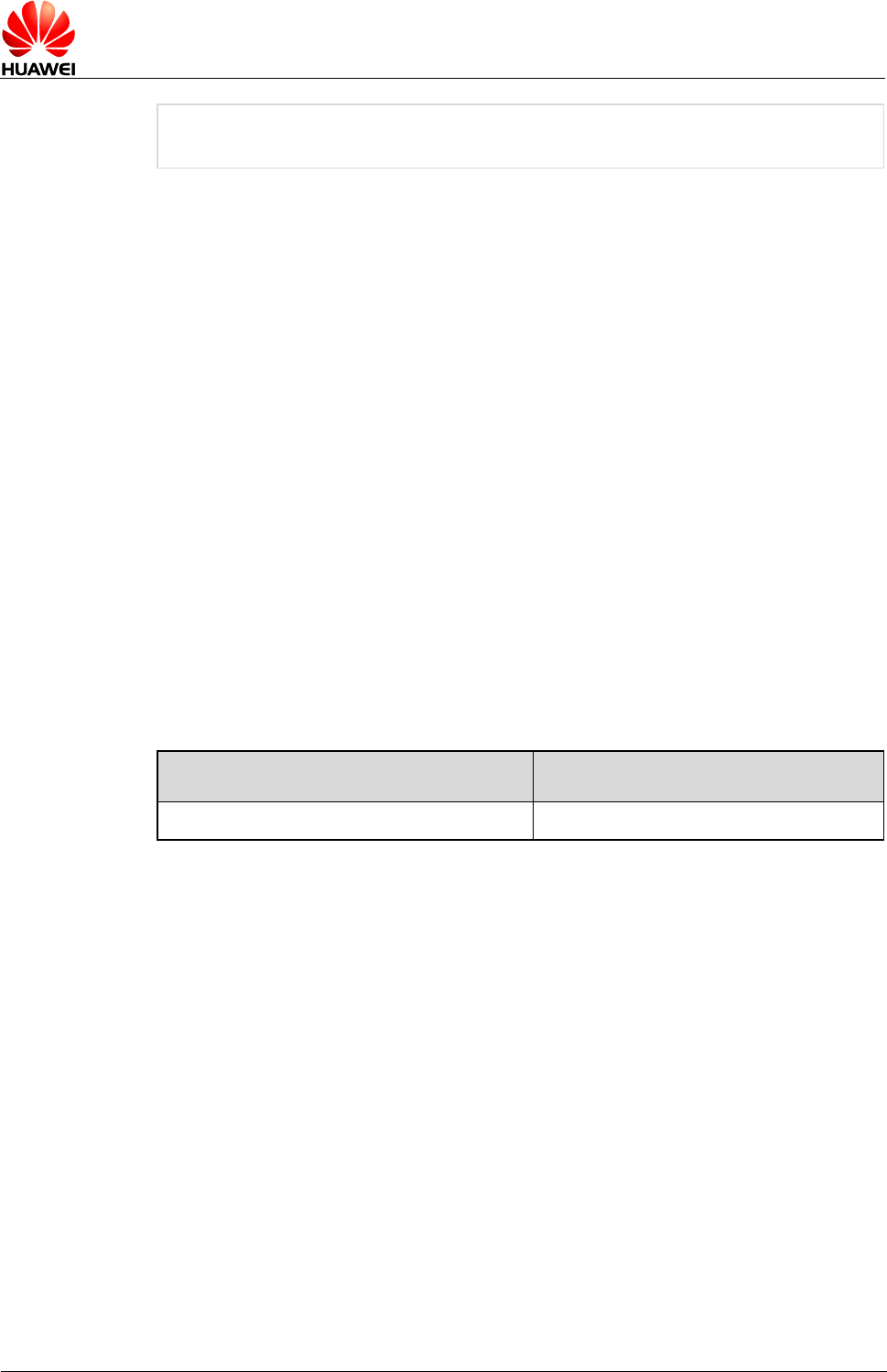
HUAWEI MU736 HSPA+ M.2 Module
AT Command Interface Specification
Huawei Proprietary Interface: Mobile
Termination Control and Status Interface
Issue 02 (2013-12-24)
HUAWEI Proprietary and Confidential
Copyright © HUAWEI Technologies Co., Ltd.
123
<CR><LF>^HWCUST: list of supported (<func>,(list of supported
<action>s))s<CR><LF><CR><LF>OK<CR><LF>
10.4.2 Interface Description
This interface controls some pins of the module, and enables/disables these hardware
functions.
10.4.3 Parameter Description
<func>: the hardware function.
0
GNSS reference clock
1-255
Reserved
<action>: enables or disables the hardware function. The values of <action> may
be different among various hardware functions.
0
Disable the hardware function. (default value)
1
Enable the hardware function.
2-255
Reserved
10.4.4 Property Description
Saving upon Power-off
PIN
N
N
10.4.5 Example
If the module supports GNSS reference clock function.
Run:
AT^HWCUST=?
Query the supported states of GNSS
reference clock.
Response:
^HWCUST: (0,(0,1))
OK
Run:
AT^HWCUST?
Query the current state of GNSS
reference clock.
Response:
^HWCUST: (0,1)
OK
Run:
AT^HWCUST=0,1
Enable the GNSS reference clock.

HUAWEI MU736 HSPA+ M.2 Module
AT Command Interface Specification
Huawei Proprietary Interface: Mobile
Termination Control and Status Interface
Issue 02 (2013-12-24)
HUAWEI Proprietary and Confidential
Copyright © HUAWEI Technologies Co., Ltd.
124
Response:
OK

HUAWEI MU736 HSPA+ M.2 Module
AT Command Interface Specification
Huawei Proprietary Interface: Network
Service Interfaces
Issue 02 (2013-12-24)
HUAWEI Proprietary and Confidential
Copyright © HUAWEI Technologies Co., Ltd.
125
11 Huawei Proprietary Interface:
Network Service Interfaces
11.1 AT^SYSINFO–Query System Information
11.1.1 Command Syntax
AT^SYSINFO
Possible Response(s)
<CR><LF>^SYSINFO:<srv_status>,<srv_domain>,<roam_status>,<sy
s_mode>,<sim_state>[,<lock_state>,<sys_submode>]<CR><LF><CR><
LF>OK<CR><LF>
11.1.2 Interface Description
This command queries the current system information, such as the system service
status, domain, roaming status, system mode, and SIM card state.
11.1.3 Parameter Description
<srv_status>: indicates the system service status.
0
No services
1
Restricted services
2
Valid services
3
Restricted regional services (not supported currently)
4
Power saving or hibernate state (not supported currently)
<srv_domain>: indicates the system service domain.
0
No services

HUAWEI MU736 HSPA+ M.2 Module
AT Command Interface Specification
Huawei Proprietary Interface: Network
Service Interfaces
Issue 02 (2013-12-24)
HUAWEI Proprietary and Confidential
Copyright © HUAWEI Technologies Co., Ltd.
126
1
CS service only
2
PS service only
3
PS+CS services
4
Not registered to CS or PS; searching now
255
CDMA (not supported currently)
<roam_status>: indicates the roaming status.
0
Not roaming
1
Roaming
<sys_mode>: indicates the system mode.
0
No services
3
GSM/GPRS mode
5
WCDMA mode
7
GSM/WCDMA mode
<sim_state>: indicates the state of the SIM card.
0
Invalid SIM card
1
Valid SIM card
2
Invalid SIM card in CS
3
Invalid SIM card in PS
4
Invalid SIM card in PS and CS
240
ROM SIM version
255
No SIM card is found
<lock_state>: indicates whether the SIM card is locked by the CardLock feature.
0
SIM card is not locked by the CardLock feature.
1
SIM card is locked by the CardLock feature.
<sys_submode>: indicates the system sub-mode.
0
No services
1
GSM mode
2
GPRS mode
3
EDGE mode
4
WCDMA mode
5
HSDPA mode
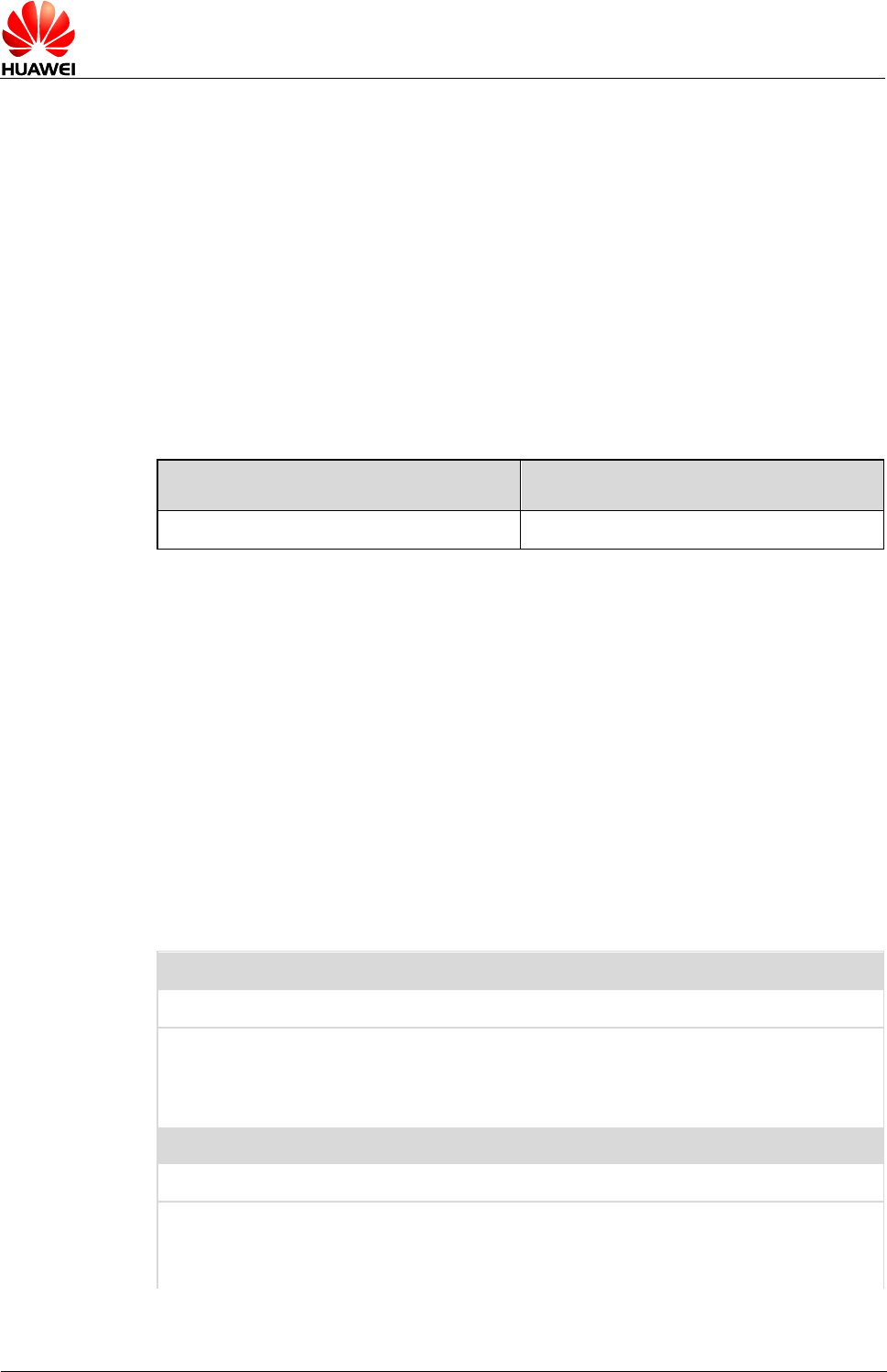
HUAWEI MU736 HSPA+ M.2 Module
AT Command Interface Specification
Huawei Proprietary Interface: Network
Service Interfaces
Issue 02 (2013-12-24)
HUAWEI Proprietary and Confidential
Copyright © HUAWEI Technologies Co., Ltd.
127
6
HSUPA mode
7
HSUPA and HSDPA mode
Note:
According to AT command specifications, parameters value ranges of ^SYSINFO will not be
expanded any more. A new command ^SYSINFOEX is added. To be compatible with Huawei's
earlier-version client and third-party clients, when the value of <sys_submode> is invalid (at
present, valid values are 0–18), one of the following default values will be used: 4 (for products
that support WCDMA).
11.1.4 Property Description
Saving upon Power-off
PIN
NA
N
11.1.5 Example
Run:
AT^SYSINFO
Response:
^SYSINFO:2,3,0,5,1,0,4
OK
11.2 AT^SYSCFG–Configure System
11.2.1 Command Syntax
AT^SYSCFG=<mode>,<acqorder>,<band>,<roam>,<srvdomain>
Possible Response(s)
<CR><LF>OK<CR><LF>
In case of an MT-related error:
<CR><LF>+CME ERROR: <err><CR><LF>
AT^SYSCFG?
Possible Response(s)
<CR><LF>^SYSCFG:
<mode>,<acqorder>,<band>,<roam>,<srvdomain><CR><LF><CR><LF>O
K<CR><LF>

HUAWEI MU736 HSPA+ M.2 Module
AT Command Interface Specification
Huawei Proprietary Interface: Network
Service Interfaces
Issue 02 (2013-12-24)
HUAWEI Proprietary and Confidential
Copyright © HUAWEI Technologies Co., Ltd.
128
AT^SYSCFG=?
Possible Response(s)
<CR><LF>^SYSCFG: (list of supported <mode>s),(list of supported
<acqorder>s),list of supported (<band>,<band_name>)s,(list of supported
<roam>s),(list of supported
<srvdomain>s)<CR><LF><CR><LF>OK<CR><LF>
11.2.2 Interface Description
The set command sets the system mode, GW access order, frequency band, roaming
support, domain, and other features.
The read command queries the current system configuration.
The test command returns values supported as a compound value.
11.2.3 Parameter Description
<mode>: specifies the system mode.
2
Automatic
13
GSM only
14
WCDMA only
16
No change
<acqorder>: specifies the network access order.
0
Automatic
1
GSM > WCDMA
2
WCDMA > GSM
3
No change
255
Not supported
<band>: a hexadecimal value that specifies the frequency band, which is related to
the system mode and dependent on the MT's performance. The value of <band> can
be one of the following values and their combinations (excluding 0x3FFFFFFF and
0x40000000):
80 (CM_BAND_PREF_GSM_DCS_1800)
GSM DCS systems
100 (CM_BAND_PREF_GSM_EGSM_900)
Extended GSM 900
200000 (CM_BAND_PREF_GSM_PCS_1900)
GSM PCS
400000 (CM_BAND_PREF_WCDMA_I_IMT_2000)
WCDMA IMT 2000
3FFFFFFF (CM_BAND_PREF_ANY)
Any frequency band
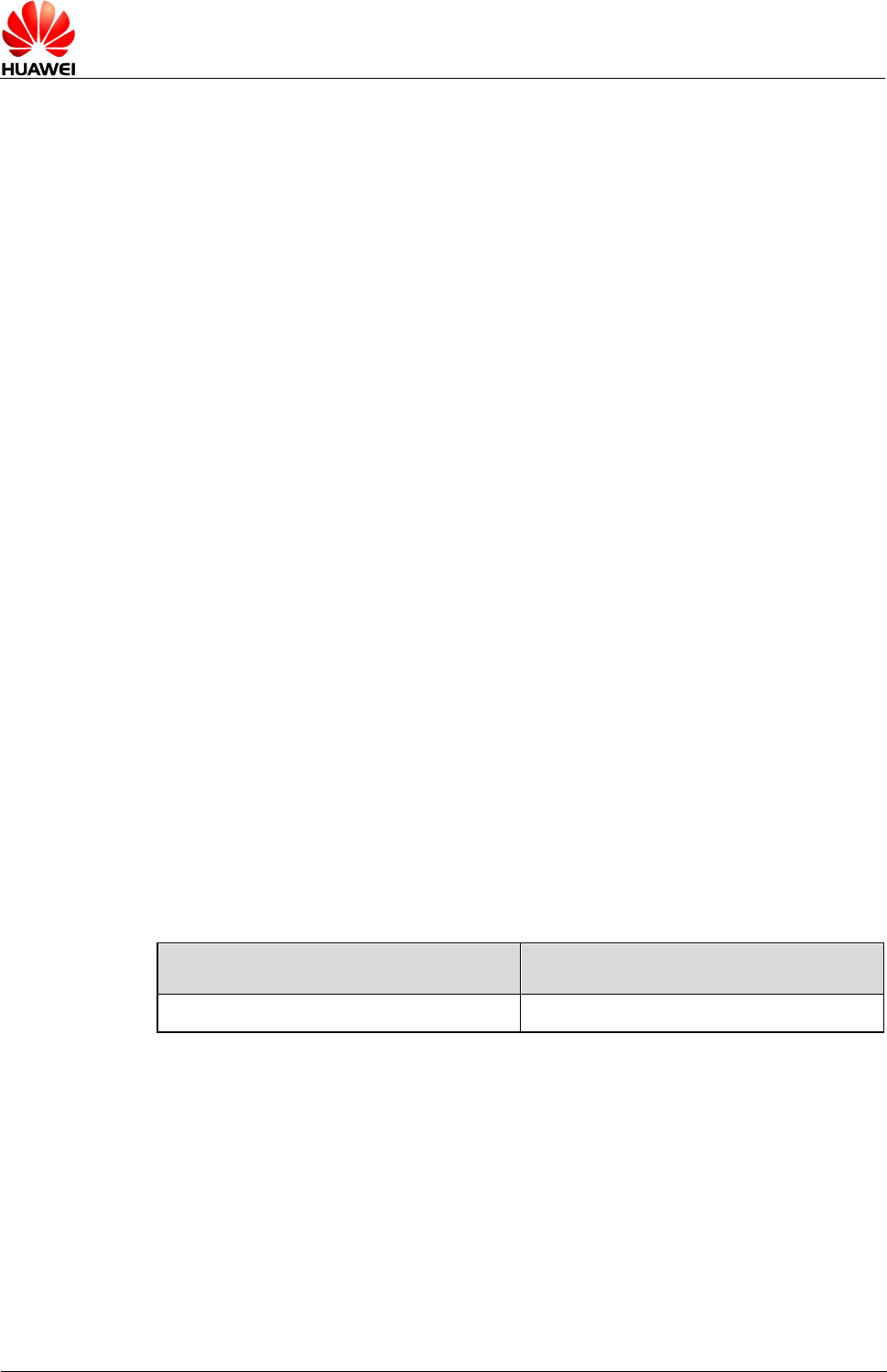
HUAWEI MU736 HSPA+ M.2 Module
AT Command Interface Specification
Huawei Proprietary Interface: Network
Service Interfaces
Issue 02 (2013-12-24)
HUAWEI Proprietary and Confidential
Copyright © HUAWEI Technologies Co., Ltd.
129
40000000 (CM_BAND_PREF_NO_CHANGE)
No change of the band
2000000 (CM_BAND_PREF_WCDMA_IX_1700)
AWS
0000000000400000 (CM_BAND_PREF_WCDMA_IMT)
WCDMA_IMT(2100)
0002000000000000
WCDMA 900
04000000
WCDMA 850
0000000000800000
WCDMA 1900
00680380
Automatic
00080000
GSM 850
<band_name>: a string type value indicating the frequency band name.
<roam>: indicates whether roaming is supported.
0
Not supported
1
Supported
2
No change
<srvdomain>: indicates the domain setting.
0
CS_ONLY
1
PS_ONLY(not supported currently)
2
CS_PS
3
ANY
4
No change
255
Not supported
11.2.4 Property Description
Saving upon Power-off
PIN
Y
Y
Note:
In the AT&T version, AT^SYSCFG can not be saved upon power-off because of the AT&T ENS
feature.
11.2.5 Example
Run:
AT^SYSCFG=?
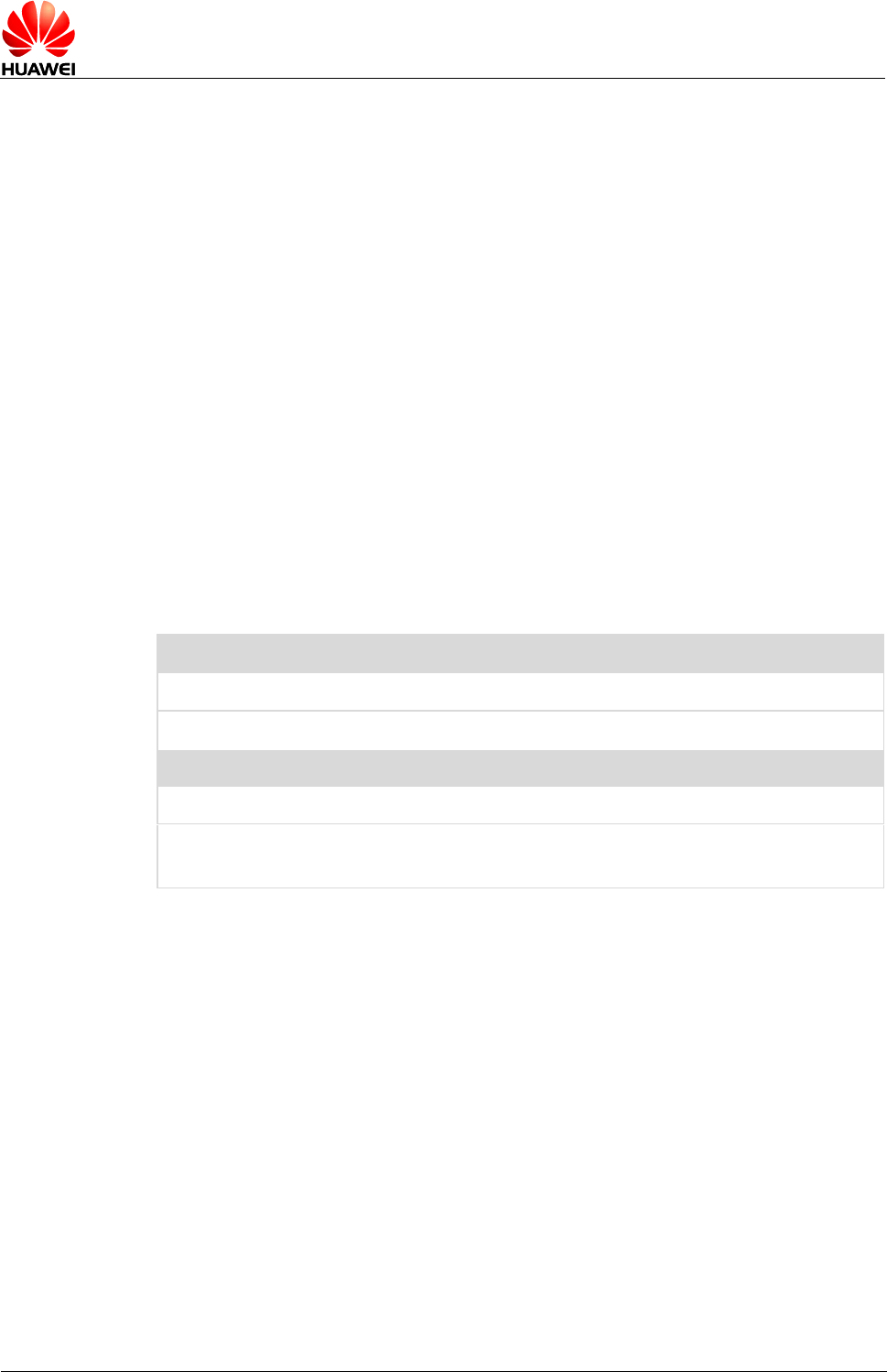
HUAWEI MU736 HSPA+ M.2 Module
AT Command Interface Specification
Huawei Proprietary Interface: Network
Service Interfaces
Issue 02 (2013-12-24)
HUAWEI Proprietary and Confidential
Copyright © HUAWEI Technologies Co., Ltd.
130
Response:
^SYSCFG: (2,13,14,16),(0-3),((3fffffff,"All
Bands"),(2000000400180,"GSM900/GSM1800/WCDMA900/WC
DMA2100"),(6A80000,"GSM850/GSM1900/WCDMA850/AWS/WC
DMA1900")),(0-2),(0-4)
OK
Run:
AT^SYSCFG?
Response:
^SYSCFG: 2,0,3fffffff,1,2
OK
Run:
AT^SYSCFG=14,0,3fffffff,1,2
Response:
OK
11.3 AT^CSNR–Query RSCP and ECIO
11.3.1 Command Syntax
AT^CSNR?
Possible Response(s)
<CR><LF>^CSNR:<rscp>,<ecio><CR><LF><CR><LF>OK<CR><LF>
AT^CSNR=?
Possible Response(s)
<CR><LF>^CSNR: (list of supported <rscp>s),(list of supported
<ecio>s)<CR><LF><CR><LF>OK<CR><LF>
11.3.2 Interface Description
The read command queries the RSCP/ECIO signal strength. The RSCP/ECIO signal
strength depends on the change of the RSSI.
The relationship between RSCP, ECIO and RSSI is as follows: RSCP = ECIO + RSSI.
In the equation, RSCP, ECIO and RSSI must be absolute values instead of relative
values.
The test command queries the parameter range supported by this command.
11.3.3 Parameter Description
<rscp>: a value ranging from –145 dBm to –60 dBm. In the AT&T customized version,
the void value is 255 in the Win8 system.
<ecio>: a value ranging from –32 dBm to 0 dBm.
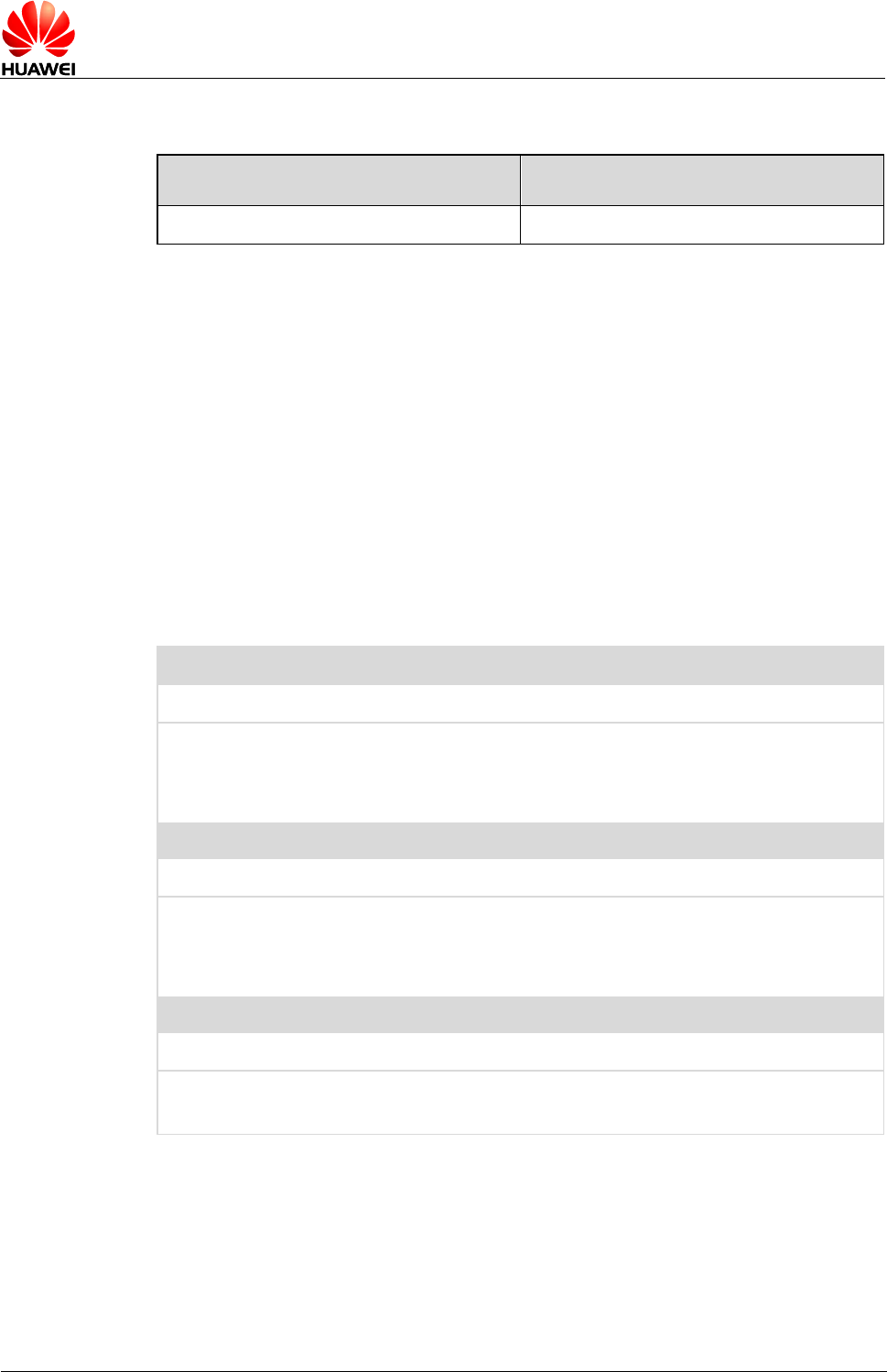
HUAWEI MU736 HSPA+ M.2 Module
AT Command Interface Specification
Huawei Proprietary Interface: Network
Service Interfaces
Issue 02 (2013-12-24)
HUAWEI Proprietary and Confidential
Copyright © HUAWEI Technologies Co., Ltd.
131
11.3.4 Property Description
Saving upon Power-off
PIN
NA
N
11.3.5 Example
Run:
AT^CSNR?
Response:
^CSNR:-76,-3
OK
11.4 AT^USSDMODE–Set USSD Mode
11.4.1 Command Syntax
AT^USSDMODE=<mode>
Possible Response(s)
<CR><LF>OK<CR><LF>
In case of an MT-related error:
<CR><LF>+CME ERROR: <err><CR><LF>
AT^USSDMODE?
Possible Response(s)
<CR><LF>^USSDMODE: <mode><CR><LF><CR><LF>OK<CR><LF>
In case of an MT-related error:
<CR><LF>+CME ERROR: <err><CR><LF>
AT^USSDMODE=?
Possible Response(s)
<CR><LF>^USSDMODE: (list of supported
<mode>s)<CR><LF><CR><LF>OK<CR><LF>
11.4.2 Interface Description
The set command sets the USSD mode.
The read command queries current USSD mode.
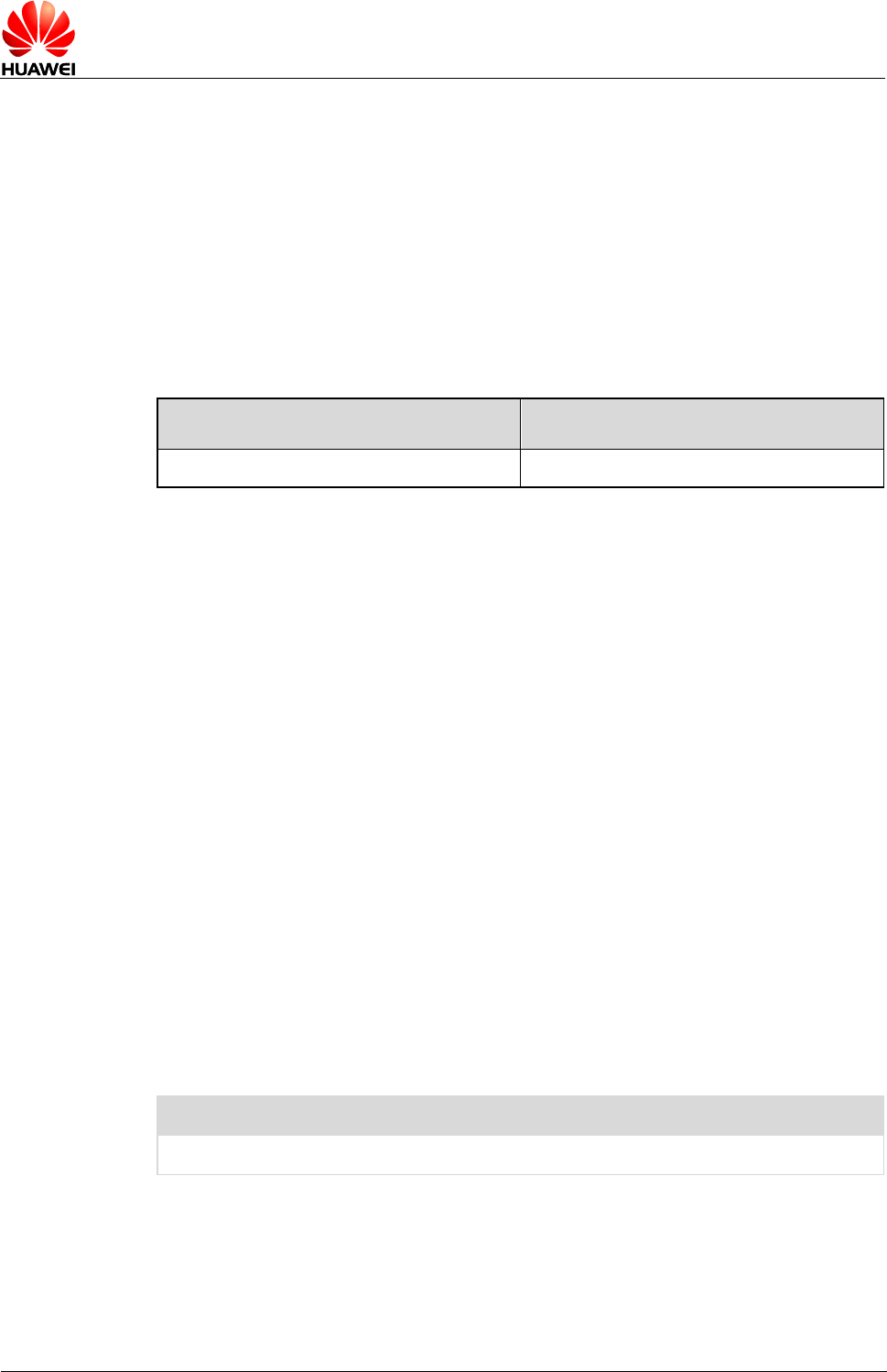
HUAWEI MU736 HSPA+ M.2 Module
AT Command Interface Specification
Huawei Proprietary Interface: Network
Service Interfaces
Issue 02 (2013-12-24)
HUAWEI Proprietary and Confidential
Copyright © HUAWEI Technologies Co., Ltd.
132
The test command returns the list of all supported USSD mode.
11.4.3 Parameter Description
<mode>:
0
The UE will follow the 3GPP, and decode the data that UE sends to the
network.
1
The UE will not decode the data that UE sends to the network.
11.4.4 Property Description
Saving upon Power-off
PIN
Y
N
11.4.5 Example
Run:
AT^USSDMODE?
Response:
^USSDMODE: 1
OK
Run:
AT^USSDMODE=0
Response:
OK
Run:
AT^USSDMODE=?
Response:
^USSDMODE: (0-1)
OK
11.5 ^SRVST–Service State Change Indication
11.5.1 Command Syntax
URC
<CR><LF>^SRVST: <srv_status><CR><LF>
11.5.2 Interface Description
When the state of a service is changed, the MT uses this command to unsolicited
send the new service state to the TE.
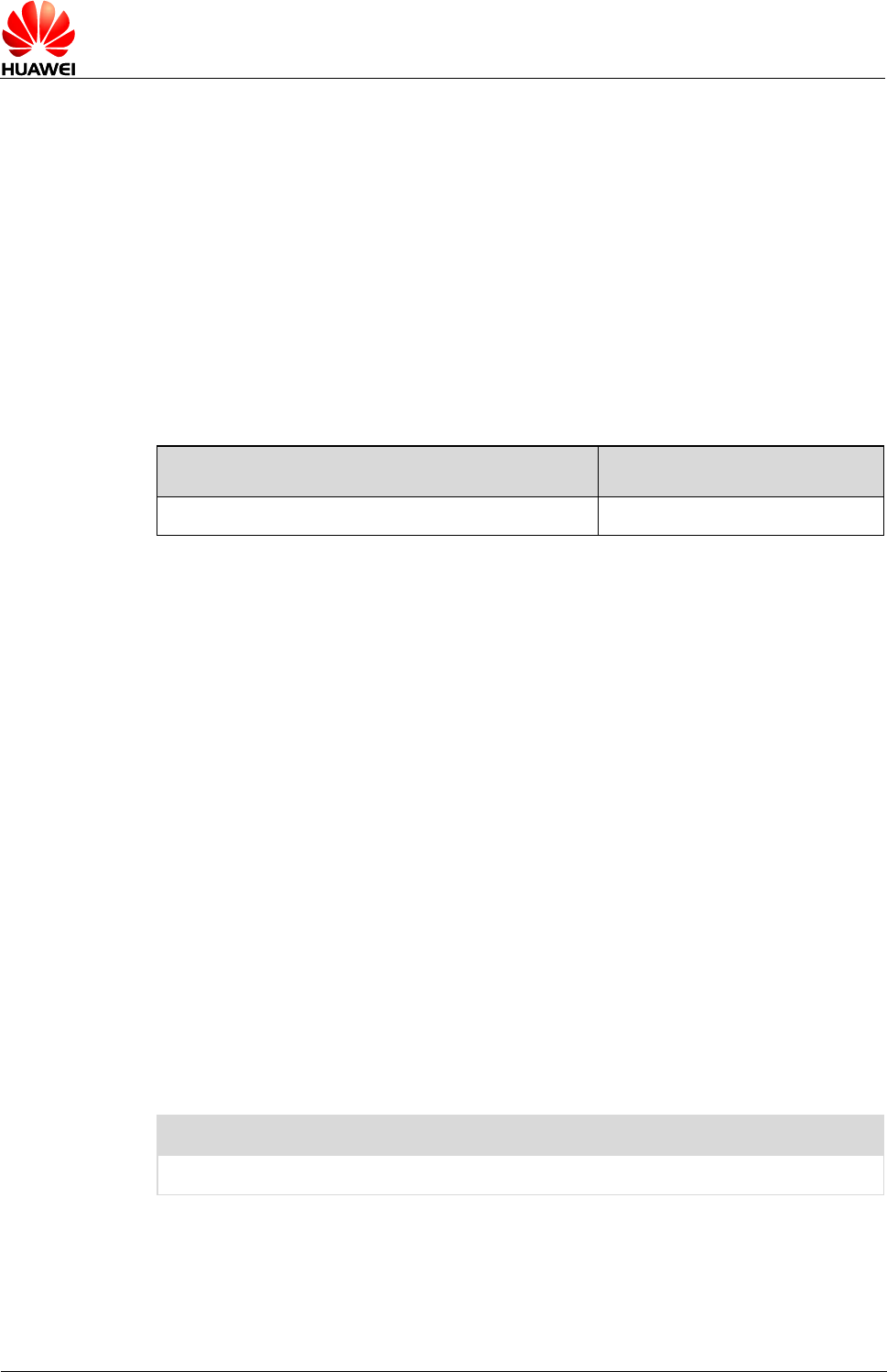
HUAWEI MU736 HSPA+ M.2 Module
AT Command Interface Specification
Huawei Proprietary Interface: Network
Service Interfaces
Issue 02 (2013-12-24)
HUAWEI Proprietary and Confidential
Copyright © HUAWEI Technologies Co., Ltd.
133
11.5.3 Parameter Description
<srv_status>: indicates the system service status.
0
No services
1
Restricted services
2
Valid services
3
Restricted regional services
4
Power saving or hibernate state
11.5.4 Property Description
Saving upon Power-off
PIN
N
N
11.5.5 Example
When sends AT+COPS set command to MT, the state of a service is changed, the MT
unsolicited sends this indication to the TE.
Run:
AT+COPS=2
Response:
^MODE: 5,4
OK
^MODE: 0,0
^SRVST: 0
11.6 ^SIMST–SIM Card State Change Indication
11.6.1 Command Syntax
URC
<CR><LF>^SIMST: <sim_state>[,<lock_state>]<CR><LF>
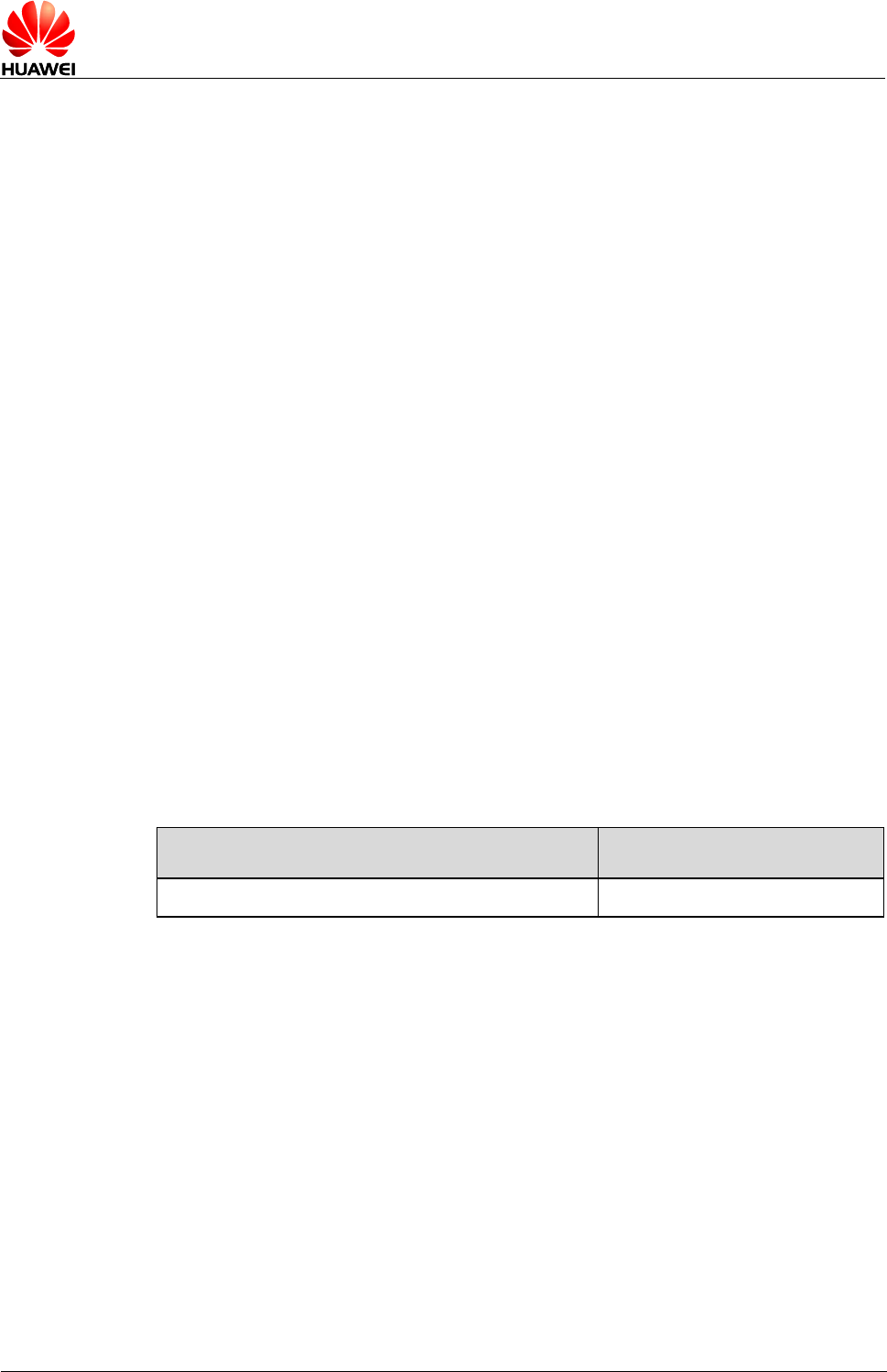
HUAWEI MU736 HSPA+ M.2 Module
AT Command Interface Specification
Huawei Proprietary Interface: Network
Service Interfaces
Issue 02 (2013-12-24)
HUAWEI Proprietary and Confidential
Copyright © HUAWEI Technologies Co., Ltd.
134
11.6.2 Interface Description
When the state of the SIM card is changed, the MT uses this command to unsolicited
send the new state to the TE. Meanwhile, the indication also indicates whether the
SIM card is locked.
11.6.3 Parameter Description
<sim_state>: indicates the state of the SIM card.
0
Invalid SIM card
1
Valid SIM card
2
Invalid SIM card in CS domain
3
Invalid SIM card in PS domain
4
Invalid SIM card in PS domain and CS domain
240
ROMSIM version
255
No SIM card is found. This value may be returned if the SIM card is not
inserted or it is locked by the CardLock feature. In this case, the actual
state of the SIM card is determined by <lock_state>.
<lock_state>: indicates whether the SIM card is locked by the CardLock feature.
0
SIM card is not locked by the CardLock feature.
1
SIM card is locked by the CardLock feature
11.6.4 Property Description
Saving upon Power-off
PIN
NA
N
11.6.5 Example
Once the module is powered up with PIN disabled and card lock disabled, it will
reported as follow:
Response:
^SIMST: 1,0
^RSSI: 99
^CSNR:-145,-32
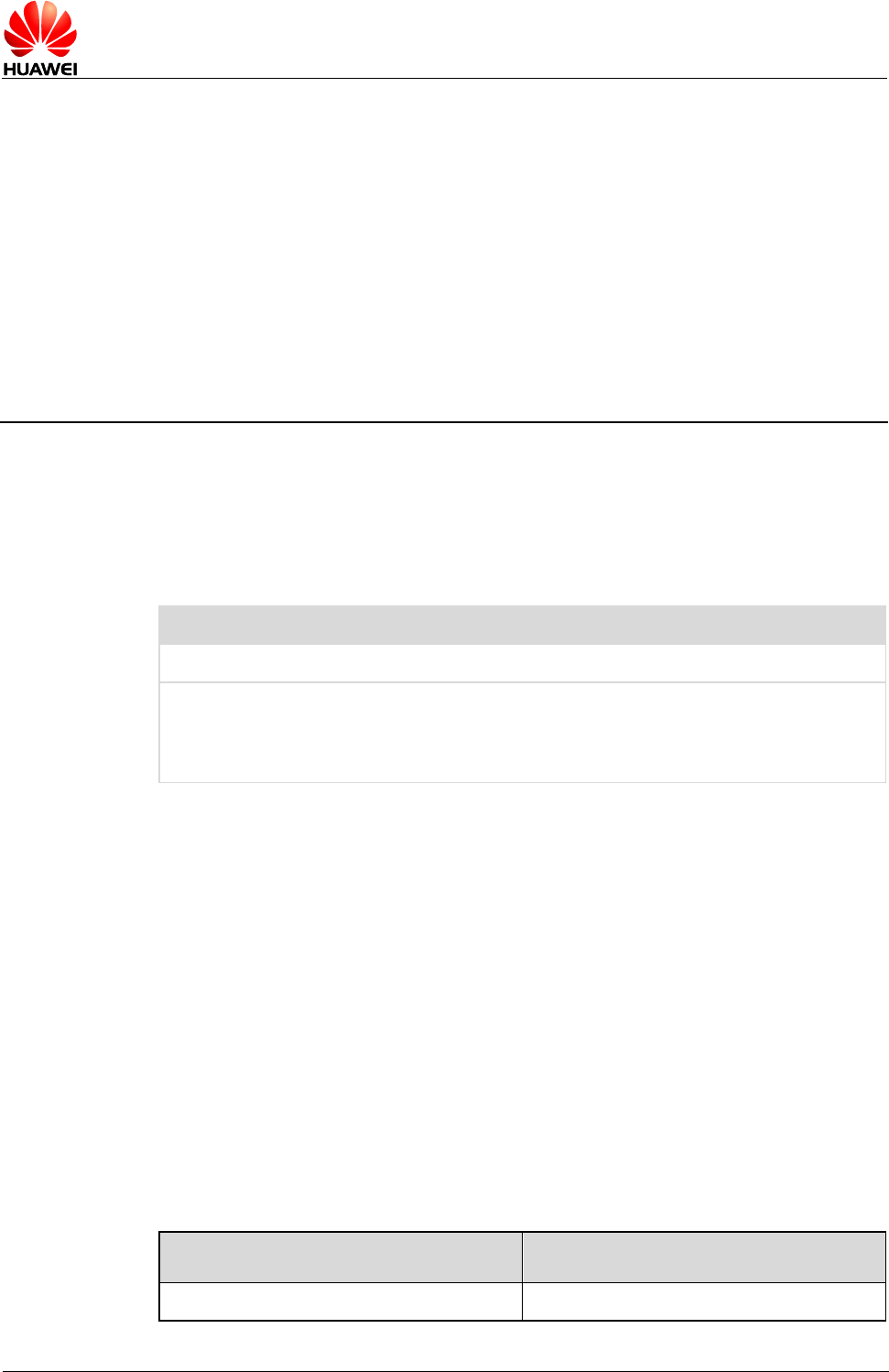
HUAWEI MU736 HSPA+ M.2 Module
AT Command Interface Specification
Huawei Proprietary Interface: STK Interface
Issue 02 (2013-12-24)
HUAWEI Proprietary and Confidential
Copyright © HUAWEI Technologies Co., Ltd.
135
12 Huawei Proprietary Interface: STK
Interface
12.1 AT^CUSATM–Query the Main Menu
12.1.1 Command Syntax
AT^CUSATM?
Possible Response(s)
<CR><LF>^CUSATM: <setup_menu><CR><LF><CR><LF>OK<CR><LF>
In case of an MT-related error:
<CR><LF>+CME ERROR: <err><CR><LF>
12.1.2 Interface Description
This command queries STK main menu information. After UICC sends the proactive
command "SETUP MENU" to MT, TE can use AT^CUSATM to query the content of the
proactive command "SETUP MENU". If UICC does not send the proactive command
"SET UP MENU" to MT, <setup_menu> is empty when TE query the content of the
proactive command "SETUP MENU".
12.1.3 Parameter Description
<setup_menu>: UICC proactive command, string type in hexadecimal character
format, consisting of the full BER-TLV data object (which is the proactive command
"SETUP MENU" sent by UICC) as defined in 3GPP TS 31.111, ETSI TS 102.221 and
ETSI TS 102.223 protocols.
12.1.4 Property Description
Saving upon Power-off
PIN
NA
Y

HUAWEI MU736 HSPA+ M.2 Module
AT Command Interface Specification
Huawei Proprietary Interface: STK Interface
Issue 02 (2013-12-24)
HUAWEI Proprietary and Confidential
Copyright © HUAWEI Technologies Co., Ltd.
136
12.1.5 Example
Run:
AT^CUSATM?
Response:
^CUSATM:"D0818A81030125008202818285118051687403901
A005500530049004D53618F0D01444953504C4159205445585
48F0A0247455420494E4B45598F0A0347455420494E5055548
F0A044D4F52452054494D458F0A05504C415920544F4E458F0
E06504F4C4C20494E54455256414C8F0807524546524553488
F130853454E442053484F5254204D455353414745"
OK

HUAWEI MU736 HSPA+ M.2 Module
AT Command Interface Specification
Huawei Proprietary Interface: M.2 Interface
Issue 02 (2013-12-24)
HUAWEI Proprietary and Confidential
Copyright © HUAWEI Technologies Co., Ltd.
137
13 Huawei Proprietary Interface: M.2
Interface
13.1 AT+XTSM–Set Thermal Sensor with the Threshold
13.1.1 Command Syntax
AT+XTSM=<temp_sensor_id>[,<AlarmID>[,[<TripPointTemp>,<Hystere
sis>][,<sampling_period>]]]
Possible Response(s)
<CR><LF>OK<CR><LF>
In case of an MT-related error:
<CR><LF>ERROR<CR><LF>
AT+XTSM=?
Possible Response(s)
<CR><LF>+XTSM: (list of supported <temp_sensor_id>s),(list of supported
<AlarmId>s),(list of supported <TripPointTemp>s),(list of supported
<Hysteresis>s),(list of supported
<sampling_period>s)<CR><LF><CR><LF>OK<CR><LF>
13.1.2 Interface Description
This command configures thermal sensors with the threshold break points.
The set command enables or disables the alarms for particular sensor.
The test command returns the possible values of thermal sensor monitoring option,
alarm ID range for trip point, hysteresis and sampling period.
13.1.3 Parameter Description
<temp_sensor_id>: temperature sensor ID. Currently only RF sensor is supported.
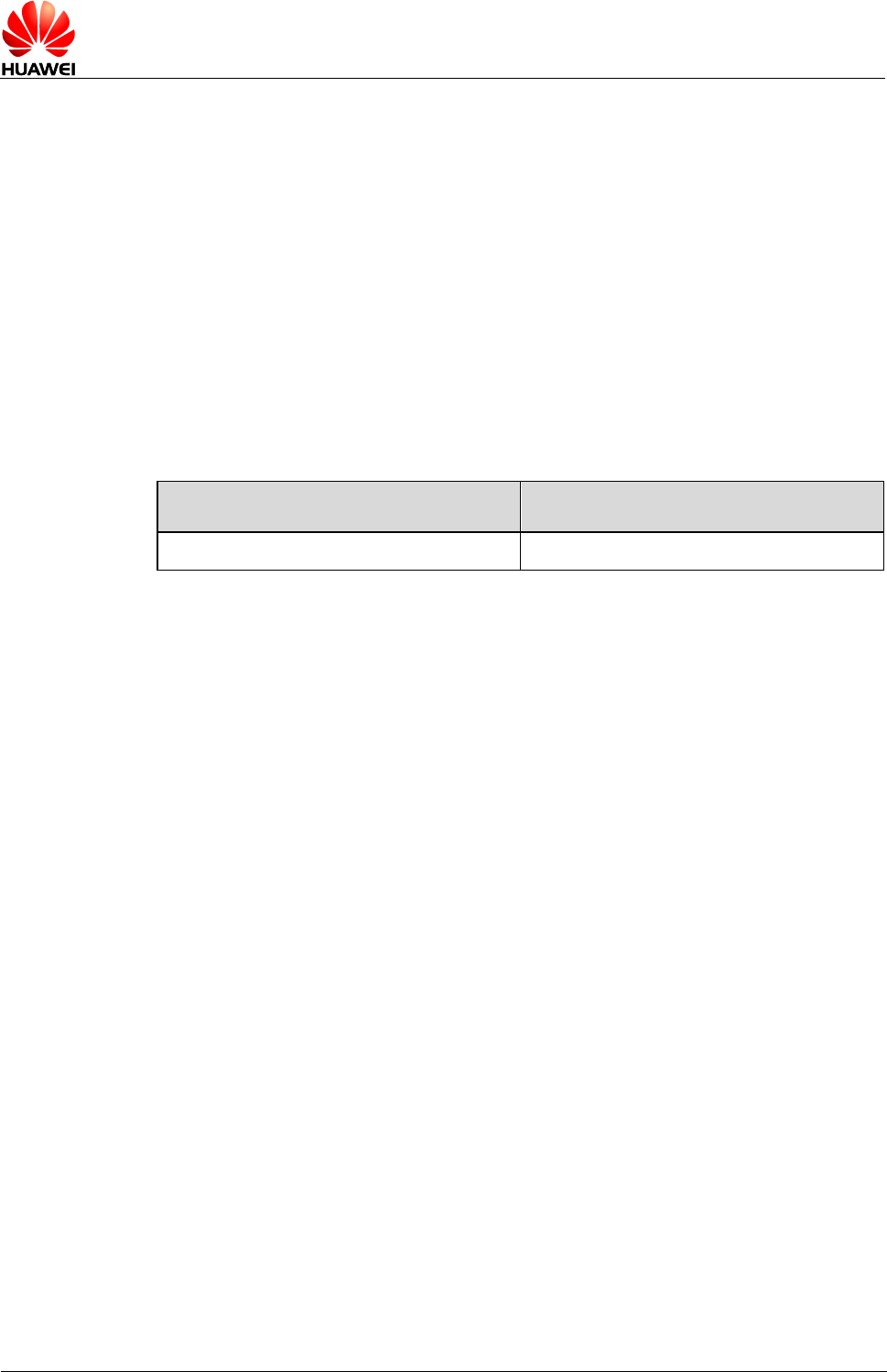
HUAWEI MU736 HSPA+ M.2 Module
AT Command Interface Specification
Huawei Proprietary Interface: M.2 Interface
Issue 02 (2013-12-24)
HUAWEI Proprietary and Confidential
Copyright © HUAWEI Technologies Co., Ltd.
138
0
RF sensor
<AlarmID>: alarm ID value, ranging from 1 to 10.
<TripPointTemp>: minimum value 0 and maximum value 119000 in MilliDegC. The
actual temperature is <TripPointTemp> minus 20000 MilliDegC.For example, when
<TripPointTemp> is 0, the actual temperature is -20000 MilliDegC, and also the
<TripPointTemp> 119000 is corresponding to 99000 MilliDegC.
<Hysteresis>: minimum value 100, maximum value 99000 in MiliDegC.
<Hysteresis> can be used only with <TripPointTemp>.
<sampling_period>: polling interval in millisecond, Minimum value 1000,
maximum value 4294967293.
13.1.4 Property Description
Saving upon Power-off
PIN
NA
N
13.1.5 Example
- Example 1:
Run:
AT+XTSM=0,1,50000,3000,2000
Set the alarm ID,
tripPointTemp value,
hysteresis value, and
sampling period
Response:
OK
Run:
AT+XTSM=?
Test the available value
ranges of these
parameters
Response:
+XTSM: 0,(1-10),(0-119000),
(100-99000),(1000-4294967293)
OK
- Example 2:
Run:
AT+XTSM=0,3,76000,5000
Set the alarm ID,
tripPointTemp value, and
hysteresis value
Response:
OK
- Example 3:
Run:
AT+XTSM=0,10,,30000
Set the sampling period
Response:
OK

HUAWEI MU736 HSPA+ M.2 Module
AT Command Interface Specification
Huawei Proprietary Interface: M.2 Interface
Issue 02 (2013-12-24)
HUAWEI Proprietary and Confidential
Copyright © HUAWEI Technologies Co., Ltd.
139
- Example 4:
Run:
AT+XTSM=0,10
Delete one alarm
Response:
OK
- Example 5:
Run:
AT+XTSM=0
Delete all alarms
Response:
OK
13.2 +XTS–Unsolicitedly Present of the Threshold
Reached
13.2.1 Command Syntax
URC
<CR><LF>+XTS:
<temp_sensor_id>,<AlarmId>,<OnOff>,<Temp><CR><LF>
13.2.2 Interface Description
The URC will be displayed if the threshold is crossed and it gets enabled if user has
set any alarm.
13.2.3 Parameter Description
<temp_sensor_id>: temperature sensor ID. Currently only RF sensor is supported.
0
RF sensor
<AlarmID>: alarm ID value, ranging from 1 to 10.
<OnOff>:
1
When temperature is rising and it crosses trip point temperature.
0
When it goes below (trip point temperature minus hysteresis).
<Temp>: current temperature value in MiliDegC.
13.2.4 Property Description
Saving upon Power-off
PIN
NA
N
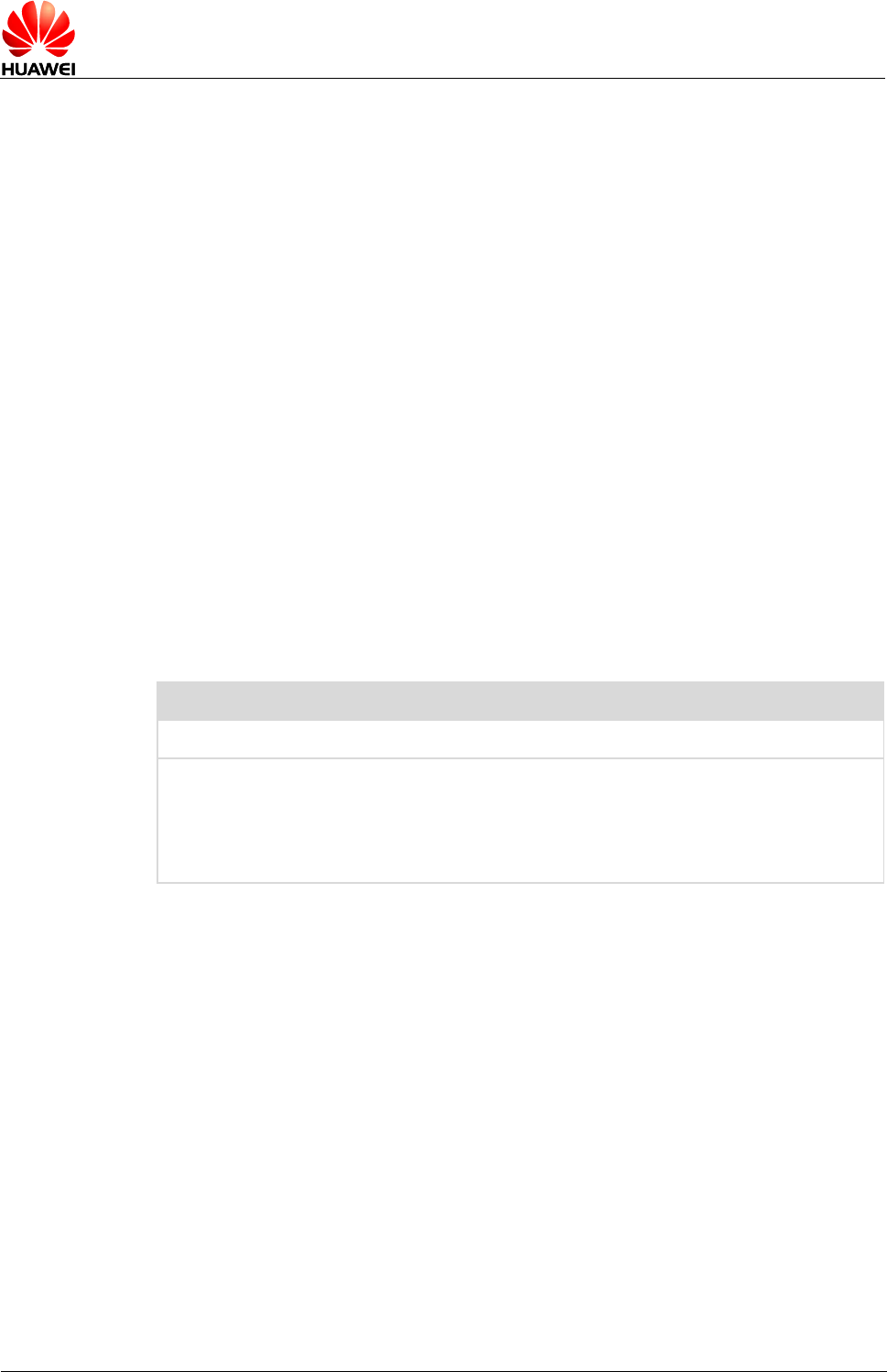
HUAWEI MU736 HSPA+ M.2 Module
AT Command Interface Specification
Huawei Proprietary Interface: M.2 Interface
Issue 02 (2013-12-24)
HUAWEI Proprietary and Confidential
Copyright © HUAWEI Technologies Co., Ltd.
140
13.2.5 Example
Run:
AT+XTSM=0,1,50000,3000,2
000
Set the alarm ID, tripPointTemp
value, hysteresis value, and
sampling period
Response:
OK
Response:
+XTS: 0,1,1,31000
MT will unsolicitedly report when
the temperature rises to 31°C
from the temperature that is
lower than 30°C.
Response:
+XTS: 0,1,0,26500
MT will unsolicitedly report when
the temperature drops to 26.5°C
from the temperature that is
higher than 30°C.
13.3 AT+XTAMR–Query the Current Temperature of a
Thermal Sensor
13.3.1 Command Syntax
AT+XTAMR=<temp_sensor_id>
Possible Response(s)
<CR><LF>+XTAMR:
<temp_sensor_id>,<temp><CR><LF><CR><LF>OK<CR><LF>
In case of an MT-related error:
<CR><LF>ERROR<CR><LF>
13.3.2 Interface Description
The set command returns the current temperature value of particular thermal sensor.
13.3.3 Parameter Description
<temp_sensor_id>: temperature sensor ID. Currently only RF sensor is supported.
0
RF sensor
<temp>: current temperature value in MiliDegC.
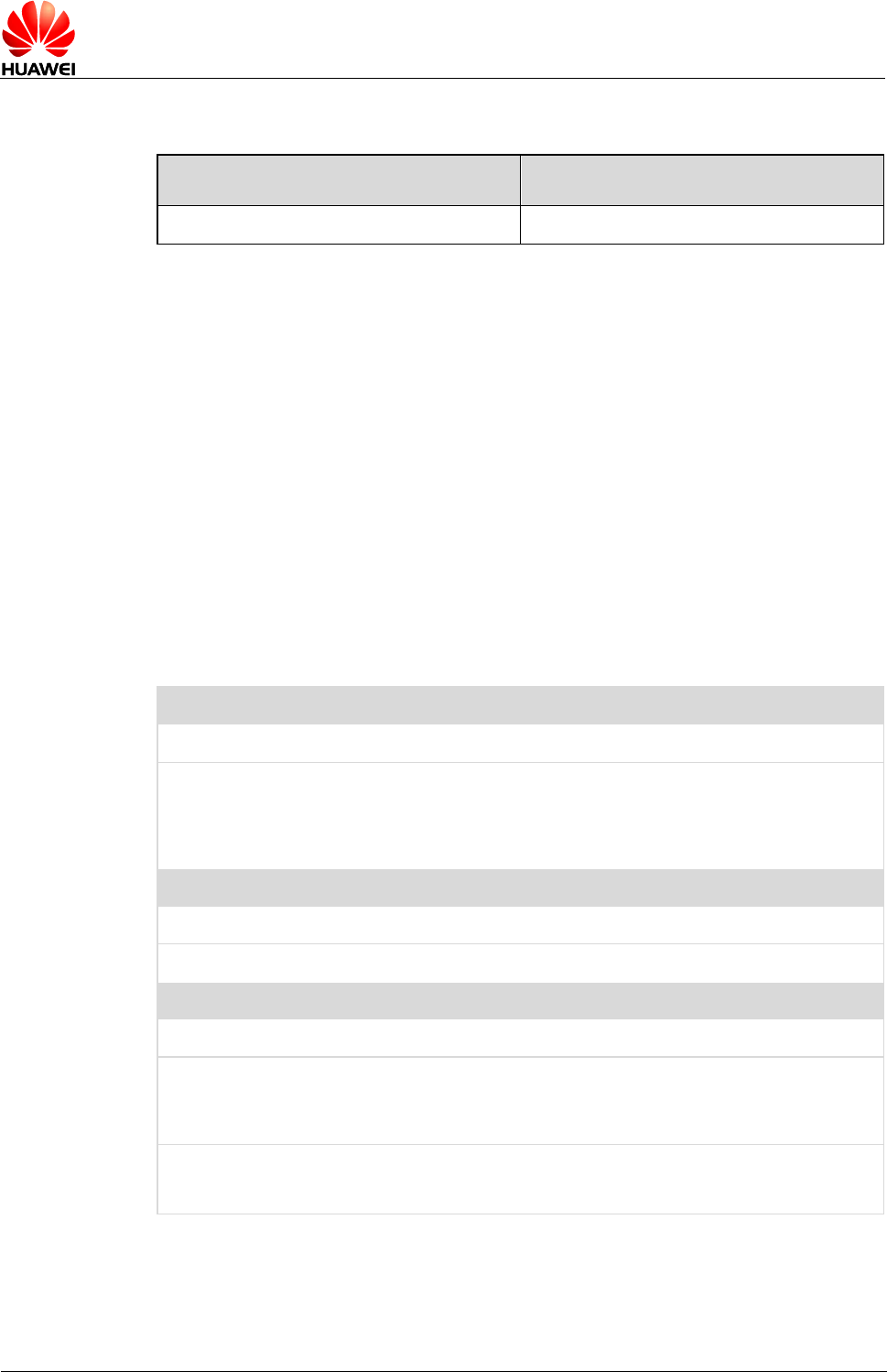
HUAWEI MU736 HSPA+ M.2 Module
AT Command Interface Specification
Huawei Proprietary Interface: M.2 Interface
Issue 02 (2013-12-24)
HUAWEI Proprietary and Confidential
Copyright © HUAWEI Technologies Co., Ltd.
141
13.3.4 Property Description
Saving upon Power-off
PIN
NA
N
13.3.5 Example
Run:
AT+XTAMR=0
Response:
+XTAMR: 0,40000
OK
The current temperature of RF
sensor is 40°C .
13.4 AT+XADPCLKFREQINFO–Query Adaptive Clock
Frequency Info
13.4.1 Command Syntax
AT+XADPCLKFREQINFO=<n>
Possible Response(s)
<CR><LF>OK<CR><LF>
In case of an MT-related error:
<CR><LF>+CME ERROR: <err><CR><LF>
AT+XADPCLKFREQINFO?
Possible Response(s)
<CR><LF>+XADPCLKFREQINFO: <n><CR><LF><CR><LF>OK<CR><LF>
AT+XADPCLKFREQINFO=?
Possible Response(s)
<CR><LF>+XADPCLKFREQINFO:
<centFreq>,<freqSpread>,<noisePower>[[;<centFreq>,<freqSpread>
,<noisePower>[…]]<CR><LF><CR><LF>OK<CR><LF>
In case of an MT-related error:
<CR><LF>+CME ERROR: <err><CR><LF>

HUAWEI MU736 HSPA+ M.2 Module
AT Command Interface Specification
Huawei Proprietary Interface: M.2 Interface
Issue 02 (2013-12-24)
HUAWEI Proprietary and Confidential
Copyright © HUAWEI Technologies Co., Ltd.
142
13.4.2 Interface Description
This command returns the list of frequency information structures. The frequency
information includes the center frequency of the channel number, frequency spread of
the channel number and the noise power referred at antenna.
The set command enables/disables the +XADPCLKFREQINFO URC.
The read command reads the status of enabling/disabling the +XADPCLKFREQINFO
URC.
The test command returns the list of frequency information available, or returns +CME
ERROR: <err> when ACT is disabled.
13.4.3 Parameter Description
<n>:
0
Disable the +XADPCLKFREQINFO URC. (default value)
1
Enable the +XADPCLKFREQINFO URC.
<centFreq>:the center frequency of the channel number in Hz. This is host receiver
channel frequency.
<freqSpread>: the frequency spread of the channel number in Hz. This is host
receiver channel frequency spread.
<noisePower>: the noise power referred at antenna in dBm, at the reported center
frequency, and integrated over a bandwidth equal to reported frequency spread. This
value shall be zeroed if not used.
13.4.4 Property Description
Saving upon Power-off
PIN
N
N
13.4.5 Example
Run:
AT+XADPCLKFREQINFO?
Read the status of
enabling/disabling of the
+XADPCLKFREQINFO URC.
Response:
+XADPCLKFREQINFO: 0
OK
Run:
AT+XADPCLKFREQINFO=1
Enable the
+XADPCLKFREQINFO URC.
Response:
OK

HUAWEI MU736 HSPA+ M.2 Module
AT Command Interface Specification
Huawei Proprietary Interface: M.2 Interface
Issue 02 (2013-12-24)
HUAWEI Proprietary and Confidential
Copyright © HUAWEI Technologies Co., Ltd.
143
Run:
AT+XADPCLKFREQINFO=0
Disable the
+XADPCLKFREQINFO URC.
Response:
OK
Run:
AT+XADPCLKFREQINFO=?
Query the list of frequency
information available:
centFreq, freqSpread, and
noisePower.
Response:
+XADPCLKFREQINFO: 21476000
,5000000,0
OK
13.5 +XADPCLKFREQINFO–Unsolicitedly Present of
Adaptive Clock Frequency Info
13.5.1 Command Syntax
URC
<CR><LF>+XADPCLKFREQINFO: <centFreq>,<freqSpread>,<noisePower
>[[;<centFreq>,<freqSpread>,<noisePower>][…]]<CR><LF>
13.5.2 Interface Description
The URC displays the adaptive clock frequency information.
13.5.3 Parameter Description
<centFreq>: the center frequency of the channel number in Hz. This is host receiver
channel frequency.
<freqSpread>: the frequency spread of the channel number in Hz. This is host
receiver channel frequency spread.
<noisePower>: the noise power referred at antenna in dBm, at the reported center
frequency, and integrated over a bandwidth equal to reported frequency spread. This
value shall be zeroed if not used.
13.5.4 Property Description
Saving upon Power-off
PIN
NA
NA

HUAWEI MU736 HSPA+ M.2 Module
AT Command Interface Specification
Huawei Proprietary Interface: M.2 Interface
Issue 02 (2013-12-24)
HUAWEI Proprietary and Confidential
Copyright © HUAWEI Technologies Co., Ltd.
144
13.5.5 Example
Response:
+XADPCLKFREQINFO: 21476000,
5000000,0
Unsolicitedly report the
frequency information:
centFreq, freqSpread, and
noisePower.

HUAWEI MU736 HSPA+ M.2 Module
AT Command Interface Specification
Huawei Proprietary Interface:
BodySAR Interface
Issue 02 (2013-12-24)
HUAWEI Proprietary and Confidential
Copyright © HUAWEI Technologies Co., Ltd.
145
14 Huawei Proprietary Interface:
BodySAR Interface
14.1 AT^BODYSARON–Disable or Enable BodySAR
14.1.1 Command Syntax
AT^BODYSARON=<on>
Possible Response(s)
<CR><LF>OK<CR><LF>
In case of an MT-related error:
<CR><LF>ERROR<CR><LF>
AT^BODYSARON?
Possible Response(s)
<CR><LF>^BODYSARON: <on><CR><LF><CR><LF>OK<CR><LF>
In case of an MT-related error:
<CR><LF>ERROR<CR><LF>
AT^BODYSARON=?
Possible Response(s)
<CR><LF>^BODYSARON: (0,1)<CR><LF><CR><LF>OK<CR><LF>
14.1.2 Interface Description
The set command enables or disables the BodySAR function.
The read command queries the current BodySAR function status.
The test command checks the parameter value range supported by this command.
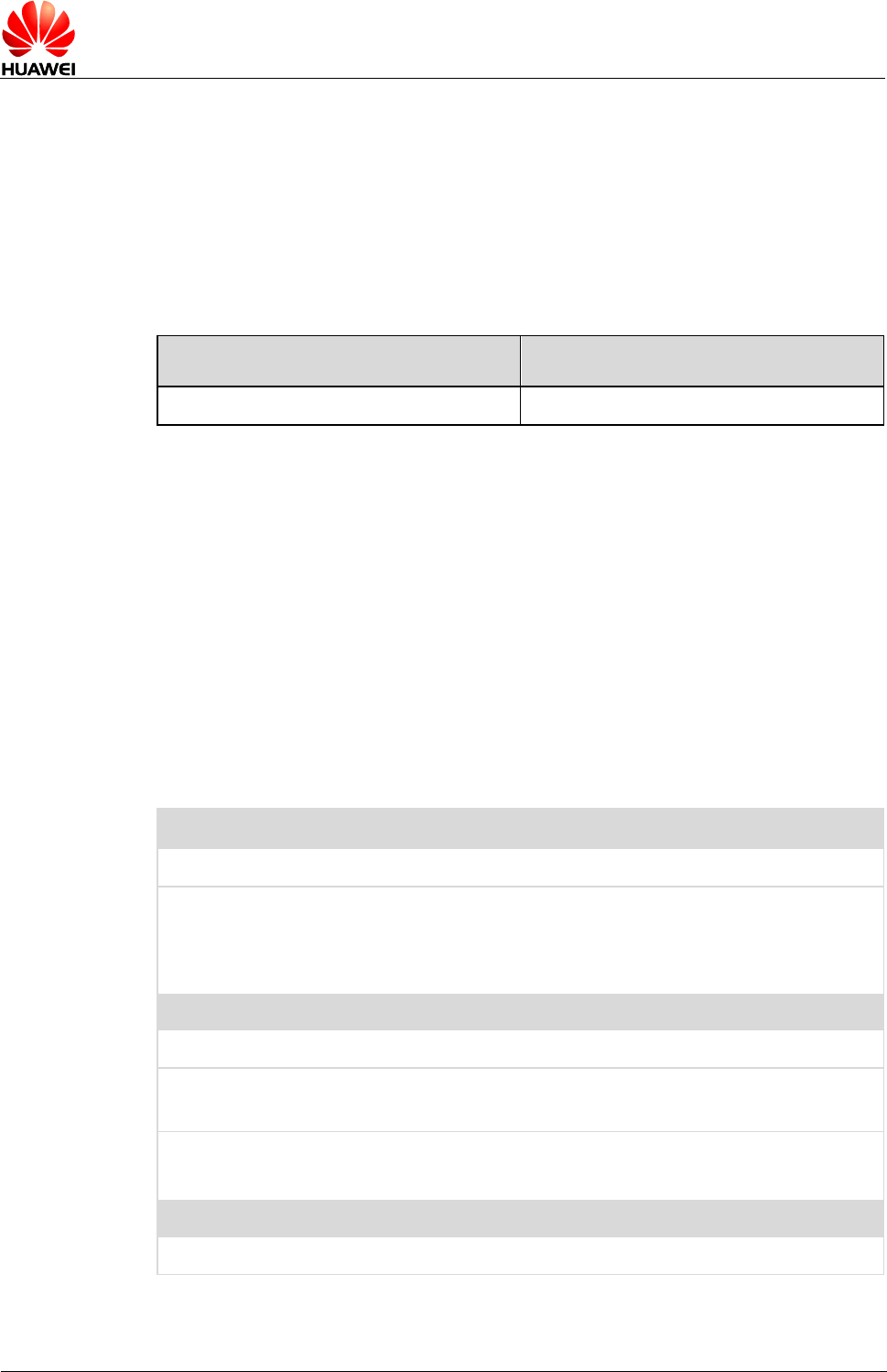
HUAWEI MU736 HSPA+ M.2 Module
AT Command Interface Specification
Huawei Proprietary Interface:
BodySAR Interface
Issue 02 (2013-12-24)
HUAWEI Proprietary and Confidential
Copyright © HUAWEI Technologies Co., Ltd.
146
14.1.3 Parameter Description
<on>:
0
Disable BodySAR. (default value)
1
Enable BodySAR.
14.1.4 Property Description
Saving upon Power-off
PIN
N
N
14.1.5 Example
Run:
AT^BODYSARON=1
Response:
OK
14.2 AT^BODYSARWCDMA–Set the Max Tx Power Limit
of WCDMA
14.2.1 Command Syntax
AT^BODYSARWCDMA=<power>[,<band>[,<power>,<band>]…]
Possible Response(s)
<CR><LF>OK<CR><LF>
In case of an MT-related error:
<CR><LF>ERROR<CR><LF>
AT^BODYSARWCDMA?
Possible Response(s)
<CR><LF>^BODYSARWCDMA: list of
(<power>,<band>)s<CR><LF><CR><LF>OK<CR><LF>
In case of an MT-related error:
<CR><LF>ERROR<CR><LF>
AT^BODYSARWCDMA=?
Possible Response(s)

HUAWEI MU736 HSPA+ M.2 Module
AT Command Interface Specification
Huawei Proprietary Interface:
BodySAR Interface
Issue 02 (2013-12-24)
HUAWEI Proprietary and Confidential
Copyright © HUAWEI Technologies Co., Ltd.
147
<CR><LF>^BODYSARWCDMA:
(12-24),<band><CR><LF><CR><LF>OK<CR><LF>
14.2.2 Interface Description
The set command sets the maximum Tx power limit of WCDMA for each band. Set the
maximum Tx power limit of WCDMA for selected band according to the value of band
bit field, and you can send this command for several times and set the different power
limit when the values of bands are set differently.
The read command queries the maximum Tx power limit of WCDMA for each band. If
the parameter values are not set, the default values are displayed after the query.
The test command checks the band range supported by WCDMA and the parameter
values supported by the maximum Tx power limit for each band.
14.2.3 Parameter Description
<power>: the maximum Tx power limit, integers ranging from 12 to 24 in dBm.
<band>: band bit field, 32-bit digit with hexadecimal. A binary bit indicates a
frequency band. The value of binary bit is shown in the following table (or parameter
superimposed values except 3FFFFFFF).
Parameters
Band
00000001
WCDMA_I_IMT_2100
00000002
WCDMA_II_PCS_1900
00000004
WCDMA_III_1700
00000008
WCDMA_IV_1700
00000010
WCDMA_V_850
00000020
WCDMA_VI_800
00000040
WCDMA_VII_2600
00000080
WCDMA_VIII_900
00000100
WCDMA_IX_1700
3FFFFFFF
All supported bands
[,<band>[,<power>,<band>]…]: indicates that select all supported bands when all
parameters are default. The parameter can set several groups (less or equal to eight
groups) of power at one time. One <power> is set according to <band> in the same
group.

HUAWEI MU736 HSPA+ M.2 Module
AT Command Interface Specification
Huawei Proprietary Interface:
BodySAR Interface
Issue 02 (2013-12-24)
HUAWEI Proprietary and Confidential
Copyright © HUAWEI Technologies Co., Ltd.
148
14.2.4 Property Description
Saving upon Power-off
PIN
Y
N
14.2.5 Example
Run:
AT^BODYSARWCDMA=?
Response:
^BODYSARWCDMA: (12-24),0000009B
OK
Indicate that the
firmware supports
WCDMA Band I, Band
II, Band IV, Band V and
Band VIII; the power is
from 12 to 24.
Run:
AT^BODYSARWCDMA=20,00000001,18,0
000000a
Indicate that set the
maximum WCDMA I Tx
power limit to 20 and
the maximum WCDMA
II and WCDMA IV Tx
power limit to 18.
Response:
OK
Run:
AT^BODYSARWCDMA?
Response:
^BODYSARWCDMA: (20,00000001),
(18,0000000a)
OK
Indicate that the
current maximum
WCDMA I Tx power
limit is set to 20 and the
maximum WCDMA II
and WCDMA IV Tx
power limit is set to 18.
14.3 AT^BODYSARGSM–Set the Maximum Tx Power
Limit of GSM
14.3.1 Command Syntax
AT^BODYSARGSM=<power>[,<band>[,<power>,<band>]…]
Possible Response(s)
<CR><LF>OK<CR><LF>

HUAWEI MU736 HSPA+ M.2 Module
AT Command Interface Specification
Huawei Proprietary Interface:
BodySAR Interface
Issue 02 (2013-12-24)
HUAWEI Proprietary and Confidential
Copyright © HUAWEI Technologies Co., Ltd.
149
In case of an MT-related error:
<CR><LF>ERROR<CR><LF>
AT^BODYSARGSM?
Possible Response(s)
<CR><LF>^BODYSARGSM: list of
(<power>,<band>)s<CR><LF><CR><LF>OK<CR><LF>
In case of an MT-related error:
<CR><LF>ERROR<CR><LF>
AT^BODYSARGSM=?
Possible Response(s)
<CR><LF>^BODYSARGSM:
(15-33),<band><CR><LF><CR><LF>OK<CR><LF>
14.3.2 Interface Description
The set command sets the maximum Tx power limit of GSM GPRS and EGPRS for
each band single time-slot. Set the maximum Tx power limit of GSM for selected band
according to the value of band bit field, and AP can send this command for several
times and set the different power limit when the values of bands are set differently.
The read command queries the maximum Tx power limit of GSM for each band. If the
parameter values are not set, the default values are displayed after the query.
The test command checks the band range supported by GSM and the parameter
values supported by the maximum Tx power limit for each band.
Note:
The AT^BODYSARGSM command sets the maximum Tx power limit of GSM, GPRS and EGPRS
for each band in single time-slot. When the module changes into multi-slot configuration, the
maximum Tx power limit of each time-slot will be reduced. The power reduction in multi-slot
configuration is as follow.
Number of timeslots in uplink
assignment
Reduction of maximum Tx power (dB)
1
0
2
3
3
5
4
6
5
7
6
8
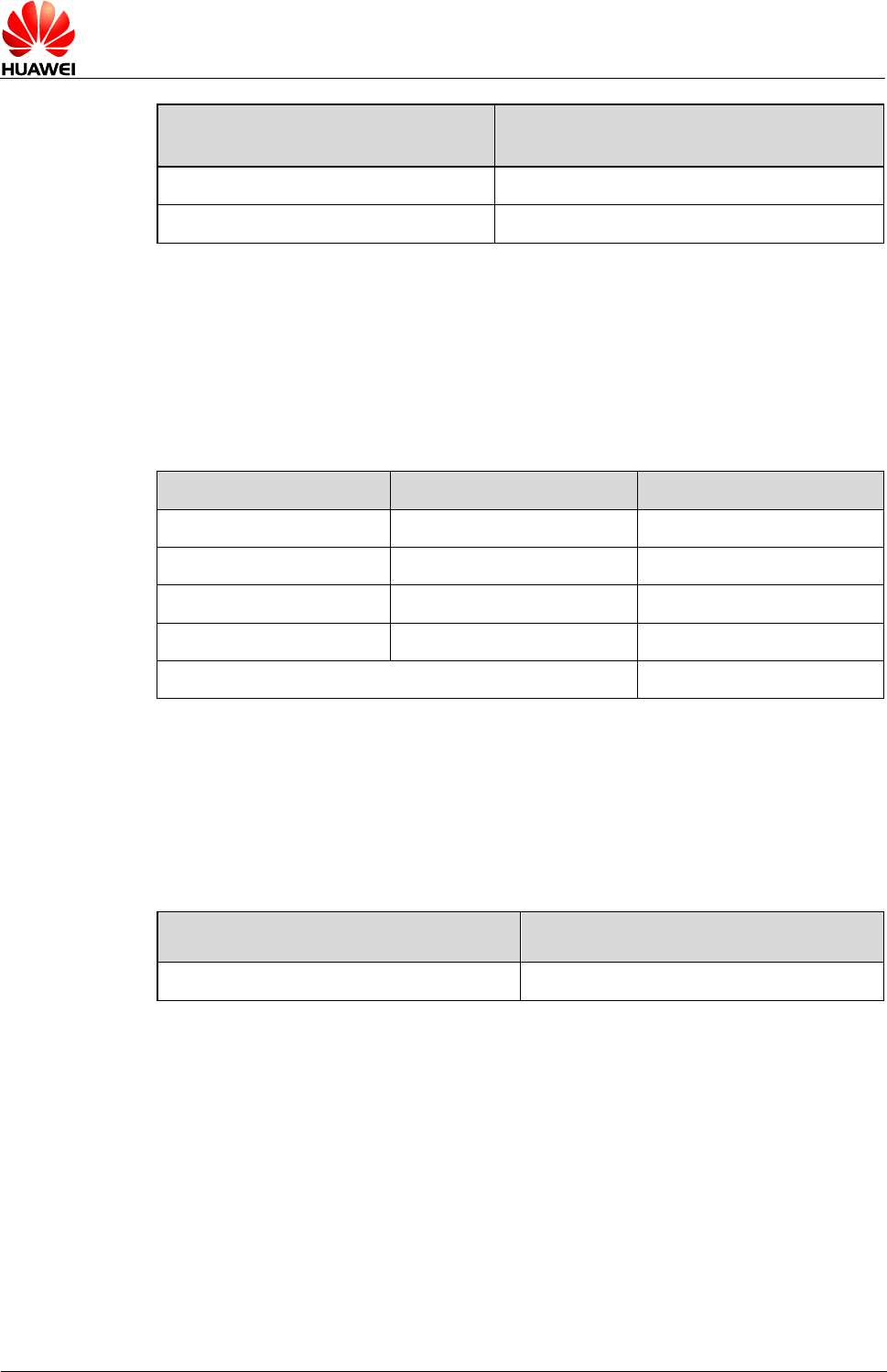
HUAWEI MU736 HSPA+ M.2 Module
AT Command Interface Specification
Huawei Proprietary Interface:
BodySAR Interface
Issue 02 (2013-12-24)
HUAWEI Proprietary and Confidential
Copyright © HUAWEI Technologies Co., Ltd.
150
Number of timeslots in uplink
assignment
Reduction of maximum Tx power (dB)
7
8.5
8
9
14.3.3 Parameter Description
<power>: the maximum Tx power limit. Integer ranging from 15 to 33 in dBm.
<band>: band bit field, 32-bit digit with hexadecimal. A binary bit indicates a
frequency band. The value of binary bit is shown in the following table (or parameter
superimposed values except 3FFFFFFF).
Parameters(GPRS)
Parameters(EGPRS)
Band
00000001
00010000
GSM850
00000002
00020000
GSM900
00000004
00040000
GSM1800
00000008
00080000
GSM1900
3FFFFFFF
All supported bands
[,<band>[,<power>,<band>]…]: indicates that select all supported bands when all
parameters are default. The parameter can set several groups (less or equal to eight
groups) of power at one time. One <power> is set according to <band> in the same
group.
14.3.4 Property Description
Saving upon Power-off
PIN
Y
N
14.3.5 Example
Run:
AT^BODYSARGSM=?
Response:
^BODYSARGSM: (15-33),
000F000F
OK
Indicate that the firmware
supports GSM850, GSM900,
GSM1800 and GSM1900; the
power is from 15 to 33.

HUAWEI MU736 HSPA+ M.2 Module
AT Command Interface Specification
Huawei Proprietary Interface:
BodySAR Interface
Issue 02 (2013-12-24)
HUAWEI Proprietary and Confidential
Copyright © HUAWEI Technologies Co., Ltd.
151
Run:
AT^BODYSARGSM=20
Indicate that set the
maximum Tx power limit for
the band supported by
firmware to 20.
Response:
OK
Run:
AT^BODYSARGSM?
Response:
^BODYSARGSM: (20,3FFFFFFF)
OK
Indicate that the maximum Tx
power limit for the band
supported by firmware is set
to 20.
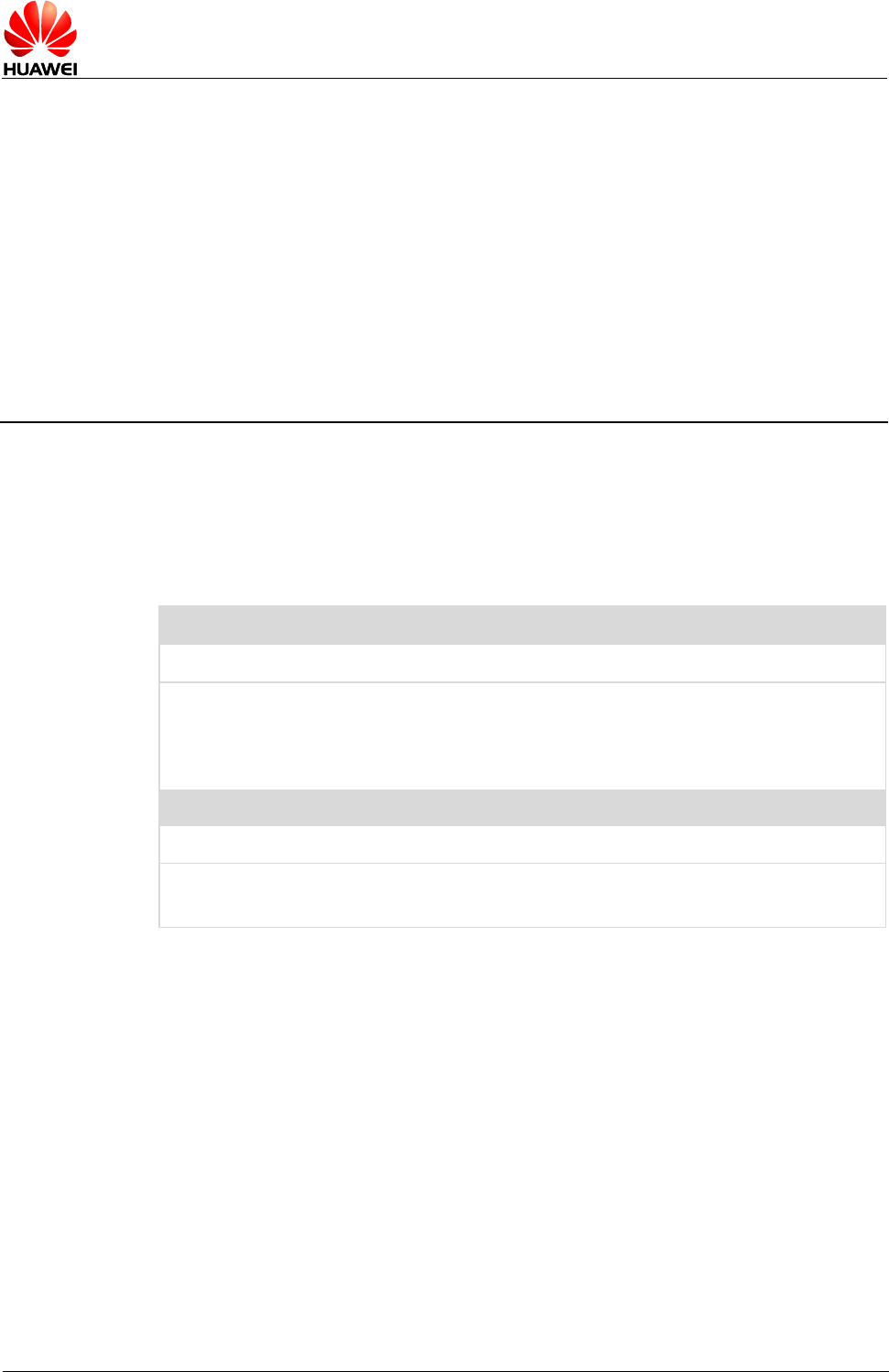
HUAWEI MU736 HSPA+ M.2 Module
AT Command Interface Specification
Huawei Proprietary Interface: IPv6
Interface
Issue 02 (2013-12-24)
HUAWEI Proprietary and Confidential
Copyright © HUAWEI Technologies Co., Ltd.
152
15 Huawei Proprietary Interface: IPv6
Interface
15.1 AT^IPV6CAP–Query IPv6 Capability
15.1.1 Command Syntax
AT^IPV6CAP?
Possible Response(s)
<CR><LF>^IPV6CAP: <cfg_value><CR><LF><CR><LF>OK<CR><LF>
In case of an MT-related error:
<CR><LF>ERROR<CR><LF>
AT^IPV6CAP=?
Possible Response(s)
<CR><LF>^IPV6CAP: (list of supported
<cfg_value>)<CR><LF><CR><LF>OK<CR><LF>
15.1.2 Interface Description
This interface can query the IPv6 capability of the MT.
The read command queries the current IPv6 capability of the MT.
The test command returns all supported IPv6 capability of the MT.
15.1.3 Parameter Description
<cfg_value>: configured value of the IPv6 capability.
0x01
IPv4 only
0x02
IPv6 only

HUAWEI MU736 HSPA+ M.2 Module
AT Command Interface Specification
Huawei Proprietary Interface: IPv6
Interface
Issue 02 (2013-12-24)
HUAWEI Proprietary and Confidential
Copyright © HUAWEI Technologies Co., Ltd.
153
0x07
IPv4 only + IPv6 only + IPv4v6 (use the same APN)
Other values
Reserved
15.1.4 Property Description
Saving upon Power-off
PIN
NA
N
15.1.5 Example
- Example 1:
Run:
AT^IPV6CAP?
MT supports IPv4 only.
Response:
^IPV6CAP: 1
OK
- Example 2:
Run:
AT^IPV6CAP?
MT supports IPv6 only.
Response:
^IPV6CAP: 2
OK
- Example 3:
Run:
AT^IPV6CAP?
MT supports IPv4, IPv6, and IPv4v6.
Response:
^IPV6CAP: 7
OK
- Example 4:
Run:
AT^IPV6CAP=?
Query the supported IPv6 capability
of the MT.
Response:
^IPV6CAP:(1,2,7)
OK

HUAWEI MU736 HSPA+ M.2 Module
AT Command Interface Specification
Huawei Proprietary Interface: Tunable
Antenna Interface
Issue 02 (2013-12-24)
HUAWEI Proprietary and Confidential
Copyright © HUAWEI Technologies Co., Ltd.
154
16 Huawei Proprietary Interface: Tunable
Antenna Interface
16.1 AT^ANTENCFG–Set Tunable Antenna
16.1.1 Command Syntax
AT^ANTENCFG=<mode>,<pattern>[,<band>[,<pattern>,<band>[…]]]
Possible Response(s)
<CR><LF>OK<CR><LF>
AT^ANTENCFG?
Possible Response(s)
<CR><LF>^ANTENCFG: <CR><LF><mode>:
<pattern>,<band>[,<pattern>,<band>[...]][[<CR><LF><mode>:
<pattern>,<band>[,<pattern>,<band>[...]]][…]]<CR><LF><CR><LF>OK<C
R><LF>
AT^ANTENCFG=?
Possible Response(s)
<CR><LF>^ANTENCFG: (list of supported <mode>s),(list of supported
<pattern>s),(list of supported <band>s)<CR><LF><CR><LF>OK<CR><LF>
16.1.2 Interface Description
The set command sets the antenna tuner configuration for each band of every mode.
The read command queries the antenna tuner configuration of each band of all
modes.
The test command queries the parameter values supported by the command.
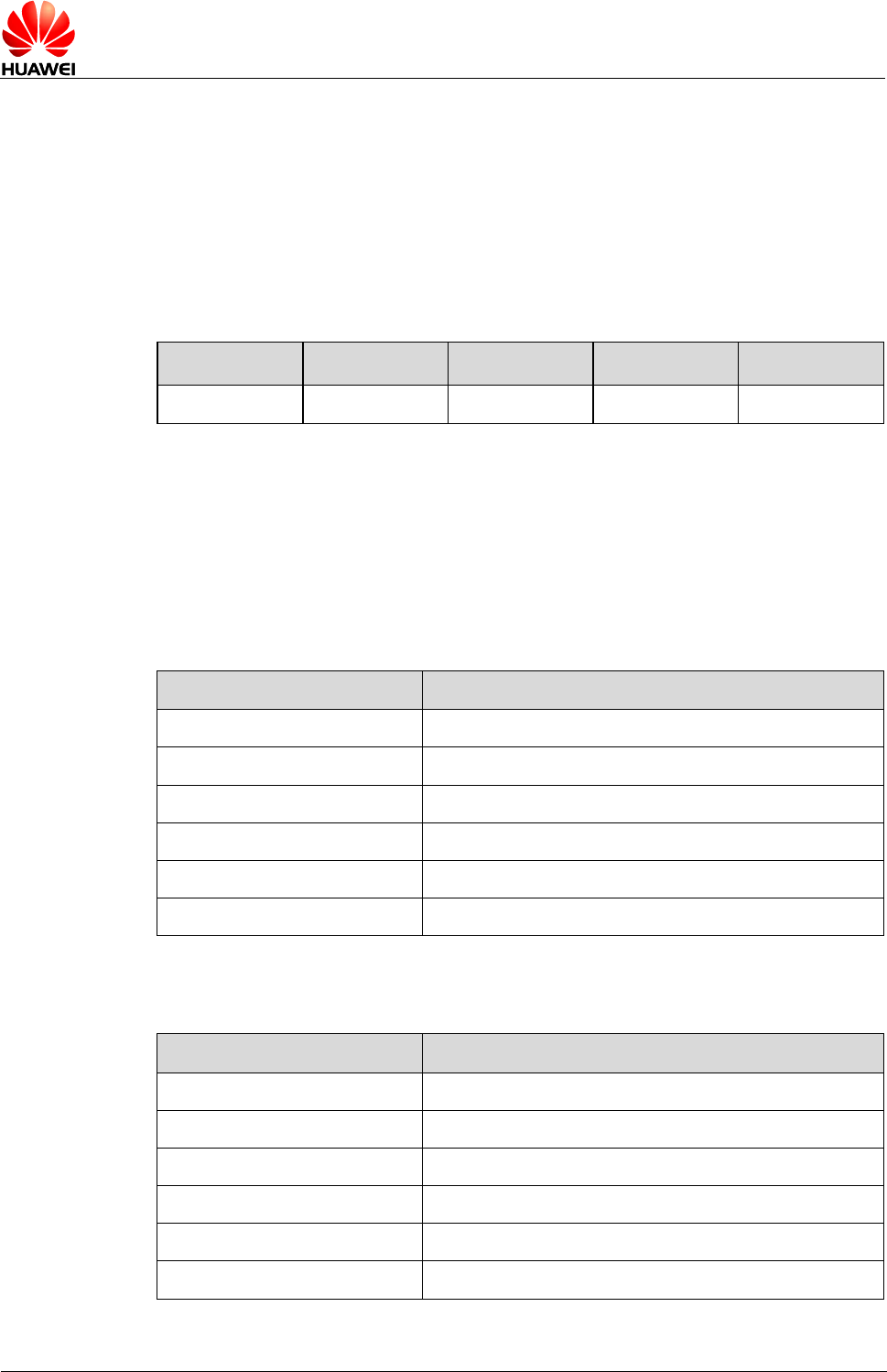
HUAWEI MU736 HSPA+ M.2 Module
AT Command Interface Specification
Huawei Proprietary Interface: Tunable
Antenna Interface
Issue 02 (2013-12-24)
HUAWEI Proprietary and Confidential
Copyright © HUAWEI Technologies Co., Ltd.
155
16.1.3 Parameter Description
<mode>: the mode of network.
0
GSM
1
WCDMA
<pattern>: the configuration of antenna tuner. Pattern bit field, 8-bit digit with
hexadecimal. A binary bit indicates a ANTCTL pin.
Bit[4-7]
Bit[3]
Bit[2]
Bit[1]
Bit[0]
reserved
ANTCTL3
ANTCTL2
ANTCTL1
ANTCTL0
0
Low Level
1
High Level
<band>: band bit field, 64-bit digit with hexadecimal. A binary bit indicates a
frequency band. The value of binary bit is shown in the following table
Table 16-1 The value of <band> when <mode>=0
Parameters
Band
0000000000000001
GSM850
0000000000000002
GSM900
0000000000000004
GSM1800
0000000000000008
GSM1900
…
…
FFFFFFFFFFFFFFFF
All supported bands
Table 16-2 The value of <band> when <mode>=1
Parameters
Band
0000000000000001
WCDMA_I_IMT_2100
0000000000000002
WCDMA_II_PCS_1900
0000000000000004
WCDMA_III_1700
0000000000000008
WCDMA_IV_1700
0000000000000010
WCDMA_V_850
0000000000000020
WCDMA_VI_800
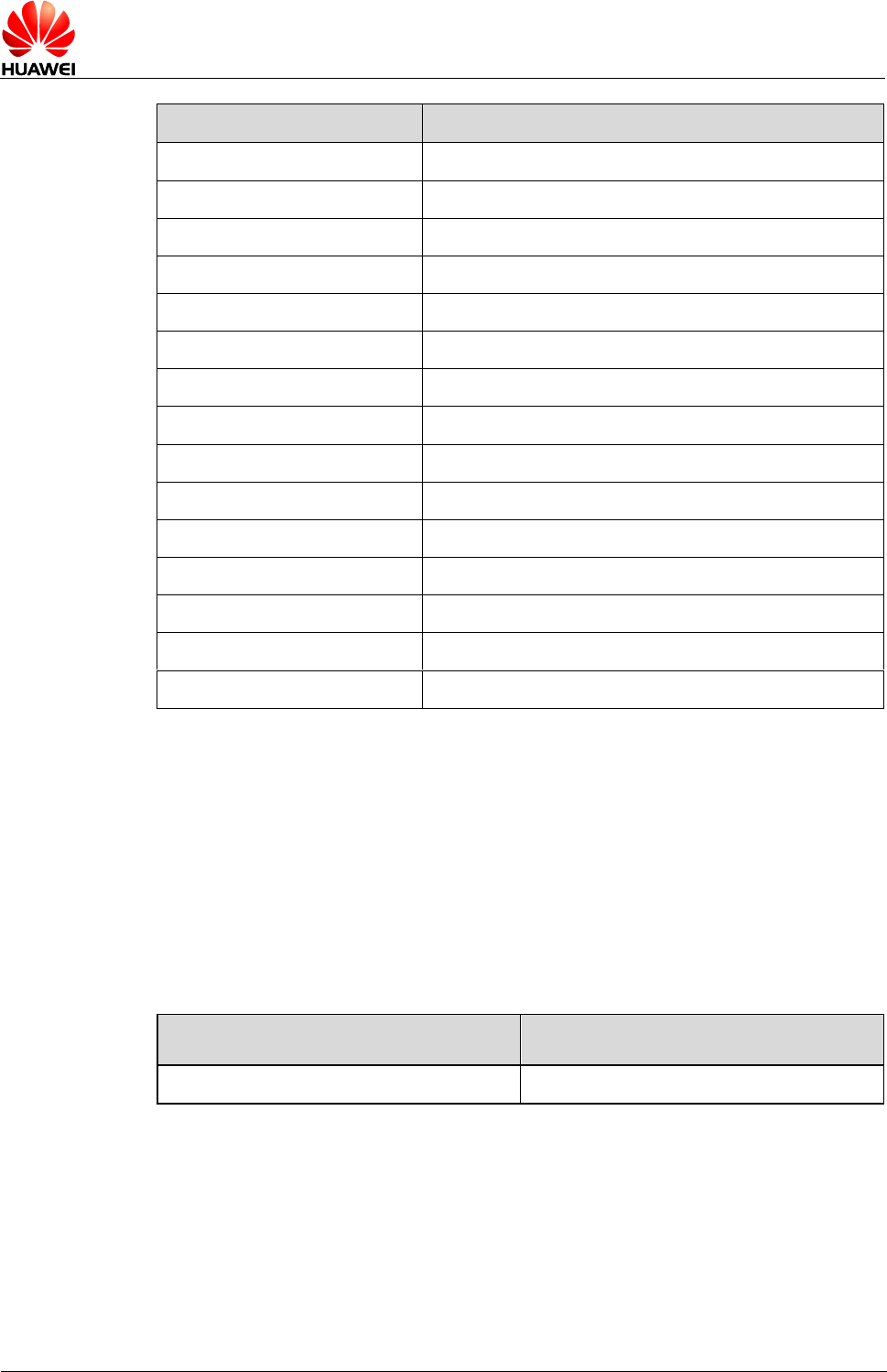
HUAWEI MU736 HSPA+ M.2 Module
AT Command Interface Specification
Huawei Proprietary Interface: Tunable
Antenna Interface
Issue 02 (2013-12-24)
HUAWEI Proprietary and Confidential
Copyright © HUAWEI Technologies Co., Ltd.
156
Parameters
Band
0000000000000040
WCDMA_VII_2600
0000000000000080
WCDMA_VIII_900
0000000000000100
WCDMA_IX_1700
0000000000000200
WCDMA_X
0000000000000400
WCDMA_XI
0000000000000800
WCDMA_XII
0000000000001000
WCDMA_XIII
0000000000002000
WCDMA_XIV
0000000000004000
WCDMA_XV
0000000000008000
WCDMA_XVI
0000000000010000
WCDMA_XVII
0000000000020000
WCDMA_XVIII
0000000000040000
WCDMA_XIX
…
…
FFFFFFFFFFFFFFFF
All supported bands
[,<band>[,<pattern>,<band>]…]: indicates that select all supported bands when
all parameters are default. One <pattern> is set according to <band> in the same
group.
Note:
On the MU736 module, the parameter can set several groups (less or equal to nine groups) of
pattern at one time.
16.1.4 Property Description
Saving upon Power-off
PIN
Y
N
16.1.5 Example
Run:
AT^ANTENCFG=?

HUAWEI MU736 HSPA+ M.2 Module
AT Command Interface Specification
Huawei Proprietary Interface: Tunable
Antenna Interface
Issue 02 (2013-12-24)
HUAWEI Proprietary and Confidential
Copyright © HUAWEI Technologies Co., Ltd.
157
Response:
^ANTENCFG: (0-1),(0-15),(000000
000000000F,0000000000000009B)
OK
Indicate that the
module supports GSM
and WCDMA. The
pattern is from 0 to
15.The module
supports GSM 4 bands
and WCDMA
BC1,2,4,5,8.
Run:
AT^ANTENCFG=0,1,2
Set the antenna tuner
configuration of
GSM900 to be 1.
Response:
OK
Run:
AT^ANTENCFG?
Response:
^ANTENCFG:
0: 0,000000000000000D,1,000000000
0000002
1: 0,000000000000009B
OK
Indicate that the
current configuration of
GSM900 is 1,other all
support bands are 0.

HUAWEI MU736 HSPA+ M.2 Module
AT Command Interface Specification
Huawei Proprietary Interface: Main
And AUX Switch Interface
Issue 02 (2013-12-24)
HUAWEI Proprietary and Confidential
Copyright © HUAWEI Technologies Co., Ltd.
158
17 Huawei Proprietary Interface: Main
And AUX Switch Interface
17.1 AT^ANTMODE–Set Operation Mode of Main and
AUX Antennas
17.1.1 Command Syntax
AT^ANTMODE=<ant_mode>[,<nw_mode>]
Possible Response(s)
<CR><LF>OK<CR><LF>
In case of an MT-related error:
<CR><LF>ERROR<CR><LF>
AT^ANTMODE?
Possible Response(s)
<CR><LF>^ANTMODE: <ant_mode>,<nw_mode><CR><LF>[^ANTMODE:
<ant_mode>,<nw_mode><CR><LF>][...]<CR><LF>OK<CR><LF>
In case of an MT-related error:
<CR><LF>ERROR<CR><LF>
AT^ANTMODE=?
Possible Response(s)
<CR><LF>^ANTMODE: (list of <ant_mode>s),(list of
<nw_mode>s)<CR><LF><CR><LF>OK<CR><LF>
In case of an MT-related error:
<CR><LF>ERROR<CR><LF>

HUAWEI MU736 HSPA+ M.2 Module
AT Command Interface Specification
Huawei Proprietary Interface: Main
And AUX Switch Interface
Issue 02 (2013-12-24)
HUAWEI Proprietary and Confidential
Copyright © HUAWEI Technologies Co., Ltd.
159
17.1.2 Interface Description
The set command sets the operation mode of main and AUX antennas on different
networks. The module will be reset after running the command and returning OK.
The read command queries the current operation mode of main and AUX antennas on
different networks.
The test command returns the list of operation modes of main and AUX antennas
supported by the module.
17.1.3 Parameter Description
<ant_mode>: the operation mode of main and AUX antennas.
0
The main and AUX antennas are all enabled. (default value)
1
The main antennas is enabled.
2
The AUX antennas is enabled.
<nw_mode>: the network. If the parameter is not specified, it equals to <nw_mode>=0.
0
All networks
2
WCDMA (default value)
17.1.4 Property Description
Saving upon Power-off
PIN
N
N
17.1.5 Example
Run:
AT^ANTMODE?
Query the current operation
mode of the main and AUX
antenna.
Response:
^ANTMODE: 0,2
OK
The response indicates that
the main and AUX antennas
are all enabled on the
WCDMA network
Run:
AT^ANTMODE=?
Query the list of operation
modes of main and AUX
antennas supported by the
module.
Response:
^ANTMODE: (0,1,2),(0,2)
OK

HUAWEI MU736 HSPA+ M.2 Module
AT Command Interface Specification
Huawei Proprietary Interface: Main
And AUX Switch Interface
Issue 02 (2013-12-24)
HUAWEI Proprietary and Confidential
Copyright © HUAWEI Technologies Co., Ltd.
160
Run:
AT^ANTMODE=0
Set the main and AUX
antennas to be all enabled
on all networks.
Response:
OK
Run:
AT^ANTMODE=1,2
Set the main antennas to be
enabled on the WCDMA
network.
Response:
OK
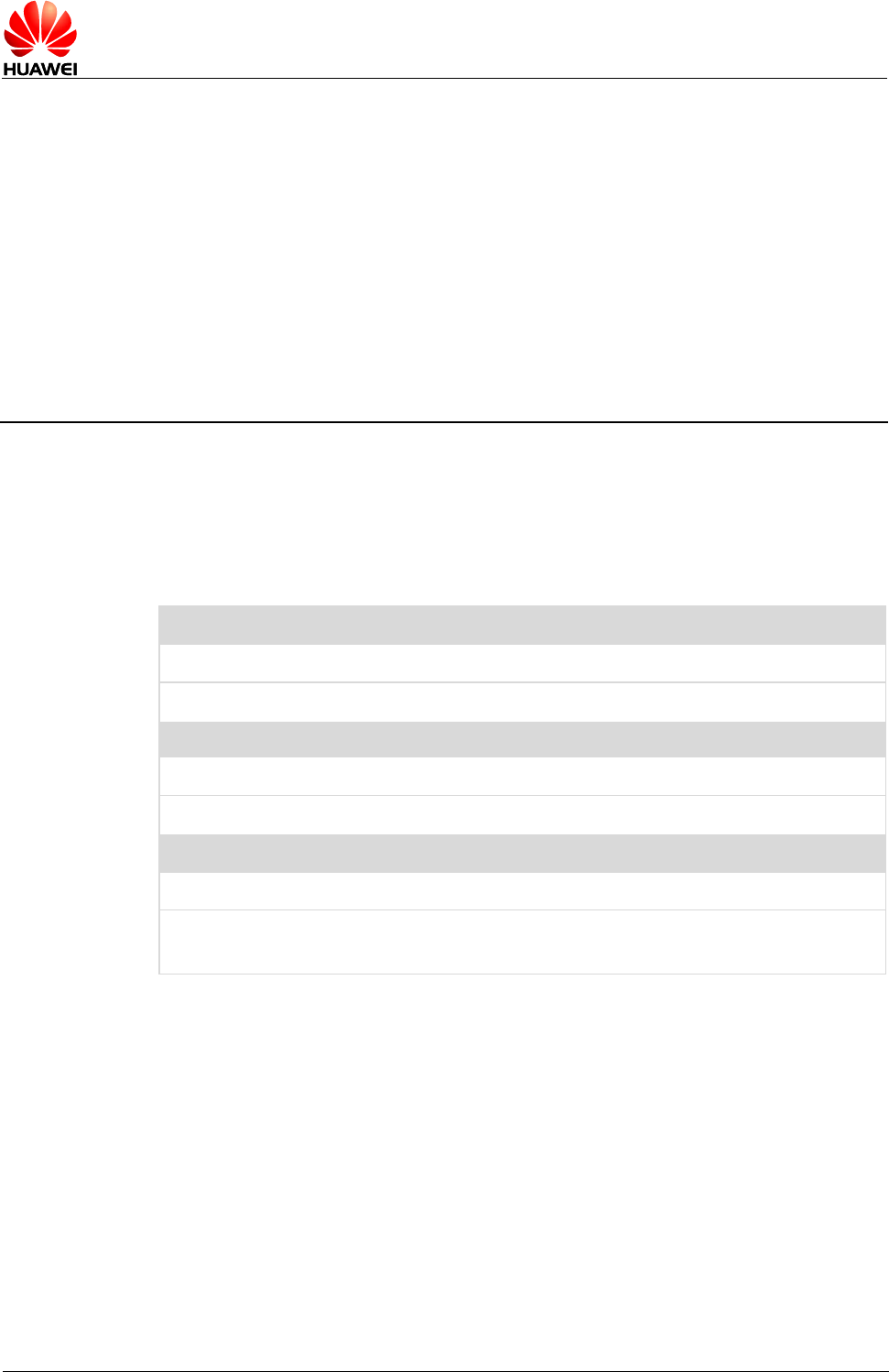
HUAWEI MU736 HSPA+ M.2 Module
AT Command Interface Specification
Huawei Proprietary Interface: GPS
Service Interfaces
Issue 02 (2013-12-24)
HUAWEI Proprietary and Confidential
Copyright © HUAWEI Technologies Co., Ltd.
161
18 Huawei Proprietary Interface: GPS
Service Interfaces
18.1 AT^WPDOM–Set Operation Mode
18.1.1 Command Syntax
AT^WPDOM=<mode>
Possible Response(s)
<CR><LF>OK<CR><LF>
AT^WPDOM?
Possible Response(s)
<CR><LF>^WPDOM: <mode><CR><LF><CR><LF>OK<CR><LF>
AT^WPDOM=?
Possible Response(s)
<CR><LF>^WPDOM: (list of supported
<mode>s)<CR><LF><CR><LF>OK<CR><LF>
18.1.2 Interface Description
This command is used to set operation mode in the positioning process.
The set command is available before or after the session is positioned. Parameters
cannot be modified during the positioning process. Otherwise, an error message is
returned.
The read command queries the current operation mode.
The test command returns the value range of the operation mode.
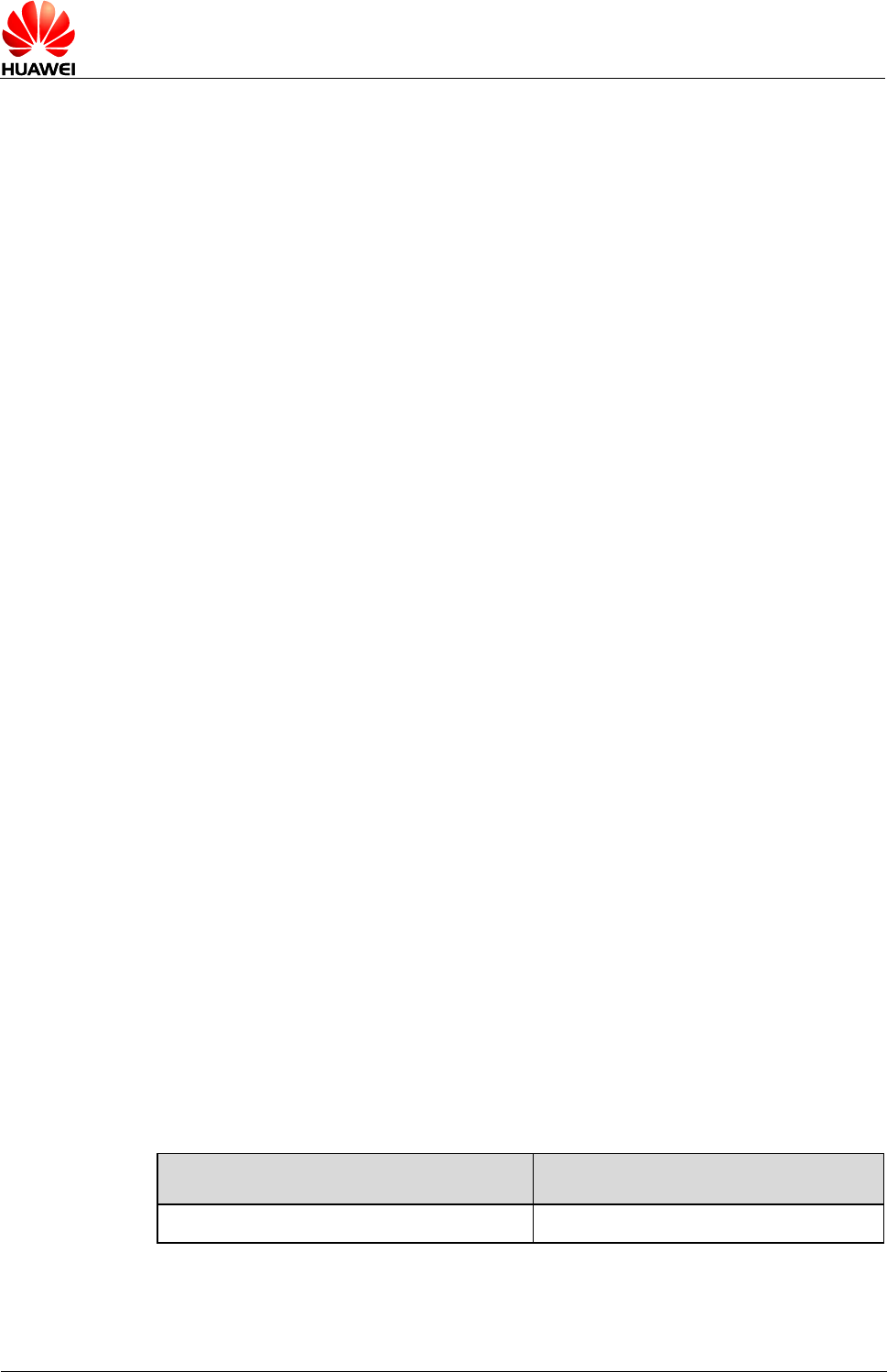
HUAWEI MU736 HSPA+ M.2 Module
AT Command Interface Specification
Huawei Proprietary Interface: GPS
Service Interfaces
Issue 02 (2013-12-24)
HUAWEI Proprietary and Confidential
Copyright © HUAWEI Technologies Co., Ltd.
162
18.1.3 Parameter Description
<mode>: operation mode.
0
Standalone only. In this mode, no network assistance is required, and
an MS can be in or not in the network coverage area. This mode can be
used to position the session without SIM cards.
1
Network only. The MS-assisted positioning mode, which is one of
Assisted Global Positioning Systems (A-GPSs), is used here. The MS
needs to communicate with PDE or PDM upon each positioning, and
the PDE or PDM calculates position information. In this operation
mode, the PDE or PDM needs to be accessed, and network coverage
is required.
2
Speed optimal. The positioning data with the optimal speed is obtained,
that is, the minimum TTF mode is used. The speed optimal mode is
only MS-based in UMTS. (not supported currently)
3
Accuracy optimal. The positioning data with the optimal accuracy is
obtained. The accuracy optimal mode is only MS-assisted in UMTS.
(not supported currently)
4
Data optimal. The MS uses the minimum PDE data interaction mode
with the network side. The data optimal mode is only standalone in
UMTS. (not supported currently)
5
MS-bases only. The network needs to provide positioning assistance
information, and the MS calculates the position information. When the
GPS fails in this mode, this mode is automatically switched to the
standalone mode for positioning. (default value)
6
gpsOneXTRA, which is the enhanced mode of standalone. Before the
GPS searches the satellite, the GPS downloads the ephemeris data
from the Internet. The orbit equation contained in the ephemeris data
can save the time during data demodulation. (not supported currently)
7
Low Accuracy MSA. The terminal originates an MSA positioning
session with extremely low positioning accuracy in bad weather. The
server side determines the positioning mode. Some positioning modes
are directly converted into cell ID for positioning. Some positioning
modes are converted to cell id after the MSA positioning session fails.
The other positioning modes are never converted into cell ID. (In this
operation mode, a specified QoS positioning session is originated, and
the user does not need to set the QoS parameters.) (not supported
currently)
18.1.4 Property Description
Saving upon Power-off
PIN
Y
N

HUAWEI MU736 HSPA+ M.2 Module
AT Command Interface Specification
Huawei Proprietary Interface: GPS
Service Interfaces
Issue 02 (2013-12-24)
HUAWEI Proprietary and Confidential
Copyright © HUAWEI Technologies Co., Ltd.
163
18.1.5 Example
- Query the current operation mode:
Run:
AT^WPDOM?
Response:
^WPDOM: 5
OK
- Set the operation mode:
Run:
AT^WPDOM=0
Response:
OK
Run:
AT^WPDOM=1
Response:
OK
Run:
AT^WPDOM=5
Response:
OK
18.2 AT^WPDST–Set Session Type
18.2.1 Command Syntax
AT^WPDST=<type>
Possible Response(s)
<CR><LF>OK<CR><LF>
AT^WPDST?
Possible Response(s)
<CR><LF>^WPDST: <type><CR><LF><CR><LF>OK<CR><LF>
AT^WPDST=?
Possible Response(s)
<CR><LF>^WPDST: (list of supported
<type>s)<CR><LF><CR><LF>OK<CR><LF>
18.2.2 Interface Description
This command is used to set the session type of the positioning operation.
The set command is available before or after the session is positioned. Parameters
cannot be modified in the positioning process. Otherwise, an error message is
returned.

HUAWEI MU736 HSPA+ M.2 Module
AT Command Interface Specification
Huawei Proprietary Interface: GPS
Service Interfaces
Issue 02 (2013-12-24)
HUAWEI Proprietary and Confidential
Copyright © HUAWEI Technologies Co., Ltd.
164
The read command queries the current session type.
The test command returns the value range of the session type.
18.2.3 Parameter Description
<type>: session type.
0
Provide a single positioning operation. (default value)
1
Provide tracing positioning. The positioning value is obtained using the
designated frequency. The positioning frequency is set by running
AT^WPDFR.
2
Provide the last positioning information, but does not execute the
satellite searching operation. (not supported currently)
18.2.4 Property Description
Saving upon Power-off
PIN
N
N
18.2.5 Example
- Query the value range of session type:
Run:
AT^WPDST=?
Response:
^WPDST: (0-1)
OK
- Query the current session type:
Run:
AT^WPDST?
Response:
^WPDST: 0
OK
- Set the session type:
Run:
AT^WPDST=0
Response:
OK
Run:
AT^WPDST=1
Response:
OK
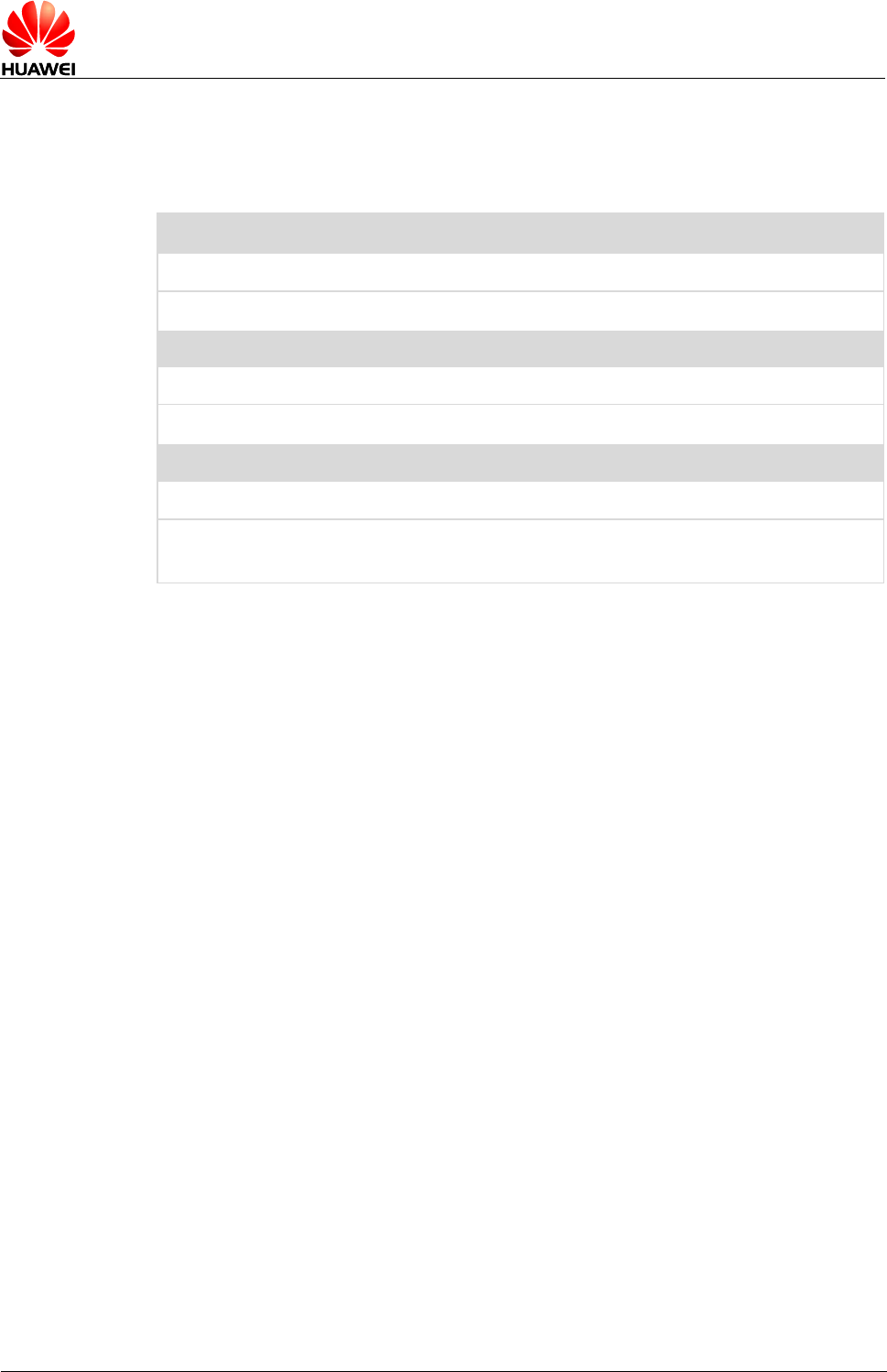
HUAWEI MU736 HSPA+ M.2 Module
AT Command Interface Specification
Huawei Proprietary Interface: GPS
Service Interfaces
Issue 02 (2013-12-24)
HUAWEI Proprietary and Confidential
Copyright © HUAWEI Technologies Co., Ltd.
165
18.3 AT^WPDFR–Set Positioning Frequency
18.3.1 Command Syntax
AT^WPDFR=<num>,<time>
Possible Response(s)
<CR><LF>OK<CR><LF>
AT^WPDFR?
Possible Response(s)
<CR><LF>^WPDFR: <num>,<time><CR><LF><CR><LF>OK<CR><LF>
AT^WPDFR=?
Possible Response(s)
<CR><LF>^WPDFR: (list of supported <num>s),(list of supported
<time>s)<CR><LF><CR><LF>OK<CR><LF>
18.3.2 Interface Description
This command is used to set the positioning frequency in the tracing positioning
session.
The set command is available before or after the session is positioned. Parameters
cannot be modified in the positioning process. Otherwise, an error message is
returned.
The read command queries the current positioning frequency.
The test command returns the value range of the positioning frequency.
Note:
This command can be used to set the positioning frequency only after the session type is set to
tracing positioning by AT^WPDST.
18.3.3 Parameter Description
<num>: number of positioning operations triggered by the designated MS. The value
ranges from 0 to 65535, and the default value is 65535. (It is not work currently.)
<time>: valid positioning time interval. This parameter can be set only when the
positioning number triggered by the designated MS is greater than 1. The valid
positioning time interval of this parameter ranges from 1s to 1800s, and the default
time interval is 1s. (It is NMEA sentence reporting time interval currently.)
On Linux system or systems like Linux, it is recommended to set <time> to be less
than the SS (Selective Suspend) time which is set by the system. This is to avoid the

HUAWEI MU736 HSPA+ M.2 Module
AT Command Interface Specification
Huawei Proprietary Interface: GPS
Service Interfaces
Issue 02 (2013-12-24)
HUAWEI Proprietary and Confidential
Copyright © HUAWEI Technologies Co., Ltd.
166
following situation that may happen: because the system comes into the SS state,
NEMA data cannot be reported to the host during the GPS position. About that how to
set the SS time on Linux system, please refer to Guide to Kernel Driver Integration in
Android for Huawei Modules V1.2.9 or later.
18.3.4 Property Description
Saving upon Power-off
PIN
N
N
18.3.5 Example
- Query the value range of positioning frequency:
Run:
AT^WPDFR=?
Response:
^WPDFR: (0-65535),(1-1800)
OK
- Query the current positioning frequency:
Run:
AT^WPDFR?
Response:
^WPDFR: 65535,1
OK
- Set the positioning frequency
Run:
AT^WPDST=1
Response:
OK
Run:
AT^WPDFR=20,2
Response:
OK
18.4 AT^WPURL–Set AGPS Server Address and Port
18.4.1 Command Syntax
AT^WPURL=<url>
Possible Response(s)
<CR><LF>OK<CR><LF>
AT^WPURL?
Possible Response(s)

HUAWEI MU736 HSPA+ M.2 Module
AT Command Interface Specification
Huawei Proprietary Interface: GPS
Service Interfaces
Issue 02 (2013-12-24)
HUAWEI Proprietary and Confidential
Copyright © HUAWEI Technologies Co., Ltd.
167
<CR><LF>^WPURL: <url><CR><LF><CR><LF>OK<CR><LF>
18.4.2 Interface Description
The set command sets the address of the AGPS server on the WCDMA network. The
set command is available before or after the session is positioned. Parameters cannot
be modified in the positioning process. Otherwise, an error message is returned.
The read command queries the address of the current AGPS server.
18.4.3 Parameter Description
<url>: address of the AGPS server in the WCDMA server. It is a URL address or an
IP address. (without quotation marks)
18.4.4 Property Description
Saving upon Power-off
PIN
Y
N
18.4.5 Example
Set the address of the AGPS server:
Run:
AT^WPURL=SUPL.GOOGLE.COM:7276
Response:
OK
18.5 AT^WPDIM–Delete Auxiliary Data
18.5.1 Command Syntax
AT^WPDIM=<mode>
Possible Response(s)
<CR><LF>OK<CR><LF>
AT^WPDIM=?
Possible Response(s)
<CR><LF>^WPDIM: (list of supported
<mode>s)<CR><LF><CR><LF>OK<CR><LF>
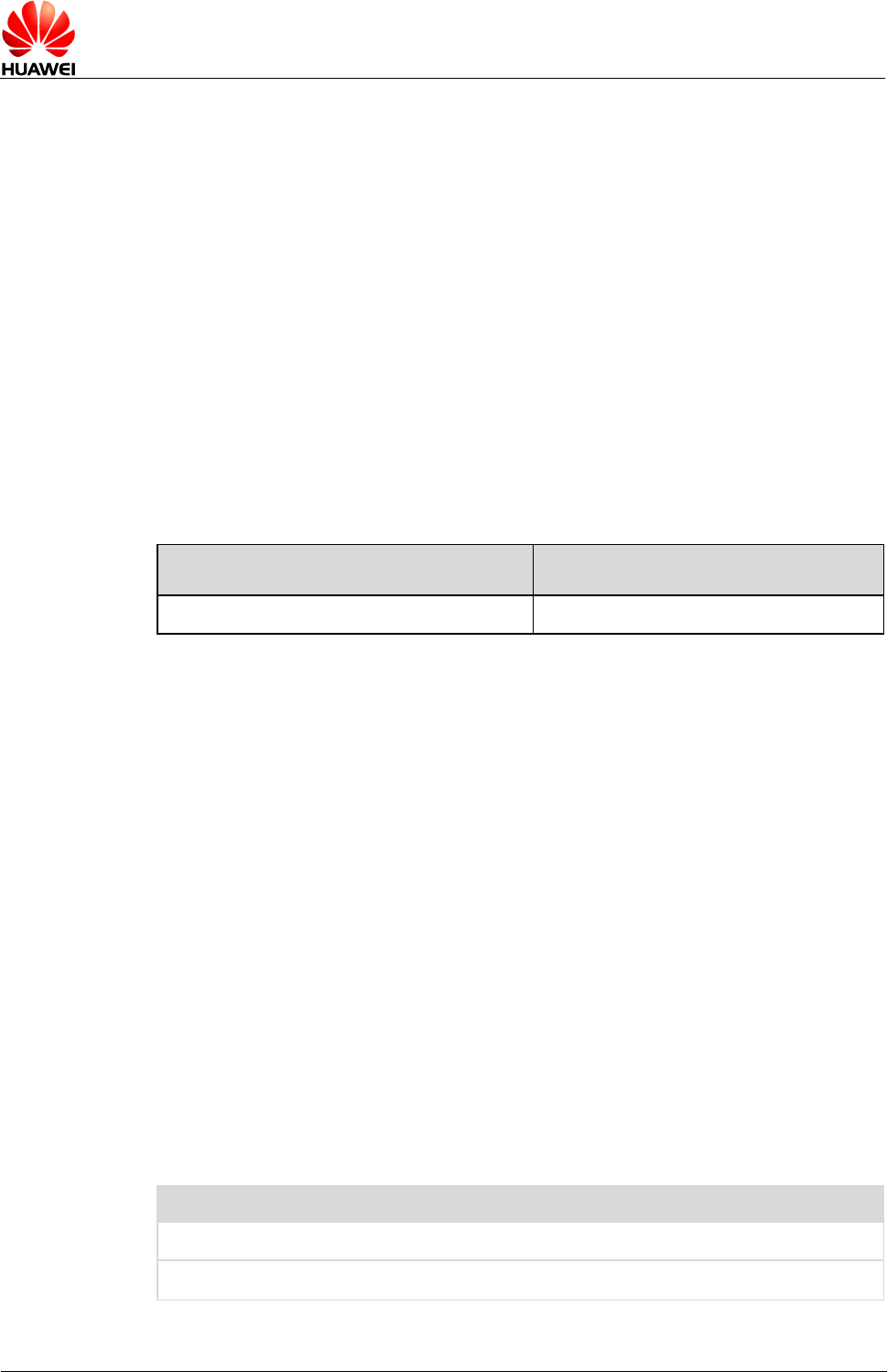
HUAWEI MU736 HSPA+ M.2 Module
AT Command Interface Specification
Huawei Proprietary Interface: GPS
Service Interfaces
Issue 02 (2013-12-24)
HUAWEI Proprietary and Confidential
Copyright © HUAWEI Technologies Co., Ltd.
168
18.5.2 Interface Description
The set command deletes the auxiliary positioning data inside a board. This command
is available after the MGP search engine is closed. The deletion operation cannot be
performed when the MGP search engine is open.
The test command returns the supported deletion type.
18.5.3 Parameter Description
<mode>: deletion type.
0
Cold start
1
Warm start
2
Hot start
18.5.4 Property Description
Saving upon Power-off
PIN
NA
N
18.5.5 Example
- Query the value range of delete auxiliary data mode:
Run:
AT^WPDIM=?
Response:
^WPDIM: (0-2)
OK
- Set the deletion mode:
Run:
AT^WPDIM=1
Response:
OK
18.6 AT^WPDGP–Start Positioning Session
18.6.1 Command Syntax
AT^WPDGP
Possible Response(s)
<CR><LF>OK<CR><LF>
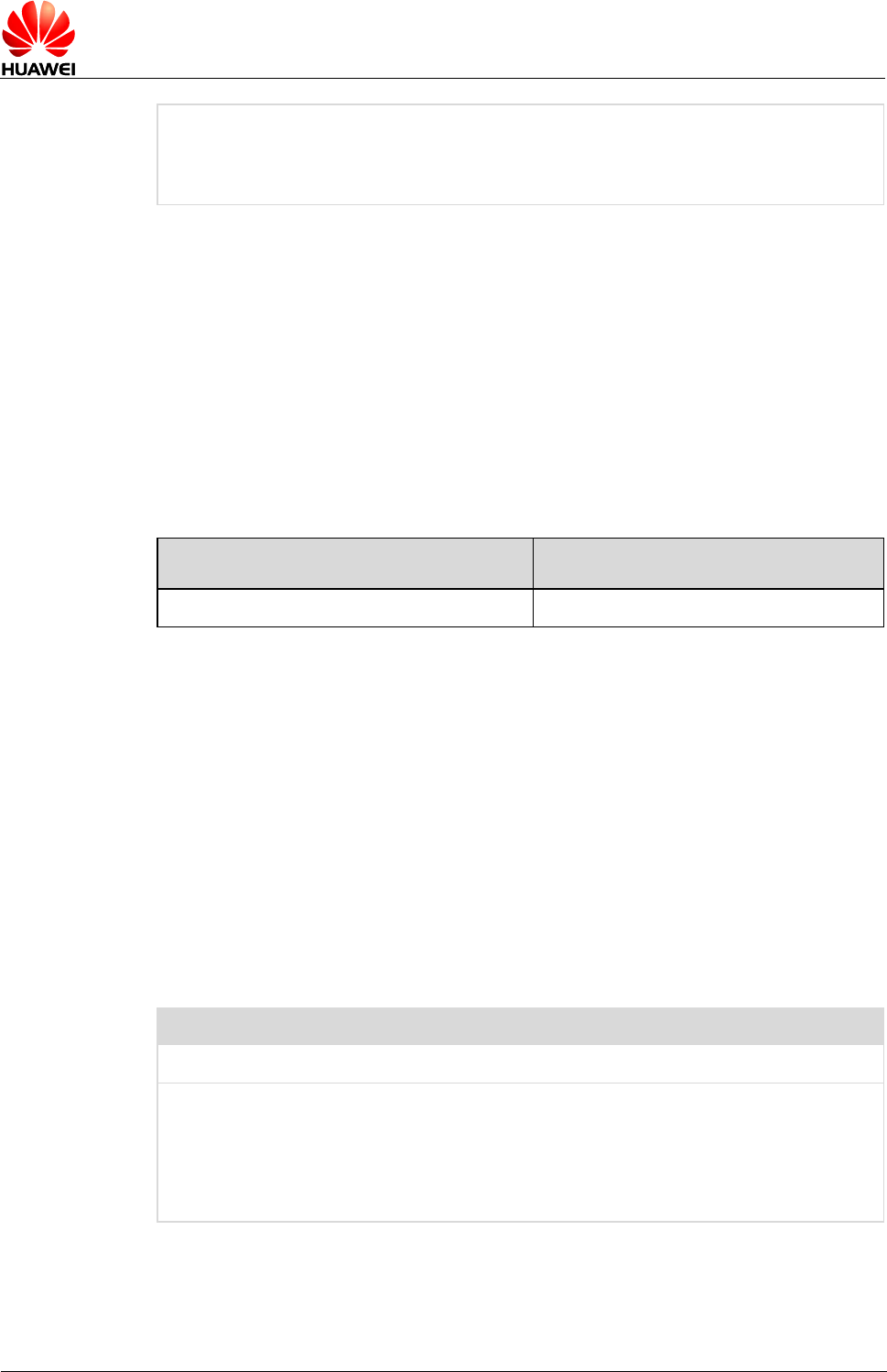
HUAWEI MU736 HSPA+ M.2 Module
AT Command Interface Specification
Huawei Proprietary Interface: GPS
Service Interfaces
Issue 02 (2013-12-24)
HUAWEI Proprietary and Confidential
Copyright © HUAWEI Technologies Co., Ltd.
169
In case of an error:
<CR><LF>ERROR<CR><LF> or
<CR><LF>+CME ERROR: <err><CR><LF>
18.6.2 Interface Description
This command enables the GPS function. Only one positioning operation is allowed
within the same period. When the GPS function is enabled, an error message is
returned if this command is run again.
18.6.3 Parameter Description
None
18.6.4 Property Description
Saving upon Power-off
PIN
NA
N
18.6.5 Example
Set PD session successfully:
Run:
AT^WPDGP
Response:
OK
18.7 AT^WPEND–Terminate Positioning Process
18.7.1 Command Syntax
AT^WPEND
Possible Response(s)
<CR><LF>OK<CR><LF>
In case of an error:
<CR><LF>ERROR<CR><LF> or
<CR><LF>+CME ERROR: <err><CR><LF>
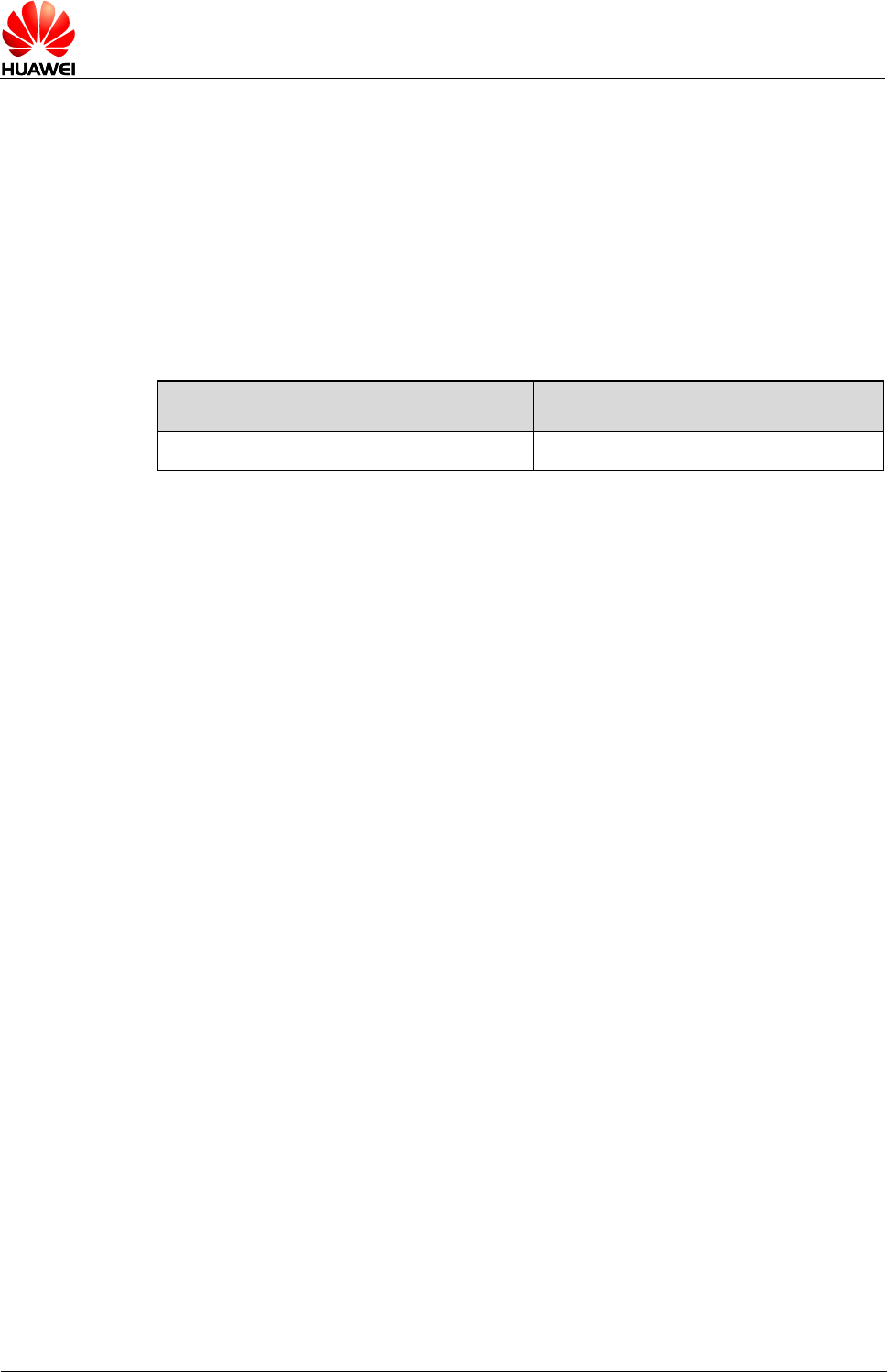
HUAWEI MU736 HSPA+ M.2 Module
AT Command Interface Specification
Huawei Proprietary Interface: GPS
Service Interfaces
Issue 02 (2013-12-24)
HUAWEI Proprietary and Confidential
Copyright © HUAWEI Technologies Co., Ltd.
170
18.7.2 Interface Description
This command ends the GPS session. When no positioning session is available or the
positioning session is in off status, an error message is returned if this command is
run.
18.7.3 Parameter Description
None
18.7.4 Property Description
Saving upon Power-off
PIN
NA
N
18.7.5 Example
- Terminate the PD session successfully:
Run:
AT^WPEND
Response:
OK
- PD Session is not going on. Terminate Failture:
Run:
AT^WPEND
Response:
ERROR
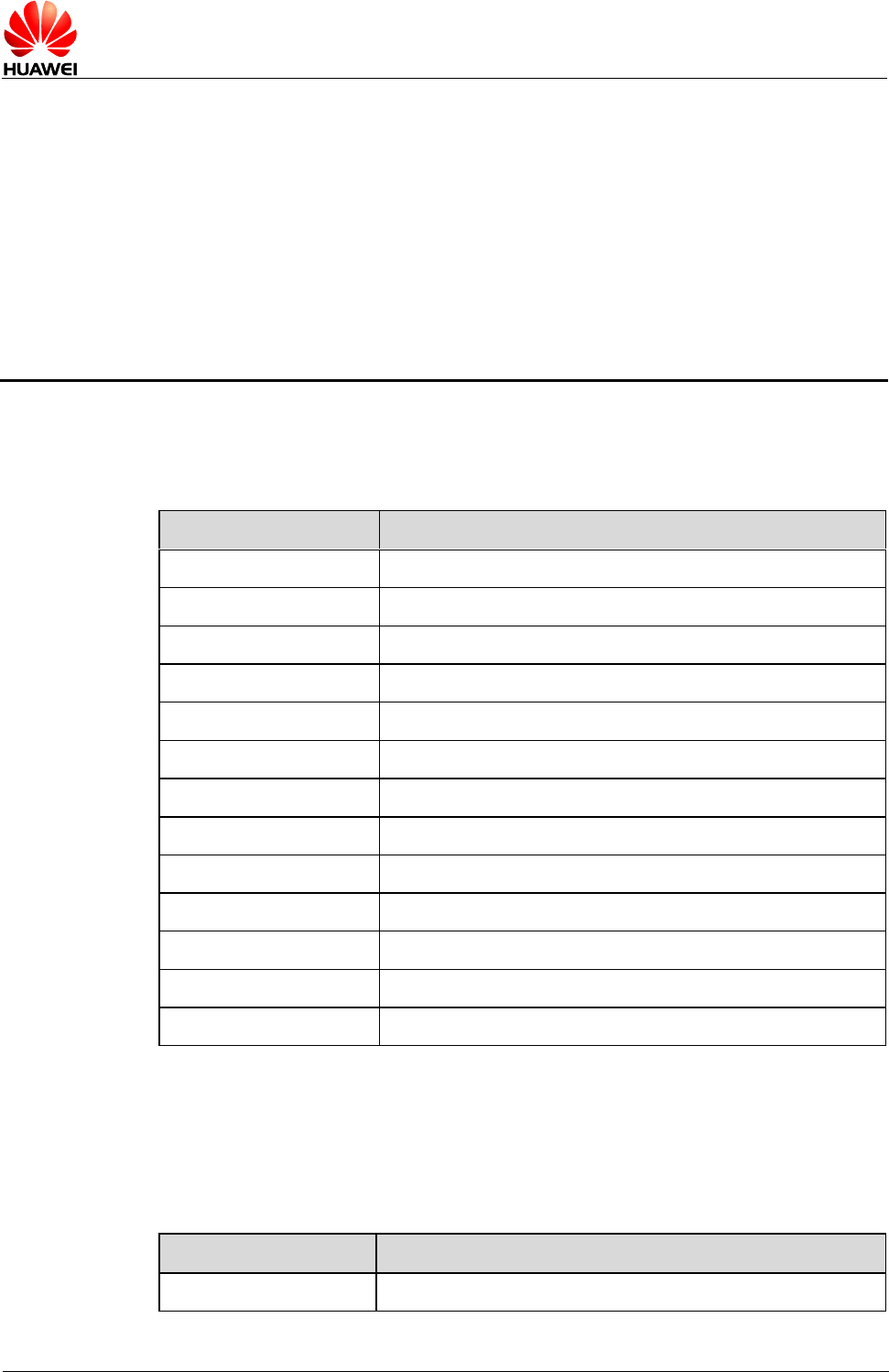
HUAWEI MU736 HSPA+ M.2 Module
AT Command Interface Specification
Appendix
Issue 02 (2013-12-24)
HUAWEI Proprietary and Confidential
Copyright © HUAWEI Technologies Co., Ltd.
171
19 Appendix
19.1 List of URC Commands
URC
Function
+CBM
Present new cell broadcast message
+CBMI
Present newly received cell broadcast message
+CDS
Present new message status report reported
+CDSI
Present newly received message status report
+CMT
Present new message reported
+CMTI
Present message arrival indication
+CUSD
Report USSD of network
+CUSATP
Indicate a UICC proactive command
+CUSATEND
Indicate a terminated UICC proactive command session
^SIMST
Indicate SIM card state change
^SRVST
Indicate service state change
+XTS
Indicate the threshold reached
+XADPCLKFREQINFO
Report adaptive clock frequency info
19.2 General CME Error List
The following describes the mapping between numeric mode and verbose mode.
Table 19-1 General "CME ERROR" Codes
Numeric mode
Verbose mode
0
phone failure
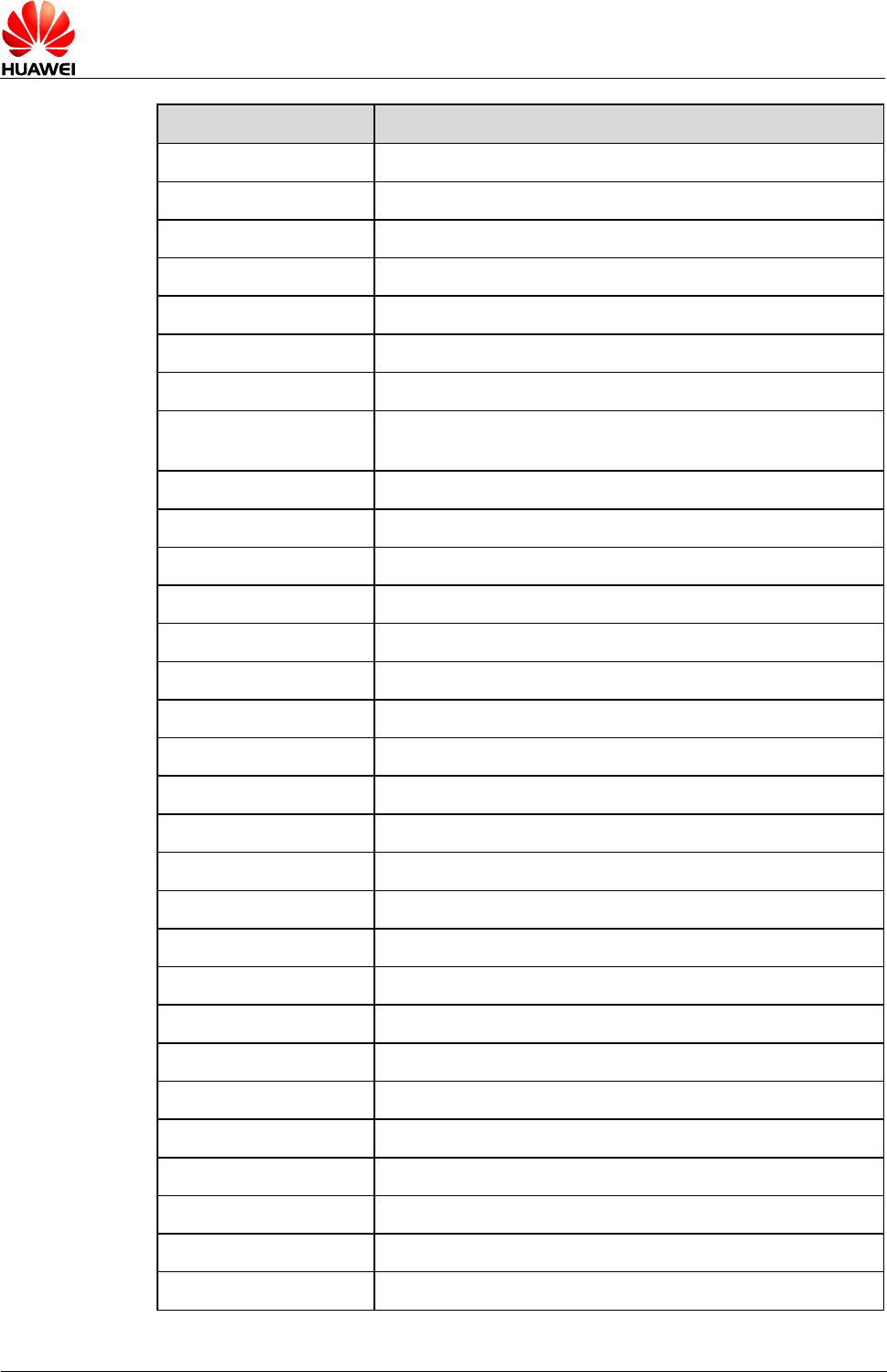
HUAWEI MU736 HSPA+ M.2 Module
AT Command Interface Specification
Appendix
Issue 02 (2013-12-24)
HUAWEI Proprietary and Confidential
Copyright © HUAWEI Technologies Co., Ltd.
172
Numeric mode
Verbose mode
1
no connection to phone
2
phone adaptor link reserved
3
operation not allowed
4
operation not supported
5
PH-SIM PIN required
6
PH-FSIM PIN required
7
PH-FSIM PUK required
10
SIM not inserted(not supported currently. If no SIM is
inserted, return SIM failure)
11
SIM PIN required
12
SIM PUK required
13
SIM failure
14
SIM busy
15
SIM wrong
16
incorrect password
17
SIM PIN2 required
18
SIM PUK2 required
20
memory full
21
invalid index
22
not found
23
memory failure
24
text string too long
25
invalid characters in text string
26
dial string too long
27
invalid characters in dial string
30
no network service
31
network timeout
32
network not allowed - emergency calls only
40
network personalization PIN required
41
network personalization PUK required
42
network subset personalization PIN required

HUAWEI MU736 HSPA+ M.2 Module
AT Command Interface Specification
Appendix
Issue 02 (2013-12-24)
HUAWEI Proprietary and Confidential
Copyright © HUAWEI Technologies Co., Ltd.
173
Numeric mode
Verbose mode
43
network subset personalization PUK required
44
service provider personalization PIN required
45
service provider personalization PUK required
46
corporate personalization PIN required
47
corporate personalization PUK required
48
hidden key required
49
EAP method not supported
50
Incorrect parameters
51
Parameter length error for all Auth commands
52
Temporary error for all auth cmds
100
unknown
103
Illegal Mem_Store
106
Illegal ME
107
GPRS services not allowed
111
PLMN not allowed
112
Location area not allowed
113
Roaming not allowed in this location area
132
service option not supported
133
requested service option not subscribed
134
service option temporarily out of order (#34)
148
unspecified GPRS error
149
PDP authentication failure
150
invalid mobile class
257
network rejected request
258
retry operation
259
invalid deflected to number
260
deflected to own number
261
unknown subscriber
262
service not available
263
unknown class
264
unknown network message
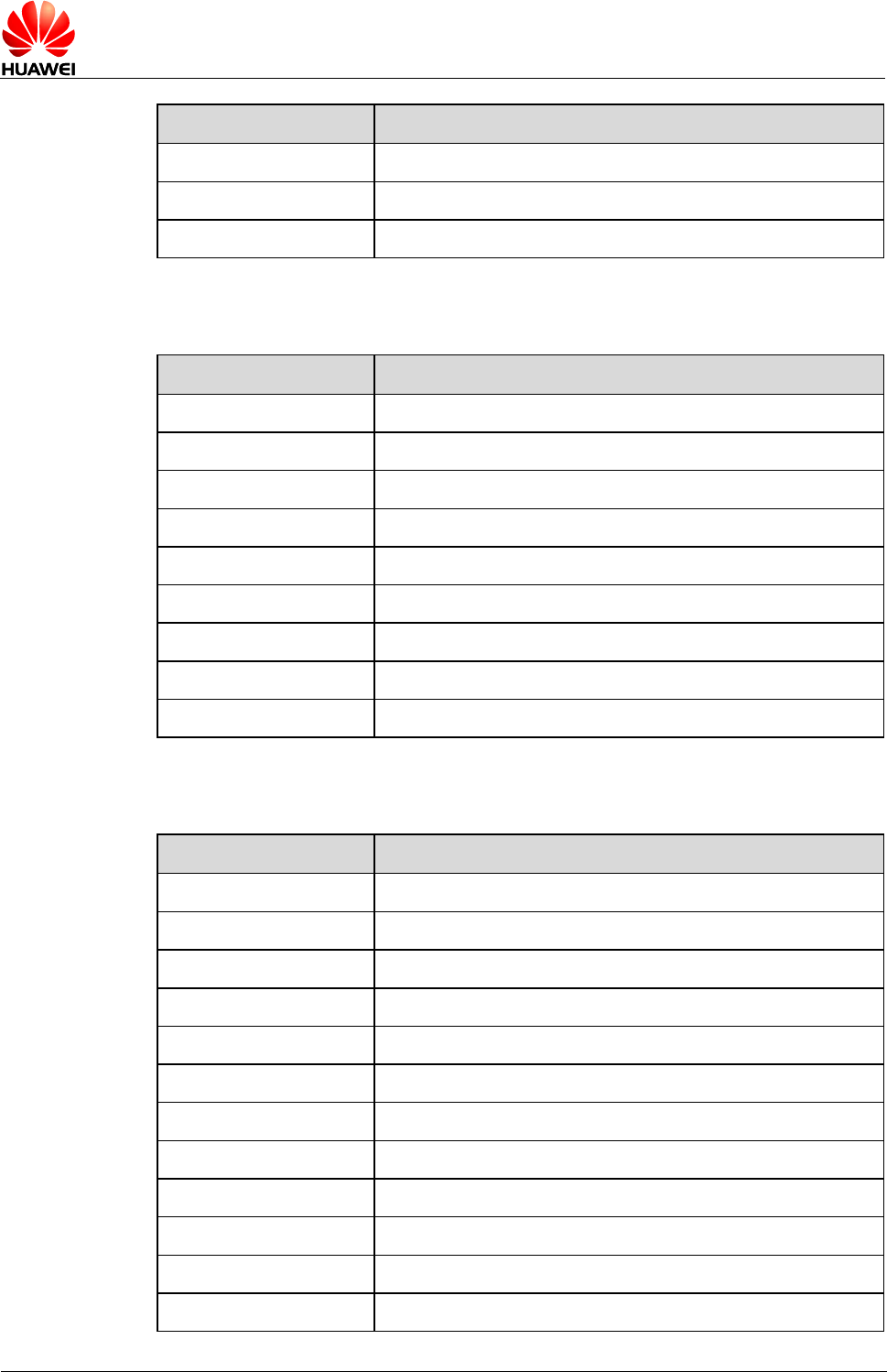
HUAWEI MU736 HSPA+ M.2 Module
AT Command Interface Specification
Appendix
Issue 02 (2013-12-24)
HUAWEI Proprietary and Confidential
Copyright © HUAWEI Technologies Co., Ltd.
174
Numeric mode
Verbose mode
273
Minimum TFT per PDP address error
274
Duplicate TFT eval prec index
275
Invalid TFT param combination
Table 19-2 General "CME ERROR" Codes (Huawei proprietary)
Numeric mode
Verbose mode
65280
call index error
65281
call state error
65282
sys state error
65283
parameters error
65284
spn file wrong
65285
spn file accessed denied
65286
spn file not exist
65287
another SPN query operation still not finished
65289
input value is out of range
Table 19-3 GPS related "CME ERROR" Codes (Huawei proprietary)
Numeric mode
Verbose mode
276
GPS function disabled
277
Standalone disabled
278
AGPS disabled
279
gpsOneXTRA disabled
280
Cell-ID disabled
281
Invalid parameter
282
Unable to delete parameters
283
PD session is ongoing
284
PD session is in off status
285
too many parameters
286
invalid server address
287
GPS locked
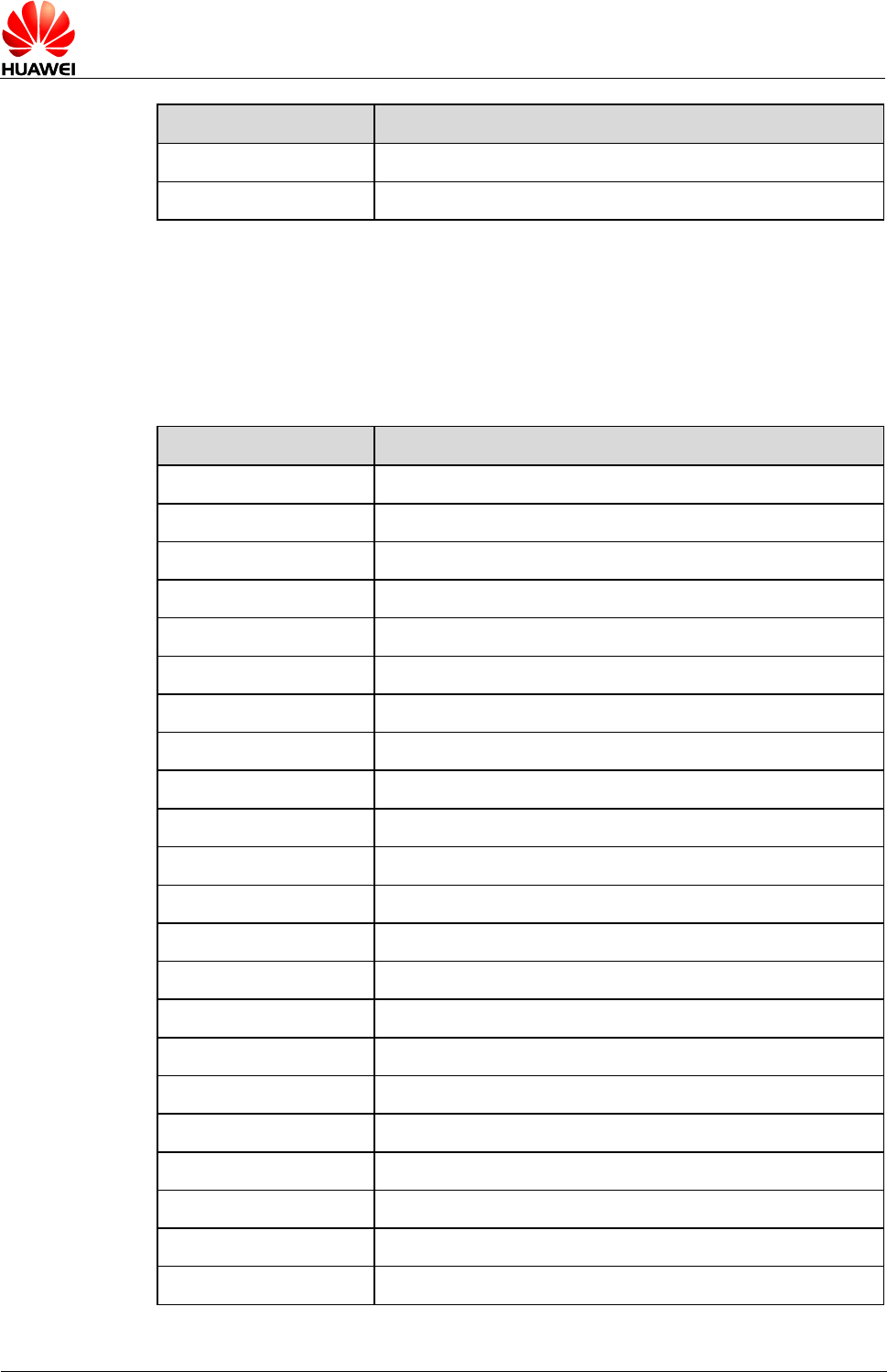
HUAWEI MU736 HSPA+ M.2 Module
AT Command Interface Specification
Appendix
Issue 02 (2013-12-24)
HUAWEI Proprietary and Confidential
Copyright © HUAWEI Technologies Co., Ltd.
175
Numeric mode
Verbose mode
288
GPS type not supported
289
MGP receiver is ongoing
19.3 CMS Error List
The following lists the <err> value of CMS ERROR that may be returned by all AT
commands of short messages.
<err> values used by common messaging commands:
Numeric mode
Verbose mode
0–127
3GPP TS 24.011 clause E.2 values
128–255
3GPP TS 23.040 clause 9.2.3.22 values.
300
ME failure
301
SMS service of ME reserved
302
operation not allowed
303
operation not supported
304
invalid PDU mode parameter
305
invalid text mode parameter
310
(U)SIM not inserted
311
(U)SIM PIN required
312
PH-(U)SIM PIN required
313
(U)SIM failure
314
(U)SIM busy
315
(U)SIM wrong
316
(U)SIM PUK required
317
(U)SIM PIN2 required
318
(U)SIM PUK2 required
320
memory failure
321
invalid memory index
322
memory full
330
SMSC address unknown
331
no network service
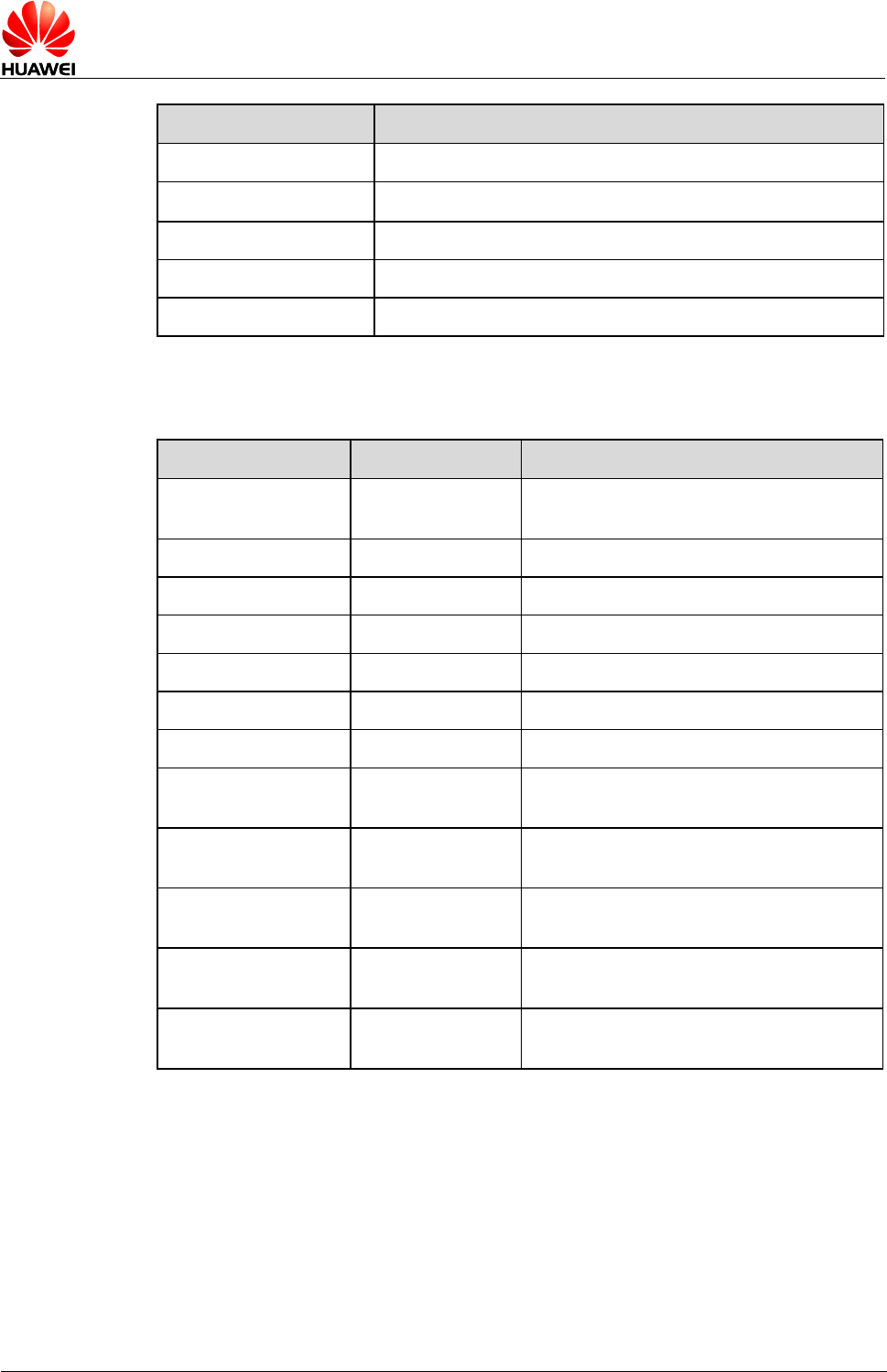
HUAWEI MU736 HSPA+ M.2 Module
AT Command Interface Specification
Appendix
Issue 02 (2013-12-24)
HUAWEI Proprietary and Confidential
Copyright © HUAWEI Technologies Co., Ltd.
176
Numeric mode
Verbose mode
332
network timeout
340
no +CNMA acknowledgement expected
500
unknown error
...511
other values in range 256...511 are reserved
512...
manufacturer specific
19.4 Final Result Code
Final Result Code
No.
Description
OK
0
A command is executed, and there is no
error.
CONNECT
1
A connection is established.
RING
2
An incoming call is originated.
NO CARRIER
3
A connection is terminated.
ERROR
4
There is a common error.
NO DIALTONE
6
There is no dialing tone.
BUSY
7
The peer is busy.
NO ANSWER
8
Timeout occurs when the connection is
complete, and there is no reply.
+CME ERROR:
<err>
The error type is specified by <err>.
+CMS ERROR:
<err>
It is a short message-related error.
COMMAND NOT
SUPPORT
numeric is not
supported
The command is not supported.
TOO MANY
PARAMETERS
numeric is not
supported
Too many parameters in the issued
command
Note:
The final result code is the termination flag of an AT command.
19.5 References
[1] 3GPP TS 23.038

HUAWEI MU736 HSPA+ M.2 Module
AT Command Interface Specification
Appendix
Issue 02 (2013-12-24)
HUAWEI Proprietary and Confidential
Copyright © HUAWEI Technologies Co., Ltd.
177
[2] 3GPP TS 23.040
[3]3GPP TS 23.041
[4] 3GPP TS 24.011
[5] 3GPP TS 25.331
[6] 3GPP TS 27.005
[7] 3GPP TS 27.007
[8] 3GPP TS 31.111
[9] 3GPP TS 44.060
[10] 3GPP TS 45.008
[11] GSM 02.88
[12] GSM 03.40
[13] GSM 04.08
[14] GSM 07.05
[15] GSM 51.011
[16] ETSI TS 102.221
[17] ETSI TS 102.223
[18] HUAWEI Terminal AT Command Interface Specifications
[19] ITU-T Recommendation V.25 ter
19.6 Acronyms and Abbreviations
Abbreviations
Full spelling
3GPP
Third Generation Partnership Project
AGPS
Assisted Global Positioning System
AT
ATtention
APN
Access Point Name
BER
Bit Error Rate
CDMA
Code Division Multiple Access
CLIP
Call Line Identifier Presentation
CS
Circuit Switched (CS) Domain
DCE
Data Circuit-terminating Equipment
DCS
Data Coding Scheme
EGPRS
Enhanced GPRS
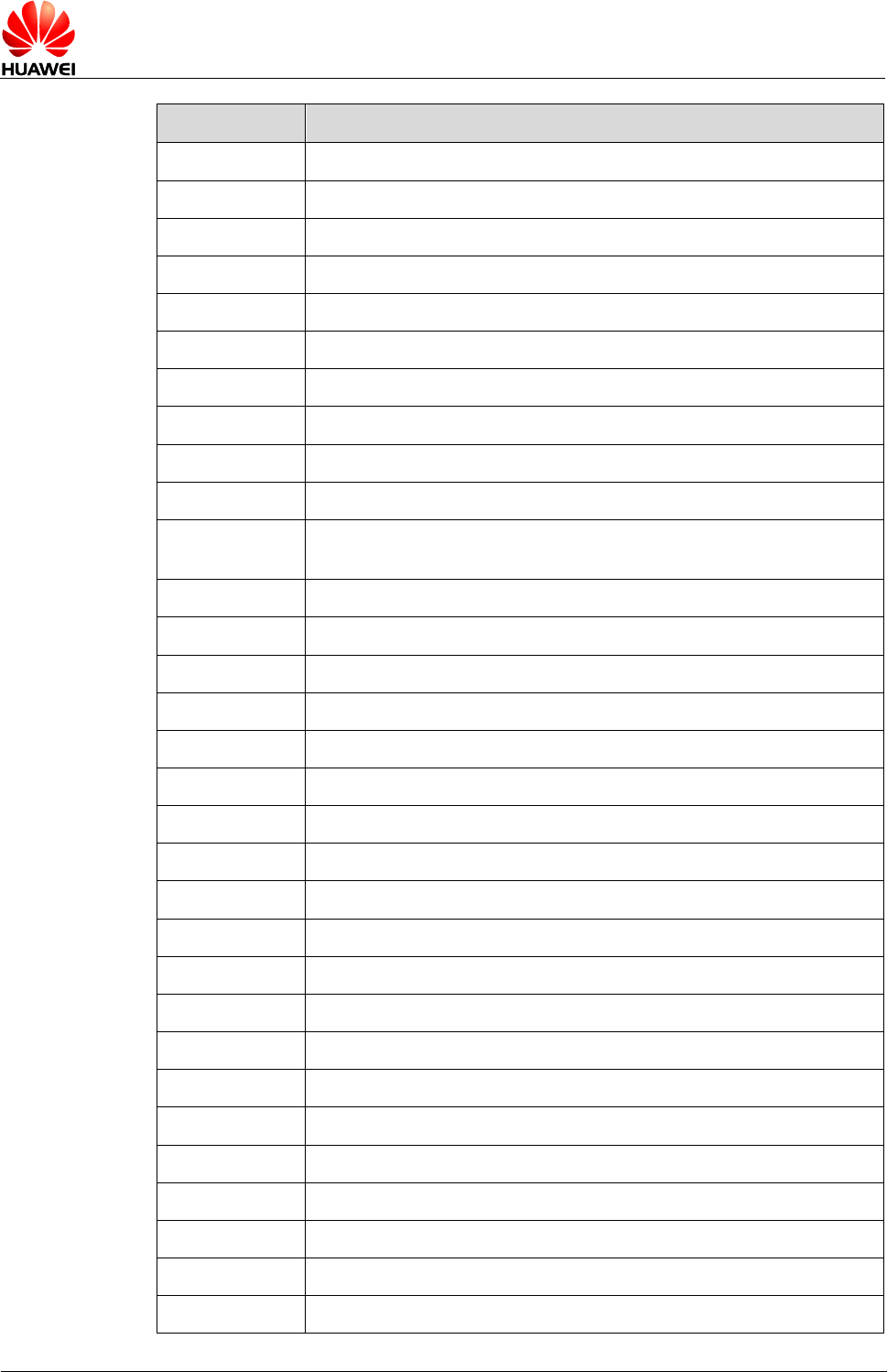
HUAWEI MU736 HSPA+ M.2 Module
AT Command Interface Specification
Appendix
Issue 02 (2013-12-24)
HUAWEI Proprietary and Confidential
Copyright © HUAWEI Technologies Co., Ltd.
178
Abbreviations
Full spelling
E-UTRAN
Evolved UTRAN
GGSN
Gateway GPRS Support Node
GPRS
General Packet Radio Service
GPS
Global Positioning System
GSM
Global System for Mobile Communications
HSDPA
High Speed Downlink Packet Access
HSUPA
High Speed Uplink Packet Access
IMEI
International Mobile Equipment Identity
IMSI
International Mobile Subscriber Identity
IP
Internet Protocol
ITU-T
International Telecommunication Union-Telecommunication
Standardization Sector
IWF
Interworking Function
ME
Mobile Equipment
MS
Mobile Station
MSISDN
Mobile Station International ISDN Number
MT
Mobile Terminal
NMEA
National Marine Electronics Association
PDP
Packet Data Protocol
PDU
Protocol Data Unit
PIN
Personal Identity Number
PLMN
Public Land Mobile Network
PUK
PIN Unblocking Key
PS
Packet Switched (PS) domain
QoS
Quality of Service
RP
Relay Protocol
RSSI
Receive Signal Strength Indicator
SCA
Service Center Address
SIM
GSM Subscriber Identity Module
SM
Short Message
SMS
Short Message Service
SMSC
Short Message Service Center

HUAWEI MU736 HSPA+ M.2 Module
AT Command Interface Specification
Appendix
Issue 02 (2013-12-24)
HUAWEI Proprietary and Confidential
Copyright © HUAWEI Technologies Co., Ltd.
179
Abbreviations
Full spelling
TA
Terminal Adapter
TE
Terminal Equipment
TPDU
Transfer Protocol Data Unit
URC
Unsolicited Result Code
USIM
Universal Subscriber Identity Module
USSD
Unstructured Supplementary Service Data
UTRAN
Universal Terrestrial Radio Access Network
VP
Validity Period
WCDMA
Wideband CDMA